Australian
and international
exploratory
performance and
media arts
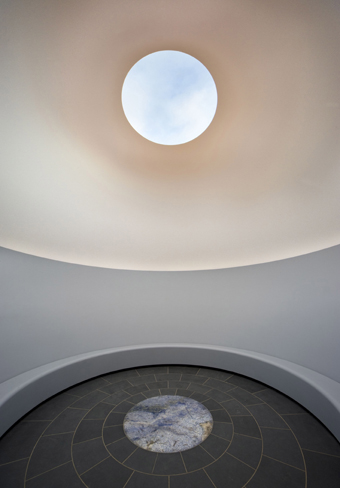
James Turrell, Within without, 2010
lighting installation, concrete and basalt stupa, water, earth, landscaping 800 x 2800 x 2800 cm
National Gallery of Australia, Canberra
Purchased with support of visitors to the exhibition Masterpieces from Paris
photo John Gollings
James Turrell, Within without, 2010
lighting installation, concrete and basalt stupa, water, earth, landscaping 800 x 2800 x 2800 cm
National Gallery of Australia, Canberra
Purchased with support of visitors to the exhibition Masterpieces from Paris
james turrell—space within space
“My work is about space and the light that inhabits it. It is about how you confront that space and plumb it with vision. It is about your seeing, like the wordless thought that comes from looking into fire.” So says American artist James Turrell, whose major new Skyspace work, Within without, recently opened at the National Gallery of Australia, Canberra. Commissioned by the NGA as part of its Stage 1 building project, Within without is located in the new Australian Garden on the south side of the building. In order to enter the work, the audience walks down a long, sloping pathway. Once inside, there is a series of spaces: a large square-based pyramid with soft red ochre interior walls, within which there is a stupa made of basalt; inside the stupa is a viewing chamber—a simple domed space, open to the sky. Within without is at its most dramatic and complex at dawn and dusk, marking the transition between night and day. For those who want additional drama, however, there is also a concert on November 27, featuring the music of John Luther Adams, Gavin Bryars, George Crum and Arvo Pärt. James Turrell, Within without (2010), National Gallery of Australia, Canberra; http://nga.gov.au/turrell/
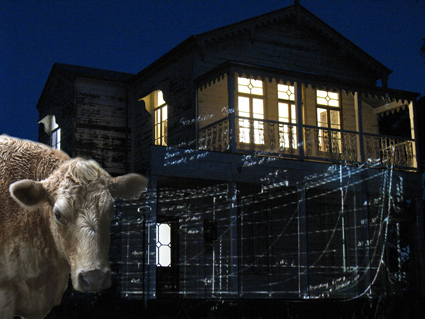
Lyndal Jones, Rehearsing Catastrophe #1: The Ark in Avoca
photo courtesy of the artist
Lyndal Jones, Rehearsing Catastrophe #1: The Ark in Avoca
australian ark
Light is also central to Lyndal Jones’ latest creation, Rehearsing Catastrophe #1: The Ark in Avoca, in which a team of artists and locals will work in the twilight to transform Avoca’s Watford House into an ark using large-scale video projections, sound and live animals. The installation, according to Jones, is meant as a “humorous and imaginative preparation for the next flood” and will also produce a video for exhibition on the Big Screen at Federation Square on December 14. Part of the decade-long Avoca Project (see RT83), Rehearsing Catastrophe #1 is Jones’ first performance at Watford House, working with the local community as well as national and international artists, scholars and climate change experts. Rehearsing Catastrophe #1: The Ark in Avoca, Watford House, 16 Dundas Street, Avoca, Victoria; Dec 2-4; www.avocaproject.org
investigation, meditation, immigration
Still in Victoria, the Melbourne Workers Theatre and La Mama present Yet to Ascertain the Nature of the Crime, a production prompted by the recent spate of attacks against Indian students in Melbourne. The show is described as “part-investigation and part-meditation” and seeks to address the attacks within the broader contexts of current economic, education and immigration policies. The show is structured around a compilation of perspectives from Indian students, as well as verbatim material from politicians, doctors and other social commentators. It also features writing by Roanna Gonsalves, Raimondo Cortese, Damien Millar and the company. See also Jake Wilson’s RealTime 100 review of Suri Mohit’s Bollywood feature film Crook on the same subject. Yet to Ascertain the Nature of the Crime, Artshouse, North Melbourne Town Hall, November 24-28; www.lamama.com.au

Natalie Rose, Zoe Coombs Marr and Mish Grigor
photo James Brown
Natalie Rose, Zoe Coombs Marr and Mish Grigor
the complete idiot’s guide to the gfc
Regarding verbatim and documentary theatre, Sydney’s version 1.0 are conducting another of their performative investigations—this time into the global financial crisis and the near collapse of capitalism, as part of a double bill with post (Zoe Coombs Marr, Mish Grigor and Natalie Rose) to be staged at Belvoir St Downstairs Theatre. Titled A Distressing Scenario, the production consists of two parts: Everything I Know About the Global Financial Crisis in One Hour, in which post attempt to explain the recession based on as little research as possible; and The Market Is Not Functioning Properly, in which version 1.0’s Jane Phegan and Kym Vercoe examine how phrases such as “toxic debt” and “stimulus package” have entered the vernacular. A Distressing Scenario, a double bill by post and version 1.0, Belvoir St Downstairs Theatre, Nov 25-Dec 19; www.belvoir.com.au
live art in brisbane
One of the websites we here at RealTime keep an eye on is live art list australia, which recently led us to discover the Brisbane-based event exist-ence. In the event’s third incarnation, the Judith Wright Centre Shopfront will be “transformed into a breathing, shaking, writhing space for performance, live and action art” over two nights (website). Local artists, including Dan Koop, Goran Tomic, Jan Baker-Finch, and Melody Woodnutt, will present a range of projects including solo, collaborative and durational works. There will also be international artists streaming live online into the venue and presentations of DVDs, archives and “art-i-facts.” exist-ence: a festival of performance, live and action art, Judith Wright Shopfront, Nov 26-27; www.judithwrightcentre.com
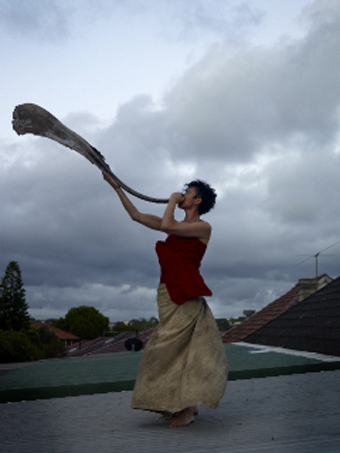
Victoria Hunt, Dancing the Dead, LiveWorks
photo Manuel Vason
Victoria Hunt, Dancing the Dead, LiveWorks
inbetween time
If you’re attending exist-ence or tackled Liveworks at Performance Space recently, then you might consider it training for Bristol’s Inbetween Time Festival, which features 75 events by 130 artists. Several Australians are among their number including Ben Frost, Sarah-Jane Norman, Fiona Winning and Victoria Hunt as well as Back to Back Theatre. They’ll be in the mix with Blast Theory, Tim Etchells, Quarantine, Duncan Speakman and Nicola Canavan, among others. The program is divided into several sections such as D-Stable, Lecturama and What Next for the Body; the latter will then continue at Arnolfini until February 2011. Having participated in Inbetween Time in 2006 (RT72), this year RealTime will produce a special e-dition of reviews and articles from the festival to be published online in the second-last week of December. Inbetween Time Festival of Live Art and Intrigue, Dec 1-5 2010; http://inbetweentime.co.uk/
RealTime issue #99 Oct-Nov 2010 pg. web
© RealTime ; for permission to reproduce apply to realtime@realtimearts.net
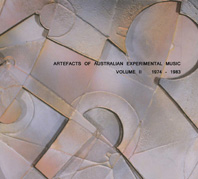
artefacts of australian experimental music volume II 1974-1983
2CD
Shame File Music SHAM056
www.shamefilemusic.com
Three years after the release of Volume I (which covered the years 1930-1973), Melbourne-based writer, artist and historian Clinton Green has produced a second compilation documenting Australian experimental musical activity. Covering the period from 1974 to 1983 it represents a vastly different economic, political, aesthetic and technological landscape from its predecessor: disillusionment with the 60s countercultural “revolution,” the fallout from the Whitlam dismissal, the emergent punk/post-punk nexus and the increasing availability of electronic equipment are all evident within these recordings. As such, it is a conduit into a not-so-distant past, albeit one that Ian Andrews, as quoted in the liner notes, described as “the lost decade.” Without any pretence of being exhaustive (let alone conclusive), the pieces and artists that Green has selected, along with his copious liner notes, are an attempt to rectify this situation; not only for students of the era, but for anyone interested in experimental arts practices in this country and in music in general.
There are a couple of factors that distinguish the music found on Volume II from the earlier compilation, one of which might be summed up in the phrase “less Cage, more collage.” Where previously adventurous composers had cleaved closely to the edicts of pre-eminent American composer John Cage, by the 1970s many of the precepts of “capital E” Experimental music—aleatoric processes, indeterminacy, extra-musical sounds and improvisation—had been well and truly internalised by artists and audiences alike. This allowed for their redeployment both within and across aesthetic schemes that intersected with a variety of agendas, be they musical, technological or social. Early works by The Loop Orchestra, Severed Heads and Ian Hartley combine tape loops and cut up procedures, appropriation and electronic sounds, encountering musique concrète, pop, field recording and radio along the way. Performers in Ron Nagorcka’s Atom Bomb use toy instruments and domestic tape recorders in a live performance that builds into a multi-layered, multi-directional sound. Minimalist repetition is combined with pop music’s own forms of reductionism by Essendon Airport and tch, tch, tch/tsk, tsk tsk (the symbol that is the correct nomenclature being unreproducible here) before being pounded to pieces with noisy “anti-musical” fervour by The Primitive Calculators.
Secondly—and this pertains mainly to pieces from the 1970s—the relationship between artists, infrastructure and institutions is at times quite marked. Tristram Cary’s Soft Walls and other pieces by Carl Vine and Ros Bandt are recordings from an era when synthesizers were expensive items, and access to them was largely through university music departments, which would doubtless act as gatekeeper when it came to their use. As such these works present a more “classic” approach to electronic composition. In stark contrast is the Forced Audience project of Gary Warner that produced tape collage and appropriation works while operating outside the institutional system, which explicitly challenged the formal relationship between artist, audience and content. Although electronically generated and manipulated sound is far more prevalent on this set than the earlier volume (with the vast majority of pieces here overtly utilising electronics beyond recording), the economics and politics of using those technologies is manifest here both in the music and the means by which it is produced: the “do-it-yourself” credo so often attributed to the punk movement has been a perennial in experimental arts.
Apart from those already mentioned, works from a wide array of significant performers and composers are featured, among them Jon Rose, Ernie Althoff, Ian Andrews, Warren Burt and renowned Mebourne guitarist Dave Brown (in the group Signals, with David Wadelton and Chris Knowles). However, it’s the inclusion of more obscure acts such as Justinstink (Justin Butler), Voigt/465 and Purple Vulture Shit, along with soundtracks by Arthur Cantrill, the location recordings of Les Gilbert and the whirly instruments of Sarah Hopkins, that not only make this a valuable release, but helps to broaden our understandings of what constitutes experimental music in Australia.
Peter Blamey
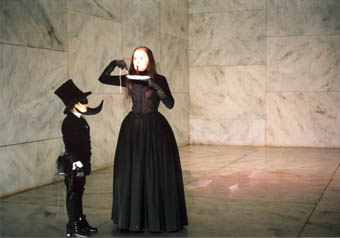
Societas Raffaello Sanzio, BR#04, Tragedia Endogonidia IV Episode
Romeo Castellucci and his Societas Rafaello Sanzio collaborators have produced some of the most seductive and enigmatic performance masterworks of recent times, epic conceptions and disturbing realisations on a scale not experienced since the first showings of the Robert Wilson “operas” with which they share a totally immersive sense of dream, if in radically different ways.
My first encounter with the company was the 2000 Adelaide Festival showing of Giulio Cesare, a nightmarish re-working of Shakespeare, Plutarch and other sources in which the oratory of Mark Antony and Brutus is hampered by the very real disabilities of the performers and the wasteland of the post-assassination civil war is a junked-out, anorexic apocalypse for our own times. Genesi: From the Museum of Sleep, at the 2002 Melbourne Festival, grimly reviewed our origins in terms of Madam Curie’s discovery of radium, a child’s Auschwitz (Castellucci’s own offspring performing) and an account of the Cain and Abel story. Richard Murphet wrote: “It is the lasting power of Genesi that its response to the ‘destiny of the inhabitants of the world’ (Castelluci, festival program) is so tough-minded, so terrifyingly lyrical, so unpredictably indirect in its creativity and so openly and quietly scandalised by the tragic consequences of the original act of creation” (RT52).
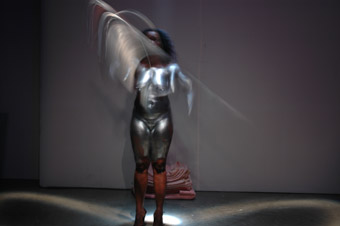
Hey Girl!, Socìetas Raffaelo Sanzio
photo Raffaelli
Hey Girl!, Socìetas Raffaelo Sanzio
Hey Girl!, a production on a smaller scale seen at the 2008 PuSh International Performing Arts Festival in Vancouver, was typically visceral and visually inventive, if relatively literal for a Castellucci creation. Its apparent sexism was much debated during the festival (our RealTime-PuSh workshop yielded five reviews). Other works seen by RealTime writers have included Purgatorio at the 2008 Avignon Festival and Tragedia Endogonidia, BR#04 Brussels (three brief reviews, two from the 2005 Melbourne Festival and one from the 2003 KunstenFestivaldesArts, Brussels).
Max Lyandvert and Jonathan Marshall provide detailed backgrounds to Tragedia Endogonidia and Genesi respectively. Sydney-based composer and sound designer Lyandvert, who has worked with Societas Rafaello Sanzio here and in Europe, describes in fascinating detail the origins, images and meanings of the 11 Tragedia Endogonidia works and their associations with particular cities. Marshall interviewed Castellucci about Genisi, covering a range of subjects, including the director’s use of non-professional performers: “In truth, every body is worthy of being on stage. For me there are no deformed bodies, but only bodies with different forms and different beauties, often with a type of beauty that we have forgotten.”
Marshall also explores with Castellucci the pivotal relationship between image and sound in his work: “[Composer Scott] Gibbons has developed sounds using a numerical technique called ‘granular synthesis’ which he applied to various photographs I sent him every week from my home…[He] has thus been able to give voice to certain images which I felt were intimately connected with the show. From this, some scenes were born with sounds, and other sounds were born from certain scenes.”
In a revealing discussion about violence, creativity and tragedy in his work, Castellucci comments: “Genesis frightens me much more than the Apocalypse. The terror of pure possibility is there in this sea open to all possibilities.” The sentiment resonates with the experience of witnessing a Castellucci creation—awe at what can still be realised on a stage, “so unpredictably indirect in its creativity.”
Castellucci’s Inferno, Purgatorio, Paradiso, superbly filmed by Don Kent, is now available on an arte editions DVD. The cast includes Sydney performance maker Jeff Stein, who invited Societas Rafaello Sanzio member Chiara Guidi to Campbelltown Arts Centre recently to speak about theatre and childhood and run a workshop involving local artists and children. Bryoni Trezise, who reports on the event, in 2009 experienced Guidi and Scott Gibbons’ sonic performance installation Augustinian Melody at the Santiago a Mil festival in Chile. For more on Castellucci and his collaborators there’s also the book The Theatre of Socìetas Raffaello Sanzio by Claudia Castellucci, Romeo Castellucci, Chiara Guidi, Joe Kelleher and Nicholas Ridout (Abingdon and New York, Routledge, 2007).
Keith Gallasch
reviews
a childhood of theatre
bryoni trezise: chiara guidi, campbelltown arts centre
history’s imprints
bryoni trezise: chiara guidi
hey girl! dark discoveries
eleanor hadley kershaw
hey girl! ache and awe
alex ferguson
hey girl! art object
andrew templeton
hey girl! the painted stage
anna russell
hey girl!:evolving symbols
meg walker
the art of punishment
carl nilsson-pollas: romeo castelluci’s purgatorio, avignon
kinds of truth
john bailey: tragedia endogonidia, br#04 brussels
images that hold
adam broinowski: tragedia endogonidia, br#04 brussels
castelluci on film, in person
realtime
theatre of remnants: castelluci
max lyandvert: tragedia endogonidia
time, intimate and epic
lucy taylor, tragedia endogonidia, br#04 brussels
genesi: from the museum of sleep
richard murphet
realtime@2000 adelaide festival: giulio cesare, oratory & suicide, RT36, p22
keith gallasch
interview
the castelluci interview: the angel of art is lucifer
jonathan marshall
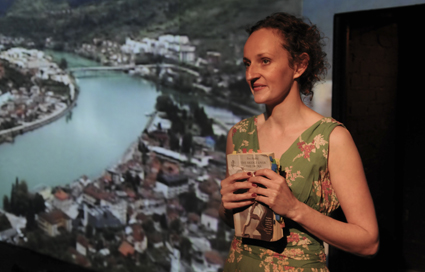
Kym Vercoe, Seven Kilometres North-East
photo Heidrun Löhr
Kym Vercoe, Seven Kilometres North-East
VERSION 1.0 FIRST FOUND FAME THROUGH THEIR GROUP WORKS, SUCH AS CMI (A CERTAIN MARITIME INCIDENT) AND WAGES OF SPIN. MORE RECENTLY, HOWEVER, THEIR SOLO SHOWS HAVE BEEN GARNERING ATTENTION: PAUL DWYER’S BOUGAINVILLE PHOTOPLAY PROJECT AND NOW KYM VERCOE’S SEVEN KILOMETRES NORTH-EAST. LIKE DWYER’S, VERCOE’S WORK IS ABOUT HER AMBIVALENT ENTANGLEMENT WITH ANOTHER COUNTRY, TOLD THROUGH AN ELEGANT COMBINATION OF STORY, SONG AND IMAGE.
Sitting in the slightly dingy surrounds of the Old Fitzroy, spectators see a small stage with two stones, which double as stools; on the opposite side is a shelf with tea, beer and a few books. In the background is a large white wall, onto which the image of a rotating propeller is projected. Vercoe stands on a small stage above this, pegging pillowcases to the four clotheslines that stretch across the upper reaches of the space. Once she has completed her task she enters the lower stage via a door in the middle of the screen.
From here Vercoe introduces herself and her home away from home—Bosnia and Herzegovina—a country with which she feels an inexplicable, and inescapable, connection. She has visited three times, in 2004, 2008 and 2010; or, as she puts it more poetically, in autumn, summer and spring. She has more than 17 hours of video footage from these visits which video artist Sean Bacon has helped her to edit down to a more modest, though still mesmerising 80 minutes. Throughout the play, images of rivers, mountains, flowers and birds dance before our eyes. In fact, birds are a recurring motif, with each section named after a particular species and aligned with a series of video tapes. In between each section, a “songbird” sitting in the audience stands and performs a folk song.
Tapes 1-3, titled Prologue, deal with her first visit: there is a party; a man; some linguistic misadventures; and the discovery of Ivo Andric’s book The Bridge Over the Drina. Tapes 4-7, The Swallow (the symbol of return), deal with Vercoe’s second trip and her visit to this famous bridge in Višegrad. In one striking moment she spreads coffee grounds on the floor in the shape of the bridge and enacts a passage from Andric’s book, her lithe body dancing along the bridge. Towards the end of her trip, in Tapes 7-11 The Cormorant (sometimes a symbol of deception), she visits Vilina Vlas, which is located roughly seven kilometres north-east of Višegrad (hence the title). The hotel is nice enough, however when she returns home she discovers that it was a rape camp during the Bosnian war, a fact not mentioned in the guidebook. This discovery prompts her to email the author. More significantly, it prompts the slow, sickening realisation that in order to make peace with herself (and perhaps to make this piece of theatre), she is going to have to return to the scene of the crime.
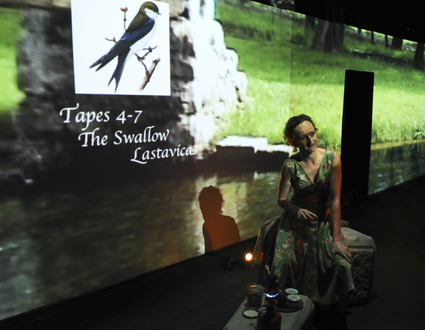
Kym Vercoe, Seven Kilometres North-East
photo Heidrun Löhr
Kym Vercoe, Seven Kilometres North-East
The final section, titled The Nightingale (whose song is sometimes interpreted as a lament), sees Vercoe back in Bosnia where she meets the author of the guidebook as well as journalists who covered the war. When it all proves too much, she puts on her headphones and listens to A-Ha’s “Take On Me.” The music blasts through the space as she dances her way across the floor, smearing the coffee bridge in the process. The movements resemble Vercoe’s previous dance, which we had assumed was her interpretation of Andric, but thanks to video footage in the background we can now see that she has borrowed the moves from someone we assume to be a Bosnian busker.
For the most part, Seven Kilometres North-East is thoughtful, beautiful and beguiling, so if there is a criticism to be made of the performance, then it is a criticism of memory culture more broadly. Vercoe’s easy (over)identification with the victims—unable to sit where they might have sat, thinking about how her own unknowingness echoes theirs—means that her role, and ours as bystanders go largely unexamined. Though we may not have stood and pegged clothes on the line while looking at the rape camp down the hill, we are all complicit in the crime to varying degrees. Indeed, this is one of the insights of the show, which could be pushed further—innocent, ignorant, distant and belated, it may be that there are many types of bystanders, many modes of complicity.
There are also many modes of erasure. When Vercoe contacts a local history centre for the information about the women who were in Vilina Vlas, their names cannot be released—one final annihilation, as she puts it. Similarly, when the new guide to Bosnia is released, the entry on Vilina Vlas has not been amended but simply deleted.
On that note, Vercoe strips off, opens the door and steps into the shower. The image of the bridge is projected onto her naked back as she washes herself clean of sins that were not hers, are not ours and yet are everyone’s. Eventually she steps out of the shower but the water continues running, weeping, cleansing—until finally, it stops.
Version 1.0, Seven Kilometres North-East, devisor and performer Kym Vercoe, video artist Sean Bacon, dramaturg Deborah Pollard, musical director Sladjana Hodzic, lighting designer Emma Lockhart-Wilson, production manager Frank Mainoo, producer David Williams; Old Fitzroy Theatre, Sept 30-Oct 6
This article was first published online Nov 8, 2010.
RealTime issue #100 Dec-Jan 2010 pg. 33
© Caroline Wake; for permission to reproduce apply to realtime@realtimearts.net
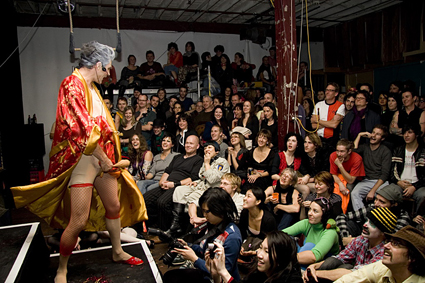
Lanfranchi’s Memorial Discotheque, You Little Stripper
photo Alex Davies
Lanfranchi’s Memorial Discotheque, You Little Stripper
SEARCHING FOR A SUITABLE NAME FOR A NEW WAREHOUSE ARTS VENUE, CO-FOUNDER LUCAS ABELA DECIDED TO COMMEMORATE ONE OF THE SEEDIER MOMENTS OF SYDNEY’S HISTORY: THE ‘ALLEGED’ SHOOTING IN THE 1980S OF WARREN LANFRANCHI BY POLICE OFFICER ROGER ROGERSON IN A CHIPPENDALE BACKLANE.
The elaborate full titling—Lanfranchi’s Memorial Discotheque—took a little practice to get rolling off the tongue, but in retrospect it seems impossible to imagine it being called anything else: the reference infused the place with the spirit of the underworld and the underground. It seems equally impossible to imagine the Sydney arts scene in the mid 2000s without it. But like all good things, especially illegal performance venues, it came to an end (after an impressive five years) and filmmaker Richard Baron was there to document its death throes.
In the final phase of Lanfranchi’s there was a significant increase in performance events, as opposed to the music (admittedly often performative) that had been more prominent in the earlier days of the venue. Grainy footage captures the raucous freedom of performance nights such as Cab Sav; the incredibly popular Wonka live cinema experience, developed in the venue; and the antics of people doing strange things with electricity that is DorkBot. The debauchery reaches its zenith with the Marrickville Jelly Wrestling Federation—people slip-sliding all over each other in various states of costume and nakedness, performing acts of frenzied exhibitionism. Having experienced quite a lot of ‘serious’ (ie clothed) experimental music at Lanfranchi’s, I was slightly saddened that this aspect of the venue was not so well represented in the film, but in fairness, it is a document of the last 60 days of the venue when perhaps the mayhem was reaching its peak.
However it’s not all good times. Baron’s camera is there when the residents are being harassed by the landlord’s heavy, who comes each morning to disconnect the electricity in an attempt to speed up the eviction when they are still legally entitled to be there. One of the residents is subsequently electrocuted (fortunately not fatally) trying to reconnect power and the camera shows us his blackened hand and singed eyebrows. The camera is also secretly left on during heated discussions with council representatives and police giving us audio snippets and groin shots. But rather than labouring the negatives of the experience, they are included as just part of the whole package.
Baron conducts informative interviews with residents such as Phoebe Torzillo, Pia van Gelder and Tega Brain who each offer glimpses into the different micro-cultures that clustered around the venue. Not surprisingly Lanfranchi’s co-founder Lucas Abela is highlighted, with some gruesome footage of the glass playing/smashing performance that he developed in the space after finding an old window pane lying in the corner—an act he has subsequently toured worldwide. Alex Davies, another co-founder and resident to the bitter end, is given less personal screen time, but offers much to the film through his video and photographic documentation, succinctly capturing the essence of many of the events.
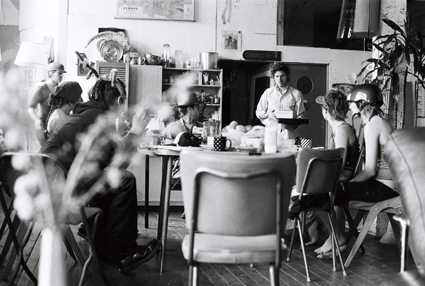
Lanfranchi’s Memorial Discotheque, Lanfranchi’s residents
photo Simone Schelker
Lanfranchi’s Memorial Discotheque, Lanfranchi’s residents
Initially I was concerned that the documentary might suffer from amnesia about venues and activities which preceded, or ran concurrently with Lanfranchi’s. (In an opening interview Abela insists that there were galleries but no venues before Lanfranchi’s—perhaps technically true, but many of the galleries had strong histories as performance venues as well.) However as the documentary unfolds, Baron pieces together anecdotal histories digging up the Evil Brotherhood of Mutants (a posse of Clan Analogue members) who occupied the same space in the 90s. He also works in references to some of the many other artist-run spaces around town past and present: Imperial Slacks, Space 3, Hibernian House, China Heights to name a few. (The accompanying website also provides a comprehensive list of artist-run spaces.)
The film also takes steps towards analysing the complicated interplay of the underground and mainstream art scenes. A topic in several of the interviews is whether to work within or without the system, or whether you can balance a bit of both. That Lanfranchi’s’ demise roughly coincided with the opening of CarriageWorks is an irony also not lost on the filmmaker. However he cleverly allows CarriageWorks’ then CEO Sue Hunt to make his point for him, as she speaks of how the complex will be “a place for creativity and innovation,” and then discusses how “thrilled” she is to include Channel 10’s “contemporary dance piece” So You Think You Can Dance.
This self-funded film project took almost three years to complete. In contrast to much of the outrageous work undertaken at Lanfranchi’s, Richard Baron’s approach is stylistically straightforward, letting the footage, both his own and that accumulated from a range of sources, speak for itself. Underscored by the vivifying soundtrack drawn from many of the artists involved in the space, the film conveys a tangible sense of the moment. Grounding this, the considered editing of interviews ensures that the film is not just the documentation of good times past, but also offers some analysis of the broader Sydney arts culture. Of course there are new (and ongoing) spaces that continue to nurture Sydney’s underground/underworld, and each have their own flavour…but the sheer seediness and reckless abandon of Lanfranchi’s Memorial Discotheque so far remains unrivalled.
Lanfranchi’s Memorial Discotheque – The Documentary, Richard Baron, Bitterman Films, www.lanfranchismemorialdiscotheque.com/
Lanfranchi’s Memorial Discotheque – The Documentary won the Director’s Choice Award at the 2010 Sydney Underground Film Festival, Best Documentary at the 2010 Melbourne Underground Film Festival
This article was orginally published online, Nov 8, 2010.
RealTime issue #100 Dec-Jan 2010 pg. 22
© Gail Priest; for permission to reproduce apply to realtime@realtimearts.net
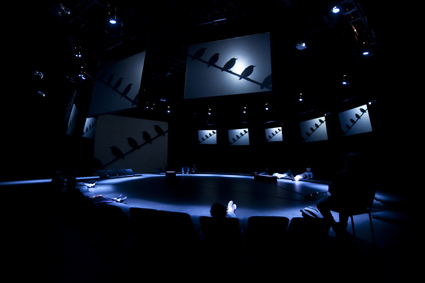
en masse
photo Matt Nettheim
en masse
THE INCREDIBLE SHRINKING MAN (JACK ARNOLD, 1957) CONTAINS ONE OF MY FAVOURITE MOMENTS IN SCIENCE-FICTION CINEMA. AFTER HAVING BEEN EXPOSED TO A MYSTERIOUS RADIOACTIVE CLOUD, THE FILM’S PROTAGONIST, SCOTT CAREY, FINDS HIMSELF PHYSICALLY SHRINKING AT AN ALARMING RATE. DOLL-SIZED, HE FLEES TO THE HOUSEHOLD BASEMENT WHERE HE IS FORCED TO NEGOTIATE A FORMIDABLE ARRAY OF ONCE FAMILIAR DOMESTIC OBJECTS (CRATES, MATCHBOXES, PINS, MOUSETRAPS) AND DO BATTLE WITH THE FAMILY CAT AND OTHER PREDATORS.
Struggling up from the basement to the garden, Carey realises that he might soon become ‘infinitesimal’. He looks up the night sky whereupon tiny and immense phenomena suddenly become intertwined. As his body dwindles to the sub-atomic level, the camera shifts skywards to reveal grand-scale celestial bodies and astronomical vistas. The garden and Carey dissolve into a succession of stars while Carey’s voice-over reminds us that even the “smallest of the small” matters in the larger scheme of things. For myself, what makes this sequence such a powerful and incredibly poetic moment is its refusal to set-up the ‘large’ and the ‘small’ as oppositional perceptual terms. Indeed, Carey himself comes to understand perceptual scale as relative: “the unbelievably small and the unbelievably vast eventually meet”.
The mobile and sliding scale of perception is by no means specific to the realm of science-fiction?just think of how tiny things such as a childhood treasure box or dollhouse can contain endless imaginative possibilities while immense landscapes or intricately detailed aesthetic objects hold the capacity to make us feel small, inferior or insignificant, by comparison. Our perception of the large within the small or the vast within the miniature alerts us to the dynamism that is seeing itself; the ways in which embodied encounters can unleash a sense of eeriness or displacement as well as liberation in aesthetic experiences, through the power of what the experimental filmmaker Stan Brakhage once beautifully described as the sheer ‘adventure of perception’.
Perceptual scale—through the experience of visual and sonic shifts between the grand and the miniscule, the intimate and the elusive—was fundamental to the two mixed media installations, en masse and epi-thet, that were presented at Arts House for this year’s Melbourne International Arts festival. Neither work, however, could justly be described as awakening the kind of sensual engagement or intellectually curiosity that might be befitting of Brakhage’s perceptual ‘adventure’. While filled with intriguing conceptual promise, the conjunctions of imagery, sound and setting that occurred in each installation either failed to deliver upon their intended poetics, make maximum use of our visual and sonic immersion within their respective spaces or induce a perceptual de-familiarising of the everyday.
en masse
En masse is the result of an artistic collaboration between Australian recorder virtuosi, Genevieve Lacey, and UK filmmaker Mark Silver. Silver provided the footage for its multi-channel projections which display migrating starling birds, shot against a stark grey sky at sunrise and sunset. Silver’s footage is luminous and evocative, with the birds initially appearing as distant and almost abstract patterns, only to resolve into closer figurative detail (beaks, feathers) as the work unfolds. From a series of initial musical improvisations to which other musical collaborators (led by Lawrence English) were invited to respond, Lacey has designed a purpose-built soundtrack to accompany the footage. That electroacoustic track is synced to the imagery of the flocking starlings, at the same time as Lacey performs live within the half-hour staging of en masse.
While touted as ‘part concert, part installation, part film’, en masse does not make for a cohesive fit. That disharmony has nothing to do with Lacey’s obvious skills as a performer/composer nor with Silver’s often stunning footage. Rather, it arises because the different elements of en masse (performance, sound, time-based installation) are in phenomenological conflict with one another. During the performance Lacey’s spotlighted presence, gently wandering about the space, actually distracts from fully attending to the projected imagery or attuning oneself to the soundscape. Similarly, the clunky black-box installation feels at odds with the artistic intent of creating a heightened perceptual state for its audience. Ushered into a circular room, we must lie down to experience en masse; yet, its projections are of variable sizes and the audience is only able to see what is directly in front of them. The effect is disempowering rather than sensually immersive, effectively restricting and minimising our field of vision to 180 degrees. In this performative mode, the work seems to be unsure whether it is intended as theatre or installation and its uneasy mix of media ruptures our affective and mnemonic engagement with the sights and sounds on show. However, en masse was also viewable as an installation without performance during the day. On these occasions, the audience was largely left to their own devices and could potentially view the work from a range of positions and as a purely audiovisual experience.
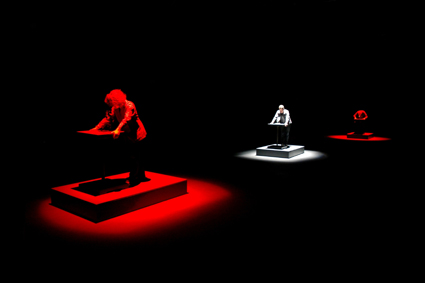
epi-thet
photo Dean Petersen
epi-thet
epi-thet
Epi-thet (Madeleine Flynn, Tim Humphrey and Jesse Stevens), by contrast, makes highly considered use of the Meat Market in its sound-based installation. Upon entering the work, sounds emanate from all sides, ping-ponging and ricocheting through the vast space. The visitor encounters three platforms lined up horizontally, each suffused with a soft red light as the piece rests in its ‘inactive’ mode. Attached to each platform are a series of mounted microscopes. As you step onto the platform, the light abruptly changes to a white spotlight—chromatically alluding to the fact that both you and the work are here to engage in a mutual performance. The sound and light shows that accompany each viewing of the microscopes are unique; generated by the height and posture of the participant, as well as the particular time of day.
Yet for all its insistence on individual composition and the presence of the participant as being crucial to the work, epi-thet remains eerily disembodied and inaccessible. The sounds that are generated are often indistinguishable, lacking in expressivity or material sources in the world. The linkages between the ‘sonification’ of medical research data, the interactivity of the piece and the microscope animations (tiny bird-like objects accumulating in patterns, with text fragments) are also unclear. Instead of amplifying our engagement with the work through the lures of sound—by playing to the fact that, as French theorist Michel Chion suggests, sound itself is decidedly un-framed and able to ‘fill’ a space in ways that an image cannot—epi-thet ends up subjugating our sonic involvement to the tiniest of visions. As we struggle to discern and understand the miniscule animations contained in its microscopes, sound drops out of the experience at the expense of vision.
Given their perceptual mismatches between the large and the small, as well as vision, space and sound, it is disheartening to find that the conceptual promise of these works has not been realised.
en masse, composition and performance Genevieve Lacey, film Marc Silver, installation sound Lawrence English, musical collaborators Steve Adam, Taylor Deupree, Christian Fennesz, Ben Frost, Nico Muhly, dj olive, lighting designer Paul Lim, Trafficlight, systems designer Pete Brundle, nice device, costume designer Paula Levis; Arts House, Oct 19-23; epi-thet, creators Madeleine Flynn, Tim Humphery and Jesse Stevens; Arts House, Oct 19-23; Melbourne International Arts Festival, Oct 6-22
RealTime issue #99 Oct-Nov 2010 pg. web
© Saige Walton; for permission to reproduce apply to realtime@realtimearts.net
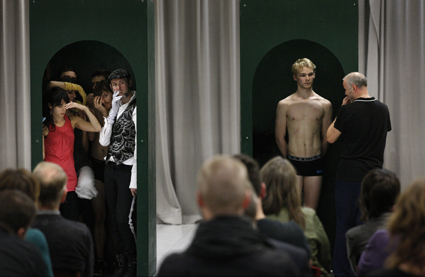
BalletLab at the Australian Ballet Studios in development for Aviary
photo Jeff Busby
BalletLab at the Australian Ballet Studios in development for Aviary
JUST BACK FROM TROY, NEW YORK STATE, VIA SAN DIEGO, ARIZONA AND DUSSELDORF, PHILLIP ADAMS HAS BEEN OFF THE BEATEN TRACK OF LATE. I MEET HIM AS HE PREPARES TO DEPART FOR ANOTHER DESTINATION—TIJUANA, MEXICO. WE TALK ABOUT GLUCKSCHWEIN, THE PRODUCTION HE IS MAKING WITH THE MEXICAN DANCE COMPANY LUX BOREAL. THE PIECE WILL FEATURE A SHEPHERD, DANCERS DRESSED AS SHEEP, 50 MEMBERS OF THE PUBLIC ON STAGE PLAYING TOY PIANOS AND SOME RITUALISTIC SACRIFICE.
festival de mexico
Wild as it may sound, Gluckschwein is actually part of a formal exchange between Mexico and Australia, run by the very respectable Australia Latin America Foundation, with dedicated funding devolved from the Australia Council. Over two years from 2010 to 2011, there will be residencies in dance, physical theatre and music, “aimed at sharing skills and creating new work between Australian and Latin American artists and artistic companies.” David Clarkson of Stalker began the initiative with a physical theatre project in Colombia and Roland Peelman of The Song Company is working in Guadalajara, Mexico. Alongside Adams, another Melbourne based choreographer, Rebecca Hilton, is working with Mexican dance company La Lagrima in Hermosillo.
Phillip Adams has been to Tijuana twice already. The four weeks of rehearsals to come will precede a final visit to prepare the work for its world premiere at the Festival de Mexico in March 2011. He is inspired by the openness of the Mexican dancers, who recovered well from his initial attempts to freak them out. Broken in by running naked through the streets and confronting some of Adams’ more extreme preoccupations, they were quick to overcome cultural barriers and throw themselves into the experience.
Gluckschwein is an echo of the parallel production, Above, that Adams will make with his own company BalletLab. It addresses similar themes of death, mortality and transcendence. For over a decade, Adams tells me, he has been pursuing related ideas. He traces an arc through the 1999 production Amplification (RT33) and its 2009 companion piece Miracle (RT93) that encompasses all his work. “Above will be the closure of this journey,” he says, “Why not finalise this enquiry into sex, life and death with a look into the afterlife?”
Adams saw work in the Festival de Mexico last year and is confident that audiences will enjoy the extremity of his vision and that the material will touch a chord. He has not attempted to incorporate specific cultural references but is sure that they will emerge in the work that he has devised with the Mexican dancers. Whilst Gluckschwein will tour for Lux Boreal and already has dates in San Diego and parts of Mexico in 2011, Adams will focus upon his BalletLab work as soon as he is back from Tijuana.
mona foma
Adams will spend the latter part of this year developing Above; which will make its world debut at MONA (Museum of Old and New Art) FOMA (Festival of Music and Art) in Hobart, Tasmania in January 2011 (see preview). Commissioned by MONA, Above will be presented as part of a trilogy, alongside Amplification and Miracle. These works will constitute the only dance presentations in the festival, which is curated by Brian Ritchie of Violent Femmes and characterised by a hard rocking, left-field, internationalist aesthetic. This prominence is testimony to the long-standing relationship between BalletLab and MONA founder and art collector David Walsh, whose own much-anticipated museum will be opening its doors to the public at the same time as the third “MOFO” festival. Adams is proud to be so closely associated with what he anticipates to be “a landmark event for the arts in Australia.”
Walsh’s previous support for BalletLab includes a pivotal investment in the New York State residency that led to the creation of Miracle. “This level of patronage and prestigious recognition is highly unusual,” says Adams. He is extremely excited by this opportunity to show his works together in the way in which they sit so coherently in his mind. “Above will be more of an event than a performance,” he says. “It will have the same impact as Amplification and Miracle but on a larger scale. Like Gluckschwein, Above will feature 100 toy pianos on stage and an element of public participation. There will be biblical motifs and an exploration of sacrifice.”
In his press material, Adams talks about the work as “a fairytale in the guise of a modern road movie.” When I ask about the artistic collaborators in the work, he tells me that he will only work with the dancers, and that he will undertake all other design elements, taking the design of Miracle as the starting point. “I am looking for a raw, pared back aesthetic for this piece,” he says. This makes Above unusual for Adams, whose strong mission for BalletLab has always benefitted from the input of first class composers, costume designers and other design professionals such as architects.
ballet and beyond
Whilst Adams has no current invitations to present the entire trilogy elsewhere, he is confident that such offers will come. Amplification, the work that really broke BalletLab on to the international scene in 2000, with its sex and death concerns and brutally beautiful dancing, will receive another outing at Melbourne’s Malthouse in the Dance Massive festival in March 2011. Miracle, the piece that premiered at Melbourne’s State of Design Festival last year, was recently shown at the Experimental Media and Performing Arts Centre (EMPAC) in Troy, New York State, in its Filament festival. EMPAC presented Amplification in 2007 and supported the Miracle residency in 2008, and this year, demonstrated their ongoing investment in BalletLab with two presentations of Miracle and an artist talk. EMPAC also worked with the company to invite other North American presenters to see the work. Adams hopes that further US touring will emerge from his long-standing relationships with the region and is also pursuing opportunities in Europe. His recent showcase presentation at the Internationale Tanzmesse NRW in Dusseldorf, a large dance platform and networking event, was an unusual move for an Australian company, but one that he is hoping will lead to commissions to make work with international companies and invitations to tour the BalletLab repertoire.
And Phillip Adams continues to add to that repertoire, with another work to premiere in Australia in 2011. Aviary is the result of a partnership with the Australian Ballet instigated through the Australia Council’s Interconnections program, which encourages a sharing of resources between arts organisations large and small. In 2009 Adams brought his contemporary dancers into the studios of the Ballet to work with classically trained dancers. Inspired by the music of Oliver Messiaen and by themes of war, masculinity and royalty, all overlaid with conceptual ideas about birds, the choreography pursued a meeting point of contemporary and classical.
A second development introduced the “dandy” aesthetic, drawn from a fruity palette of references from Beau Brummell to Gilbert and George. The collaborators for the final development, to take place in December this year, are a very BalletLab-like group, including milliner Richard Nylon, visual artist Gavin Brown and fashion designer Toni Maticevski. Adams says, “We are all of a generation; all Melbourne dandies.” Adams himself will perform in the piece, alongside five BalletLab dancers and one graduate of the Australian Ballet School. Aviary will be a large scale work for the proscenium arch, fitting, Adams says, “of the prestige of the relationship with the Ballet and the ambition of the piece.” This grand vision presages exciting times ahead for followers of the inimitable Adams and his BalletLab.
BalletLab, www.balletlab.com; MONA FOMA, Hobart, Jan 14-20 2011, http://mofo.net.au/
This article was originially published online, Nov 8, 2010.
RealTime issue #100 Dec-Jan 2010 pg. web
© Sophie Travers; for permission to reproduce apply to realtime@realtimearts.net
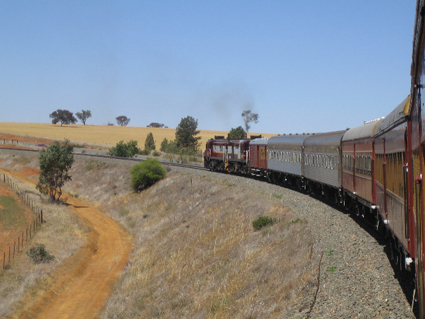
Junee Train, Rolling Stock
photo courtesy of Wired Lab
Junee Train, Rolling Stock
rollin, rollin, rollin
If you feel like an excursion to the country, or if you live in regional NSW, then you should head to Junee on Saturday November 20 for Rolling Stock, a range of site-specific installations experienced while riding though the countryside on a heritage locomotive. Many of the installations will be the result of a week of residencies in which artists collaborate with the local Junee community and curator Sarah Last has brought together an impressive list of contributors including Alan Lamb, Kate Murphy, Joel Stern, Ross Manning, Garry Bradbury, Justy Phillips and Ryszard Dabek, Dave Noyze and Shannon O’Neill. The special guest is UK artist Chris Watson, ex-Carbaret Voltaire band member turned field-recordist, who will present ‘El Tren Fantasma – The Ghost Train’, reworking field recordings he has made for Rick Stein’s documentary Great Train Journeys, into a surround sound experience on the train. The PVI collective will also be offering their participatory tug-o-war and while you travel you will be entertained by Australia’s own king of country Renny Kodgers. When you alight from the journey, the party continues with a Rockabilly band at the Junee Licorice and Chocolate Factory. Rolling Stock, Nov 20, 12pm–12am, journey starts at Junee Railway Station; www.rolling-stock.org (bookings essential)
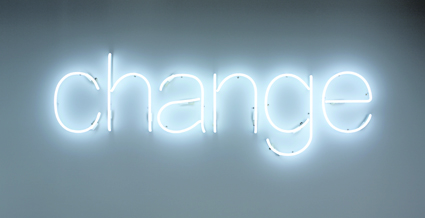
Change, 2005, Blair Trethowan
photo courtesy of the Monash University Museum of Art
Change, 2005, Blair Trethowan
muma
New York may have MoMA but Melbourne has a newly reinvigorated MUMA: the Monash University Museum of Art. The new museum, designed by Kerstin Thompson Architects, “combines increased gallery space and capacity, a landscaped sculpture court and a major architecturally-scaled public art installation by artist Callum Morton, titled Silverscreen” (press release). To celebrate, the museum is hosting a new exhibition called Change. Sourced entirely from the extensive Monash University Collection, the inaugural exhibition brings together more than 75 major works by Australian contemporary artists—from painting to photography, installation and performance. Change places work by John Perceval, John Brack, Charles Blackman and Roger Kemp alongside more contemporary work by Mike Parr, Tracey Moffatt, Susan Norrie, Marco Fusinato, Lydia Galbal Gjinabalyi, Raquel Ormella, Daniel von Sturmer and Blair Trethowan. Change, Monash University Museum of Art, Oct 27-Dec 18; www.monash.edu.au/muma/
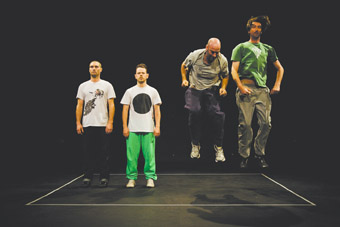
Byron Perry, Anthony Hamilton, Simon Obarzanek, Ross Coulter, Untrained, Lucy Guerin Inc
photo Untrained Artists
Byron Perry, Anthony Hamilton, Simon Obarzanek, Ross Coulter, Untrained, Lucy Guerin Inc
totally awesome
The phrase may recall the 1980s, but the Awesome International Arts Festival for Bright Young Things is happening here and now, meaning Perth in November 2010. Chief among the attractions is Lucy Guerin’s Untrained, which premiered in Melbourne in 2009 and was reviewed in RT90. Other intriguing performances include Track, a performance in which Vincent de Rooij, Udo Akerman and Daan Mathot (Netherlands) blend film and theatre to create a short film before your very eyes. “Udo’s miniature film studio (which happens to be a sea container) captures the action on camera in real time, using everyday objects as sets and characters, and is streamed live via projection on the opposite end of the sea container” (website).
There is also The Library of Nearly Lost Moments, which is to be installed at the State Library of Western Australia. The audience is invited to “check their pockets and see if there’s anything you can leave behind to preserve a moment in time…a train ticket? A sweet wrapper?” (website). For junior film lovers there is a series of animated films thanks to a partnership with the Los Angeles International Children’s Film Festival. Finally there is the Home Ground installation and exhibition, both of which are the result of a year-long program involving young people from 11 regional and remote communities. Awesome International Arts Festival for Bright Young Things, Perth, Nov 19-28; www.awesomearts.com/festival
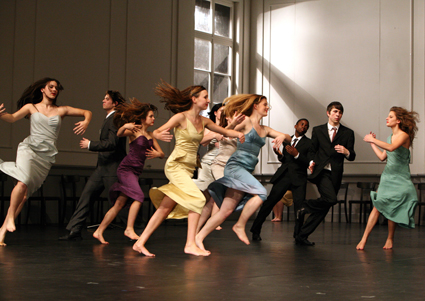
Dancing Dreams
photo courtesy of the Brisbane International Film Festival
Dancing Dreams
bring back the biff
If you miss the animated films in Perth then you may be interested in the animation programs at this year’s Brisbane International Film Festival. First up, there’s the International Animation Showcase, which features 13 of the finest short films from the archives of Britain’s Animate Projects, which has spent the past 20 years funding and producing animation. BIFF has also secured Sylvain Chomet’s (The Triplets of Belleville) new animated film The Illusionist, which is based on an unproduced script by French comic Jacques Tati, who wrote it between Mon Oncle and Playtime. But for those who like their bodies “live,” and not animated, perhaps Dancing Dreams will appeal. The documentary focuses on Jo Ann Endicott, an Australian dancer who spent roughly 30 years with Pina Bausch’s company, as she works with a group of Germans to restage Bausch’s Kontakthof. Bausch herself appears throughout the documentary to mentor and encourage the cast—the final footage captured of the choreographer before her death in June last year. Brisbane International Film Festival, Nov 4-14; www.stgeorgebiff.com.au
power to the powerhouse
While in Brisbane you may also like to check out the Brisbane Powerhouse, which is hosting two interesting events over the coming weeks. First, there is the new exhibition Spare Parts, which brings together a diverse range of artists using prosthetic limbs as their canvas. In addition, there is Ten Hands, a new one-hour work from Topology who we’ve previously reviewed in RT93. Ten Hands apparently evolved over an extended period in the rehearsal room where the group recorded their collective improvisations, then notated the best bits which were then used “as basis of the next jam session… This process went on repeatedly, with each member adding their own development and transition ideas until a single, unified, continuous one-hour piece emerged—strong, honed, individual voices intermingled into one sinewy whole, rich in musical thought” (website). Spare Parts, Nov 8-Dec 5, Topology, Nov 14, Brisbane Powerhouse; www.brisbanepowerhouse.org
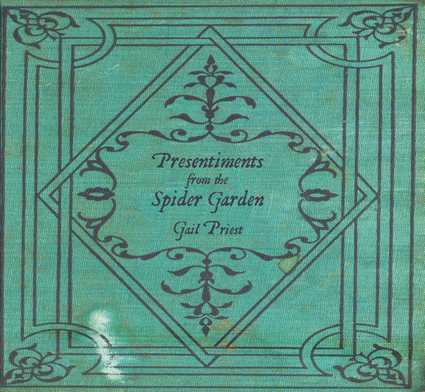
Gail Priest, Presentiments from the Spider Gardens
listening, moving and launching
We’re famous! Well, sort of. Some RealTime regulars are launching books and CDs this month. First, on November 14, there is the launch of VOICE: Vocal Aesthetics in Digital Arts and Media, edited by Norie Neumark, Ross Gibson and Theo van Leeuwen, all of whom have previously appeared in RealTime in one way or another. (We reviewed Memory Flows, an exhibition that Neumark both curated and contributed to, in RT97; read Gibson’s book The Summer Exercises in RT91; and reported van Leeuwen’s remarks on film education in RT98.) Then on November 16, there is the launch of Erin Brannigan’s Platform Paper, Moving Across Disciplines: Dance in the 21st Century. Founding director of ReelDance and now a lecturer at UNSW, Brannigan has written many articles for us over the years, most recently an introduction to our Archive Highlight on Lucy Guerin and an article on dance infrastructure in NSW (RT91). Finally our very own associate editor Gail Priest has just released her second full length CD, Presentiments from the Spider Garden, courtesy of Endgame Records. The album weaves “field recordings, vocals, instrumental material and extended digital methodologies into a haunting cabinet of curiosities” (press release). VOICE: Vocal Aesthetics in Digital Arts and Media, Ed Norie Neumark, Ross Gibson and Theo van Leeuwen, Gleebooks, Nov 14, rsvp www.gleebooks.com.au; Moving Across Disciplines: Dance in the 21st Century, UNSW, Nov 16 rsvp Jennifer Beale, j.beale@unsw.edu.au; Gail Priest, Presentiments from the Spider Garden, Endgame Records, www.endgame.com.au
RealTime issue #99 Oct-Nov 2010 pg. web
© RealTime ; for permission to reproduce apply to realtime@realtimearts.net
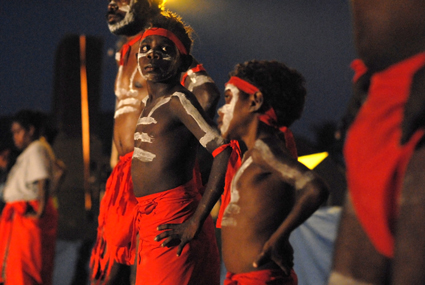
Groote Eylandt Dancers, Mahbilil Festival
photo Dominic O’Brien
Groote Eylandt Dancers, Mahbilil Festival
IT’S THE GOLDEN HOUR BY THE SHORES OF LAKE JABIRU, 300KM FROM DARWIN, AT KAKADU IN THE NORTHERN TERRITORY. AS THE MAHBILIL FESTIVAL SEGUES FROM AN AFTERNOON OF DODGEM CARS AND EXHIBITIONS INTO AN EVENING PROGRAM OF LIVE MUSIC AND DANCE, A GENTLE BREEZE ARRIVES. THIS IS THE ‘MAHBILIL’ FROM WHICH THIS LOCAL COMMUNITY FESTIVAL GETS ITS NAME, AND FITTINGLY, AS IT HITS THE GRASSY GREEN SHORES OF THE TOWN’S MANMADE LAKE, SO DO THE CROWDS.
The local miners and their families, the Bininj and Mirrar people who are the traditional custodians of Kakadu, the park rangers and outback tour operators who have been manning stalls throughout the hot afternoon, all gather before the Mahbilil Festival stage to enjoy the entertainment and to party on into the night.
In this, his third festival, producer Andrish Saint-Claire has managed to combine a smorgasbord of arts and activities where there is indeed something for everyone. From dodgem cars and waterslides to demonstrations of traditional Indigenous arts and crafts and Magpie Goose cooking competitions, variety is the order of the day.
The festival began at midday, as a family afternoon of stalls, fun rides and a showcase of performances and exhibitions by local children from all the workshops produced by the Kakadu Youth Centre through the Jabiru Area School. The atmosphere is reminiscent of the local markets for which Darwin is renowned—friendly, familiar, laid back. This is the time to sample buffalo stew and barbecued magpie goose cooked up by tour operators Andy Ralph and his wife Jen from the Kakadu Culture Camp; to chat with Kakadu rangers about killer crocs (if one ever bites your leg, punch it in the eye); and to sit with the local Bininj women as they weave their baskets out of pandanus painstakingly plucked from the bush and stripped, split and boiled up in ochre dyes over the camp fire. A casual attitude belies the deft artistry of these traditional women—and they have a canny knack, too, of always managing to find the coolest spot, anywhere, to spread out their tarp and pass the afternoon.
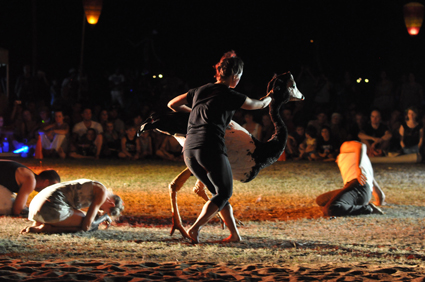
Goose Lagoon, Mahbilil Festival
photo Dominic O’Brien
Goose Lagoon, Mahbilil Festival
Dance was a feature of this year’s Mahbilil Festival, and again, the program was diverse. Balinese dance group Tunas Mekar, based in Darwin, brought a touch of Asia to a captivated bush audience and excerpts from Gary Lang’s Darwin Festival hit Goose Lagoon added a contemporary flavour to the program. The Bunggul—the traditional Indigenous performances that are part of any Top End Festival on Country—was led by the Groote Eylandt Dancers and Band. Displaying a great capacity for invention, these Groote Eylandt songmen were backed up by a rock’n’roll outfit with electric guitar, which added a foot-tapping beat to their mesmerising droning tones. They were definitely a crowd favourite, followed closely by the contemporary New Zealand ‘Maori Poi’ dance, which was taught and led by a local Maori teacher at the Jabiru Area School and performed with luminous ‘pois.’
Adding further spice to the multicultural mix was a Congolese dance troupe that appeared later in the program: such a confluence of cultures and influences has never been seen in Jabiru.
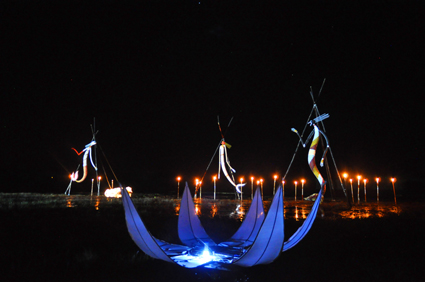
Techy Masero, Connor Fox and collaborators, Mahbilil Festival
photo Dominic O’Brien
Techy Masero, Connor Fox and collaborators, Mahbilil Festival
For all of this action and activity, the artistic highlight of the Mahbilil Festival was not by the lake but on it: a stunning installation of three giant traditional Indigenous figures, surrounded by giant floating lotus flowers, that stood sentry over the proceedings. Created by Darwin artist Techy Masero and a group of Territory artists who regularly work in Jabiru, the sculptures represented yawk yawks—the half-human half-fish mythological creatures, which, according to Indigenous cosmology, inhabit waterholes around the Top End.
Further artistic innovation was to be seen in the giant ‘turtle’ installation that formed part of the children’s parade. The turtle was both a canvas for a sequence of beautiful media projections and an interactive ‘set’ for the children of Jabiru, who emerged from the turtle’s mouth at twilight.
Mahbilil came to a close at midnight, with the rocking sounds of the Sunrize Band from Maningrida. The promise of something for everyone was met: this was an event that one could wander into and around at leisure, dipping into events and activities here and there, or, alternatively, settling onto a picnic blanket to watch the parade pass by—clowns, puppeteers and stilt walkers weaving their way through the crowd.
Staging any event in a remote area is a challenge, to say the least. And in Jabiru, which is a mining town, a regional hub, a gateway to a national park, there are entirely different ‘types’ if you like, living lives that never intersect. Yet with Mahbilil, Saint-Claire—a Darwin-based arts worker with extensive experience in remote Northern Territory communities—and his team have succeeded in bringing the community together for 12 hours by the shores of their manmade lake.
This is the strength of community arts. This is why, in this age of instant entertainment and constant distraction, they survive. Indeed Festivals on Country in the remote Northern Territory are thriving: they’re a live, visceral, dusty counterpoint to cyberspace, and combine contemporary culture with traditions and customs stretching back thousands of years.
As a relatively young venture, Mahbilil is still finding its way. It is certainly a festival to watch. The strong arts component—particularly the twilight art installations—set it apart from other regional festivals and has great potential to develop even further. With the strong support of the people, artists and sponsors, the festival looks set to become a feature of the Top End’s already flourishing Dry Season Calendar.
Mahbilil Festival, Jabiru Lake, Jabiru, Northern Territory, Sept 11
RealTime issue #99 Oct-Nov 2010 pg. web
© Jane Hampson; for permission to reproduce apply to realtime@realtimearts.net
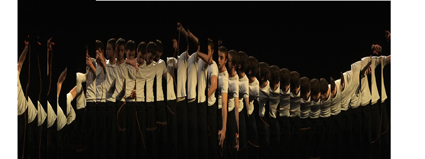
Richard Hilliar, Hybrid Dream
photo Grant Stewart
Richard Hilliar, Hybrid Dream
IN HYBRID DREAM, ECLECTIVE PRODUCTIONS, A GROUP OF ARTISTS WHO HAVE LARGELY EMERGED FROM THE UNIVERSITY OF NEW ENGLAND, ARMIDALE (NSW), CREATE A KIND OF DELIRIUM BY SEATING THE AUDIENCE IN THE CENTRE OF THE SPACE AND ENCIRCLING IT WITH PROJECTED IMAGES, SOUND AND PERFORMANCE IN A WORK ABOUT DREAM AND RELATED STATES.
Further unease is generated when single characters appear to be embodied by two performers at opposite sides of the space or two speakers at microphones face each other, intoning texts. The ensemble gathers, walks unexpectedly backwards in a circle, finally falling. Performers watch themselves projected onto screens around the space, the images slice up horizontally—nothing is stable. A man chalks “Nowhere” on a black wall. There are bursts of panic: we hear of someone stuck on the edge of a well: “I have no arms!” One performer chats to us about sleep: “Your imagination is at its strongest when you’re not even aware of it.” We hear of a woman who recalls an accident where she was badly hurt, but her serene version doesn’t include the screams that others heard. A performer watches a projected image of herself, shrieks and runs from it.
Projections in various degrees of close-up reveal a tasteful striptease act with feathers, danced to a woozy, gliding trumpet. Little flesh is revealed—it’s a classic tease—but meanwhile, in the dark on the mezzanine above us, the audience gradually becomes aware of a woman (the same one?) removing her clothes without any artistry until naked.
Hybrid Dream was an intriguing if sometimes infuriating experience: images were unnecessarily sustained, the work’s structure was opaque, some acting was over-the-top and performance and movement skills were uneven. However, the work’s stark evocation of dream states and parallel universes was generated with bracing fervour by a committed ensemble supported by a seriously sombre score ably delivered by a trio of musicians and a sound artist. It’ll be interesting to see where Eclective Productions take us next.
Eclective Productions, Hybrid Dream, creators, designers, directors Rachel Chant, Alanna Proud, performers Imogen Dodwell, Jonny Dutaillis, Lizzie Gibney, Richard Hilliar, Ben Horsley, Rhia Parker, Alanna Proud, Tristan Randall, Joanne Villacruz, sound designer Joseph Dutaillis, new media Grant Stewart, lighting Jamie Exworth; PACT Theatre, Sydney, Aug 11-15; www.eclectiveproductions.com
RealTime issue #99 Oct-Nov 2010 pg. web
© Keith Gallasch; for permission to reproduce apply to realtime@realtimearts.net
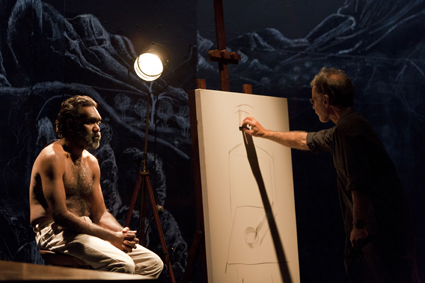
I HAVE NEVER SEEN THE MACDONNELL RANGES BUT TONIGHT THEY APPEAR BEFORE ME AS IF BY MAGIC. UPSTAGE, THE TWO BACK WALLS OF BELVOIR’S CORNER STAGE HAVE BEEN PAINTED BLACK AND COVERED WITH AN ENORMOUS WHITE CHALK MURAL DEPICTING THE RANGES AND THE GHOST GUMS THAT SURROUND THEM. WE ARE IN WESTERN ARANDA COUNTRY, THE HOME OF BOTH ALBERT AND KEVIN NAMATJIRA. THE FORMER IS THE FAMOUS WATERCOLOURIST WHO IS THE SUBJECT OF TONIGHT’S PERFORMANCE; THE LATTER IS HIS GRANDSON, AND AN ARTIST IN HIS OWN RIGHT, WHO IS ACTUALLY PRESENT, WORKING AWAY ON THE TEMPORARY WALL PAINTING FOR THE DURATION OF THE SHOW.
In front of these ghostly mountains, in the middle of the stage, is a large structure made of laminated wood that looks simultaneously like a deconstructed piano, an amorphous piece of public art and a section of undulating sandstone. Downstage is Trevor Jamieson, perched on a stool as the artist Robert Hannaford paints his portrait. The portrait looks well advanced but earlier production photos (see right) indicate that Hannaford started with a blank canvas, and like Kevin Namatjira, has been slowly adding to it each night.
Jamieson begins by introducing himself and his collaborators before sliding off his stool and telling the two seemingly unrelated stories of Albert Namatjira and Rex Battarbee. Namatjira was born as Elea but christened Albert by the Lutherans at Hermannsberg, where he stayed until he was in his early teens, at which point he returned to Arrernte country with his parents. Then at 18 he met and married his wife Rubina. Co-directors Scott Rankin and Wayne Blair throw the switch to vaudeville for this episode, with Jamieson as Albert and Derek Lynch as Rubina shimmying around the stage to Barry White’s “Can’t Get Enough of Your Love.”
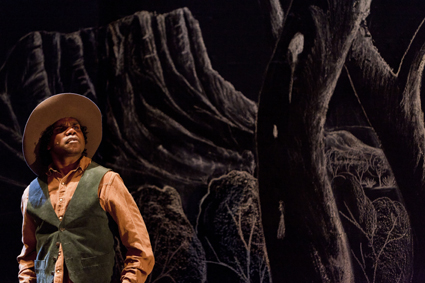
Derek Lynch, Namatjira, photo Brett Boardman
This first story is intercut with a second: that of Rex Battarbee, a whitefella who grew up in Warrnambool until he enlisted to fight in the First World War. While away he saw England and France before being seriously injured and returning home. Towards the end of the act, Namatjira and Battarbee meet and become friends, with Albert showing Rex his country, and Rex showing Albert his watercolours.
In the second act, the story gains momentum, just as Namatjira’s life did, and we move briskly through his many successes: his first exhibition (1938); his entry into the Who’s Who (1944); the award of Queen Elizabeth II’s coronation medal (1953); his meeting with the Queen herself (1954); and his attainment of citizenship (1957, a full 10 years before the referendum). However, success is bittersweet. Having money means that he has to support an extended family that numbers nearly 600 and having citizenship means that he has access to alcohol, which he is expected to share. When a woman dies on his property, it is he who is prosecuted because he is the only ‘citizen’ present. Namatjira is sentenced to six months hard labour, but after a public outcry is permitted to serve out the sentence at Papunya, where he eventually suffers a heart attack in 1959. The play finishes with his burial, and as we watch the man who has played him and the man who is descended from him stand in silence, it is as if we are witness to a second burial—the ghost of Namatjira is laid to rest in front of the ghostly mountains his grandson has conjured.
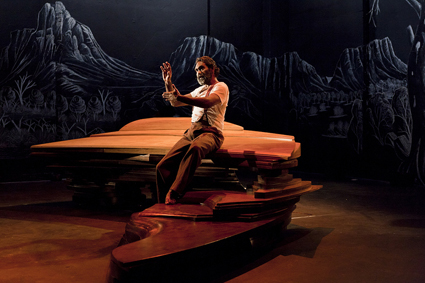
Trevor Jamieson, Namatjira, photo Brett Boardman
Beyond the impressive set (Genevieve Dugard), the principal pleasure of Namatjira is in watching Jamieson’s charismatic performance, as he slips between stories and characters, comedy and tragedy. Derek Lynch’s many sashaying women (black, white and a Queen to boot) are also enjoyable and Genevieve Lacey’s soundscape all-enveloping. The only false note in the evening comes after the curtain call when a stage manager reveals a small screen and we watch footage of the Big hART team working in the community. Presumably this is meant to reassure the audience about the nature of their engagement but it reads as both an odd sort of ‘reveal’ (and now, here are the real people) and as a pre-emptive strike against possible criticisms—one the production does not need since it is clear from both the program and the production itself that there has been not only consultation but also collaboration.
In a sense this collaboration echoes that of Namatjira and Battarbee, who apparently used to sit around in the evenings, talking about art, language and the world; two highly, if unconventionally, educated men, both of them globalised subjects before the word ‘globalisation’ even existed. This companionable image could serve as an analogy for the performance itself, for Namatjira is a convivial and thought-provoking night of stories, conversations and reflections.
–
Big hART and Company B Belvoir, Namatjira, writer Scott Rankin, co-directors Scott Rankin and Wayne Blair, creative producer Sophia Marinos, community producers Sia Cox, Pru Gell, performers Trevor Jamieson, Derek Lynch, artists Robert Hannaford, Kevin Namatjira, Evert Ploeg, Elton Wirri, musicians Nicole Forsyth, Genevieve Lacey, set designer Genevieve Dugard, costume designer Tess Schofield, composer and music director Genevieve Lacey, lighting designer Nigel Levings, sound designer Jim Atkins; Belvoir Street Theatre, Sept 25-Nov 7; www.namatjira.bighart.org/
Namatjira will tour to Melbourne, Dandenong, Geelong, Canberra and Illawarra from August 12 to September 30 2011. There are also plans for a national regional tour in 2012.
This article was first published online, Oct 12, 2010.
RealTime issue #100 Dec-Jan 2010 pg. 33
© Caroline Wake; for permission to reproduce apply to realtime@realtimearts.net
–
Top image credit: Trevor Jamieson, Robert Hannaford, Namatjira, photo Brett Boardman
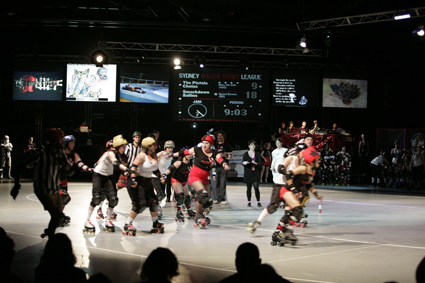
Bloodbath, Bump Projects and the Sydney Roller Derby League
photo Jonathon Delacour
Bloodbath, Bump Projects and the Sydney Roller Derby League
TEAMS OF GIRLS ROLLER-SKATE AROUND A TRACK BENEATH THE LIGHTING RIG. THEY’RE DRESSED IN LITTLE SHORTS, RIPPED FISHNETS AND CROP TOPS, THEIR TATTS, DYED HAIR AND MAKE-UP CREATING A MISH-MASH OF EVERY CONCEIVABLE SUBCULTURE—PUNK, GOTH, ROCKABILLY, METAL. THEY’RE ALSO PADDED, HELMETED AND GUARDED TO THE GILLS. THEY SKATE FAST AND HARD; THEY’RE AGGRESSIVE SHOW-WOMEN, EGGING US ON WITH SUDDEN RUSHES OFFTRACK, KNEE-SKIDDING FLAMBOYANTLY TO STOP JUST METRES BEFORE THE ‘SUICIDE SEATING.’ THEY’RE LIKE THE TOUGHEST CHICKS YOU EVER CAME ACROSS IN SUBURBIA WHO YOU WANTED TO HANG WITH OR ELSE WERE SCARED OF. AND THE REAL GAME HASN’T EVEN BEGUN.
Roller Derby is an American sports entertainment currently enjoying a global revival, with roots going back through various forms of contact sport and competitive skating to Depression era games that gave poor women an outlet. Contemporary derby is mostly female and driven by a DIY ethos. Sydney’s Hordern Pavilion is routinely booked out by a crowd that ranges from westie families to inner-city dykes. Australians seem born to it— feral, ironic, in your face, and underneath the piss-take, bloody serious about their sport.
It’s the perfect theatre for Bump Projects, a formidable team of some of the best new media artists in the country—Linda Dement, Francesca da Rimini, Kate Richards, Nancy Mauro-Flude and Sarah Waterson—who in collaboration with Sydney Roller Derby League presented Bloodbath, a mediation of bodies through technology. The artists created a system to collect data from sensors placed on the skaters’ helmets, and in tonight’s game used this data to trigger works screened above the stage.
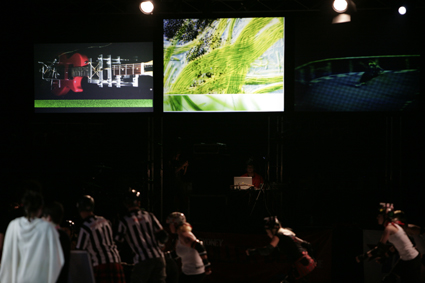
Bloodbath, Bump Projects and the Sydney Roller Derby League
photo Jonathon Delacour
Bloodbath, Bump Projects and the Sydney Roller Derby League
This was where the first problem lay. The smallish screens lined up side by side above the stage made for somewhat static viewing. The context is gladiatorial, in the round, but the screens stilled the gaze and crowded one another somewhat. Bigger and placed at intervals around the track, they would have integrated better with the action, a friendly bout between The Pistola Cholas and The Smackdown Sallies. (Yes, the team names, in keeping with the overall style, are facetious, OTT kitsch. Don’t get me started on the players’ names.) A quick look at the website indicates Bump themselves may have preferred a more spacious screen arrangement.
In this way the diversity of the works would also have been better appreciated. Dement’s, for me the most successful, was a bruise whose slow formation seemed a radical contrast to the mayhem of the track. But this clear articulation of trauma was apposite, the bruise healing to neutral skin, finishing with a lightly drawn flower or triggered by a collision to form another bruise immediately. Adjacent to Dement, Mauro-Flude’s text feeds were unfortunately barely legible to us in the bleachers opposite. The idea is interesting though: quotes from skaters, audience and artists, fed across the screen in a status update frenzy.
Kate Richards’ work, like Dement’s, seemed to survive the technical hitches best, her material being archives of old games. The alternately gliding or stertorous movements of the footage, colours becoming more intense with increased impact, complemented and grounded the event. As popular as the game is now, few of us have context for it, and this work went some way to providing it.
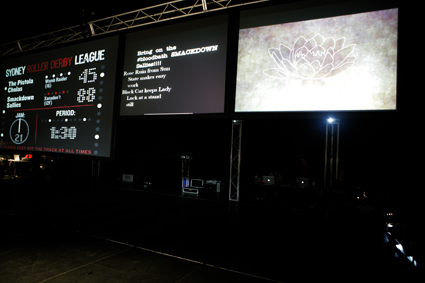
Bloodbath, Bump Projects and the Sydney Roller Derby League
photo Jonathon Delacour
Bloodbath, Bump Projects and the Sydney Roller Derby League
Da Rimini’s rich amalgam of medieval imagery, poetic fragments and mythical references felt too allusory for the context, but it has stayed with me. Waterson’s pink guitar, activated by the ramming blockers to play chords from Joan Jett’s “I Love Rock’n’Roll,” couldn’t be heard until towards the end and the visual was so subtle the whole thing didn’t appear to be working for much of the night.
Due to the many technical problems beyond the artists’ control, I felt I was attending a scratch version of Bloodbath, so my criticisms are reluctant. What could emerge from this project is incredibly exciting. If the works were to be fully integrated, they could become intrinsic. Roller Derby has a quasi-futuristic feel, partly because it’s women out there engaging in the sanctioned violence that draws us to sport. At the same time it’s the most ancient form of theatre, something that Francesca da Rimini is pointing to. The medium and method are attuned to the game, it’s just a question of the artists being given all they need for their works to be fully realised.
The second match of the night, Sydney’s Assassins vs Canberra’s Vice City Rollers, was a corker. Sydney led for much of the first half, then Canberra surged and it was neck and neck until a three point win by Sydney scored in the very last minute.
Bump Projects and the Sydney Roller Derby League, Bloodbath, artists Linda Dement, Nancy Mauro-Flude, Kate Richards, Francesca da Rimini, Sarah Waterson, producers Linda Dement, Kate Richards, original concept Linda Dement, technical development Mr Snow, House of Laudanum; Hordern Pavilion, Oct 9; http://bumpp.net/
This article was first published online, Oct 25, 2010.
RealTime issue #100 Dec-Jan 2010 pg. 22
© Fiona McGregor; for permission to reproduce apply to realtime@realtimearts.net
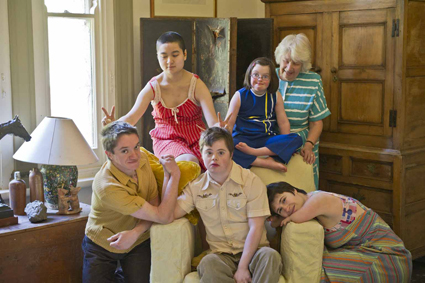
Next of Kin, Restless Dance Theatre
photo Chris Herzfeld
Next of Kin, Restless Dance Theatre
restless relatives
Restless Dance Theatre is typically described as a youth dance company that works with dancers of mixed abilities (see our reviews of Bedroom Dancing and Safe From Harm). However, in their latest show Next of Kin, they will be working with dancers of mixed ages as well. Next of Kin has an intergenerational cast of six to 60 year olds (some of whom are related in real life) and, according to the press release, “focuses on the family unit and its complex effect on kin relationships, personal decisions and individual responsibilities.” The show features a set designed by award-wining designer Gaelle Mellis and music by Zephyr Quartet’s Hilary Kleinig. The show also marks the directorial debut for Philip Channells, the company’s new artistic director. Restless Dance Theatre, Next of Kin, The Opera Studio, State Opera of South Australia, 216 Marion Road, Netley SA 5037, Nov 12-20; http://restlessdance.org/
physical music
Ensemble Offspring, who describe themselves as “champions of innovative new music” (previously reviewed in RT99 and RT92), are collaborating with one of Sydney’s most engaging performers, Katia Molino, and director Carlos Gomes of Theatre Kantaka, in a one-off event that is “as much physical as it is musical” (press release). The show, called Sounds Absurd promises to investigate “the visual spectacle surrounding the live performance of music” and will include “dancing hands, body slaps and musical instruments in nooses and upside-down cellos in drag” (press release). The evening will feature the music of Mauricio Kagel, a world premiere from Australian composer Moya Henderson, along with works by Thierry de Mey, Vinko Globokar, Matthew Shlomowitz, Stephen Stanfield and Jude Weirmeir. Ensemble Offspring, Sounds Absurd, CarriageWorks, Nov 30; www.carriageworks.com.au
musing and commuting
If you’re in Melbourne this month and, more specifically, passing through Southern Cross Station, keep an eye out for a studio, tea station and lounge. Set up by the artist collective one step at a time like this (formerly bettybooke), this installation is part of a project called Southern Crossings. Commuters will be invited to visit the group of artists at the station and contribute their stories about who they are, what they are doing and where they are going. Drawing on elements of their previous project en route (praised by Jana Perkovic in RT94), these stories will then be integrated into Southern Crossings, an audio journey on iPod which guides audience members through the station. “[I]ndividuals have an opportunity to see and experience the railway station beyond its everyday use—to think about people and places—and to engage with an iconic landmark from a different and more personal perspective” (press release). one step at a time like this, Southern Crossings, Southern Cross Station, stories collected Oct 25-Nov 16, showings Nov 18-Nov 28; www.onestepatatimelikethis.com/
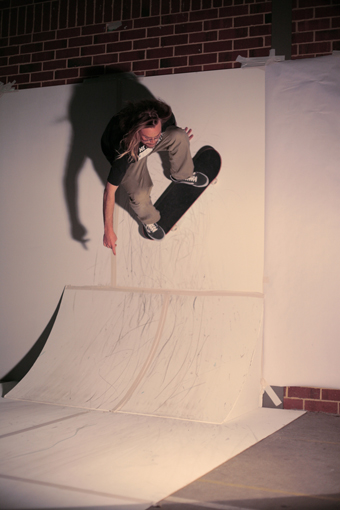
Suspended Motion
photo Pilar Mata Dupont
Suspended Motion
skaters in suspense
Over in Perth a similarly interdisciplinary project is underway at the Breadbox Gallery. Suspended Motion, features five artists—Ben Baretto, Cameron Campbell, Jason Hansma, James Hensby, and Tom Muller. Working with a team of builders and “skateboarding creatives,” including professional skateboarder Morgan Campbell, the artists will take over the Bakery to create sculptural installations, video and images where skateboarding will be used as a creative medium. You can see the video trailer here and read Darren Jorgenson’s review in our November 22 online edition. Suspended Motion, curator James Hensby, the Bakery, Breadbox Gallery, Oct 23-Nov 4; www.nowbaking.com.au
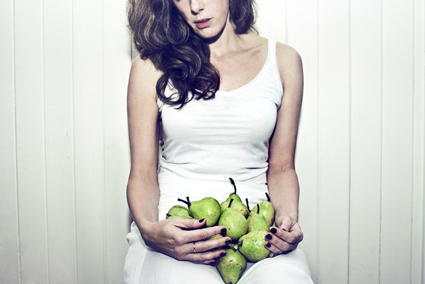
Dawn Albinger, No Door On Her Mouth – A Lyrical Amputation
photo Lisa Businovski
Dawn Albinger, No Door On Her Mouth – A Lyrical Amputation
shut your trap
Perth is also the place where writer/performer Dawn Albinger will be premiering her intimate new solo No Door On Her Mouth – A Lyrical Amputation. Using her signature tragic-comic style, she deploys fragmented narrative, poetic text and subtle humour to dislodge dominant readings of ‘romance,’ ‘femininity’ and ‘desire.’ Invoking choking divas, handless maidens and flightless women, the performance (with dramaturgy by Margaret Cameron and video art by Samuel James) offers “a philosophical answer, and performative response, to Irigaray’s question of how to say ‘I love you’ without it meaning ‘I wonder if I am loved’” (press release). Albinger’s Heroin(e) was reviewed in RT88) and this show will be reviewed in RealTime 100. Dawn Albinger, No Door On Her Mouth – A Lyrical Amputation, Blue Room Theatre, Oct 26-No 13; www.blueroom.org.au
light up, light up
Paris doesn’t immediately spring to mind when thinking of Brisbane, but Brisbane is in fact becoming a city of lights if not the city of lights. More specifically, it is currently hosting the Light from Light exhibition, which is showing simultaneously at the State Library of Queensland and the Shanghai Library in China. Visitors in each location come face to face with artworks that Australian and Chinese artists have embedded in collection spaces and public areas. In addition, they are also able to experience the same artworks in each other’s locations via webcam. The 20 light-inspired and light-generating artworks include neon art objects, light sculpture, images generated by solar telescopes and illuminated texts. Collectively they explore “the properties and metaphors of light, and the notion of libraries as sites of enlightenment” (website). The artists include Janet Burchill and Jennifer McCamley, Eugene Carchesio, David Haines and Joyce Hinterding, Lin Tianmiao, Archie Moore, Pak Sheung Chuen, Josef Strau, Wang Gong Xin, and Zhang Peili. Light from Light is an initiative of MAAP – Multimedia Art Asia Pacific. Light from Light, State Library of Queensland and Shanghai Library, from Oct 1; http://maap.org.au/
RealTime issue #99 Oct-Nov 2010 pg. web
© RealTime ; for permission to reproduce apply to realtime@realtimearts.net
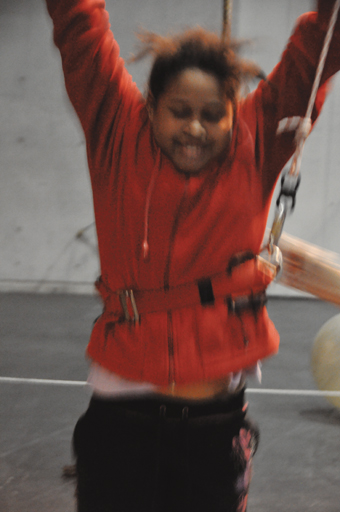
Wasana Dixon, Indigenous & Social Circus Skills Workshop
photo Simone O’Brien
Wasana Dixon, Indigenous & Social Circus Skills Workshop
While we think of visual art, music and now film as forms in which Aboriginal artists have had great success (if not always enjoying the benefits), theatre and dance have been more problematic. We admire Bangarra Dance Theatre, but it’s the only professional contemporary Aboriginal dance company in the country. In theatre, Perth’s Yirra Yaakin has survived a difficult period with a proud 15-year record, but Brisbane’s Kooemba Jdarra now appears only intermittently. Ilbijerri continues to produce significant work, presenting Jack Charles v The Crown with the Melbourne International Arts Festival and staging an exhibition of its 20 years at the Melbourne Museum (see in the loop). But are there sufficient opportunities for Aboriginal performers, established and emerging? Last year there was heated debate over Wesley Enoch’s proposal for a national Indigenous theatre as a means for coherently developing Aboriginal theatre. Since then he has been appointed Artistic Director of the Queensland Theatre Company, but how much Aboriginal work will he feel he can program? Training is another key issue. The Aboriginal Centre for the Performing Arts in Brisbane (RT98) and the NAISDA Dance College in Karlong (NSW) provide important opportunities, but in physical theatre and circus, if you can’t get into the National Institute of Circus Arts (NICA, Melbourne) and live in remote parts of Australia, what can you do? Simone O’Brien’s report on Heads Up at CarriageWorks reveals a considered and serious attempt to galvanise Indigenous and social circus artists, projects and companies across the country into a supportive network, not only to build careers but also a sense of community, dignity and purpose. Also significant is the need for dialogue between Aboriginal artists: Performance Space’s Indigelab (Oct 28-Nov 5) offers just that. Led by Wesley Enoch, it is designed for “Indigenous artists…keen to develop and extend languages to talk about their practice and in particular issues of cultural identity in relation to interdisciplinary practice.” Other opportunities include cross-cultural collaborations evident in Marrugeku’s considerable body of work and the Elcho Island-Nigel Jamieson collaboration, Ngurrumilmarrmiriyu (Wrong Skin). The major theatre companies also have a role to play: in the 2011 Sydney Theatre Company season, Bangarra’s Stephen Page and director Wayne Blair have united to create Bloodland to be performed in Yolgnu and pidgin, with traditional and contemporary movement and with well-known Aboriginal performers and Yolgnu people.The value of opportunities to come together, to share, to train, to talk, cannot be underestimated.
RealTime issue #99 Oct-Nov 2010 pg. 1
© Keith Gallasch; for permission to reproduce apply to realtime@realtimearts.net
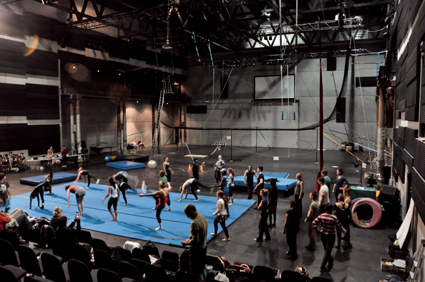
Indigenous and Social Circus Skills Workshop
photo Simone O’Brien
Indigenous and Social Circus Skills Workshop
OVER 50 INDIGENOUS AND COMMUNITY CIRCUS ARTISTS FROM ALL OVER AUSTRALIA GATHERED AT CARRIAGEWORKS, SYDNEY IN JULY TO ATTEND HEADS UP 2010, THE FIRST NATIONAL INDIGENOUS AND SOCIAL CIRCUS CONFERENCE AND PROFESSIONAL DEVELOPMENT PROJECT. PHYSICAL THEATRE PERFORMER, WRITER AND DIRECTOR SIMONE O’BRIEN WAS ONE OF THE ORGANISING COMMITTEE. REALTIME ASKED HER TO REPORT ON THIS SIGNIFICANT EVENT FOR INDIGENOUS PERFORMERS.
An exciting array of circus and physical theatre artists was brought together for the first time by Heads Up 2010, united by their passion for gutsy, raw and determined circus and physical theatre. Over the week, rising stars and established luminaries gathered to learn skills, develop material and create a showcase performance, Flying, which opened the weekend conference.
The depth of raw talent and finely tuned skills among these emerging and established circus artists was as huge as the geographical divide and the distances travelled to overcome it. Artists participating included Blackrobat from Koranda in far northern Queensland, who are one of Australia’s longest running Indigenous acrobatic troupes; two of the young Chooky Dancers from Elcho Island; Broome’s Sandfly Circus; Lismore’s Creative People’s Collective; Slippry Sirkus from Wauchope, NSW; Circus Monoxide, Wollongong; senior students from Airds High, NSW; Aerialize, Sydney; the Flying Fruit Fly Circus; Vulcana Women’s Circus, Brisbane; Westside Circus, Melbourne; Circus Ruccis, Melbourne; and Slipstream Circus from Ulverston, Tasmania. There were independent artists such as Louise Moriarty who has run many projects in Broken Hill, some in partnership with Cirque du Monde and the National Institute of Circus Arts (NICA); Jill Watkins from Gunnedah, NSW; Ira Seidenstein, Mikayla Anderson, Natano Fa’anana and Donna Carstens from Brisbane; Felicity Horsley from Melbourne and Nellie Simpson and Michael Smith from Perth.
Many of these artists also spoke at the weekend conference attesting to the incredible benefits of social circus programs. They gave moving accounts of their personal and professional experiences in making profound differences to young people’s lives. One stand out example is the story of Michael Smith and Nellie Simpson.
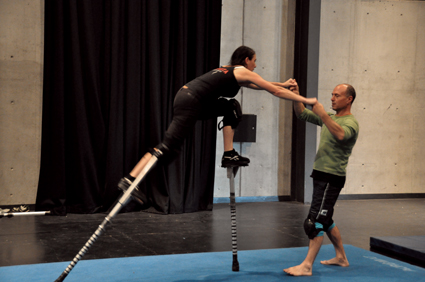
Larissa Deak and David Clarkson, Indigenous & Social Skills Workshop
photo Simone O’Brien
Larissa Deak and David Clarkson, Indigenous & Social Skills Workshop
talent in the long-term
Michael Smith is a rising Indigenous dance and circus star from Western Australia, currently studying second year dance at the Western Australian Academy of Performing Arts (WAAPA). He was 10 when he met Nellie Simpson, a circus artist at a pilot community circus project in Hilton, a suburb of Perth largely populated by Indigenous people and older generations of war veterans. Michael became an immediate circus enthusiast and, as the project grew, he became an instrumental link between Nellie and the community, travelling in the van with her as she collected kids to take to the project, providing helpful information about people’s whereabouts and family situations.
Nelllie Simpson’s holistic approach to her work was a source of inspiration for Michael as he felt that he was engaged in something more than just a project, that he was part of a philosophy. Many of the artists at the conference agreed on the importance of long term and holistic approaches in effecting real change; as Nellie put it, “Change happens slowly and over time.” Inevitably, questions about sustainability arise when looking at long-term strategic development and ongoing support for the sector in Australia.
stop the circus leaving town
From a bunch of circus vagabonds turning up to an outback town or housing estate to teach a bunch of bored kids to the high profile ventures of Cirque du Monde (an international social circus initiative between Cirque du Soleil and Jeunesse du Monde, a youth focused NGO) questions about the usefulness of short-term projects arise. What happens once the circus leaves town? As a young Brewarrina participant summed it up for the departing artist: “Thanks for fuckin nothin”, a kind of thanks-for-showing-us-what-we-haven’t-got. For some of these young people, the future can appear worse.
The sector has seen tremendous growth over the past decade as many Indigenous and non-indigenous communities have embraced social circus as an effective model for community engagement. Paul Woodhead, a high school teacher and founder of Circus West in Dubbo, noted that there were 60–80 schools in Western NSW alone that had circus programs and that he had worked with 5,000 students over 20 years in youth circus programs, and 350 of them had performed publicly.
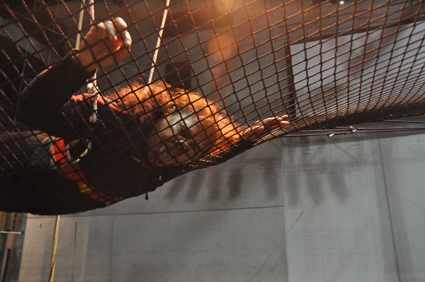
Aunty Malu aka Marlene Cummins (Redfern Women’s Traditional Dance Group), Indigenous & Social Skills Workshop
photo Simone O’Brien
Aunty Malu aka Marlene Cummins (Redfern Women’s Traditional Dance Group), Indigenous & Social Skills Workshop
liberated by circus
Donna Carstens, an Indigenous circus artist from Brisbane, now living in Sydney, discussed her project, Behind Closed Bars, which taught circus skills to young people whose mothers were in detention. Donna delivered the project with Sisters Inside, an organisation set up to support women in detention and their children. With the massive overrepresentation of Indigenous people in detention, most of the children involved in the project were Indigenous. Donna worked with the kids to create a circus show, which would then be videoed and sent to their mothers. It would take another two years before the video was seen in prisons.
The Behind Closed Bars initiative won a National Crime Prevention Award because from 60 participants only one went back to juvenile justice while others went on to do TAFE courses. One of the most moving stories came from a young girl who said that before she started the project she felt she had nothing to live for as her mum was in gaol and that she didn’t go to school and had been sniffing glue and petrol. Since doing the circus project she had found something she absolutely loved doing and couldn’t wait for the next class so she could climb on the trapeze. She had found something to be proud of and which she could show her mum when she got out.
Donna’s own story of circus helping her to escape the juvenile justice system was echoed by Noel Tovey. Noel opened the conference speaking about his experiences as an Indigenous artist who was on the street at 11, in gaol at 17 and dancing at Sadler’s Wells in London at 24. He cites the arts as his saviour, stating that if not for the performing arts he would not be here today as it strengthens and promotes Indigenous culture on a personal, spiritual and social level.
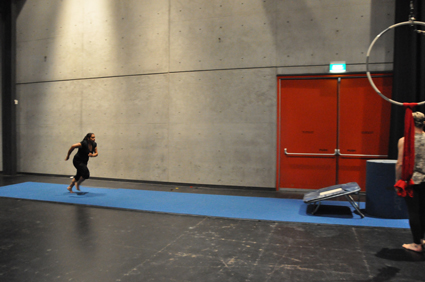
Alisha White, Indigenous & Social Circus Skills Workshop
photo Simone O’Brien
Alisha White, Indigenous & Social Circus Skills Workshop
the circus opportunity
Wendy Holland, an Indigenous academic and Associate Professor at University of Western Sydney, spoke at the opening of the conference with a paper entitled “Re-imagining Aboriginality to the Circus Space.” This fascinating talk traced Wendy’s family connections to Aboriginal circus performers travelling Australia in the late 19th century, her great grandparents being respected performers in the Fitzgerald Brother’s Circus. Wendy spoke of the opportunities the performing arts offered her ancestor Harry Kadellar in south-western Queensland in 1888, where he was ‘taken’ as a child into the circus. This gave him the opportunity to train as an equestrian acrobat from age five onwards and a better chance at survival (two years after he was taken from his family, his mother died of strychnine poisoning).
The circus was a place where Harry could celebrate and capitalise on his difference, providing him with income, travel and a diverse and ‘exotic’ family in which he could find his niche. Today social circus offers Indigenous and marginalised young people similar opportunities to rise above their circumstances through skills development, determination and talent to create a better life, however without adequate industry and government support, this may prove to be true for only a handful of artists.
the national view
One of the aims of Heads Up was to bring all the relevant stakeholders together to gain a national perspective on developments in the sector. Audiences heard from Marrugeku, Circus Oz, Legs on the Wall, Redfern Community Centre, Moogahlin Arts, National Institute of Circus Arts, Orana Arts, the Brewarrina Youth Circus, the Chooky Dancers, the Australian Circus and Physical Theatre Association and many of the artists mentioned above. This presented a unique opportunity to discuss the issues affecting the national development of the sector, such as on-going access to resources, training facilities and further career pathways and employment options and ways to identify strategic and sector wide approaches to address these issues.
flying
The other reason for the event was to bring together a unique set of highly talented artists and give them access to professional skills development and performance opportunities. The resulting showcase performance was an exciting blend of traditional dance, gender bending, short films, acrobatics and hip hop, dance and circus and an all-in group dance led by the Chooky Dancers. Raw talent flew beside highly trained technique, aerial routines were imbued with traditional dance. It was a fruitful skill share and rich cross fertilisation between Indigenous and social circus artists from all over Australia who had not had the means to work together before. It was an amazing week of workshops, performances, histories and testimonies that reflected the resilience of Indigenous cultures and closed the gap, bringing the sector together.
the future
Kate Reid from the Brewarrina Youth Circus was the main instigator of Heads Up. Her hopes for the future include “more inclusion of Indigenous artists and leaders across the board in the national circus industry…in order to develop realistic training options, artistic and managerial positions for Indigenous artists and leaders to help foster the development of the Indigenous circus arts sector from within existing organisations and in assisting new groups, programs, training centres and artists as they emerge.”
Heads Up 2010 organising committee: Kate Reid (Brewarrina Youth Circus), Josh Bond (Chooky Dancers), Lily Shearer (Redfern Community Centre and Moogahlin Arts), Simone O’Brien (Legs on the Wall). Major sponsors included CarriageWorks, Legs on the Wall, Redfern Community Centre, the Australian Recreational Centre for Aerial Arts and the Brewarrina Youth Circus. Financial assistance for this Project was provided by Arts NSW and the Federal Government through the Department of Health and Aging and the Indigenous Sport and Recreation Program.
Heads Up 2010, Indigenous and Social Circus Conference, CarriageWorks, Sydney, July 12-18
RealTime issue #99 Oct-Nov 2010 pg. 2-3
© Simone O’Brien; for permission to reproduce apply to realtime@realtimearts.net
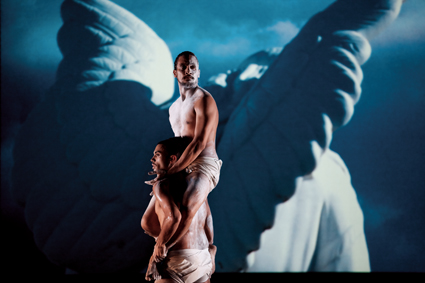
Waangenga Blanco, Leonard Mickelo, Angel, RILEY, of earth and sky, Bangarra Dance Theatre
photo Andy Solo
Waangenga Blanco, Leonard Mickelo, Angel, RILEY, of earth and sky, Bangarra Dance Theatre
SOFT WHITE CLOUDS DRIFT ACROSS BLUE SKY. OUT OF THE DARK BELOW, ON THEIR BACKS, CRAWLING BUT TORSO AND FACE UP, CREATURES SLIDE INTO DIM LIGHT. THEY WALK, BUT BEND THEIR KNEES TO THE GROUND, ARMS RIGHT-ANGLING OUT. LIKE STRANGE, EMERGENT ANIMALS THEY FORM BENEATH THE IMAGE OF A BOOMERANG AND TWIST, TURN AND ARCH, PERHAPS AT ONE WITH ITS SHAPE AND IMAGINED FLIGHT. THEY STAND, THE BOOMERANG FADES. ANOTHER CREATURE SCUTTLES THROUGH THE DARK AND A LOCUST FORMS BEFORE US, AGAIN ICONICALLY SUSPENDED IN CLEAR SKY.
In Bangarra Dance Theatre’s new season, Of Earth & Sky, the company is introducing a promising new Indigenous choreographer, Daniel Riley McKinley (24 years old, four years with the company) who has chosen as the subject and inspiration for his first major work the Cloud Series by the late Wiradjuri/Kamilaroi photographer and filmmaker Michael Riley (RT76; RT77). McKinley has selected six of the 10 images—feather, locust, bible, boomerang, broken wing, angel—objects suspended mysteriously in blue skies, and which for him relate most directly to Aboriginal culture. Omitted, for example, is Riley’s jersey cow, an almost comically displaced figure but equally indicative of ruinous environmental and cultural invasion.
Each image is projected onto a large screen behind the dancers and one by one is graphically realised and interpreted. Beneath the locust, dancers’ arms become wings as they cluster in groups and then en masse, to a buzzing electronic score and a riffing, insistent piano. The choreography manages to express not only a locust swarm, but also the gestures of those protecting themselves from it in a series of alternations. The plague escalates into a highly organised frenzy of sound and movement—straight lines and rapid circles, a fear-inducing army. Just as suddenly it stops. Something else scuttles across the stage.
A Bible, worn leather cover, hovers and a curiously abstract ritual of oppression ensues, hauntingly embodied by Elma Kris and soon multiplied in a row of other women on a diagonal across the stage, gold crosses emblazoned on—or ‘branded on’—their backs. They kneel, hands pushed up behind their backs, as if bound, and their heads drop to the earth. They rise, walk, go down on their knees as an eerie, distant female choir is heard buried deep in the music. They stand, elbows above their heads, hands behind their heads, palm to palm, like a distorted image of prayer or tortured angel wings, passing before us across the front of the stage and into the dark. The psychological pain induced by an alien religion that converts by bondage is palpable in the sheer otherness of the strange patterns that McKinley makes.
The Bible is replaced by a fragmented view of a graveyard sculpture. In this powerful episode two men with whitened bodies appear, one borne elegantly on the other’s shoulder, his body in a gentle arc, two bodies as one: is this the Angel? As the carried body extends further out, it’s as if gravity is being defeated. The bodies twist and roles are reversed, carried becomes carrier in a sequence of sinuous moves, as if on air, in this the most ambiguous of McKinley’s episodes. It’s as if he’s asking, are there angels, divine helpers, and can they be as beautiful and strange as this—and Waangenga Blanco and Leonard Mickelo can answer this for him.
In a mysterious return to the Bible, men in short skirts, the same gold crosses extending the length of their backs, dancing wide-stanced, like Pacific Islanders perhaps, execute obscure tasks, move angularly and fluently dance in a circle of blue light, almost warrior-like in contrast to the equivalent female episode—an image here of some kind of accommodation? McKinley writes in his program note: “The men represent the other side of the religious experience as an exaggerated religious presence.”
The screen turns white. A woman (Jasmin Sheppard) swathed in feathers crawls across the floor to a low cello growl, her body wracked, struggling to rise in a painfully exquisite pattern of elaborate moves that seem to engage every part of the body in the effort as Michael Riley’s Broken Wing image appears on the screen.
Riley’s Feather replaces Broken Wing and the whole ensemble dance: the patterning is formal, the movement light and elegant, no longer saturated with symbolism, animism or literal image-making. As they leave, the dancers gently drop feathers to the floor. McKinley writes that “in Wiradjuri culture, a feather can represent the marking of a journey had…I feel that Riley is my feather, it has connected me to Michael…”
McKinley’s work is sometimes more abstract than the company’s has been, but also at times quite literal, if always about the embodiment of land, animal and spirit and what puts these at risk. There is inventiveness and welcome unpredictability in the choreography, if not always convincingly sustained, and a theatrical assuredness if not always on top of its symbolism. But Riley represents a strong beginning for McKinley’s work with Bangarra and a welcome new vision.
If McKinley’s Riley is the sky of the program’s title, Of Sky & Earth, Frances Rings’ Artefact is its earth from the very first image, titled Museum (see cover image). It’s as if something very alive and alien has sprung from the soil in the form of a large possum cloak that writhes, revealing multiple arms and human legs (Daniel Riley McKinley and Travis de Vries). It’s an astonishing image that gives more than literal life to the idea that this encased museum object once sheltered many people, even across generations; it suggests a spiritual relationship between artefact and wearer and, as Rings writes in her program note, the maker. Artefact is a work of restoration in more than the museum sense of the term.
The next image also astonishes: a pale, out-sized, huge curved bark, such as might be used to carry food, a coolamun, gradually appearing upstage. It will rock, be climbed, turned over, inhabited and appear to float. From it people dance out to forage, the women harvesting with their string bags, the men to grind stones in dances that hover engagingly between representations of making and extended explorations of movement.
In Bodies, the work’s most literal episode, heritage is denigrated by 19th and early 20th century Western attempts to ‘scientifically’ prove that Aboriginal people are an inferior species—the missing link to the Stone Age. If Bodies labours its point with projected images and mechanical movements of measurement to show how Aboriginal people were themselves made museum artefacts, we are soon returned to the magic of objects and their making.
A wary, wide-eyed woman dances sensually in a flowing head-dress and grass skirt and, in Weaving, a huge golden skein of woven pandanus leaves—of women’s making presumably—envelops the men while the women’s dance has been itself a kind of weaving. Then, as often with Bangarra, Artefact concludes communally, if ambiguously. I was left with a rewarding sense of Rings’ restoration of life and spirit to artefacts, their making and makers, realised with Jacob Nash’s design, especially the giant coolamun for its poise and balance, and Gabriela Tylesova’s costumes that so aptly expressed their making.
With its focus on contemporary images and the ancient heritage of artefacts and their embodiment in and through dance, Bangarra’s Of Earth & Sky is an engrossing and thoughtful artistic exploration of a living culture.
Bangarra Dance Theatre, Of Earth & Sky: Riley, choreographer Daniel Riley McKinley, Artefact, choreographer Frances Rings, design Jacob Nash, costumes Gabriela Tylesova, composer David Page, lighting Damien Cooper, artistic director Stephen Page; Drama Theatre, Sydney Opera House, July 23-Aug 28
RealTime issue #99 Oct-Nov 2010 pg. 4
© Keith Gallasch; for permission to reproduce apply to realtime@realtimearts.net
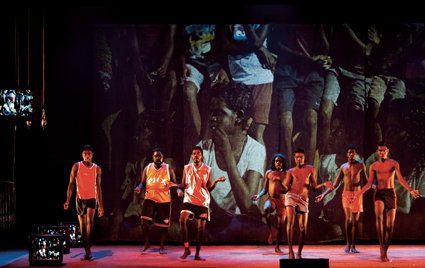
Ngurrumilmarrmiriyu (Wrong Skin), Chooky Dancers
photo Matt Nettheim, image courtesy Performing Lines
Ngurrumilmarrmiriyu (Wrong Skin), Chooky Dancers
WHETHER IN THE CREATIONS OF BANGARRA DANCE THEATRE OR MARRUGEKU OR HERE IN THE CHOOKY DANCERS’ NGURRUMILMARRMIRIYU (WRONG SKIN) AT THE SYDNEY OPERA HOUSE SPRING DANCE FESTIVAL, THERE’S A RECURRENT, RESTLESS, CHURNING DIALECTIC AT WORK, SEEKING TO BRING THE PAST INTO A DYNAMIC RELATIONSHIP WITH THE PRESENT—IN ARTISTIC ACTS OF RESTORATION, CONTRIBUTIONS TO SELF-UNDERSTANDING AND POSSIBLE RECONCILIATION BETWEEN INDIGENOUS AND WESTERN CULTURES.
While Bangarra is an independent Indigenous company that works with white collaborators on set and lighting design, Marrugeku and the Chooky Dancers’ Wrong Skin (and, interestingly, the film Ten Canoes) structurally replicate the cultural dynamic of Aboriginal and non-aboriginal collaboration—an evolved, shared black and white artistic direction of Marrugeku and with Wrong Skin a collaboration between Elcho Island people (the island is off north-eastern Arnhemland), writer-director Nigel Jamieson and other white collaborators.
After seeing Wrong Skin at this year’s Adelaide Festival, Carl Nilsson-Polias wrote in “Dialectical entanglements” (RT97) that he admired it as “a brilliant populist work.” However he felt that although the use of “the complex Yolngu moiety laws as the basis for a forbidden-love story, with overt references to West Side Story along the way [gives Jamieson] a straightforward narrative hook on which to hang various dance sequences and video montages of life on Elcho Island…it also imposes a stifling rhythm on proceedings and created a strange tension: are the performers co-creators or merely the subjects of the work? Occasionally, it even reveals the technical shortcomings of the dancers when they are required to step out of their own style.”
Wrong Skin is a hugely enjoyable creation, at its best in its dancing, its sense of humour and dexterous multimedia realisation. But there is no denying that the work’s embracing buoyancy evaporates towards the end as the love tragedy is acted out conventionally (which is not to say that the actors are inadequate). It seems a curious modus operandi given the radicalism of the Chooky Dancers’ cultural collaging that underpins much of the work alongside the multimedia layering of live performance and film. Another form of telling might have been more apt, and more palpably belonging to the performer co-creators.
These concerns aside, Wrong Skin succeeded on other fronts. The dancing ranged from the Chooky Dancers’ famous YouTube take on Zorba’s Dance to Bollywood and Hollywood inflected routines (developed with choreographer Gavin Robbins). These were performed on red earth rising in clouds and with more detail, speed, articulation and overall shaping than I’d anticipated—there’s much more than energy and charisma at work here.
The Chooky Dancers’ performance gained unexpected additional complexity when the large screen behind the performers revealed footage of the Elcho Island community, especially children, dancing furiously. Here is culture where pop, Bollywood and Hollywood and more exotic musics (Turkish, Arabic) are a part of everyday life. Suddenly we knew that the Chooky Dancers were not a one-off, a bunch of young men with a show to get on, but of their culture, absorbing and integrating forms that they like. The dark side is, of course, modernisation that plays havoc with kinship constraints.
There were other surprises, even shocks. In particular, we witnessed on film the funeral ceremony of an elder—his body in an open casket, a huge community gathering and, in its midst, a woman hurling herself repeatedly to the ground in grief. There was no way to avoid feeling like an intruder, especially since we are used to Aboriginal constraints on naming the dead, seeing images of or hearing them in the media, let alone witnessing something like this. But the Elcho Island community collaborated on Wrong Skin and one of the show’s island producers, Margaret Garawirrtya, told a post-show reception that the man, her husband, had been a key instigator of Wrong Skin and that the show was presented in “the memory of Frank, ‘the father of music’ in north-eastern Arnhem Land.”
Moments like these, alongside images of poverty and objections to the ‘Intervention’ were juxtaposed with happier representations of home and community and a playful embrace of the modern in routines with portable DVD screens and supermarket trolleys given low-budget Busby Berkeley treatment. The mobile phone in the plot proves a more problematic indicator of cultural stress when it comes to the issue of keeping people apart in the name of tradition.
The great strength of Wrong Skin is that it draws on the Chooky Dancers’ joyous integration of tradition and modernity, multiplying it with a range of media and performative means, revealing both its enormous creative potential but also delineating its impediments and pointing to what might be lost. Wrong Skin’s ending—a death, love thwarted, a community divided—suggests that the Chooky Dancers’ synthesis of tradition and the new is but one celebratory part of something much more difficult to resolve.
Ngurrumilmarrmiriyu (Wrong Skin), writer, director, designer Nigel Jamieson in association with the company, associate director, movement Gavin Robbins, associate director, community and cultural liaison Joshua Bond, costumes Mathew McCall, film & video design Scott Anderson, video production Mic Gruchy, lighting Trudy Dalgleish, composition, sound design David Page, Basil Hogios; ?performers Djakapurra Munyarrun, Djali Donald Ganambarr, Frances Djulibing, Rarriwuy Hick, Anthony Djamangi, Lionel Dhulmanawuy, Anthony Djamangi; Chooky Dancers: Aaron Djimilkinya, Daren Matan, Nathan Guymangura, Gerald Dhamarrandji, Wakara Gondarra; Spring Dance, Playhouse, Sydney Opera House, Sept 2-12
RealTime issue #99 Oct-Nov 2010 pg. 6
© Keith Gallasch; for permission to reproduce apply to realtime@realtimearts.net
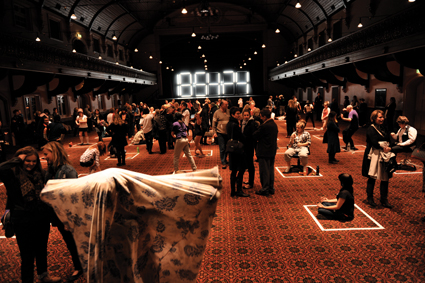
WeTube LIVE, Stompin’ Youth, Junction Arts Festival 2010
photo Mark Webster
WeTube LIVE, Stompin’ Youth, Junction Arts Festival 2010
I’M STANDING IN THE MIDDLE OF AN ANALOGUE VERSION OF A DIGITAL EXPERIENCE. TO MY LEFT, RIGHT, FRONT AND BEHIND PERFORMERS DANCE, YELL, SCREAM, PLAY GUITAR, TALK AND GESTICULATE WILDLY. EACH IS WORKING WITHIN ONE OF A HUNDRED NOTIONAL STAGES MARKED OUT BY WHITE SQUARES ON THE FLOOR. A GIANT ‘DIGITAL’ CLOCK CLICKS OVER AT THE REAR OF THE HALL. I AM FREE TO WALK THROUGH THIS THREE-DIMENSIONAL RECREATION OF YOUTUBE AND IT IS DELICIOUSLY CHAOTIC.
WeTubeLIVE is part of the Junction Festival held as an adjunct to the Regional Arts conference of the same name, drawing over 500 delegates from all around Australia to meet and discuss a wide range of issues relating to arts practice. Launceston is a small centre in the North of Tasmania and rarely hosts events that register themselves all over the city with installations, performances, temporary live venues, projects and roving interactive performers, plus an injection of enthusiastic, creative strangers. I regularly heard locals ask with amazement, “Am I really in Launceston?”
WeTubeLIVE is a festival highlight. Devised and directed by Ben Speth with Stompin Youth, the work is simple but powerful. Each of the performers was asked to select a favourite YouTube clip and reenact or reinterpret it in any way they wished within their ‘screen,’ their square. All of the performers are teenagers, making the subject material incredibly pertinent. While a core of the group simply dance energetically on the spot in a range of styles from classical to street, the remainder do anything from play guitar in a bear suit to climbing inside a quilt cover and performing a soliloquy. And there is a lot of screaming, angst-ridden noise and strong gesticulation peppering the grid.
When the audience is set free, WeTube is already ‘playing’ and we walk among the players. Within a minute, the audience fills the grid and it becomes difficult to tell the difference between the two groups. Refresh points happen every 10 minutes, with all of the players stopping with eyes closed, leaving their squares to chat or curl on the floor. It’s really interesting to see how the audience behaves, chatting casually within the chaos, then falling silent as the players stop. As time wanders on, the audience also loses and refreshes its attention span, the players start to exhaust themselves and a strong aroma of teenage sweat builds within the grid. At the end of an hour, as we leave, WeTube continues.
This is a work of its time. All of the detail is perfect. The selection of YouTube clips by the players, their personal sound systems and the distinct performance spaces become a reflection of the cult of the individual and the seam of vanity now epitomised by Facebook. And yet, underneath it all, WeTube reveals a desire to build communities in whatever way possible, through numbers of friends, conversations within comment threads or just through laughing at the same clip. As in YouTube, the interface and the outcome are democratic. Not only are there no lead players, WeTube is open to anyone and there is little difference between audience and performers—making the ‘we’ appended to ‘Tube’ in the title more meaningful.
Carcophany is another show that connects with our moment in time while linking to an aspect of local Launceston culture. It has three variations over two days, but the performance I catch is in the ground level of a multi-storey carpark after dark. The show is built around sound emerging from 12 cars parked around the edges of the concrete space like a monstrous stereo. Each car forms one channel in the composition and is parked with its rear to the audience with doors, boots and hatches open so that the sound washes out across hard surfaces. The guitar-based soundscape that emerges and builds is an immersive experience that I would liken to sitting front and centre at a Dirty Three concert (which is a pretty lovely thing to do).
Composed by Mathew Timmis, Carcophony is intended to explore a global obsession with cars, but also keys into the Launceston blockie culture. Cars, with stereos booming, matching each other around the one-way circuit of the CBD, or doing blockies, is a well-known Launceston phenomenon. So it was quite fabulous that an artist grabbed that culture and transformed it into a symphony.
Connecting with these works ‘of their time’, Hobart-based IHOS Opera’s Borders picks up on contemporary fears and political concerns. In a deliberately tight, claustrophobic space, in traverse arrangement, the audience is introduced to a short, but visceral work about being on a journey involving considerable uncertainty, the pain of waiting and the anxiety of limbo. The players are a young man caught on this purgatorial journey, an operatic and decidedly bureaucratic angel and a seemingly benevolent panda. The young man is a hostage to his situation, which might be the razor wire enclosure of a refugee processing centre or the concrete walls of a hostage cell. The angel, depicted on large screens behind each half of the audience, sings the rules to him as he begins to lose the plot, while the panda cautions patience, speaking in English and Mandarin. Having been ordered into randomly numbered seats, facing each other within a smoke filled room, we are trapped with this man, waiting our turn to lose faith. At one point a wind machine blows loose plastic bags through the space; at another we are all ‘de-contaminated,’ recalling pre-landing aeroplane cabin spray. It is an intense and slightly esoteric experience, but if the aim is to communicate the texture of fear known to refugees and hostages, then it is successful. I leave feeling windblown, stomach churning.
Inclining much more to delight than fear, Toronto-based Mammalian Diving Reflex (MDR) present a work that has been staged across the world. Haircuts by Children is exactly that, a performance within a local salon—in this case Studio Hair and Beauty—where local children become hairdressers. The work is part of Social Acupuncture, explained at the conference by producer Natalie de Vito as performance that makes small incisions into the urban fabric that are a little uncomfortable, but inevitably lead to people feeling better. While initially dubious about the participation rate in Launceston, I discover a delightful chaos of mini hairdressers in the salon. Each child has been trained over a number of weeks by local hairdressers in order to prepare them for their part. There is a lot of excitement and giggly chatter, but I see that some precision work is happening as a young boy carefully sprays colour onto a woman’s hair, his young assistant holding a shield protecting her eyes. Tricky shaved patterns, spray dots and many tiny pigtails emerge in the city as a result.
Also dishing out delight was PANE staged in Retrovision’s shop window. In this show by MADE, devised by Glen Murray and Nicole Robson, seven women pitched as 50s housewives, dance in white gloves in front of an overscaled photographic backdrop of a 1950s kitchen and loungeroom. MADE is a group of ‘veteran’ dancers who were probably all born a few years shy of this decade, so the staging has an amusing underlying irony. Their slow mime-style dance with expressive, cheeky faces and touches of irreverent humour is a hit with the gathered audience, particularly a vibrant three year-old who dances throughout the performance, bows as we applaud and then joins the dancers in the window space. As we all stand around on the street, rugged up in winter clothes in the growing dark, gazing into the windows of an electrical store, there is a wistful connection with the days when this was the only way most could watch television and those kitchen canisters in your kitchen weren’t yet retro.
I’ve only explored five of Junction’s shows here, but I hope I’ve communicated the rich experience there for the taking in Launceston over five days in August. Works that really hit the mark for me were those that tended to break or stretch the rules and to reach out a hand, figuratively or otherwise, to the audience. I’d forgotten how much fun and how energizing it is to be in a city awash with events, the scale of Launceston making it possible to dash between conference and festival without driving or running a marathon.
Junction Arts Festival, part of the Regional Arts National Australia Conference, Launceston, Aug 26-29, www.junction2010.com.au
RealTime issue #99 Oct-Nov 2010 pg. 8
© Judith Abell; for permission to reproduce apply to realtime@realtimearts.net
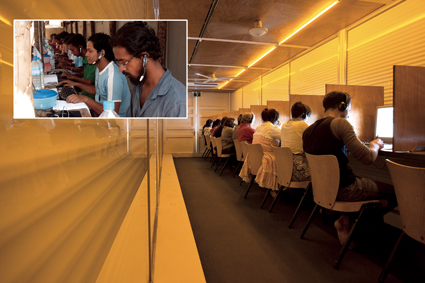
Life Streaming
photo Maarten van Haaff
Life Streaming
WHATEVER TERM YOU PREFER (AND I PREFER ‘RELATIONAL’, AS THIS IS PRIMARILY A THEATRE OF SOCIAL AND SPATIAL RELATIONS), THIS FORM DOMINATED THE LONDON SUMMER OF 2010. BATTERSEA ARTS CENTRE (BAC) PRESENTED AN ENTIRE FESTIVAL OF ONE-ON-ONE WORKS, WITH OVER THIRTY ONE-MAN-(OR WOMAN)-SHOWS CRAMMED INTO THE OLD BATTERSEA TOWN HALL IN SOUTH LONDON. THE MORE CENTRALLY LOCATED LIFT (LONDON INTERNATIONAL FESTIVAL OF THEATRE) DEDICATED THE LION’S SHARE OF ITS PROGRAM TO EVENTS THAT COULD JUST AS EASILY HAVE BEEN TERMED MASS GAMING, COLLECTIVE SKYPING OR SCAVENGER HUNTS.
At the Barbican, during the same period, You Me Bum Bum Train entered history as their fastest-selling show ever: part theatre, part Thank God You’re Here, it turned each audience member into the protagonist, made to improvise their way through a series of dramatic situations in front of the supporting cast of 200. With so much emphasis on you, the spectator, forgive me if the rest of this article privileges the second-person singular.
one-on-one festival
An immersive event in its own right, One-On-One Festival was possibly its own greatest achievement. The least one could sign up for was a marvellously organised afternoon of mingling through a building crammed with secret one-man wonders, appointment card in hand. The atmosphere was surprisingly welcoming, even festive: performers and spectators crossing paths in the same courtyard and café, recommendations exchanged, friendships commenced, queues spontaneously forming outside the rooms with hidden gems on the strength of on-the-spot word of mouth. Repeatedly diving into a 2-or-3-minute intensely collaborative performance, being in turns swung and shaken, kissed and sung to, frightened or intellectually challenged, by the end of the day one had no personal boundaries left to speak of.
Despite being cumulatively great, One-On-One also demonstrated how quickly an emergent genre can settle on a limited range of solutions. One kind seemed tailored to break through fears of intimacy: Abigail Conway’s On Dancefloors invites you to dance; Emma Benson sings a song with you in Me You Now. Most radically, Adrian Howells gives you a bath in The Pleasure of Being: Washing, Feeding, Holding, while Ansuman Biswas’s more open-ended 2 FREE offers the possibility of engaging with a naked, blindfolded man. However trivial they may sound conceptually, these were some of the most powerful performances in the festival, spoken about in hushed, almost spiritual tones. You found yourself entering these rooms with the same mixture of compulsion and terror with which you might climb into a roller-coaster (and they certainly act as a kind of psycho-social one, including the lag with which you process the experience afterwards). But if theatre is ever genuinely life-changing, it is in the strangely liberating afterglow that follows consensual nudity.
Another, quieter type of performance centred on material reality, and the tactile dimension of the experience generated, not so much inter-personal intimacy as greater understanding of how the world works. Barnaby Stone’s A Little Bit of a Beautiful Thing is a story of a wooden beam, a finely polished slice of which you will receive at the end. In Ray Lee’s Electric, your body becomes a conductor. Another focused on creating a first-person narrative, employing cascades of clever sensory illusions: for the 10 minutes of Just For a Moment, by Three Blind Mice, you have a drink at a pub, lie on the beach, dance Macarena in the world’s most terrible discotheque, witness a fight and have to be walked out of the pub at the end of the night, despite being blindfolded in a single room. Stan’s Café use mirrors, projection, costumes and clever framing to generate a 240-second film noir before your very eyes, with you as the chief villain, in It’s Your Film. While these works were longer, more carefully shaped and satisfied some of that need for dramatic spectacle that drives people into theatres on perfectly lovely summer days, their beauty again seemed to derive chiefly from the promise of intimacy, of being made-to-measure and the soporific pleasures of being touched, rather than from well-executed tricks.
The most accomplished works brought together the cerebral and the felt, offering an encounter while questioning its limitations. Sarah Johns’ Below plays with your perceptions: dragged into a dark room, her performance catches you before you can make sense of where you are. Facing a mirror and a singing girl, your focus shifts abruptly from one detail to another, resulting in a series of mesmerising, well-defined impressions, as if in a film. And of course, towering above the rest, is Ontroerend Goed’s trilogy of brief, but flawless works that boldly question the gullibility of the audience.
As Peggy Phelan writes, theatre has always been a meeting place, always offering the promise of a communion, an exchange—even across the proscenium arch. The relationship between audience and performer is, in her words, “the always already unequal encounter [that] nonetheless summons the hope of reciprocity and equality” (Unmarked: The Politics of Performance, Routledge, 1993). Relational performance is the inevitable end-product of this quest. Yet in it, intimacy emerges not only as a tool and a goal, but as a major concern: can we have it, how, by what means and why do we desire it in the first place? A number of works at BAC traded on the false promise of quick intimacy, and most fell short: after all, the obvious difficulties of building a rapport with the actor in five tightly scripted minutes cannot be overcome just by holding hands. Ontroerend Goed’s Smile Off Your Face, Internal and A Game of You capitalise on this disingenuousness. Internal, in particular, set up as a speed-dating session followed by a sweetly cruel group debrief, builds the illusion of a budding attraction only to break your heart (comparing notes with other viewers is soul-crushing). Yet, for all its oversharing, Internal provides a dose of needed realism in a universe made of caresses. It stands as a reminder that there is no such thing as conveyor-belt romance, no intimacy on a mass scale, and that audiences often give their hearts away too easily.
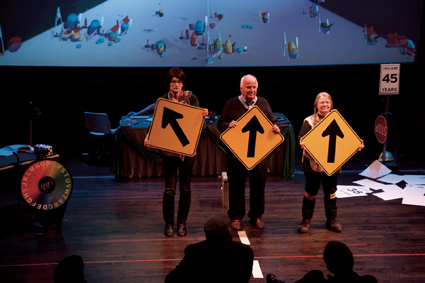
Best Before, Rimini Protokoll
courtesy the artists
Best Before, Rimini Protokoll
lift 2010
The polar opposite of the high-concept One-On-One, LIFT 2010 was a festival with an identity crisis. Rubbing shoulders were weekend events for kids, formalist community theatre and the occasional think piece. Yet here, too, the most interesting works were from the relational family.
Rimini Protokoll’s Best Before (RT96, p2) is a computer game for the whole audience. Represented by a globular multi-coloured blip, for two hours you live as a proud citizen of Bestland, making personal choices (tertiary education? children? buy a house? own a gun? try heroin?) and participating in collective decision-making (legalise drugs or guns? form an army? welcome immigrants? equal capabilities or a diverse population?). As the game progresses, you reap the fruits of some decisions and suffer the limitations of others, while your range of choices progressively narrows as you age. It is a game of consequences, but also of chance—some blips are randomly wiped out by epidemics and war while, ultimately, the whole population dies of old age. I found the end unexpectedly poignant, realising that there was no final payoff for all my prudent life choices (I had grown old with a big family and plenty of real estate). I suspect the experience varies according to your age and life experience, but also audience demographics.
Bookmarking the game is Rimini Protokoll’s trademark presence of non-performers, or rather ‘reality experts’—in this case, the game designer, a game tester, a lobbyist and a traffic flagger whom the other three would have passed by on their way to work. Their guidance and stories serve both to contextualise gaming in the real world, to relate Bestland to the political choices that Vancouver has faced, and to reconnect our personal choices to non-virtual consequences. The tension between the two aspects of Best Before, which never quite connect, is a productive one, even though I found the four Canadians’ lives infinitely more intriguing than my avatar’s cyber-shenanigans.
The real treat of the festival was Dries Verhoeven’s Life Streaming. The concept is minimal: in a makeshift internet café, each audience member conducts their own video chat with a young person in Sri Lanka. In the interstices of the poetic, but tightly orchestrated structure, filled with pre-prepared text and film and guiding us through such topics as the tsunami, loss and grief, my interlocutor and I manage to insert a real conversation about life, healthcare, the scent of the sea and lying in bed with total strangers. The work keeps the question of its own intent open, incorporating sensorial stimuli to create an exuberant experience not unlike a perfect holiday in South-East Asia, while at the same time allowing for an unusual degree of self-propelling interaction. Consequently, you come away with a real connection to a human being—if you so wish. Like Ontroerend Goed’s trilogy, Life Streaming raises big questions about art, reality and intimacy, but lets you choose your own answers.
to shop or not?
Elinor Fuchs argues that relational theatre is the last step in theatre’s commodification: after the ice-cream in the interval, now we can get ice-cream during the performance. Indeed she terms it “shopping theatre” (The Death of Character: Perspectives on Theater After Modernism, Indiana University Press, 1996) as it can so closely resemble a walk through a department store. It allows us to buy a reproduction of an experience that could not be bought otherwise. The physical set up, finally, is remarkably similar to a brothel—the room, the queue, the illusion of unique relationship.
However, I am not sure I entirely agree. At its worst, relational theatre combines the direst aspects of amusement parks and popular psychology, perhaps. But at its best, it incorporates the most conceptually interesting aspects of drama therapy, while allowing us to see our own experience through a critical prism. It highlights the qualities of everyday life, in all its mundane materiality, without distortion, in ways naturalistic theatre has consistently failed to achieve. Finally, the illusion of intimacy, of giving, which has existed for as long as theatre, can now be scrutinised in genuinely interesting ways. Relational theatre allows the exploration of the encounter between the artist and the spectator, an encounter that may be obviously staged, but is also more frank about its limitations. Once there are really only the two of you, the artifice becomes first disappointing, then bearable and finally, perhaps, genuinely empowering.
One-On-One Festival, Battersea Arts Centre (BAC), July 6-18, London; LIFT 2010: Rimini Protokoll, Best Before, created by Helgard Haug, Stefan Kaegi, dramaturg Tim Carlson, game design Brady Marks, video design Candelario Andrade, set design Andreas Kahre, sound design Stegan Smulovitz, with Duff Armour, Brady Marks, Ellen Schultz, Bob Williams/Arjan Dhupia, June 30-July 3, Institute of Contemporary Art (ICA); Life Streaming, director Dries Verhoeven, dramaturg Nienke Scholts, technical production Joffrey Kranen, Silk BV, National Theatre, June 23-July 4, LIFT Festival, London, June 23-July 13
RealTime issue #99 Oct-Nov 2010 pg. 10
© Jana Perkovic; for permission to reproduce apply to realtime@realtimearts.net
{$slideshow} MORE AND MORE, AND PERHAPS IN RESPONSE TO THE GLUT OF PERFORMANCE IN FRINGE FESTIVALS, A SMALLER, MORE FOCUSED AND, MOST IMPORTANTLY, CURATED KIND OF FESTIVAL OF INDEPENDENT WORK IS EMERGING. IN AUSTRALIA WE HAVE SYDNEY’S IMPERIAL PANDA AND TINY STADIUMS FESTIVALS, AS WELL AS MELBOURNE’S DANCE MASSIVE, WHICH IS, AS ITS NAME SUGGESTS, SLIGHTLY LARGER. THE FOREST FRINGE MICROFESTIVAL TOOK PLACE AT LONDON’S BATTERSEA ARTS CENTRE FOR THE FIRST TIME THIS YEAR, A TWO-NIGHT LINE-UP OF WORKS-IN-PROGRESS, ONE-ON-ONE PERFORMANCE PIECES AND SITE-SPECIFIC INSTALLATIONS.
In theory, if not always necessarily in practice, such festivals offer the audience a certain concentration of quality, as well as the reassurance that sometimes comes with a curatorial seal of approval. Everything has been programmed for a reason. Russian roulette, which navigating a fringe festival program sometimes feels like, it is not.
Presented by Collective:unconscious and Brooklyn’s East River Commedia at Manhattan’s Performance Space 122, the Undergroundzero Festival of Theater Artists, now in its fourth year, is very much a quality-controlled fringe festival, one of many that take place in New York City during the summer months as a prelude to the city’s official fringe festival in the autumn. Curated by East River Commedia’s Artistic Director, Paul Bargetto, this year’s three-week festival comprised some 20 works from the United States and abroad, including Australia, and impressively redressed the usual imbalance between quantity and quality.
It was also impressive in its scope. Curation is often an act of creation, with the festival programmer a kind of auteur, stamping their imprint on their festival and indulging their own formal and thematic concerns. Bargetto is an exception to this rule: his festival revealed little about what sort of work he favours or what sort of stories and themes float his boat. With a line-up of performance styles as varied and distinctive as any fringe festival’s, only with several hundred fewer works with which to achieve such variety, his festival saw high brush up against low, opera against burlesque, contemporary dance against musical comedy and adaptation against improvisation.
Of this last dichotomy, Dangerous Ground Productions’ From Dawn till Night (The Earth is Uninhabitable like the Moon) and Anna Brenner’s Are We Here Yet? served as representative examples. Using live video and an open-plan set to collapse time and space (not a particularly original approach, but nonetheless visually arresting), the former was a multimedia adaptation of Rainer Werner Fassbinder’s In a Year of Thirteen Moons, while the latter was based on a series of improvisations that followed the four-strong cast’s observation of people in Riverside Park on the Upper West Side. Both productions comprised a series of one-on-one interactions unfolding in abstract space: in the former, the transvestite and the straight man he loved, his distant mother, his sympathetic best friend; in the latter, the old man and the social worker, the political candidate and the virile younger man, the book club president and the washed-up author. But the ends sought by each production could not have been more different.
While Brenner aimed to explore the interconnectedness of people—Are We Here Yet? was essentially a four-hander in the vein of Patrick Marber’s Closer or Jane Bodie’s Fourplay, only with a theoretical bent explicitly stated in the text that occasionally took precedence over character or story—From Dawn till Night’s Romanian-born director-designer Doris Mirescu was interested in the utter isolation of individuals, even, indeed especially, from themselves.
Isolation and alienation, of course, were the great themes of Andy Warhol, who once famously claimed, among many other things, that he never felt the need to be close to anybody after he purchased his first television set. Like so many of his public statements, this one was at once caustic, ironic, truthful and sad: humorous because shameless, disconcerting because familiar. Combining elements of Warhol’s biography, philosophy and aphoristic wit, Theater Bielefeld’s Forever Art attempted to capture these contradictions, which so characterised the artist and his work. To the extent that the production—not a one-man show, but close—was successful, it was due to John Wesley Zielmann.
The actor channelled Warhol as though he were a cadaverous mad scientist poised between explosion and implosion and liable to go one way or the other at any given moment. The uncanny physical resemblance of Zielmann to Warhol was compromised a little by his voice—the production was in German with shoddily typed surtitles that could have done with a proof-reader—but the actor’s evocation of the artist’s constituent strangeness and sadness was stunning. In the production’s most memorable and terrible scene, Zielmann engaged in a contemporary dance number that saw him convulsively slamming his fists against his chest and his body against the floor, almost as though he were performing an exorcism on himself.
A much lighter, if occasionally foul-mouthed kind of musical number was offered by Blue Dress Reduction, easily the funniest and most immediately charming production at the festival. Written and performed by Eliza Bent, Jasmin Hoo and Elizabeth Stevenson, the low-budget musical comedy was the sort of piece you tend to find by accident at fringe festivals or in the smaller, less well-attended venues of a comedy festival, another example of how curation can often help to separate wheat and chaff for an audience. Blue Dress Reduction told the story of the three writers’ real-life visit to England to be bridesmaids at their best friend’s wedding, with culture shock and the usual unplanned mishaps of travel helping to turn the event into an unmitigated disaster.
In addition to the musical numbers, with their delightful, slightly unpolished air, the piece was notable for its unscripted sequences, where the house lights came up a little and the three women spoke candidly to each other about the trip, and its parodic characterisation of those who occupy the other side of the pond. Eliza Bent, whose She of the Voice premiered at last year’s festival, was particularly impressive as the hoity-toity mother-of-the-groom, and one senses that it was she who was the creative force behind the project. In any case, she is one to watch, with all the makings of a great comedienne.
The festival’s most affecting work also told the story of three friends, though only one of them was ever onstage, and instead of singing musical numbers he chanted for his football team: Ireland, during the November 2009 World Cup qualifying match that saw Frenchmen Thierry Henry’s hand make sure the paddies wouldn’t be going to South Africa in 2010. Named for an Irish number that is traditionally sung at the end of a gathering of friends, Dermot Bolger’s The Parting Glass, produced by Dublin’s Axis Ballymun in association with New York’s terraNOVA Collective, was a fascinating monologue about emigration and the meaning of home, as well as family, loss and friendship. A sequel to Bolger’s 1990 play, In High Germany, which saw the three aforementioned friends move away from Ireland, The Parting Glass dramatised the decision of one of them—played brilliantly by Ray Yeates, with genuine warmth and feeling—to return.
The results were often funny, often moving, and also very often political. The piece was highly critical of Ireland’s Celtic Tiger years, insisting that far fewer benefited from the country’s economic boom than perhaps could or should have, and was similarly unimpressed by the post-boom period, to which Yeates’ central character returns. But its polemic was held close to its chest, wherein beat a lot of heart. And it was this heart, more than any economic or political critique, that made the piece the intense experience that it ultimately was.
But perhaps the festival’s most striking work was Fabiana Iacozilli’s Aspettando Nil, a feminist take on Waiting for Godot that actually felt more like a cross between The Glass Menagerie and Abbott and Costello. Elisa Bongiovanni and Giada Parlanti played chain-smoking mother and daughter, respectively, preparing themselves, like Tennessee Williams’ Amanda and Laura Wingfield, for a gentleman caller to arrive—which he would do, mother told daughter, when the two of them were “ready.” And so they readied themselves for the man—for any man, really—excitedly dressing and putting on make-up, prettifying themselves in a series of slapstick sequences and talking about what sort of responsibilities the daughter would have towards her new beau.
Like The Parting Glass, Aspettando Nil was at once both humorous and moving, as well as fiercely political. Unlike The Parting Glass, it was also formally inventive, using Waiting for Godot as a launch pad for its own satirical exploration of gender roles, insisting, as its title suggests, that a woman who waits for a man is waiting for nil, for nothing. The meaning of Beckett’s play, of course, is somewhat more ambiguous, open to interpretation where Aspettando Nil is rather explicit. But one can certainly understand why Iacozilli thought it appropriate to her ends. After all, Beckett’s is the play in which, famously, nil happens twice.
Collective:Unconscious & East River Commedia, Undergroundzero Festival of Theater Artists, PS122, New York, July 7-26; www.ps122.org/performances/undergroundzero_festival.html
RealTime issue #99 Oct-Nov 2010 pg. 12
© Matthew Clayfield; for permission to reproduce apply to realtime@realtimearts.net
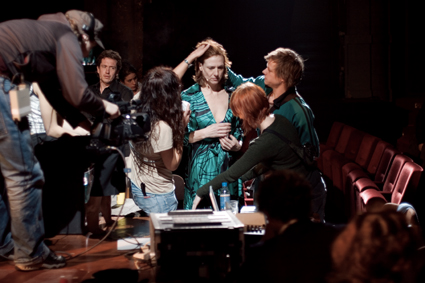
Opening Night, Toneelgroep Amsterdam/NTGent
photo Jan Versweyveld
Opening Night, Toneelgroep Amsterdam/NTGent
BY BRINGING A JOHN CASSAVETES FILM TO THE STAGE, ONE WOULD SUSPECT THAT DIRECTOR IVO VAN HOVE WANTS TO START A CONVERSATION ABOUT THE INTERPLAY BETWEEN CINEMA AND THEATRE. INDEED, THE FACT THAT THE FILM OPENING NIGHT IS SET IN A THEATRE APPEARS TO CONFIRM THIS SUSPICION. AND BY INCLUDING A RAFT OF SCREENS AND CAMERAS IN THE PRODUCTION, VAN HOVE APPEARS TO BE MAKING SOME STRONG OPENING REMARKS. BUT IN TRUTH, HE HAS NEVER SEEN THE FILM HE IS STAGING AND THINKS OF THE CAMERAS AS THEATRICAL, RATHER THAN CINEMATIC DEVICES.
Now 52, van Hove was 19 years old when Opening Night was released. He might have missed that film but, growing up in Antwerp, he had made a habit of visiting the local art house cinemas and devouring Cassavetes’ earlier works, along with those of Michelangelo Antonioni, Ingmar Bergman, Pier Paulo Pasolini and Luchino Visconti.
As a teenager, the emotional and psychological terrain of Cassavetes’ films was alien to van Hove, but the intimacy and rawness of the work were evident and infectious. When he returned to the films in his 30s, he felt their full impact and set about bringing them into the theatre. Adapting films for the stage has been brilliantly lampooned by the likes of Wes Anderson (Rushmore, 1998), however, van Hove is not strictly interested in staging films—he is interested in staging screenplays. The difference is more than academic because by removing the desire to mimic or deconstruct the visual and aural language of cinema, van Hove can simply concentrate his efforts on realising the text with the same set of skills and theatrical inventiveness he brings to any play.
Film titles—Scenes from a Marriage, Teorema, Rocco and his Brothers—leap out from van Hove’s directorial résumé. He sees these screenplays as an exciting frontier because staging them for the first time is effectively to premiere them. Instead of being the thousandth director to tackle The Cherry Orchard he can be the first to tackle Cries and Whispers on stage. And he looks at Antonioni and Bergman not in terms of the aesthetic markers that characterise their cinema but in terms of their thematic uniqueness—who does death better than Bergman, who examines love in modern society like Antonioni?
And Cassavetes? Open, actor-oriented screenplays dealing with adult relationships in all their sensuality, vicissitude, violence and, most importantly, artifice. In 1997, van Hove presented a staging of Faces in the Netherlands, which, in a brilliant perversion of cabaret seating, had the audience lying shoeless in beds as the actors performed around and almost on top of them. He wanted next to tackle Husbands but Cassavetes’ wife Gena Rowlands politely withheld the rights because of the very personal subject matter. Instead, van Hove came to read Opening Night and found in it a story equally compelling. The film centres on a famous actress, Myrtle Gordon (played by Rowlands), who is struggling through the rehearsals of a new play, which also stars her ex-husband (played by Cassavetes). Gordon’s internal conflicts burst to the surface when an adoring young fan dies in a car accident (a dramatic catalyst quoted by Pedro Almodovar in All About My Mother, 1999). Cassavetes’ screenplay avoids pinning down exactly what is at the heart of Gordon’s psychological turmoil and instead revels in its complexity and unresolvedness. It could simply be viewed as a portrait of an aging actress driven to despair by the death of her younger self (the fan), but van Hove sees it also as a family tragedy. Either way, in its examination of inner lives curtailed by social mores and niceties, it continues John Cassavetes’ obsession with the difference between people’s private and public faces—the masks and artifice of adult life.
The first words van Hove wrote in his copy of Opening Night were “Neil Young.” Music always plays a vital role in van Hove’s theatre, whether it is Steve Reich’s minimalism in his latest production in New York, The Little Foxes, or six hours of live percussion in his compendium of Shakespeare’s Roman tragedies. Indeed, van Hove is happy to label his work “music-theatre” just to emphasise how much more music is than wallpaper to him. In this case, Neil Young’s “Heart of Gold” provides what van Hove refers to as “an extra layer of humanity” with its “good-sentimental” tone.
Alongside that song, Marc Meulemans’ sound score for the stage production is a constant companion that sometimes underscores moments of choreographed movement. These interludes of physical expression are some of the most apparent theatrical extrapolations on the source material. Van Hove is fascinated by the way in which psychological subtexts can be explored or made manifest by physical motion and he emphasises that his actors are always very physically engaged with the text they are speaking. He cites the French opera, theatre and film director Patrice Chéreau as a key influence on the way in which he directs bodies in space. But the physical dynamics at work also reveal the creatively symbiotic relationships between van Hove and his Belgian contemporaries: Anna Teresa de Keersmaeker, Alain Platel and Jan Fabre.
But what of the cameras? By giving the theatre the capacity for a close-up, they enlarge and expand the emotions on stage. Hence van Hove thinks of them and the video screens as a contemporary extension of some of the oldest theatrical devices we know of—Greek masks. In this sense, one could argue that the video aspects of van Hove’s Opening Night reaffirm Cassavetes’ obsession with the many masks that people wear. Yet van Hove shies away from such thematic neatness and points instead to practicality and circumstance as the reasons for video’s inclusion. On the one hand, he wanted to reduce and simplify the many locations of the film but, on the other hand, to maintain the sense of the text being set in a theatre. He and his designer Jan Versweyveld created a theatre on the stage, complete with paying audience. Thus, the set is a rangy agglomeration of public and private spaces, some of which simply cannot be seen from the main auditorium without the aid of cameras.
Of course, even this reductive explanation reveals that the cameras give the audience access to spaces, both physical and psychological, that would otherwise remain hidden or private. In fact, the best analogy for van Hove’s use of video in Opening Night is the fly-on-the-wall documentary crew that lucks out by happening on a crisis. As people attempt to maintain appearances and gloss over problems, the cameras reach behind the delusions and obfuscations.
The constricted, magnifying gaze of the camera with this power to unravel and reveal can be intoxicating, but van Hove maintains that the screens do not diminish the importance of the actors being physically present (the fundamental differentiator of theatre). To ensure this, he frustrates the audience by never giving them everything in one medium or the other. In other words, it is impossible to receive and follow every moment of Opening Night by watching the screens or the stage in isolation. It is only in their combination that the narrative unfolds, that the characters reveal themselves and that we see both sides of the mask.
Melbourne International Arts Festival, Toneelgroep Amsterdam/NTGent, Opening Night, by John Cassavetes, directed by Ivo van Hove; Playhouse, Arts Centre, Oct 20-23; http://www.melbournefestival.com.au/program
RealTime issue #99 Oct-Nov 2010 pg. 15
© Carl Nilsson-Polias; for permission to reproduce apply to realtime@realtimearts.net
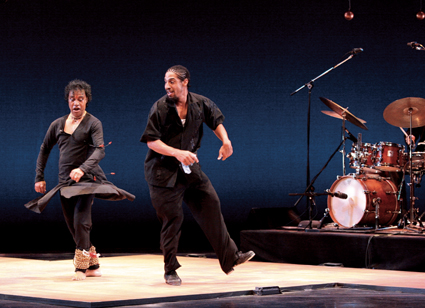
Pandit Chitresh Das, Samuel Smith, Kathak Tap
courtesy Parramasala Festival
Pandit Chitresh Das, Samuel Smith, Kathak Tap
PARRAMASALA IS AN IMPORTANT NEW FESTIVAL SOON TO PREMIERE IN WESTERN SYDNEY, CELEBRATING SOUTH ASIAN CULTURE, ANCIENT AND MODERN, AND FREQUENTLY AS SYNTHESES OF THESE IN COLLABORATIONS BETWEEN TRADITIONAL AND CONTEMPORARY ARTISTS, INDIAN, WESTERN AND FROM THE INDIAN DIASPORA. WHILE ADELAIDE’S OZASIA, NOW IN ITS FOURTH INCARNATION, HAS PLAYED A UNIQUE ROLE IN CONNECTING AUSTRALIA BROADLY WITH THE REGION, PARRAMASALA IN 2010 OFFERS A MORE CULTURALLY INTENSIVE FOCUS—INDIAN MUSIC, DANCE, FILM, RITUAL AND CELEBRATION, STAND-UP COMEDY AND CRICKET.
Artistic director Philip Rolfe, a former Executive Director at the Sydney Opera House where he played a key role in expanding the House’s programming of contemporary practices, tells me that over the next two years the range of work covered in Parramasala will expand “to include Pakistan, Bangladesh, Sri Lanka and the Himalayan countries and the influence of these in the broader region ,but also their global impact on contemporary arts. Choosing South Asian work from Europe and the US is part of what we’ll do into the future. But it’s also about the impact these have had in Australia. We’re attempting to construct a festival that is very contemporary and very much about collaboration between different artists, cultures and countries.”
Why this focus on South Indian culture? Rolfe explains, “The event is clearly in a community that will be supportive. Parramatta is a kind of epicentre of Sydney, New South Wales’ and probably Australia’s South Asian cultures—a massive population.” An impressive example was provided by the response to the AR Rhaman concert in Parramatta Park in 2009: “The NSW Government took up an invitation from Rhaman to do a free concert. He wanted to do it in Parramatta around the issue of what was happening to Indian students in Australia next to the positives of collaboration and multiculturalism, as opposed to the one-sided view coming across in the media. Unbelievably, 60-70,000 people turned out.” Rolfe is hoping for 15-20,000 to see the hugely popular Bollywood soundtrack singer Kailash Kher and his band Kailasa in The Crescent—“a natural, enhanced amphitheatre in Parramatta Park beside the river; it’s Sydney’s best outdoor venue.” The event is free.
The Crescent will also be the venue for Throw of A Dice, a screening of the silent movie epic, says Rolfe, “shot in 1929 in India by a mad German, like Cecil B de Mille! The British Film Institute restored it: it’s in pristine condition.” The film will have spectacular aural accompaniment from UK-based composer Nitin Sawhney at a grand piano and with his band and orchestra. The beautifully filmed German-Indian co-production was directed by Franz Osten, based on an episode from the Mahabharata and, according to the festival brochure, “was shot on location in the breathtaking mountains, forests and palaces of Rajasthan with over 10,000 extras, 1,000 horses and 50 elephants.” The showing is another free event.
In Parramatta, the annual Hindu Festival of Lights is celebrated at the Deepavali Fair at Parramatta Stadium. Rolfe recalls, “I went to Deepavali last year and was blown away by how well it was organised by the Hindu Council and put together with volunteers. The Council were really eager to be part of Parramasala. Their interest is to open up Deepavalli to non-Indians.” As well as stalls and performances, the fair includes the burning of a 45-foot high effigy with pyrotechnic effects and, at the end of the day, spectacular fireworks.
Tradition is given its due in Parramasala, says Rolfe: “Ideally, the way we want to set the festival up is that each time there is one beautiful, pristine traditional event. This year it’s The Desert Wedding.” This program features music for marriage, birth and life performed by the hereditary caste musicians of Rajasthan, people originally supported by wealthy patrons to preserve the history and ceremonies of wealthy families. Rolfe says that the groups—the Manganyars, the Langas and Kamad, performers of the ancient Teratali dance—come straight to the festival from their villages in Rajasthan and are the best in their regions.
anandavalli
The great Australian-based, traditional dancer Anandavalli (of the former Lingalayam Dance Academy, Sydney and later the all female Lingalayam Dance Company in Canberra) comes out of stage retirement to dance solo to the accompaniment of musicians Anil Srinivasan, a western trained classical pianist, and his regular collaborator Sikkil Gurucharan, a vocalist in the ancient southern Indian Carnatic tradition.
kathak tap
This blend of ancient and modern is evident in a number of shows, most unusually in Kathak Tap, where Kathak dancer Pandit Chitresh Das (India/USA) and tap dancer Samuel Smith (USA) each perform separately with their own musicians, then swap musicians (Kathak dancing to a jazz trio and Smith tapping to tabla, sitar and saranji) before finally dancing together in demonstrations of contrasting yet sympathetic footwork.
the chennai tapes
In a purely musical meeting, the Australian Art Orchestra continues its long-term dialogue with classical Carnatic music in The Chennai Tapes (Into the Fire), a collaboration dating back to 1996 between superb jazz musicians and Guru Kaaraikkudi Manir’s Sruthi Laya Ensemble from Chennai. On CD the dynamic weave of such different musical traditions is by turns lyrical and visceral, and always gripping—it should be even moreso on stage.
guru of chai
Rolfe has eagerly programmed Guru of Chai, “a performance by one of my favourite small companies from the region, New Zealand’s Indian Ink Theatre Company with Jacob Rajan and Justin Lewis. They have been working now for 20 years, and make everything themselves. It’s a bravura comic performance by Jacob, very accessible and deserving wider exposure in Australia.” Supported by a musician and employing shadow play, Rajan transforms himself into a host of characters in a tale about a poor tea seller and an abandoned girl who is a remarkable singer, a young policeman in love and a “disreputable poet.”
masala nights, cricket and more
Philip Rolfe has cleverly devised Parramasala as an instantly live-in festival. Parramatta’s Church Street will be transformed from late afternoons into a street market with food, things to buy, projections and performances by Erth, Dva and Polyglot. The free, large scale performances in Parramatta will attract big crowds and cricket fans will turn out for the first Parramasala Trophy match which has the support of Cricket NSW (whose Chair, Dr Harry Harinath is also one of the festival’s patrons) and Parramatta Cricket Club. There are stand-up comics, Indian film screenings in partnership with Popcorn Taxi, artist talks, Nitin Sawhney DJ-ing at the Roxy and, in a shop window on Church Street, the cutting edge British-Indian arts organisation Motiroti, based in East London, is screening 60 x 60 seconds—60 one-minute films from India, Pakistan and the UK about relations between these countries.
asia-australia: improving connection
I recall Rolfe complaining to me a couple of years ago about how mainstream arts organisations and festival programmers had failed to engage with Asia. Clearly he’s correcting that with Parramasala. We discussed how “Australia Council policy was set in place in the early 90s where half the international funding was to be directed into Asian collaborative projects. There was a lot of incredibly interesting activity in terms of individual artists, developmental work and on the edge arts organisations but the mainstream never engaged. Where it made its mark was in the visual arts and Asialink residences and in the thinking that created the Brisbane Asia Pacific Triennial. The arts festivals around Australia generally show interest but when it comes down it to they tend to choose shows that suit Western appetites.”
There are some heartening signs: the Brisbane Powerhouse engagement with Indonesian performance [RT81, p11] in 2009 and dance in the 2010 Brisbane Festival and Rosie Hinde’s programming of the Kenneth Myer Asian Theatre Series at Melbourne’s Arts Centre. With OzAsia and now Parramasala and the Asia Pacific Triennial, alongside Asialink’s enduring work and smaller ventures, the Asian-Australian connection looks set to strengthen. Rolfe is clearly enjoying the venture: “What gives me a kick is to start something from scratch and try to do it really properly and then leave it good hands after three years.”
culture & distance
If Parramasala works, and it surely will, the cultural divide between South Asia and Australia will be reduced, between continents and within Australian communities. But there are other distances to challenge. Rolfe would like people from outside of Sydney, and within, “to come to Parramasala and ideally stay overnight—see a couple of shows and stay next day for another one. There’s no shortage of hotels, and there’s great food, some of the best I’ve come across in Sydney—and half the price. People think it’s too difficult to get here but the trains are in fact very efficient, it’s not that very far, and when you’re here you can walk everywhere.” There’s no excuse; cross the divide.
Parramasala, Australian Festival of South Asian Arts, Parramatta, Nov 4-8, http://parramasala.com
RealTime issue #99 Oct-Nov 2010 pg. 14
© Keith Gallasch; for permission to reproduce apply to realtime@realtimearts.net
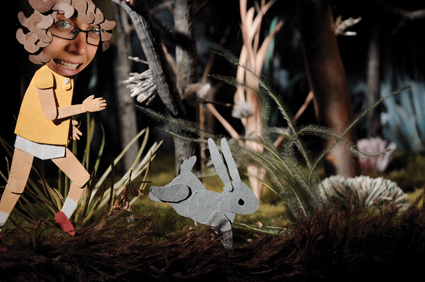
From You Were in my Dreams, Van Sowerwine and Isobel Knowles
image courtesy the artists
From You Were in my Dreams, Van Sowerwine and Isobel Knowles
HOVERING AND HUMMING IN THE AIR ABOVE THE GALLERY OF MODERN ART’S MEDIA GALLERY FOYER, THEIR ACRYLIC SKELETONS VEINED WITH AUDIO ELECTRONIC WIRING, ARE FOUR DELICATE, TRANSLUCENT SCULPTURES. AS THEY GENTLY SWAY AND WEAVE IN INVISIBLE CURRENTS, THE UNMISTAKABLE ELECTRONIC WARBLE OF A THEREMIN RESONATES FITFULLY THROUGHOUT THE SPACE. ARTIST NIGEL HELYER’S INTRICATE VOXÆTHER_01-04 SERIES DERIVES THE RADIATING FORMS OF SOUND WAVES, AND FROM THE RADIOLARIAN, THE ENDLESSLY ELABORATE PROTOZOA FAMOUSLY CLASSIFIED BY THE 19TH CENTURY NATURALIST ERNST HAECKEL.
As the visitor enters the gallery, the incidental reflections generated by light passing through the sheer planes of the sculpture create glancing angular teal and silver shapes on the foyer wall, recalling both screen-glow and the eerie bioluminescence of the deep sea. Combining the precision of laser-cut perspex with the unpredictable extraterrestrial vocals of the theremin—originally called the aetherophone—Helyer’s thoughtful hybrids connect the history of gestural interface devices with the drive to open ourselves to the invisible in our world.
These framing sculptures effectively highlight the exhibition’s prioritisation of the scope of meanings for that vexed term, new media. The National New Media Arts Award encompasses Helyer’s high tech sculptures, plus remixed documentary and video art, machinima, robotics and interactive animation. For all its heterogeneity, what emerges in the shortlist is the achievement of an exceptional synthesis between traditional approaches to media art with cutting edge technologies.
Found footage practitioners Soda_Jerk’s work exemplifies the richness and intelligence of contemporary recombinatory video practice. Their Astro Black: A History of Hip-Hop reworks the 1974 intergalactic free-jazz docu-fantasy, Space is the Place, with a sophisticated suite of samples from the annals of hip hop heritage. While for some, any tampering with Sun Ra’s Afrofuturist masterpiece could constitute sacrilege, what might sway even some of the more ardent purists here is the work’s emphasis on the film’s ongoing power as a hip-hop ur-text. The inviting 4-channel projection, insightful juxtapositions and witty use of the turntablist form drawing out the extensive stylistic legacy of the film—on artists including DJ Kool Herc, Afrika Bambaataa, Grandmaster Flash and Public Enemy—is all the argument needed for the critical potency of the contemporary remix artwork.
Also using high definition video, but with a different approach, Lynette Wallworth’s immersive installation, Still:Waiting2, depicts a twilight scene of stern red river gums in the Flinders Ranges. The presence of the audience contributes to the revelation of this 2006 work, causing the dramatic arrival and decamping of unruly flocks of white corellas. Sequestered behind a filmy pale veil, the installation courts the viewer’s attention through its slow unfolding, which Wallworth explains in a reflective wall text on the origins and intentions of the piece. Duration is at the heart of its aesthetic, as waiting for the work to exert its sudden payoff—the wild explosion of screeching, careening bodies across the sky—is exquisite. That the exuberant electronic soundtrack from the neighbouring installation can override much of the quiet waiting part of the experience of Wallworth’s work is indicative of the ongoing challenge represented by the sonic components of media art works.
The sound bleed is from Chris Howlett’s Metropolis: Part I-III, a machinima work that recuts footage from the SimCity Societies game with sounds hacked from the game’s engine bites, to reconfigure the authoritarian and capitalist operations of that virtual 3D environment. Like Philip Brophy’s work in the show, 10 Flaming Youths, which uses images sourced from youth marketing sites that combust as they near us at the front of the screen, Howlett’s work raises key questions about the complex relations between these digital surfaces: both works are evidently antagonistic towards, and curiously symbiotic with, the commercial applications of the technologies their work critically engages.
In You Were In My Dreams, Van Sowerwine returns to her theme of the lost child, explored in works such as the award-winning stop-motion animation, Clara (2004). Only, this time, in a collaboration with Isobel Knowles, there’s a twist: the child is ‘lost’ to the dream-world. This installation, the winner of the 2010 Queensland Premier’s New Media Arts Award and specially reconstructed for the exhibition, involves the viewer in a journey through a mythical jungle landscape that begins with the figure of the sleeping child. As the participant peers into the viewing device, a live video feed capturing facial expressions in real time translates their face into the diegesis, so that the spectator becomes the dreamer, integrated into the world of the animation. (A similar urge to directly address the participant animates Wade Marynowsky’s entertaining entry, The Discreet Charm of the Bourgeois Robot, a frilled and spangled cousin of the Dalek who approached and, by many accounts, unnerved visitors to the exhibition).
Clever lighting and attention to resolution details mean that the experience of You Were In My Dreams is uncanny but not entirely unflattering; here, the identification with the protagonist, such an article of film theory, is literalised. Spectators, jovially cheering their friends’ jungle antics (“Pat the monkey!! Grab that vine!!”), reveal that the critical effect of this exceptional artwork is to draw the form of animation into a deeper conversation with the practices of social media and first-person gaming culture. Ironically, the work’s presentation in a wooden viewing box recalls the myriad pre-cinematic projected and animated ‘devices of wonder’, while the textured two-dimensional cut-outs reference Russia’s Soyuzmultfilm and Iran’s IIDCYA, Harry Smith’s No. 12 or Heaven and Earth Magic (1962), and the meticulous silhouette puppetry of Lotte Reineger. As labour-intensive and perhaps atavistic as Sowerwine’s creative urges inevitably are, this work manages to elegantly transcend nostalgia by drawing sustenance from the fertile traditions of stop and shadow animation to provide an entrancingly distinctive context for digital interactivity, and so to propose new homes to long for and dream of.
As with Howlett’s reconfiguring of the stuff of games, regarding them less as finished entities and more as a set of design tools for experiment, and Wallworth’s viewer-triggered ecology, Sowerwine and Knowles treat the work as an open and ongoing process. If, as many now argue, new media art succeeds when it subverts uni-dimensional media institutional distinctions between producers and consumers, the works in this exhibition confirm the engaging creative potential of this emergent multi-dimensionality. The National New Media Art Awards offer some compelling evidence of the increasing aesthetic sophistication of Australian media art practice, highlighting the ways artists working with new media technologies are using the past, to inform not just the present, but also the future.
Van Sowerwine and Isobel Knowles were awarded $75,000 and You Were in My Dreams becomes part of the Queensland Art Gallery Collection. The judges highly commended Wade Marynowsky’s The Discreet Charm of the Bourgeois Robot 2. Queensland artist Claire Robertson was awarded the $25,000 Premier of Queensland’s New Media Scholarship.
Premiere of Queensland’s National New Media Arts Awards 2010 Exhibition, Philip Brophy (VIC), Nigel Helyer (NSW), Chris Howlett (QLD), Isobel Knowles and Van Sowerwine (VIC), Wade Marynowsky (NSW), Soda_Jerk (NSW), Lynette Wallworth (NSW), Gallery of Modern Art, Aug 28-Nov 7, Brisbane
RealTime issue #99 Oct-Nov 2010 pg. 15
© Danni Zuvela; for permission to reproduce apply to realtime@realtimearts.net
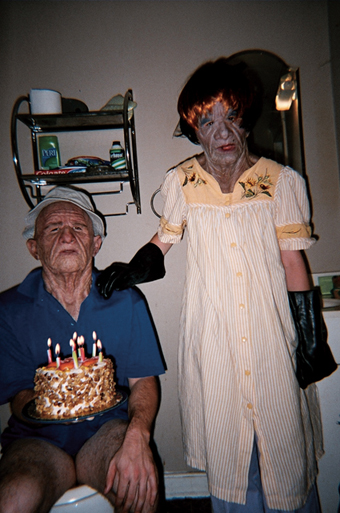
Trash Humpers
ONE OF DAVID LYNCH’S GREAT QUIPS AROUND THE TIME HE MADE INLAND EMPIRE IS THAT THE PROBLEM WITH HIGH DEFINITION VIDEO IS THAT IT LEAVES NO MYSTERY FOR THE VIEWER, YOU ARE ALLOWED TO SEE EVERYTHING—NO FUZZINESS, NO BLURRY EDGES OR STRANGE VISUAL ARTEFACTING. LYNCH EQUATES LOW DEFINITION VIDEO WITH THE FILMS OF THE 1930S WHEN THE EMULSION WASN’T SO GREAT, PROVIDING LESS INFORMATION ON THE SCREEN, ALLOWING THE MIND TO GO DREAMING.
Harmony Korine’s Trash Humpers is a film of mystery in many ways of which I’m sure Lynch would approve. A feature length film shot in glorious VHS, full of bad tracking and noise glitches, it recalls the bizarrely nostalgic aesthetic of 80s domestic video, offering a refreshingy beaten-up and wonderfully degraded audio visual experience—something that the crystal clear and all too perfect high definition world of contemporary video misses.
Korine has spoken about what attracted him to shooting the film on VHS: “There was a strange beauty in the analog. You almost have to squint to see things through the grain and the mist. There’s something sinister about it.” Now numerous films from Blair Witch to Paranormal Activity have attempted to exploit these ‘sinister qualities.’ Domestic video functions as a recorder of real events unfolding before us, adding to the overall verisimilitude and scariness of film, but none has done it so succinctly or perversely as Korine with Trash Humpers.
The theme of Korine’s latest delve into the depraved depths of white trash involves another kind of beating up and beating off—geriatrics (actually Korine and co in old people masks and orthopaedic shoes) going about humping trash and generally fucking shit up. The film, exactly like the title suggests, depicts old folk humping trash—in fact trees, mailboxes, and anything else that doesn’t move. Korine’s treatment of this material appears in general like an improvised shoot and run approach. The camera follows its manic-decrepit characters through abandoned streets and parking lots as they hump, smash up property, murder, commit home invasion and along the way meet an assortment of other weirdo characters, including conjoined twins and a guitar strumming sex obsessed cretin.
Lynch’s sense of low definition video’s ‘mystery’ also extends to the premise of the film itself: just what are we watching? If HD video shows us everything of the world, the VHS of Trash Humpers reveals the unseen, the unknown, the hidden—old people who come out at night to connect with the world around them in ways not normally seen. Far from shock value, one of the characters in Trash Humpers offers us what could be described as one of the more poignant moments in this bizarre film as he discusses how these people are free, free to do whatever, unlike the rest of society trapped by rules and conventions.
Trash Humpers’ freak show characters recite nursery rhyme fragments and chant repetitive nonsense as they go about their depravity, recalling the wonderfully disturbing onscreen personas of artist Paul McCarthy. In McCarthy’s Painter (1995) the artist intones phrases in a demented, high-pitched voice, and in Family Tyranny (1987, with Mike Kelley) he repeats over and over remedial phrases to disarming effect. McCarthy too has long explored the use of mutant masks in various performances, providing him, like the grandpas and grandmas in Trash Humpers, a certain crazed freedom to play out all manner of debased activities.
Trash Humpers adds up to a surreal, creepy and wonderfully perverse experience. Like a good horror movie, the film’s abrasive and nutball images stay with one for days afterwards. Apparently it was Korine’s intention to make a film that might be unearthed in a thrift store on an old VHS tape, a fuzzy analogue artefact from another time and place. He even flirted with the idea of leaving copies of the video on the sidewalk, for unsuspecting viewers to find.
The end result is a recombinant mix of nasty home video, jackass inspired pranks with a sexual bent, performance based video art and horror, all seemingly improvised into a macabre, vaudeville horror show. Trash Humpers celebrates destruction, vandalism and perverse freedom. It’s the perfect antidote to the worthy and important art house fare of the Melbourne International Film Festival and its grating byline this year: “it’s a matter of taste”.
Harmony Korine is an American director whose films include Gummo, Julien Donkey Boy and Mister Lonely. Trash Humpers won the DOX Award at the 2009 Toronto International Film Festival and screened in the 2010 Melbourne and Sydney Underground Film Festivals (MUFF and SUFF).
RealTime issue #99 Oct-Nov 2010 pg. 16
© Ian Haig; for permission to reproduce apply to realtime@realtimearts.net
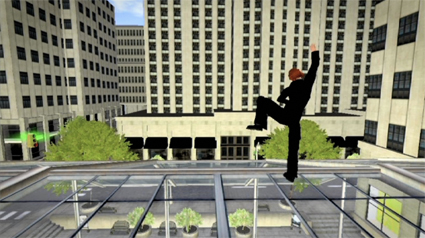
Entanglement Theory
courtesy Physical TV
Entanglement Theory
RICHARD JAMES ALLEN AND KAREN PEARLMAN (PHYSICAL TV) AND COLLABORATORS HAVE INVESTED MUCH IN THEIR 10-MINUTE FILM, ENTANGLEMENT THEORY, MELDING PHYSICAL AND VIRTUAL PERFORMANCE, CONNECTING A DANCING MAN (ALLEN) AND HIS SECOND LIFE AVATAR ACROSS IMPONDERABLE TIME-SPACE DISTANCES. SPEAKING WITH ALLEN AND PEARLMAN REVEALS JUST HOW MUCH THINKING AND WORK HAS GONE INTO THE FILM AND WHAT THEY HOPE THEIR ALREADY GLOBAL AUDIENCES ARE EXPERIENCING.
Borrowing directly from Quantum Physics’ Entanglement Theory, dancer and avatar in the film are like bound particles—however far apart, a change in one results immediately in a change in the other. In the film, the characters’ discrete worlds are parallel ones until, in the end, their realities overlap—as Allen dances on a timber bridge over a pond, transparent figures glide about him and, finally, now spirit-like himself, he enters the Second Life city of his avatar and they dance high amidst its buildings.
Allen is attracted to Entanglement Theory’s resonances with Vedic philosophy and with a dualism that perpetually resolves into the oneness of together-apart. This is not made literal in the film; there’s no explanatory content. You simply enjoy a fantasy that might translate into something more than a man who dances through intimate, inner city streets (while his avatar inhabits a hard, Second Life cityscape), falls asleep in a humble room (his doppelganger lounges in luxury before a blazing log fire), dozes on a park bench and then dances with his other as their worlds overlap. But Allen hopes you might feel a more heightened form of enjoyment.
Thinking, meditation and yoga are the usual means of apprehending or entering transcendent states but, says Allen, in the film they’re to be found in dance and dream. As well as defying gravity, dance can be ecstatically transcendent or subtly contemplative (Allen, like a Hollywood musical character dances past pedestrians, breaking with the everyday), while sleep opens the door to the avatar’s world. For Allen, the state to aspire to is Turiya, which in Hindu philosophy is beyond waking consciousness, dreaming and deep sleep, and beyond time and space. He and Pearlman have therefore structured the film around waking, sleeping, dreaming and Turiya.
Research for the film began with Pearlman and Allen working with Gary Hayes (“a Second Life genius,” says Allen) of MUVEDesign at Critical Path in January 2009 mixing real and Second Life through improvisation and developing “intermedia choreographic ideas.” Some of the outcomes were performed live with screen projections in Do Avatars Dream of Human Sleep? and then work began on Entanglement Theory.
Both makers are now intrigued by how enthusiastically their film has been taken up by audiences and programmers, including ABC TV, and suspect that viewers intuitively pick up on its deeper resonances. With almost 20 screenings this year, Allen says that the take-up is the fastest they’ve had for one of their films. Entanglement Theory has been shown in dance film and other festivals in São Paulo, Ghent, Michigan, Bergamo, Helsinki, Fort Worth, Tulsa, Trieste, Naples, Oklahoma, Johannesburg and at the Dungog Film Festival (NSW). It will screen at EDIT 2010 International Dance Film Festival in Budapest in October and at the Inshadow International Festival of Video, Performance and Technologies in Lisbon in December.
When the film appeared in the Animation Event of the Dance on Camera Festival in New York in January this year the New York Times reviewer wrote of the program: “It’s striking here that almost all of these shorts combine cartoons with live-action photography. In the best of these, Entanglement Theory…this mixture gives a new vitality to the dream states that preoccupy so many of the current crop of Dance on Camera filmmakers” (NYT, Jan 30).
While there’s a long history of mixing live dance with animation (peaking in 50s MGM musicals and revived in the digital era), Physical TV’s exploration of the possibilities of working with Second Life animation reveals the increasing range of technical means available for creative use by (and within the reach of) artists. While the Second Life aesthetic will never be to everyone’s taste and avatars cannot as yet move as subtly as their human counterparts, there are in Entanglement Theory moments of supple elegance and in the overall oscillation between worlds a fluidity of movement and editing that makes for a seductive reverie. See for yourself when it screens on ABC TV.
Entanglement Theory will be shown on ABC2, October 31 at 8.20pm and ABC 1 on November 7 at 4.20pm.
Entanglement Theory, choreographer, director Richard James Allen, Second Life artist, animateur, machinimatographer Gary Hayes, editor, dramaturg/writer Karen Pearlman, supervising sound editor Andrew Plain, composer Fiona Hill, producer Physical TV.
RealTime issue #99 Oct-Nov 2010 pg. 16
© RealTime ; for permission to reproduce apply to realtime@realtimearts.net
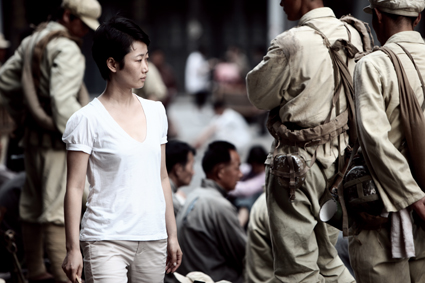
Zhao Tao in I Wish I Knew (Hai shang chuan qu)
THERE IS A SPECTRE HAUNTING JIA ZHANGKE’S RECENT WORK:THE SPECTRE OF TIME, OF MEMORIES BEING DISPLACED AND HISTORY ERASED. FROM THE CITIES DISMANTLED TO MAKE WAY FOR THE THREE GORGES DAM IN HIS FILM, STILL LIFE, THROUGH THE UNSPOKEN DISAPPOINTMENTS HANGING OVER THE FORMER COLLEGE STUDENTS OF CRY ME A RIVER, TO THE DISCOMFORTING QUESTIONING OF WHAT IS REAL IN A COUNTRY WHERE THE PAST IS CONSTANTLY REWRITTEN IN 24 CITY, JIA’S FOCUS HAS SHIFTED FROM HIS EARLY PORTRAITS OF ECONOMIC FRINGE DWELLERS TO A PROBING OF CHINA’S FRACTURED HISTORICAL CONSCIOUSNESS.
But whereas Still Life and 24 City implicitly asked where a nation’s emotional, ethical and philosophical centre lies when so much of its heritage has been destroyed, Jia’s new documentary I Wish I Knew attempts to answer this question by reclaiming history from the ground up.
Through 18 interviews, Jia delves into the history of Shanghai, which as a colonial creation and centre of nationalist sentiment, hotbed of vice and incubator of radical politics has long embodied the conflicting forces that have shaped modern China. Home to the most cosmopolitan aspects of China’s Republican culture of the 1930s and 40s, the city was also a stronghold of radical leftism during the Cultural Revolution. Nowadays China’s largest city stands as a symbol of the country’s traumatic colonised past and growing 21st century might. Within each of these broad historical brushstrokes are a million small stories of heroism, betrayal, idealism and exploitation. I Wish I Knew takes a cross-section of these tales, related in talking head interviews, and weaves them into a broad historical net cast over the city as it undergoes a makeover in the lead-up to the 2010 Expo.
The contested nature of Shanghai’s past is highlighted not only through personal remembrances from various political and historical perspectives, but also through the filmmaker’s reflection on the ways in which the city’s life has been represented on screen. Shanghai has long been the centre of China’s film industry, and even when Hong Kong dominated Asian cinema, its industry was nurtured by Shanghai refugees who had fled the mainland in the wake of the Communist takeover.
The cinematic allusions begin when we see the daughter of an executed Communist Party activist watching young actors marching down a fake Shanghai street on a film set. The woman tells the story of her father’s execution by Guomindang forces shortly before her birth, an event recorded by a Hong Kong journalist in a series of black and white photos. “I only know my father through these images,” she says tearfully of the shots of her father’s last moments. She goes on to recall her mother’s subsequent breakdown as she ran alongside Communist troops when they entered the city in 1949, searching for her dead husband among the ranks of the living.
From the woman’s tale we segue into the 1959 propaganda film, To Liberate Shanghai (director Wang Bing), featuring deliriously happy crowds greeting Communist soldiers as their officer declares in close-up, “The liberation of Shanghai marks the complete smashing of imperialist forces in China!”
From this cartoon triumphalism the film moves to the quiet memories of Wang Toon, director of the 1966 Taiwanese film Red Persimmon, based on his childhood experience of fleeing Shanghai as the Communists closed in on the city.
Jia follows this diasporic thread across the Formosa Strait, interviewing elderly Shanghai residents stranded in Taipei since 1949, as well as the famed Taiwanese director Hou Hsiao-hsien about his 1998 feature Flowers of Shanghai. Later Jia’s camera wanders to Hong Kong, via a clip from Wong Kar Wai’s Days of Being Wild, starring Rebecca Pan as an aging Shanghai refugee. Jia talks to the actress, herself the daughter of a Shanghaiese woman who fled to Hong Kong in 1949, about the struggles of Shanghaiese in the British colony during the 1950s and 60s.
Memories of the Maoist era are evoked through an interview with one of Mao’s “model workers,” who played herself in Huang Baomei, a 1958 film by legendary third generation director Xie Jin. After happily recalling her brief time as a star of the screen, Huang revisits the Shanghai workshop where she spent her entire working life, now an abandoned derelict shell.
Moving to the present, we see the Shanghai Expo site under construction, the workers labouring under banners urging them to “Stage a Great Expo for the Glory of the Nation.” This nationalistic sloganeering is subtly undercut by a young worker breakdancing beside a boom box, an echo of the roller-skating girl seen gracefully gliding around a rooftop in 24 City, and a mark of Jia’s ongoing interest in moments of spontaneous creative expression.
Between all these remembrances and scenes of Shanghai’s contemporary reconstruction, Jia’s artistic and life partner Zhao Tao wanders the city’s streets, dressed in white—the Chinese colour of mourning—looking for something she apparently never finds. Her silent figure speaks not only of the pain hidden from Shanghai’s glittering neon lights, but also the stories that still cannot be told—or perhaps are already lost.
I Wish I Knew resists simply positing an alternative narrative to what appears in mainland Chinese history books, or validating the version of Shanghai’s past told in Taiwan. Instead, the film redefines the very notion of history in China by refusing all singular, linear accounts of Shanghai’s development. For millennia succeeding dynasties rewrote or simply wiped clean what went before in China in order to shore up their own power, a tradition the Communists have pursued with violent determination. In contrast, Jia’s film gives voice to the vanquished as well as the victors, marking out history as an ever-evolving, always disputed discourse comprising a multitude of competing voices.
There are personal truths in all these tales, even as none of them can individually capture the sprawling complexity that is Shanghai’s past. Most importantly, in assembling this mosaic of human memories and fading filmic images, Jia has forged a poignant memorial to the millions of men, woman and children who have lived, loved, and suffered in China’s most crowded and contentious metropolis.
Zhao Tao, I Wish I Knew (Hai shang chuan qi), writer/director Jia Zhangke; producers Wang Tianyun, Yu Likwai, Meg Jin, Lin Ye, Xiong Yong; People’s Republic of China; 2010.
RealTime issue #99 Oct-Nov 2010 pg. 17
© Dan Edwards; for permission to reproduce apply to realtime@realtimearts.net
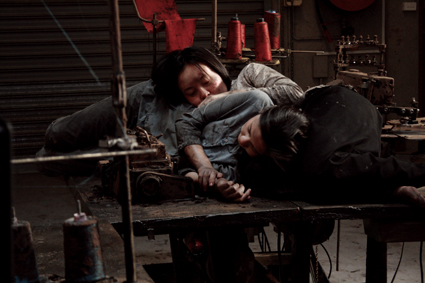
Mother Fish
KHOA DO’S NEW FEATURE FILM MOTHER FISH BEGINS WITH A BLACK SCREEN, THE SOUND OF RUNNING WATER AND THE OFFICIOUS TONES OF KEVIN RUDD. THE THEN PRIME MINISTER IS ANSWERING MALCOLM FARR, POLITICAL REPORTER FOR THE DAILY TELEGRAPH AND OCCASIONAL COMMENTATOR ON THE ABC TV’S INSIDERS, WHO IS ASKING ABOUT THE “12 BOATS AND 700 PEOPLE” THAT HAVE RECENTLY ARRIVED AT CHRISTMAS ISLAND AND THE POSSIBILITY OF REINTRODUCING MAINLAND DETENTION CENTRES.
The reply is vintage Rudd (“there’s a purpose-built facility there for that purpose”) but it fades into the background as the sound of water grows louder and the camera focuses on a pair of hands washing and chopping vegetables. We hear a voiceover in Vietnamese, spoken in the second-person: “What are you cooking today? You only ever eat greens…You always put too much sugar…I’ll wait for you in the car. Don’t forget to turn the TV off.” The volume on Rudd’s voice increases again and we hear him saying “boats [have] been coming to this country, Malcolm, as you know, since the 1970s.”
From here, we follow the woman (Hien Nguyen) as she drives to work—a small factory with several sewing machines and multiple racks of identical clothing (trendy red checked shirts and long purple skirts). The female voice accompanies her throughout the day and when everyone finally departs in the evening, the woman stays to retrieve a toy monkey that she, or rather the voice, has taken a liking to. The monkey clearly triggers something in her as the present falls away, the past intrudes, and the voice pleads with her to stop.
In an instant the factory transforms into a small boat, with a sewing machine standing in for a motor, a bobbin for a pull cord, and a skirt for a sail of sorts. This rather Brechtian approach, reminiscent of Lars von Trier’s Dogville (2003), is not without its risks but for the most part it works. In this way, Mother Fish effects an unusual reversal: having previously made a rather filmic piece of theatre (RT86) director Khoa Do has now produced a rather theatrical film.
In the absence of actual ocean, the film evokes its presence through camera movement (constantly pitching up and down, as if on a heaving sea) and sound effects (water slopping against the side of the boat, the low drone of the motor). Similarly, the set transforms over the course of the film from a steel-toned workshop—all grey, gold and silver with the occasional shot of red thanks to the bobbins of thread—into a rusted, blasted and scorched shell of itself, barely recognisable under a layer of mud.
On board the “mother fish” are the two sisters Kim (Kathy Nguyen) and Hanh (Sheena Pham), their uncle (Hieu Phan) and a young man Chau (Vico Thai). Sailing out of the harbour, the sisters argue about what they have been allowed to bring and what their mother might have packed for them. However the argument comes to an abrupt end when they hear the sound of a patrol boat and shots being fired. Once out on the ocean, the journey alternates between boredom and terror. During the dull patches they remember the past (dad’s exploits, mum’s food) and rehearse the future (“you’ll never have to cook again because everything comes in a can: chicken in a can; cow in a can; fish in a can”). However these moments are few and far between as the mother fish and her crew endure horror upon horror: first the boat is attacked by pirates, who rape one sister while another watches helplessly; then they are forced to forfeit a precious necklace to bribe an official to tow them into a refugee camp where they are then pushed back out to sea; later Chau jumps ship never to be seen again while Hanh teeters on the brink of death.
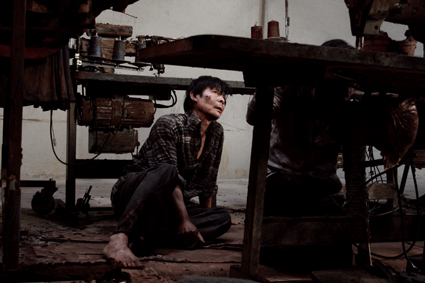
Mother Fish
These scenes have the potential to be voyeuristic on the one hand or sentimental on the other, but remarkably they are neither. Instead, this film sails straight and true thanks to the immense restraint of both its actors and director. For their part, the actors play the scenes with absolute control: emotion is evoked through little more than a turn of the head, a glimmer of a tear, or a gentle glance of affection. What little dialogue there is, is spoken with sensitivity and nuance and Thai’s reading of the line “I’m sorry, I’m sorry” hints at his character’s pain and regret as well as compassion. This emotional and verbal reticence is complemented by Do’s visual restraint. For example, when filming the rape scene, gauze drops down over the lens as if to screen it out. Similarly, when characters are at their most vulnerable and distressed often all we see is a cheekbone, a veil of hair or a hunched shoulder.
In the final scenes, we see the younger Kim washing onto the shore and touching the feet of her older self. Once again the camera hovers over the older Kim’s shoulder as we follow her home. She attempts to cook a meal but unable to eat she instead goes for what we think is a walk in the park. However, when the camera finally tilts down it becomes apparent that she has walked into a pond and is plunging into the water. Several silent seconds later (the soundtrack is effectively minimalist), her younger sister and her younger self burst from the water, gasping and reaching for one another. In one of the final images of the film, a small hand reaches for a larger, older one and we hear (once again in Vietnamese), “Sister, is that you?”, to which Hanh replies, “I’m here.”
The film finishes with the astounding statistic that between 1975 and 1996, over 1,500,000 people fled Vietnam. Of those, only 900,000 made land meaning that 600,000 were lost at sea, a catastrophe on a par with 1,700 SIEV Xs. Of the survivors, approximately 137,000 came to Australia. It is now 35 years since this migration started, yet it is only in the past 10 or so years that these stories have started to emerge into the mainstream. Think for instance of exhibitions such as the Casula Powerhouse’s Viet Nam Voices (1997), Viet Nam Voices: Australians and the Viet Nam War (2001-03) and Nam Bang! (2009) [http://realtimearts.net/article/issue90/9390] as well as Nam Le’s book The Boat (2008). Perhaps the first generation was so busy surviving that it is only now, as the second generation makes its mark on the world and starts to have children of their own, that these stories can be told.
Intriguingly, Khoa Do is also planning to tell stories with and about other refugee communities. Mother Fish is the first in a planned “refugee trilogy” with the second film, Falling for Sahara, already in post-production and the third in the early stages of development. Mother Fish suggests the trilogy has the potential to become an Australian film classic.
Mother Fish, writer, producer, director Khoa Do, executive producer Matthew Riley, performers Kathy Nguyen, Sheena Pham, Hieu Phan, Vico Thai, Hien Nguyen; Australia, Titan View
RealTime issue #99 Oct-Nov 2010 pg. 18
© Caroline Wake; for permission to reproduce apply to realtime@realtimearts.net
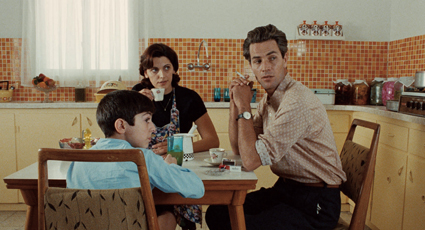
The Time That Remains
DECREPIT WHEELS ON A RUSTY BICYCLE CARRYING FOLDED CARTONS CRISSCROSS THE GROTESQUELY PEOPLED STREETS OF THE ‘DESERT KINGDOM’ OF DUBAI—A FAR CRY FROM THE OPULENT ARTIFICIAL LUSTRE THAT ENVELOPS ADVERTISING CAMPAIGNS OF THE OIL RICH EMIRATE. TO THE SUBDUED BACKGROUND MUSIC OF MANDOLINS, THIS IS THE OPENING SCENE OF THE FIRST FEATURE LENGTH FILM PRODUCED BY AN EMIRATI, ALI MOSTAFA, TITLED CITY OF LIFE. IT OFFICIALLY LAUNCHED THE NATIONAL 2010 ARAB FILM FESTIVAL (AFF) IN SYDNEY.
Through a series of intersecting plotlines and stunning visual hyperbole reminiscent of Hollywood blockbusters, Ali manages to recount a postmodern narrative about a cosmopolitan Dubai that houses the fragile dreams of its itinerant populace.
With the same overarching artistic zeal of the past few years, the festivals’ co-directors, Mouna Zaylah and Fadia Abood, endeavoured to present a multifaceted selection of films that in their words “showcase stories from diverse Arabic-speaking cultures to broad Australian audiences that reflect the complexity and diversity of Arab communities and experiences.”
Touring nationally to five major cities, the AFF has generated its own scene, making its presence known by collaborating with local communities and reaching out to newer audiences with record attendances throughout. In a sense, AFF offered a cultural antidote to the increasingly virulent Islamophobia gripping the current state of western political discourse—be it over items of clothing or over building permits near sacrosanct, politicised sites. As the directors point out, AFF provides a sovereign domain of imagination that “addresses the (mis)representations of Arab culture through film…by presenting alternative representations of Arab cultures, subjects and narratives; and by supporting the development and presentation of new screen-based work by Arab-Australians.” Films screened this year transgressed the traditional political boundaries of the Arab world and also spoke with the diasporic intonations and regional polyphonies of a vibrant language that were wonderfully exhibited in the homemade Arab-Australian archival footage sent in by local participants.
scheherazade, tell me a story
In Scheherazade, Tell Me a Story, audiences were confronted with a brutal admixture of gender and class in modern Egypt and how women in their various social positionings are caught within the entangling webs of cultural modernity and religious piety. Yousry Nasrallah, a protégé of the masterful director Youssef Chahine, skillfully continues the avant-garde revival of current Egyptian cinema with mass appeal by conflating social taboos regarding sexuality and domestic violence. The deliberately subversive strain indicated by the title uses the narrative device of a late night Oprah-esque talk show host who exposes the moral decay of her own society by broadcasting testimonies of Egyptian women navigating the perilous paths of misogyny in their search for love in their personal relationships. At times comedic and in other parts kitschy in its forced acting style, Nasrallah’s film manages to reveal the sensuous aspects of corruption in the private and public spheres of Egyptian life. Perhaps the most gruesome scene—a forced abortion for an educated middle class woman seduced by a professional con artist—underscores how violence manifests itself within contemporary Arab societies in the most mundane yet graphic ways.
kickoff
Other films such as Kickoff or 12 Angry Lebanese are slower paced with their more palpable narratives, wrenching in their intimate depictions and intense in their visual qualities. Kickoff is a well crafted film that uses the cinematographic hues of sepia tones strategically to convey the bleak realities of internally displaced Kurdish Iraqi refugees in a soccer stadium in the city of Kirkuk. The fortified complex of the stadium with its worn out pitch, houses goats, nets, mattresses, burning rubbish drums and humans. These people co-exist within a tense serenity where lives are conducted in a circularity mimicking the Olympic track that engulfs their everyday transactions, economic or otherwise.
The main character, Asu, is tragically killed when leaving the insular space of the stadium to enter the genocidal geography of the city in order to buy a fake trophy for a soccer competition he stages with support from the competing ethnic groups of Arabs, Kurds and Turks. The stadium in Giorgio Agamben’s term is classed a “state of exception”, standing as a microcosmic edifice of juridico-temporal confusion in the midst of the anarchy of occupation or a larger “state of exception” that is now Iraq. Safety and sovereignty ironically reside in the disfigured zone of a no man’s land. The director, Shawkat Korki, brings an aesthetic sensibility tempered by slow moving shots and close ups to reveal the scarring effects of an occupation through the aridity and barrenness of the stadium and the authentic feelings of his characters.
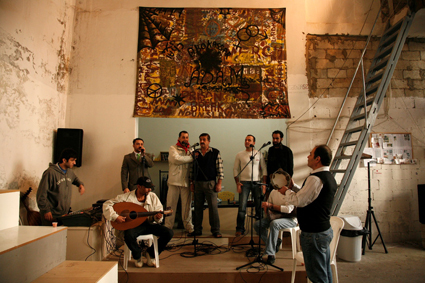
12 Angry Lebanese
12 angry lebanese
12 Angry Lebanese, a documentary by comic actor and drama therapy teacher Zeina Daccache, moves into similar territory by leaving the viewer in a suspended state of irreconcilability. On the one hand, the film tracks the transformational psychological journeys of men trapped in Beirut’s most notorious prison, Roumieh, through their staging of an elaborate adaptation of the famous American play 12 Angry Men. Yet, the men still remain physically entrapped.
The autobiographical testimonies of the prisoners to the camera interspersed throughout are painfully moving in their exploration of what Lebanese Australian anthropologist Ghassan Hage terms a “de-phallicised masculinity.” They are disparagingly honest, ironic and extremely self-reflexive in their laying bare of narratives not tainted by juries or judges. It is interesting to juxtapose 12 Angry Lebanese with Scheherazade, Tell me a Story as both films use the confessional mode of storytelling to convey the complex reality of being a man or a woman in the contemporary Arab world with the literary quality of the first person narrative.
Over 15 months, the prison doors were opened to a committed director and the enthusiasm of those incarcerated to liberate themselves from the internecine, intergenerational violence and conflict manifest in their melancholic recounting of filial memories. Their narratives, and bodies, sit uncomfortably before cameramen following their every move. The prisoners are subjected to another panoptic gaze but eventually become accustomed to the cameras, performing not just for shows where an audience is let into prison for the first time but also for the camera. They invite it to share in their honest journeys of self-discovery where shame can have an ethical energy not to be found in the quotidian spaces of metropolitan Beirut.
the time that remains
The closing film of the Sydney screening, The Time That Remains, captures the absurdist brilliance of Elia Suleiman and his mesmerising screen aura as director and actor. Inspired by the diaries of his father and private letters of his mother, Suleiman’s film is essentially a palimpsest voyage through the lost memories and forgotten landscapes of Palestine from 1948 to the stalled intractability of this conflict today. The searing tragicomic thread is hauntingly meditative, an almost elegiac Mahmoud Darwish poem that becomes transposed onto the screen with its meandering plots and its incongruous hilarities. Suleiman’s repetition of certain scenes in a Groundhog Day fashion alludes to the draining affects of occupation. This repetition reads like an introspective love letter that does not have a recipient and is almost guaranteed never to be read. As with all the films screened this year, The Time That Remains allowed the audience to experience a landscape overlaid with cultural and individual narratives of loss and love on multiple levels and to ultimately enter the emotional and physical subjectivities of a world immediately beyond their own.
Arab Film Festival, July 1-31; http://arabfilmfestival.com.au/
RealTime issue #99 Oct-Nov 2010 pg. 21
© Farid Farid; for permission to reproduce apply to realtime@realtimearts.net
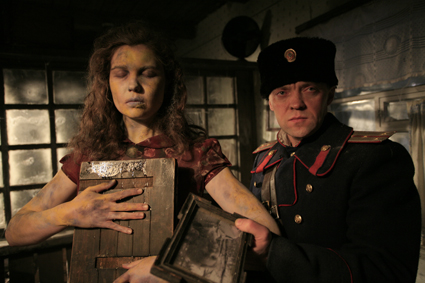
Alexander Proshkin, The Miracle
DEFINING A FILM IN REFERENCE TO ITS NATIONALITY (A FRENCH FILM, AN AUSTRALIAN FILM, A RUSSIAN FILM) IS AN INCREASINGLY TENUOUS BUSINESS THESE DAYS. IN AN AGE OF GLOBALISATION, IT WOULD SEEM THE BOUNDARIES OF A NATION STATE ARE NO LONGER IMPERVIOUS ENOUGH TO ALLOW FOR THE INCUBATION AND GROWTH OF A DISTINCTIVELY NATIONAL CINEMA. CONTEMPORARY RUSSIAN CINEMA REFLECTS THESE CHANGING ECONOMIC AND CULTURAL CONDITIONS MORE ACUTELY THAN MOST OTHER NATIONAL CINEMAS.
For so long culturally isolated and protected by the Iron Curtain, the Russian film industry has, since the fall of the Soviet Union, been forced to undergo a quick and radical transformation. Most significantly, Russian cinema has had to contend directly with Hollywood, the international monster that other national film industries have been struggling with or against for over 90 years. The goal has been simple: to survive in a monopolised marketplace without losing a distinctively national voice. After a shaky start in the 1990s, a definably ‘new’ Russian cinema emerged in the new century, a cinema that, for better or worse, has asserted itself as a producer of popular, economically viable films that participate in the populist aesthetics of Hollywood while also drawing on Russia’s prized and ofaten traumatic cultural heritage.
The career of Russian director Alexander Proshkin (b1940) in many ways reads like a biography of this transformation. Beginning his career in Soviet television in the 1960s and 1970s, Proshkin asserted his reputation as a director of quality television drama before achieving box office and critical success for his 1988 feature Cold Summer of 1953. That film—a dark, violent and dramatic thriller set in the early days following Stalin’s death—was in many ways a pioneering work that offered a model for what Russian cinema could become in the post-Soviet era. Integrating historical and politically contentious subject matter within a generic scenario lifted from a Hollywood western, Cold Summer of 1953 demonstrated the possibility of a culturally respectable, serious, yet also populist and exciting cinema.
Proshkin’s latest feature The Miracle, which played at this year’s Russian Resurrection Film Festival, is also an entertaining film of serious ambition. Like Cold Summer of 1953, The Miracle is set in the early Soviet ‘thaw’ of the mid-1950s, a period when Nikita Khrushchev initiated a relaxation of the paranoid grip of Stalinism. Proshkin was in his mid-teens at the time, and must have experienced the cultural atmosphere as a powerful liberation. “The time is significant,” he explains, “because 1956 is the year which marked a turning point in our history. Khrushchev’s address at the 20th Congress [of the Communist Party] marked the arrival of the new post-Stalinism period. With one foot, we were still in the past, while with the other we were in an uncertain future.”
Presented as a film based on historical events, The Miracle’s narrative offers a fictionalisation of the characteristically Russian cultural myth, or true event, known as the “Standing of Zoia.” Said to have taken place in Kuibyshev (now Samara) in January of 1956, the story goes that while dancing with an icon of St. Nicholas, 21-year-old Zoia Karnaukhova froze solid in her living room for 128 days, only thawing at the arrival of Easter. In a culture very accommodating to superstition, news of the “miracle” was frantically suppressed by the Soviet government, and circulated only by word of mouth. Proshkin explains:
“In Russia, such information is often referred to as ‘bush radio,’ where one person tells one person and he tells another etc. Our scriptwriter, Yuri Arabov, was told about this incident by his grandmother, when he was nine years old. To the wider community, this information was kept confidential til about the end of the 1980s.”
With names altered and dramatic twists thrown in (Kuibyshev becomes Grechansk, Zoia becomes Tatiana and Khrushchev himself gets involved through a deus ex machina) The Miracle manages to engage with the complex problems of Russia’s Soviet past without losing the narrative momentum of contemporary popular cinema, a balancing act that, in Proshkin’s view, Russian filmmakers can no longer afford to neglect. Just like everywhere else, he explains, Russian filmmakers are now answerable to the dictates of the mass audience: “The filmmaker’s role—or existence—has changed in our nation… Before there was an ideological influence, now it’s a commercial one.”
Despite being unambiguously popular in its presentation, there are considerable dimensions of depth in The Miracle. As an allegory, the film would seem to present a metaphor of a society, frozen by Stalin’s terror, coming back to life. For Proshkin, however, the film’s narrative has less specific connotations:
“It is an attempt to explain the mentality of Russia, which in essence has not changed over time. Waiting for so-called ‘miracles’ has been embedded into the national character and we often put things down to simply being miracles.”
Proshkin’s interest in the “mentality” of Russia, and especially in the profound incompatibility between Russian social life and systematic centralisation, echoes throughout much of the director’s work. Open to the possibility of the miracle, but not certain of it, his is what might be called an agnostic attitude, significantly distanced from the more fervent religious cinema of contemporary Russian directors like Andrei Zviagintsev and Pavel Lunguin (whose epic Tsar also featured at this year’s festival). Asked whether he considered his film to belong to the growing ‘religious’ genre of Russian cinema, Proshkin replies:
“For me it was always a mystery: how could a nation, which existed for 1000 years with the Christian-orthodox faith, suddenly condemn its pastors, destroy its churches and reject its religion? Religious belief, which was nurtured for 1000 years, cannot just disappear in one particular moment. It simply moved into the subconscious… Spiritual movies represent the character of our culture and its peculiarity.”
This concern with the Russian subconscious leads me to pursue another subject. If anything can be said to have persistently pricked at the conscience of Russian filmmakers for the past 50 years, it would be that most traumatic chapter of the country’s Stalinist nightmare, the Second World War. At this year’s festival, a retrospective of World War II dramas made in the post-war era—The Cranes are Flying (Kalatazov, 1957), Ivan’s Childhood (Tarkovsky, 1962), Trial on the Road (German, 1971) and The Ascent (Shepitko, 1977)—offered a captivating and sobering glimpse of the war’s centrality in the Russian memory. These are some of the finest films of their time. And yet still today, narratives set during the war continue to be made, as untold stories come to light. One such film is Vera Glagoleva’s One War, perhaps the finest new feature at this year’s festival. Other films explore an adjacent period: Stanislav Mitin’s lyrical gem Backdoor is set in 1949 and Nikolay Dostal’s award winning Peter on His Way to Heaven takes place in 1953.
For Proshkin, there’s a specific rationale in Russian cinema’s preoccupation with the trauma of Soviet history. Raking over the past is, it would seem, a way of processing the unacceptable, making sense of the incomprehensible:
“It’s not a matter of history. It is just that that period influenced the formulation of the mentality. Until we actually rid ourselves of the past which has been infused into our blood, we will never find the road to the future.”
2010 Russian Resurrection Film Festival, Sydney, Melbourne, Brisbane, Perth, Adelaide, Canberra, Aug 19-Sept 19; www.russianresurrection.com
RealTime issue #99 Oct-Nov 2010 pg. 22
© Tom Redwood; for permission to reproduce apply to realtime@realtimearts.net
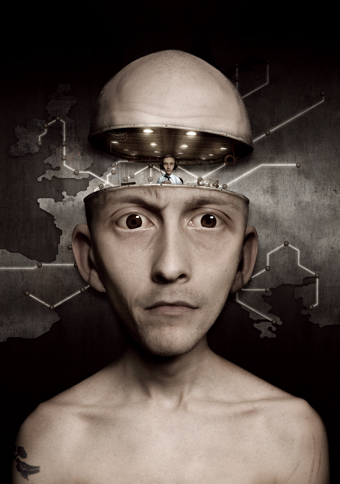
Metropia
IN ITS 13TH YEAR, PERTH’S REVELATION FILM FESTIVAL HAS COME A LONG WAY FROM ITS EARLY DAYS IN THE BASEMENT OF THE GREENWICH CLUB. WELCOMING BACK ITS LOYAL FILM-LOVING FANATICS, REV TURNED THE HEADS OF A WHOLE NEW GROUP OF FILMGOERS WITH A 40% BIGGER AUDIENCE THAN THE PREVIOUS YEAR. SETTING OUT TO BRING WEST AUSTRALIANS A SELECTION OF FILMS THAT CONTAIN A LITTLE SOMETHING PROGRAM DIRECTOR JACK SARGEANT LIKES TO CALL ‘ATTITUDE’, REV SHOWCASED FEATURES, DOCUMENTARIES, SHORTS, ANIMATED FLICKS AND 30 NATIONAL PREMIERES ALL PACKED INTO A SNUG 10-DAY PROGRAM.
With subjects such as an outlaw American comic, through to a pint-sized 13-year-old paparazzo, by far some of the most intriguing films on this year’s program are documentaries. Reporter follows the work of Pulitzer Prize winning journalist of the New York Times Nicholas Kristof as he endeavours to raise awareness of developing world tragedies. Battling shrinking news organisations and newspaper readership as well as humankind’s numbing to mass tragedy, Kristof sets off into the Congo alongside two young American bloggers, seeking out the most tragic stories for his readers. Directed by Eric Daniel Metzgar the film captures the courage and determination of journalists like Kristof, who face those who act with impunity and translate stories of incredible injustice for their readers in the hope of change. With the 20 million Pakistanis displaced by recent floods, Reporter reminds us of a world outside our own that desperately needs our compassion.
Music fans had plenty to inspire them with rockumentaries—The Night of the Triffids, When You’re Strange and Wheedles Groove—which drew huge crowds. The Family Jams took its audience on tour with a unique look at life on the road. The film opens in summer 2004, with an introduction to director Kevin Barker’s family at his grandmother’s 100th birthday celebration in Hawaii. Crossing the ocean Barker sets out to capture a different type of family, that of Joanna Newsom, Devendra Banhart and Vetiver, three San Francisco-based musicians about to make it big on a tour Antony Hegarty believes is a “significant moment for culture.” Hampered by a car accident, an awkward father-son reunion and personal tragedy, the travelling group manages to pull together, sharing experiences of writing, performing and their deep connections to music. The Family Jams offers viewers an incredibly honest look into the world of those with a love and a talent for music, and the family-like bonds that can form over a tune.
A highlight of the Late Shows, The House of the Devil captured the true spirit of the fright flick. Set in the 1980s, Director Ti West’s 16mm film follows Samantha, a cash-poor student desperate to move out of her college dorm. Finding her dream lodging, Samantha takes an out-of-town babysitting job to pay her security deposit, only to realise her employers are not exactly kosher. With a genuine selection of 80s sets, costumes, cinematography and lingo, The House of the Devil’s slow-building tension plays true to such horror classics as Rosemary’s Baby and When A Stranger Calls.
One of the many premieres at Revelation this year was popular animated feature Metropia, directed by Egyptian-Swedish animator and producer Tarik Saleh. Set in Europe in 2024, Metropia depicts a bleak world where natural resources are depleted and global financial markets have collapsed, leaving people to labour in their ruin. Underground tunnels connect most of Europe, yet conspiracy theorist Roger feels something’s amiss. Battling inner voices he sets out alongside a mysteriously familiar stranger to uncover a bizarre scheme. Voiced by Vincent Gallo and Juliette Lewis, the film echoes the building isolation and paranoia of today’s world. With incredible attention to detail and use of photomontage Metropia appeals to animation enthusiasts as well as those not yet fans of the genre.
Continuing with the dystopian theme, One Hundred Mornings took its audience to a not-so-distant post-apocalyptic world. Setting out to create a film that captures the director’s worst fears, Conor Horgan’s feature explores the consequences of a societal breakdown and the conflicts that arise between “groundless optimism and pessimistic realism.” Following an unknown catastrophic event, two couples occupy a cabin hidden away within an Irish mountain village, fighting off hungry wanderers, corrupt police, infidelity and boredom. Drawing on the chaotic social unrest of post-Hurricane Katrina New Orleans, Horgan sets building animosity and silent conflicts against minimal dialogue and beautiful cinematography—a nod to the director’s formal training in photography. One Hundred Mornings depicts an uncomfortable reality we all face should our fragile existence take a turn for the worse.
No doubt a crucial training ground for WA talent, Get Your Shorts On! showcased a number of short films from Western Australian filmmakers. Among the impressive line-up, the Corrie Jones-directed film Water follows the struggles of eight year-old Toby, wanting a normal life that his mentally-disabled father cannot provide. Set in a seaside community, Water quietly exposes some of the untold difficulties families and carers of the disabled face, delivering an emotional punch usually hard to capture in short-length cinema.
Denise Groves’ short doco, My Nan & the Yandi, tells the story of how a small piece of metal, the ‘yandi’, saw the filmmaker’s grandmother and hundreds of Aboriginal people through the decade-long Pilbara strike of 1946. In separating tantalite, tin and gold from the soil, the yandi offered an alternative income for jobless families fighting for wages instead of just rations. Filmed in Western Australia’s Marble Bar, Groves’ delightful short captures the resourcefulness and resilience of the Roy Hill Njarparlies, as told by ‘Nan’ herself.
A Special Event highlight in the 2010 program, the Best of Domefest, sampled a number of international films created over the last seven years for the 180-degrees ‘fulldome’ environment. Traditionally an Albuquerque (US) festival, Domefest screened here at the Horizon Planetarium, featuring snippets of large-format film that journeyed beyond the typical space-themed content to include immersive art and storytelling works that explore the surround experience. Australian Network for Art and Technology’s Program Manager of Art Science, Vicki Sowry, opened the event, presenting a number of exciting ideas for the format including a fulldome horror flick—sure to leave audiences with nowhere to turn short of closing their eyes. The night’s schedule included a number of trippy audio-visual pieces, some leaving the audience slightly woozy. Two Black Hole excerpts unravelled some of the fascinating mysteries of the space phenomenon but left viewers wanting a little more, while Seeds of Spring ditched space altogether, following a time-lapse of a quirky, bearded farmer planting and raising a crop from greenhouse to field.
Emerging in the 1990s, fulldome video technology has come far, offering a wonderful opportunity for filmmakers to engage audiences in a whole new way—an approach the festival truly champions.
Revelation eschews big budget blockbusters and celebrities that most people mistake for cinema, instead applauding innovation. From low-budget Mumblecore experiments and off-beat documentaries through to the RevCon conferences on cinema and screen culture, the festival’s films are no mere time-kills; they take you places. One of Australia’s most idiosyncratic film festivals, Revelation rebelliously celebrates the true spirit of cinema. Some of the best films in this year’s line-up were not first choices, so my tip for future audiences is, challenge yourself.
Revelation Perth International Film Festival, director Jack Sargeant, Perth, July 8-18
RealTime issue #99 Oct-Nov 2010 pg. 23
© Claudia Cukrov; for permission to reproduce apply to realtime@realtimearts.net
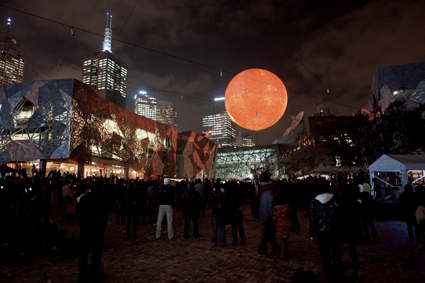
Solar Equation, Rafael Lozano-Hemmer
photo Marcel Aucar
Solar Equation, Rafael Lozano-Hemmer
“EVERY CULTURE HAS A UNIQUE SET OF SOLAR MYTHOLOGIES AND THIS PROJECT SEEKS TO BE A PLATFORM FOR BOTH THE EXPRESSION OF TRADITIONAL SYMBOLISM AND THE EMERGENCE OF NEW STORIES.” — RAFAEL LOZANO-HEMMER
Commissioned for Federation Square’s Light in Winter Festival, which celebrates the cultural, communal and physical qualities of light, Solar Equation offers us an opportunity to engage in a new way with the most powerful light in our lives. This scale-model of the sun brings together both the personal and social aspects of spiritual beliefs and practices the sun has inspired throughout time.
As the life-source of our planet, the sun’s majesty and mystery make it challenging to represent. Olafur Eliasson’s The Weather Project (2003) in the Tate Modern’s Turbine Hall successfully illuminated an interior space to recreate the effect of the sun’s presence in our lives. With Solar Equation, Rafael Lozano-Hemmer has brought the sun closer so that we might see the complex behaviours occurring on its surface. In doing so, he has created a work that establishes an entirely different relationship between us and the sun. Experiencing this first iteration of the work, I was struck initially by how tame the sun appeared at this scale in the Melbourne sky. Viewed from a distance, the appearance of this burning sphere against the night sky was however impressive and brought to mind any number of apocalyptic visions. But up close I was also moved by the questions the work raises about the role science plays in our relationship with nature.
The sun in Solar Equation is created by five projections onto a 14 metre diameter balloon. It’s the largest spherical balloon in the world yet is still 100 million times smaller than the actual sun. At 18 metres above the ground in the middle of Federation Square and at relatively human scale, not only is the size of the sun reduced. For millennia, the astronomical wonder of the sun has been looked upon from Earth with awe, worshipped and feared; scaled down, visible only to a small number of people in one city far down in the Southern Hemisphere, this sun suddenly appears manageable and, therefore, controllable.
Seemingly inverting this notion of control, the visual content of the work is produced by a series of dynamic equations that are uncontrollable. The use of generative visual simulation to create emergent behaviour patterns implies that the visual imagery in the work shows us what the sun’s surface actually looks like. Yet this representation is heavily mediated and relies on a belief that mathematical equations are able to faithfully replicate natural phenomena. The work’s fusion of science and nature—of science as nature—is what, for me, makes Solar Equation an intriguing and inspiring artwork. It presents a visual representation of the latest solar observations by NASA and the European Space Agency to give us a close up, dynamic view of our sun and in doing so reduces this powerful mass of nuclear explosions to something constructed, interpreted and contained by humans.
While the violence of the sun’s nuclear fusion appears as beautiful, mesmerising visual patterns in the work, the representation of such immense power in this way questions how far science can or will go in the desire to tame nature. The possibility, then, of interacting with the work (through an iPhone app) further enhances this problematic human-nature relationship. By selecting various options that apply, for example, particle effects or perlin noise, you can ‘disturb’ the turbulence, flares and sunspots on the surface. The sense of engagement is quite immediate; watching the different effects each equation has on the imagery creates a more personal connection that makes this sun seem alive.
Yet this sense of control and the idea that you might be able to affect the behaviour of the sun (even in this scale model version) harks back to those apocalyptic visions to remind us that our own capacity to influence our environment should perhaps also be approached with a degree of awe and fear. In this way, Solar Equation achieves the artist’s desire to evoke both past and future solar stories: it reminds us of the wonder of being confronted with natural phenomena we may never understand, while simultaneously questioning whether our present and future attempts towards such understanding might dispel the sense of magic that so ignited our collective imagination in the first place.
Scott McQuire’s interviews with Rafael Lozano-Hemmer about Solar Equation appeared in RT97, and in RT89.
Rafael Lozano-Hemmer, Solar Equation, The Light in Winter, Federation Square, Melbourne, June 4-July 4
RealTime issue #99 Oct-Nov 2010 pg. 24
© Emma McRae; for permission to reproduce apply to realtime@realtimearts.net
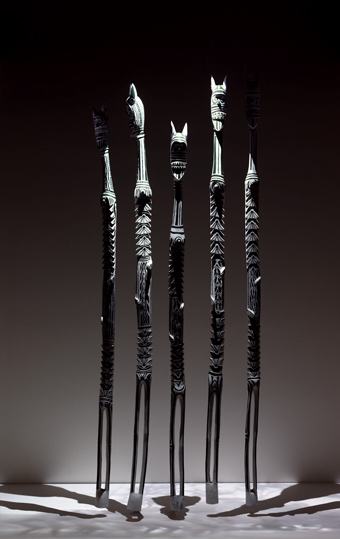
Mokuy, Nawurapu Wunungmurra
courtesy the artist and Museum & Art Gallery of NT
Mokuy, Nawurapu Wunungmurra
THE 27TH TELSTRA NATIONAL ABORIGINAL AND TORRES STRAIT ISLANDER ART AWARDS (NATSIAA) HAVE BEEN ANNOUNCED. THERE IS ADDITIONAL EXCITEMENT THIS YEAR AS A NEW PRIZE CATEGORY HAS BEEN INTRODUCED IN RECOGNITION OF THE GROWING NUMBER OF INDIGENOUS ARTISTS WHO ARE EMBRACING NEW MEDIA AS PART OF THEIR ARTISTIC PRACTICE.
Previously, such works fell into the Wandjuk Marika 3D Memorial Award category where, for example, Nyapanyapa Yunupingu won in 2008 with her bark painting and video installation Incident at Mutpi, 1975 (RT87, p10).
The inaugural Telstra New Media Prize has been awarded to Nawurapu Wunungmurra for his work Mokuy.
Mokuy (spirit) is an elegant sound sculpture with video projection that evokes images and sounds of the coming together of spirits associated with sacred yams, “Morning Star feathers,” scrub fowl and doves at the sacred ground called Balambala: “The Yirritja mokuy come in on the birds djilawurr (scrub fowl) and bugutj-bugutj (banded fruit dove). The Dhuwa mokuy, they come in from rangi side (saltwater)” (Quoted material from awards website). RT
The 27th Telstra National Aboriginal and Torres Strait Islander Art Awards, Museum and Art Gallery of the Northern Territory, Darwin. www.nt.gov.au/nreta/museums/exhibitions/natsiaa/
RealTime issue #99 Oct-Nov 2010 pg. 24
© RealTime ; for permission to reproduce apply to realtime@realtimearts.net
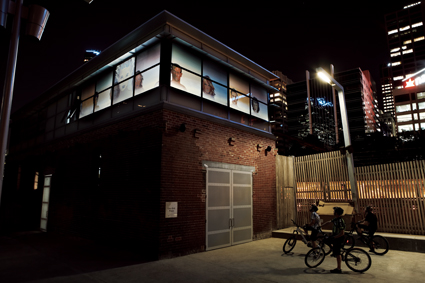
10 Transforming Youths, Philip Brophy, Signal Arts Studio
photo Lynton Crabb for About 3 Minutes Productions
10 Transforming Youths, Philip Brophy, Signal Arts Studio
MELBOURNE IS SPOILT FOR CHOICE WHEN IT COMES TO ARTS AND CULTURAL INFRASTRUCTURE. IT SEEMS BARELY A YEAR GOES BY WITHOUT THE INAUGURATION OF A NEW COMPANY OR THE OPENING OF A NEW VENUE. THE MELBOURNE RECITAL CENTRE, THE MTC THEATRE, THE WHEELER CENTRE AND VICTORIAN OPERA ALL SPRING TO MIND AS RECENT ADDITIONS TO THE CITY’S CULTURAL CAPITAL.
Another element that characterises the ever-evolving cultural landscape of the city is a penchant for converting its unique architecture and old buildings into new environments for creative expression. The City of Melbourne has lead this approach, with public art programs such as its well-established Laneway Commissions and versatile spaces such as ArtPlay on Birrarung Marr, a studio space for primarily school-aged children, and Arts House at the Meat Market.
The newest addition to this family is Signal—the ‘big sibling’ of ArtPlay—a multipurpose art studio for young people aged 13 to 20, which opened in February 2010. Located behind Flinders Street Station on the north bank of the Yarra River, the heritage-listed building was a decommissioned train signal box, gutted by fire in 2002. It has since been re-fitted with a downstairs performance space, an upstairs studio area, multimedia facilities and dedicated exhibition spaces such as the outdoor plaza area and projective windows on the building’s upper level.
The establishment of any art space dedicated to young artists is welcome news, but as a flagship youth venue in the City of Melbourne’s evolving arts program, it is interesting to consider what unique and new opportunities Signal will add. After all, the majority of art galleries, companies and organisations have dedicated education and engagement programs to target students and youth participants. Councillor Jennifer Kanis, Chair of the People and Creative City portfolio, says that Signal will offer “the opportunity for young people to develop as cultural citizens by engaging in a range of creative programs…It is our intention to provide the opportunity for young people to develop skills or just engage in a creative experience” (email Sept 6).
It is with this sentiment in mind that Signal has started its journey, not by focusing programs specifically around educational outcomes or vocational training as many youth arts programs do, but instead by encouraging broad and varied creative expression. It is a welcome approach, which acknowledges the value of developing young people who are culturally engaged and creatively stimulated, regardless of whether they want to become professional artists or makers.
Being unattached to an established arts organisation, Signal should be less restricted by art form or formal educational standards. Initially, its programming has been markedly diverse and its creative remit wide. With regular programming on Friday evenings and Sunday afternoons, facilitated by local artists, Signal covers a wide range of activities and art forms. Workshops are repeated over the course of a few months. This means that participants can, in one week, create their own animations, new media and sound artworks, or learn about printmaking, zine writing and craft techniques, and then continue in the following weeks with hip hop performances from Cultural Infusion, dance workshops with Jason Coleman’s Ministry of Dance, graffiti workshops with street artists Ghostpatrol and Acorn, or performances in the Signal Art Orchestra.
Already, Signal is building connections with established youth-focused organisations and initiatives, such as SYN FM, Express Media, St Martin’s Youth Art Centre and FReeZA. In this sense, Signal seems to be positioning itself as a central hub of youth creativity, a singular venue in its own right as well as a springboard into other pursuits and opportunities.
Despite not promoting itself as an ‘artist training’ facility, Signal is offering opportunities for its participants to gain industry experience. Through its Signal Curators program, young people will have the chance to visit and learn from other local arts organisations over a seven-month period. The intent is not just to develop knowledge of professional practice, but for participants to return to help curate and deliver the ongoing series of programs at the venue.
This type of program shows foresight, because one of the problems that youth organisations can encounter is what to do with participants once they reach the ‘upper age limit.’ Rather than automatically losing participants when they become ‘too old,’ it is very important for new youth organisations to identify ways to retain and re-engage these members in different yet rewarding ways. So far, Kanis writes that feedback in the program has been positive, with participants “pleased they have the opportunity to be engaged with a range of Melbourne’s arts organisations and experience how they work.”
Of course, some organisations, artist-run initiatives and collectives thrive on being ‘homeless.’ However, to promote youth engagement it is particularly important to provide a stable and dedicated space. Young artists benefit from having a space that is not only welcoming and comfortable, but one that is solely dedicated to their pursuits, which they can inhabit and make their own. Many creative youth projects are obliged to use existing spaces and venues, sharing with other community groups and having to ‘pack up the hall’, to make room for the next night’s activities.
Too often the arts—particularly in the context of local government—are bundled together with ‘leisure’ and ‘lifestyle’ activities. The value of a venue like Signal is that it reinforces for young people the idea that art and culture are vital forms of self-expression, and can be more than a pastime or hobby, if they want.
Signal’s programs of workshops are run by practising artists, while another aspect of artist engagement is achieved through its strand of high-profile, site-specific commissions. The inaugural recipient was Philip Brophy with his piece 10 Transforming Youths, a graphic animation that explores the physical and aesthetic processing of ageing and transformation, reflecting society’s cultural and commercial obsession with youth. Ten young figures—all resembling contemporary visual phenomena like internet avatars, anime characters and advertising graphics—gradually track across Signal’s external screens until they each morph into older, decrepit and sometimes grotesque versions of their stereotypically youthful alter egos.
These Signal commissions fulfil at least two important functions. They allow young participants to experience outstanding creative practice in the same setting in which they themselves are creating artworks. Secondly, the program has been an important way to inaugurate the space and raise its profile within the broader arts community. Signal has also presented curated programs for the 2009 and 2010 Melbourne International Arts Festivals, an important gesture that recognises youth art as being not at the periphery of established arts practice but rather an important contributor and participant in the broader dialogues within Melbourne’s art community. It will be interesting to see if Signal can establish its voice in the dense Melbourne artscape.
Signal, Flinders Walk, Northbank, Melbourne (behind Flinders St Station towards Sandridge Bridge); signal@melbourne.vic.gov.au
http://.www.melbourne.vic.gov.au/Signal/Pages/Signal.aspx
http://www.philipbrophy.com/projects/10transyouths/background.html
RealTime issue #99 Oct-Nov 2010 pg. 25
© Kate Warren; for permission to reproduce apply to realtime@realtimearts.net
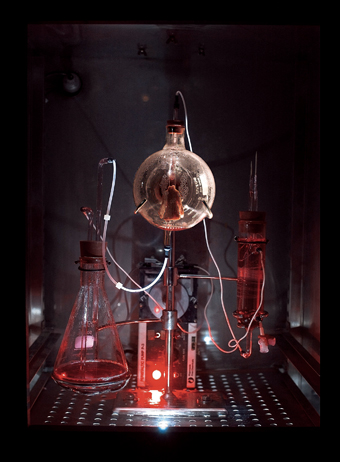
Victimless Leather, Ionat Zurr
courtesy the artist
Victimless Leather, Ionat Zurr
WA’S SYMBIOTICA—A KEY INTERNATIONAL CENTRE FOR THE BIOLOGICAL ARTS—IS NOW AROUND 10 YEARS OLD, TUCKED AWAY AND THRIVING IN UPSTAIRS LABS AND OFFICES BEHIND THE LEAVES AND SANDSTONE OF THE UNIVERSITY OF WESTERN AUSTRALIA (UWA). IT RUNS A RANGE OF ACTIVITIES THAT STRETCH ART/BIOSCIENCE ENGAGEMENT TO ITS VISCERAL EDGES. ITS AUGUST SYMPOSIUM, BODY/ART/BIOETHICS, FOCUSED ON THE BODY—THE HUMAN-ANIMAL ‘FLESH-MACHINE’—WHILE ALLOWING SPACE FOR A BROAD RANGE OF TOPICS OF INTEREST TO INTERDISCIPLINARY BIO-ARTISTS.
In the absence, for personal reasons, of the first programmed speaker, biopolitics researcher Catherine Waldby, “renowned Australian writer” Elizabeth Costello instead moved to the first session, delivering a strident address against the human abuse of animals drawn word for word from the JM Coetzee novel that bears her name. Tired from travel like her fictitious namesake, Costello referenced the Jewish Holocaust to evoke the horrors of what is done to animals in laboratories—and, by implication, perhaps in art too.
Whatever the purpose or extent of the hoax (how many took Ms Costello for the real thing?), these ideas, while in many ways ‘old school,’ created an undercurrent that flowed beneath much of the day’s subsequent discussion. If Costello’s didactic tone was easily dismissed, the arguments themselves seemed to resonate at some of the symposium’s most ethically uncomfortable moments.
UWA’s Darren Jorgensen suggested that the ephemerality and even failure of bio-arts as a category doomed it, like all avant garde movements. Orlan’s idea of the living Harlequin Coat, he said, finished up as an installation; while Stelarc’s ‘third ear’ never hears. Jorgensen compared bio-arts to the 1970s ‘earthworks’ movement, which featured direct human intervention into the landscape. “Bio-art, like earthworks,” he said, “presumes to occupy and simulate the place of nature itself:” its subject is “ a new cosmological order.” Ultimately, the earthworks movement suggests an ethics of “being in a conscious relationship with a system,” rather than presuming that nature still exists as a discrete, non-human category.
SymbioticA’s Academic Coordinator and Co-Founder of the Tissue Culture and Art Project, Ionat Zurr, focused on the ethical discomfort of working in bio-arts. Growing a semi-living ‘stitchless jacket’ from immortal skin cell lines (Tissue Culture and Art Project, Victimless Leather, 2004) entails walking a somewhat visceral ethical borderline. Scientists and the military routinely “cross the line,” Zurr said, while few but the religious and artists ask questions. By creating “semi-living sculptures and/or objects of partial life,” Zurr aims to prompt thought about the meaning of such life. “As long as I’m uneasy about what I’m doing,” she said, “I’m in the right place.”
In “Interspecies Collaborations,” US artist Kathy High explored intimate relations between artists and animals through her own work and that of other artists. Focusing on recognisable and familiar animals, High introduced a literally ‘warm and fuzzy’ theme centred on relationship, and (citing theorist Donna Haraway) the importance of interdependence based on response and respect.
High’s presentation included discussion of two artists whose works lie at apparent extremes. In Adam Zaretsky’s Transgenic Pheasant Embryology Art lab, students manipulate pheasant embryos through a ‘window’ in the eggshell in order to create mutant living forms. Watching this tampering with a life form that US law doesn’t count as an ‘animal’ is subliminally disturbing, even if Zaretsky’s workshop aims to prompt ethical discussion. By contrast, former SymbioticA resident Kira O’Reilly collaborates with animals using a potent combination of critical engagement and empathy. The UK artist has both co-cultured the skin cells of newly-dead pigs with her own to create hybrid, living skin and devised confronting, tender durational performances including Falling asleep with a pig (which is just what it says) and inthewrongplaceness (2005) in which she cradled a slaughtered pig for several hours.
History sheds light on contemporary ethical practice: Ethan Blue, a US historian currently at UWA discussed the photographs of early 20th century prison doctor LL Stanley, who recorded his ostensibly ‘corrective’ experimental surgeries on prisoners with “different bodies.” For Blue, Stanley’s photos “amplify the terror and participate in the crime.” Blue believes Stanley was “just trying to see what would happen,” and the subtext is clear, if confounding: every scientist and artist sets their own boundaries (and often with ethics committees as compulsory arbiters), but how clear can the line ever be?
Bio-arts may face the same threat that not-for-profit researchers grapple with as life processes are increasingly commercialised, according to keynote speaker Luigi Palombi. An expert in biotechnology patents based at the Australian National University (ANU), Palombi provided a passionate and erudite explanation of the way entrepreneurs like Craig Venter are attempting to license gene sequences as though they are not discoveries but ‘inventions.’ Adding to earlier discussion around the commercial cloning and sale of human cell lines (often without patients’ consent), Palombi’s spectre of magnates like Venter profiting from ‘ownership’ of human products offered bio-artists rich territories for critical interrogation.
As the day drew to a close, two of SymbioticA’s current interdisciplinary researchers, Tarsh Bates (NZ) and David Khang (Canada), each asked, “How do we construct bodies when making art—who’s exploited, and how do we make political, ethical, poetic art?” Bates focused her attention on “what kind of world we desire,” explored through the lens of reproductive technology and complicated by race, geography, education and wealth. Khang, an artist and dentist, has produced visceral works juxtaposing extracted human teeth—markers of human mortality—with the poetic extremes of ox-tongues and butterflies. His gallery-based performances, such as How to Feed a Piano, employ symbolic language to confound cultural categories, including race.
In closing the symposium, SymbioticA Director Oron Catts pointed to the variety of critiques of biotechnology and bio-arts presented. Not only do the practices of art and science need to be ‘unpacked,’ he said, so too does the history of art itself and “the ethics of the hype” around scientific discovery and so-called ‘revolutionising’ research such as the Human Genome Project.
Catts stressed the acute need for bio-artists to provoke ethical consideration, from artists’ own informed and participatory perspective. Bio-art, he said, is sometimes judged by its ambiguity to be “flaky,” but this ambiguity is its strength: art sits in a privileged place where disturbances and disruptions provide powerful engagements with ethical issues but where problems need not be solved.
Body/Art/Bioethics symposium; SymbioticA —Centre of Excellence in Biological Arts, University of Western Australia, Aug 6
RealTime issue #99 Oct-Nov 2010 pg. 27
© Urszula Dawkins; for permission to reproduce apply to realtime@realtimearts.net
NOW IN ITS 17TH YEAR, THE FILMMAKING SUMMER SCHOOL IS PART OF THE PUBLIC ENGAGEMENT PROGRAM OF SCREEN STUDIES, UNIVERSITY OF MELBOURNE, OFFERING INTENSIVE TEACHING IN ALL ASPECTS OF PRACTICAL FILM PRODUCTION. IT’S THE IDEAL TIME OF YEAR TO ACQUIRE SKILLS BUT ALSO GET A PERSPECTIVE ON AN INDUSTRY THAT LOOKS LIKE IT’S FINALLY GETTING ON ITS FEET AFTER SOME HARD YEARS. YOU CAN EVEN LEARN HOW TO ROLL WITH THE BLOWS DELIVERED BY CRITICS.
The teachers are leading Australian film industry practitioners. For the 2011 school they include screenwriter Mac Gudgeon (Good Guys, Bad Guys, Last Ride), composer Cezary Skubiszewski (Two Hands, Bootmen, Bran Nue Dae, Blessed), sound designer Craig Carter (Romeo & Juliet, Babe, Rabbit Proof Fence, Kenny, Home Song Stories), director Nadia Tass and cinematographer David Parker (Malcolm, The Big Steal, Amy, Matching Jack), producer Sue Maslin (Japanese Story, Hunt Angels), production designer Jo Ford (My Brother Jack, Road From Coorain, Kidnapped, Last Ride) and a host of others.
Areas taught cover screenwriting, cinematography, producing and production management, directing actors, production and sound design, editing, digital effects, film music, screen language, film business and legalities, marketing and distribution and documentary filmmaking.
There will be lectures on genre films and Wendy Haslem will interview critic and film festival director Paul Harris in a session titled “The Critics and your Film.”
Courses included “From Script to Screen”, “Cinematography Intensive” taught by Ellery Ryan (Angel Baby, Dead Letter Office, Van Diemen’s Land, I Love You Too) and “Digital Cinematography” with the latest in HD technology to hand. And you can live-in at the university if you wish. RT
Filmmaking Summer School 2011, Trinity College, University of Melbourne, Jan 5-25, summerfilmschool@me.com; http://www.summerfilmschool.com
RealTime issue #99 Oct-Nov 2010 pg. 27
© RealTime ; for permission to reproduce apply to realtime@realtimearts.net
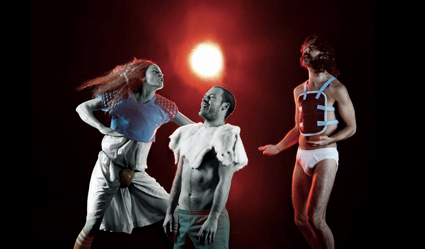
Kristy Ayre, Timothy Harvey, Luke George, NowNowNow
photo Jeff Busby
Kristy Ayre, Timothy Harvey, Luke George, NowNowNow
“SUBLIME IS THE NAME GIVEN TO WHAT IS ABSOLUTELY GREAT. BUT TO BE GREAT AND TO BE A MAGNITUDE ARE ENTIRELY DIFFERENT CONCEPTS…” IMMANUEL KANT, THE CRITIQUE OF JUDGEMENT
The sublime teeters between the dizzying heights of abstraction and the ground of the earth, between nature and art, mathematics and the ineffable. According to Kant, the mathematically sublime is beyond calculation, beyond quantifiable measurement. And yet, Grace Walpole entices her audience with the sublime qualities of π, a household ratio that would appear to be eminently measurable. Or is it?
We know that the circumference of a circle is the square of its radius times π. No matter what size the circle, this formula holds. Walpole rolls an everyday circle, a dinner plate, along her leg, extolling the sheer reliability of its numerical calculation. Surely nothing could be more concrete? Yet a precise articulation of π requires a mathematics of infinite numbers, belongs to the irrational number system and smacks of transcendence: π goes on forever.
Walpole plays between these two mathematical spheres, between the concrete body as that earliest of measures and the filigree of pure maths, between the sensible and the Platonic worlds. She spins a plate, she swings a rope, twists a string. Interspersed between these bodily musings, Walpole offers her audience a discourse on the mathematics of each gesture. She stands in front of us in order to lecture, exhibiting a mixture of delight and awe in face of the mathematically sublime.
But the body is not merely a means of measurement. Throughout Mathematical Models of the Sublime Walpole repeatedly turns to the work of entomologist Justin O Schmidt, who personally rated and described a bevy of horribly painful insect stings. Walpole locates this weird attempt to quantify pain within her own clinical experience as a doctor. While Schmidt can numerically contrast “caustic and burning” (paper wasp) with “bold and unrelenting” (red harvester ant), it’s not so easy to find a common measure of pain that holds between bodies. One patient’s agony could be another’s discomfort.
All in all, Mathematical Models of the Sublime is a kind of researched whimsy, a conversation held between two sisters (Grace and Helen), an investigation turned into art. The body plays a role in this meditation, not merely as an aesthetic medium but because the thinking embedded in the work addresses matters corporeal: How do mathematics invoke the body? Can we quantify pain in the body? Could we unravel three dimensional string theory? There is something very nice about two sisters together making art. In another epoch they may have written a series of letters to each other, staged experiments in their own home or addressed an audience of amateur scientists. There is a sense of conversations had in this work, of the drawing room as well as the drawing board, of common pursuit being opened out for a wider audience. While the work engages the cutting edge of mathematical thought, it also suggests the 19th century salon. Grace Walpole’s manner of address is quaintly direct, slightly mannered. My own feeling is that the text and its delivery could have been more textured, more aestheticized in line with the rest of the performance. Mathematical Models of the Sublime was nevertheless gently infectious, a mindful and gracious exploration of things great and small.
Luke George’s NowNowNow was different, action-based rather than discursive. Its aim was to stage an event where all three performers sustained an ‘in the moment’ focus for the entirety of the performance. According to Buddhist monk, Chögyam Trungpa: “Speaking generally what happens is that, once we have actually opened, ‘flashed’, in the second moment we realize that we are open and the idea of evaluation suddenly appears. ‘Wow, fantastic, I have to catch that, I have to capture and keep it…’ so we try to hold onto the experience and the problems start there…” (Cutting Through Spiritual Materialism).
The difficulty of staying in the moment is that there are so many of the damn things. One moment slips into another. However achieved—and there are several ways to skin a cat—remaining ‘in’ any given activity is easier said than done. For a start, nothing stays the same. There’s a lot to keep up with in this world of becoming-performance. Plus, the body-in-movement is streets ahead of the mind-that-keeps-track. My foot finds the floor. The moment of their meeting is achieved in the passage towards another step. Three performers jump, then jump again. It would seem that repetition takes over. But then again, isn’t each jump a particular jump, a unique meeting between foot and floor, launch and landing? Maybe jumping is the iconic kinaesthetic moment: in motion, negotiating multiple forces, the pull of gravity, the body’s memory, the body in this moment.
And what of the audience? Is the audience inside or outside this experience? The white, felt flooring laid for NowNowNow made the space a kind of pure interiority. Audience members took off their shoes and were folded into this springy space. Unfortunately, this feeling was not supported by the rows of seating, oriented down towards the spectacle.
Sometimes NowNowNow bristled with presence, a moment held aloft for all to see, sometimes it was almost autistic in preoccupation, head down, doggedly following some score. So the question arises: what kind of moment are we talking about? Playing X-Box is a completely captivating experience but lacking in interest for non-players, whereas a shared moment between all three performers, in that second before it evaporates, well that’s exciting, because we can all identify and participate in that moment.
While Mathematical Models of the Sublime invited gentle contemplation, NowNowNow took off, a bird flying into plate glass time and again. Somewhat episodic, its attempt at the humanly impossible was an attempt to scale the sublime. Would it be “absolutely great” to be in the moment, moment after moment? Or would we be like Sisyphus having pushed the boulder uphill, taking in the view just before it bloody well rolls down again? Sometimes, just sometimes, a performance is infectious. To be in the moment is to die a little death, to let go of the evaluator. For the moment, that’s all there is. Isn’t it awesome?
Mathematical Models of the Sublime, concept, development Grace and Helen Walpole, animateur, performer Grace Walpole, writer, designer Helen Walpole, composer David Corbet; Dancehouse, Melbourne, July 14-18; NowNowNow, choreographer Luke George, performers: Kristy Ayre, Timothy Harvey, Luke George, design Bluebottle, dramaturg Martyn Coutts; Dancehouse, Melbourne, July 29-Aug 1
RealTime issue #99 Oct-Nov 2010 pg. 30
© Philipa Rothfield; for permission to reproduce apply to realtime@realtimearts.net
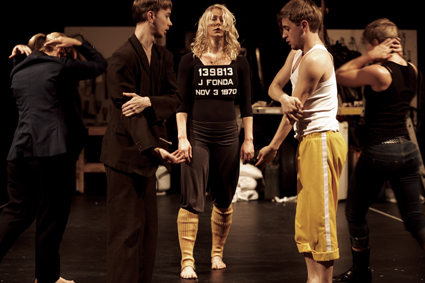
Heath Barrett, Rachel Ogle, Martin Hansen, Personal Political Physical Challenge, Hydra Poesis
photo Traianos Pakioufakis
Heath Barrett, Rachel Ogle, Martin Hansen, Personal Political Physical Challenge, Hydra Poesis
THE OPENING SCENE OF THIS INTRIGUING NEW WORK BY PERTH COMPANY HYDRA POESIS RESEMBLES A REHEARSAL FOR A SERIES OF DOOMED COME-BACKS. A MAN STUMBLES BLINDLY ACROSS THE STAGE IN AN ENORMOUS KARL MARX HEADPIECE. ANOTHER SPORTS THE WIG AND TIGHTS OF A FRENCH ARISTOCRAT, WHILE A WOMAN WHO LOOKS A LOT LIKE JANE FONDA DOES HER BEST TO WORK IT ALL OUT IN A SCOOP-NECKED, CLAMMY NYLON LEOTARD AND KNITTED LEGGINGS. THEIR ENCOUNTERS ARE CLUMSY; THEIR BRIEF ENSEMBLES DO NOT ENDURE.
The roller-door lifts on a young middle-class suburban couple. Their malcontent is narrated by a tyrannical MC: “Happiness has become boring,” she spouts on behalf of the woman. “Pleasure is boring…Food is boring…Our lifestyle is not a life…I want to be something more;” she wants “drama and resistance.” In a garage filled with props from the local Bunnings, the performers borrow from worn-out manuals of terror. Scenes of Maoist self-criticism are followed by basement interrogations. Ethical double binds leave the couple on different sides of the fence. Their union under threat, they join forces in a parody of enslaved labour, moving bags of cement about the garage in repetitive and meaningless acts of physical endurance.
In Personal Political Physical Challenge director Sam Fox and his talented collaborators offer a comic vision of an (a)political present desperately repeating the stereotypes of a political past—the first time as tragedy, then as farce. The audience is offered an abridged history of ambiguous truth-status that goes something like this: in the 1970s Jane Fonda abandoned Vietnam and found(ed) aerobics. With the failure of Marxism and the Fall of the Wall in 1989, we dispensed with the Brotherhood and the Internationale (performed nostalgically or humorously—the modality is ambiguous—by Martin Hansen), acquired a home loan and set to work on our privatised spaces of house and body. Cut to 2010. If a higher cause is needed, there is Live Art, there is ballet and Pilates and contemporary dance to stand in for physical capital. In the absence of hard work, girls and boys, we can work hard.
There are moments of poignancy and clarity in this provocative work. The choreography is tenuous, desperate, the unions fragile. The movement feels open-ended and exploratory, as befits a small budget, limited rehearsal time and good ideas. The composition by Stina Thomas drives us towards the very intensity of yearning that lies at the core of the performance. With self-realisation and belonging no longer possible through identification with the Workers and other Grand Narratives, how do we register intensity and ecstasy? Where is that ‘something more’ to be found?
Beyoncé’s “Halo” is playing. Martin Hansen is naked but for a set of placards stacked around his neck. Rachel Ogle is dancing next to him. He flips the cards and delivers her a series of hand-written directives. To the tune of a perfect Hegelian hit, Rachel Ogle closes her eyes and attempts transcendence. It is a schizophrenic little narrative that Hansen engenders, brilliantly capturing the absurdity of the individual subject’s contemporary predicament. Over-interpolated and under-resourced, Rachael Ogle does her best to follow the provocations. Privatised loungeroom subjectivity (“Dance Like Nobody is Watching”) is followed by unbearable public scrutiny (“But They Are—The Whole World is Watching”), which leads to self-aggrandising and terrifying globalised responsibility (“And The World is on your Shoulders”). In the flip of a board there remains global holocaust (“And the World is on Fire”), and personal humiliation (“And You are Naked”).
While the movement, sound and choreography articulate this yearning through intensity and repetition, the spoken text is less rigorously conceived. Rich undecidability sometimes gives way to confusion. As set out in the director’s notes, ambiguity in the performance mirrors a contemporary absence of political direction. We lack in Australia “clear benchmarks of political belief.” So we find ourselves in late 2010, at the end of Politics and Meaning, performing rigorous workouts which stand in for the absence of work (in the Marxist sense). At the risk of being horribly literal (Stalinist?), I wonder what is lost and gained in exploring that void (if it exists) through old truisms of terror borrowed from the bogies of Marxism and Maoism—albeit in an ambiguously comic turn? A strange choice for a set of artists well under 40, I thought. The rich discourse of resistance may have lost its centre, and there were plenty of people all over the world who were pretty happy about that. But if you ask me, there is no shortage of things to get worked up about closer to home. On the ground and in the sky.
Hydra Poesis in association with PICA, Personal Political Physical Challenge, director Sam Fox, choreographic collaboration Martin Hansen, Rachel Ogle, Sam Fox and dancers, performers Rachel Ogle, Martin Hansen, Bianca Martin, Heath Barrett, Kathryn Puie, composer Stina Thomas PICA Performance Space, July 16-20
RealTime issue #99 Oct-Nov 2010 pg. 31
© Josephine Wilson; for permission to reproduce apply to realtime@realtimearts.net
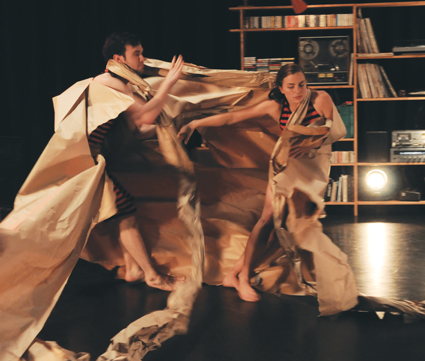
Rennie McDougall, Jorijn Vriesendorp, Mix Tape
photo Heidrun Löhr
Rennie McDougall, Jorijn Vriesendorp, Mix Tape
AFTER BYRON PERRY, ANTONY HAMILTON AND MICHELLE HEAVEN, STEPHANIE LAKE IS THE FOURTH YOUNG DANCER TO PRESENT A FULL-LENGTH CHOREOGRAPHY UNDER THE AUSPICES OF CHUNKY MOVE IN THEIR NEXT MOVE SERIES. A SPECTACULAR DANCER, LAKE TOO IS AN ARTIST WHO HAS CLOSELY COLLABORATED WITH GIDEON OBARZANEK AND LUCY GUERIN, HAVING OVER THE YEARS CONTRIBUTED TO MANY OF THEIR MOST ACCLAIMED WORKS.
Lake’s previous short works have been charming and soulful miniatures exploring banality: displays of physical affection, emotional reverberations of pop music, everyday language—all important ingredients of Mix Tape, which purports to be a study of love. This is unheroic, unremarkable love, built out of banal language and humdrum gestures (such as, indeed, making a mix tape). Lake builds the work out of three distinct elements: audio recordings of interviews about love, pop songs (spanning Bob Dylan and Joanna Newsom, Caribou and Fleetwood Mac), and the bodies of four dancers (invariably young, slim and petite). The stage is domestic, but minimal: a bookshelf filled with tapes and music players, including an old reel-to-reel, and suitcases full of clothes. The effect is resolutely homey, verging on agoraphobic. It is not merely the setting that is domestic: the performers linger on stage, lying down and changing costume, inhabiting it as their private space.
The movement energetically illustrates some of the conflicting emotions brought up in the accompanying recorded interviews and songs: two couples interlock in intimate embraces, planting small kisses in hidden spots, while at other times bodies are helplessly flung about or confront each other in violent fights. Lake shows great ability to create beauty out of everyday motifs (in particular, she uses the vocabulary of domestic affection to great effect), but the choreography is greatly indebted to Guerin: from tiny but swift hand and facial gestures, through loose and less articulate movements of the torso, down to strong reliance on domestic gadgets as catalysts of choreography, mirroring duets and the predominance of 45-degree spatial relationships. The semi-documentary nature of the work displays the influence of Obarzanek’s methodology, but without his editing discipline.
Most troubling, however, I found the choice of performers. Is it possible to illustrate the possibilities of physical affection on such a narrow range of bodies? The voices in songs and interviews were greatly more varied. I longed to see the complex emotions they expressed developed by wiser, older bodies whose lived experience would allow them to express some of the subtle complexity of long-haul love. The second problem is numerical. Two couples can represent neither the universal exceptionality of a single couple, nor the diversity of a multitude—at best, they seem to represent a parochial range of, say, ‘me and my friends’.
The merely illustrative nature of the choreography rarely pulls the interviews and the songs into focus: as a result, spoken word seems to hold more meaning than it necessarily ought. The individual introspective revelations are skimmed through, and yet the work never builds into a sociological study either. It rambles, rather, remaining charming but fragmentary, its shape never rising above a sort of list of different things we might say about love. It is difficult subject matter, on which everything has been said many times over—including within dance. The dangers of falling into glibness and pure cliché are enormous, and Mix Tape only occasionally avoids these. While Lake’s approach, equally open to sentimentality and to sociology, is intriguing, it requires greater structure and critical distance to succeed.
Chunky Move, Next Move: Mix Tape, direction, choreography Stephanie Lake, performers Sara Black, Rennie McDougall, Timothy Ohl, Jorijn Vriesendorp, lighting design Benjamin Cisterne, Blubottle, sound design Luke Smiles–motion laboratories, costume design Harriet Oxley; Chunky Move Studios, Sept 2-11
RealTime issue #99 Oct-Nov 2010 pg. 31
© Jana Perkovic; for permission to reproduce apply to realtime@realtimearts.net
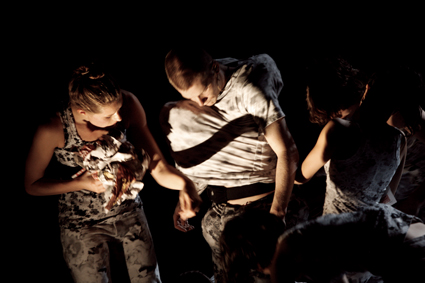
Human Interest Story, Lucy Guerin Inc
photo Jeff Busby
Human Interest Story, Lucy Guerin Inc
A GROUP OF RELAXED YOUNG PERFORMERS WATCH A LARGE TV SCREEN, CASUALLY OBSESSED BY WHAT THEY SEE AND HEAR AS JOSTLING NEWS STORIES OSCILLATE BETWEEN, ON THE ONE HAND, THE DAILY HORRORS OF WAR, MASS STARVATION, INTERCEPTED ASYLUM SEEKERS AND, ON THE OTHER, ‘HUMAN INTEREST’ STORIES, BUT WITHOUT DISTINCTION—THE NEWS AS ENTERTAINMENT. IT’S ALL HUMAN INTEREST, AND YOU CAN CHATTER ABOUT IT AND, HERE, DANCE TO IT.
The rhythms of news broadcasting appear to infect these people, knocking them slightly off-kilter and stimulating excited physical responses: sign language-like gesturing and tightly patterned, exquisite dance moves in twos and threes with unusual manipulations. But the sense of mutual pleasure is interrupted: one of their number (Stephanie Lake) wanders to one side: “Steph, what are you doing?” “Just doing a bit of a dancing.” Unlike the others, her dance is loosely lyrical, introspective, less highly articulated. A motif takes shape as Lake peels away again and again—her head in an everyday reverie…children to look after, food…It’s a motif of attempted separation that will return darkly when the work moves to its conclusion. As the news worsens (the massive fires in Russia) and simultaneously grows sillier (Anton Enus from SBS World News Australia plays himself in a pre-recorded episode), the group dance as one, eyes on the screen, its pull evident in the almost involuntary drag of arms that lead.
As our eyes adjust we see upstage an army tank, the only substantial design element, an ominous full-scale presence. As a series of increasingly grim images unfold, the sense of imminent war or crushed resistance grows—not that the dancers pay any attention to the tank or confront or dance on it, although I expect them to at any moment. They inhabit, save for Lake’s sidestepping, an apparent closed circuit. Sunny coloured costumes are replaced by black and white outfits.
However, while Lake’s ‘dissidence’—“just dancing”—is tolerated, a sole male (Alisdair Macindoe) is soon assaulted by his fellows in a darkening, dimly lit world. Slowly and neatly, they lay out rows of newspaper pages and then stuff them into the man’s clothing until he his swollen and bulging like the Elephant Man, disabled, an object to be played with, spun on the spot, high, low and crouching, faster and faster…knocked down, left to empty himself of news. As in Guerin’s Structure and Sadness (2009) the power of dance as installation is felt—design as integral, neither mere backdrop nor frame.
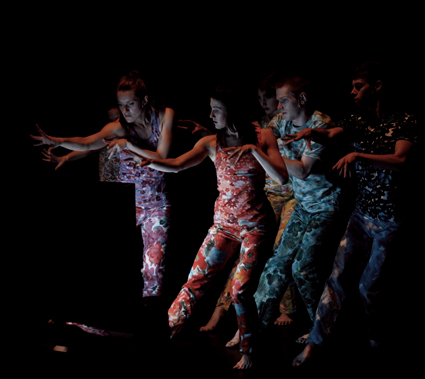
Human Interest Story, Lucy Guerin Inc
photo Jeff Busby
Human Interest Story, Lucy Guerin Inc
If the paper man episode amplifies the sense of news as not merely absorbed and embodied but also brutally inculcated, then another episode takes the earlier notion of news danced to and meaninglessly ‘interpreted’ a step further. Again, as if taking its cue from performance art, this episode is painfully durational: a woman (Harriet Ritchie) dances in a strict diagonal of low, yellowish light, any movement she makes along it, staccato leaps and spins, always resolving in a thumping, bouncing on the spot with no apparent counter-release to ease the appalling jolts. We no longer hear the noise of news; it’s as if the damage has already been done and here are the self-harming symptoms.
A group of dancers forms upstage, tangled, gesticulating, travelling forward in a rush, on the edge of violence, but returning and repeating the same action compulsively. One of them is Lake. As earlier, she breaks from the pattern. She combs her hair. She rejoins the group. The action resumes. Lake breaks away, this time leaving the auditorium—we hear her asked, “How’s the show going.” She returns, but this time is locked into the pattern—no escape. Meanwhile another group, on a parallel line, appears to “just dance.”
If this motif of ‘just dancing’ looks like a temporary reprieve from the horrors and the absurdities of the news, or even a kind of freedom, the show’s final image is not reassuring. The dancers cluster tightly in golden light upstage, the tank looming behind. Some gesture rhetorically, like politicians, one plays air guitar, others look up as if in awe, but there is nothing transcendent in the image, no-one breaking from the crowd or differentiated from it. No dancing.
It’s difficult to do justice to Human Interest Story from one viewing, to describe the significant role of Jethro Woodward’s gritty score or to be sure that one’s reading of this theme-driven but viscerally realised work is adequate, although the unexpectedly blunt ending appears to mesh with Guerin’s apparent pessimism. Although the early representations of the flattening of affect by the news seem protracted, Human Interest Story moves dynamically from everyday states in which we can recognise ourselves into a deeply disturbing, ever-darkening embodiment, both literal and metaphorical, of the traps set us by the contradictions of the news media. Lucy Guerin, as ever, has created a work at once cerebral and emotional, a dream turned memorable nightmare. It’s apt that Human Interest Story is part of Company B Belvoir’s mainstage program for 2011 in Sydney. That’s great news.
Lucy Guerin Inc, Human Interest Story, choreographer Lucy Guerin, performers Stephanie Lake, Alisdair Macindoe, Talitha Maslin, Harriet Ritchie, Stuart Shugg, Jessica Wong, set design Gideon Obarzanek, realising designer Anna Cordingley, costumes Paula Levis, lighting Paul Jackson, composer, sound designer Jethro Woodward; A Malthouse Theatre, Lucy Guerin Inc & Perth International Arts Festival Commission; Merlyn Theatre, Malthouse Theatre, Melbourne, July 23–Aug 1
RealTime issue #99 Oct-Nov 2010 pg. 32
© Keith Gallasch; for permission to reproduce apply to realtime@realtimearts.net
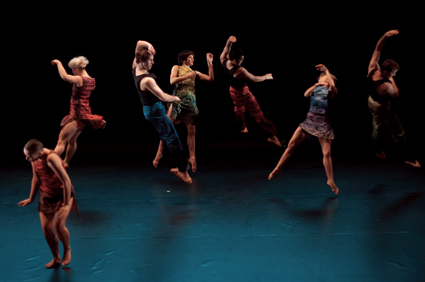
Racing Hearts/Hummingbird, Tasdance
photo Jen Brown
Racing Hearts/Hummingbird, Tasdance
WIPING THE FACE. TEARING IMAGINARY MATTER FROM THE MOUTH. SHAKING IT OFF. RAW SOUNDS OF BODIES AND BREATH FILLING AN OTHERWISE EMPTY STAGE. TEXT BUILDING AND DISSIPATING ON A SCREEN. WASHES OF COLOUR. THESE ARE IMPRESSIONS OF RACING HEART/HUMMINGBIRD BY CHRISSIE PARROTT—THE FIRST OF TWO WORKS IN TASDANCE’S NEW PROGRAM, HEART MATTERS. IT COULDN’T BE ANY MORE DIFFERENT THAN ITS COMPANION PIECE, FORTY MILES—A RIVER OF DREAMS, CHOREOGRAPHED BY GRAEME MURPHY, WHICH VEERS TOWARD REPRESENTATION RATHER THAN ABSTRACTION IN CONTENT.
Heart Matters is the latest in a long series of works from Tasdance built around guest choreographers, although the show really began with director Annie Greig’s dream to collaborate with the Tasmanian Symphony Orchestra, which in turn brought two composers into the frame. Constantine Koukias developed a score for Parrott while Carl Vine arranged his fifth quartet for Murphy. As the program’s title indicates, the shows are linked under a thematic banner relating to those things in life that move the heart.
Parrott’s Racing Heart/Hummingbird focuses on emotional and physical responses to writings on love, be they pithy, passionate texts or long, sultry passages. This text is the literal backdrop to the dance, with evocative phrases such as “my wrists are aching as you pulse through my veins,” appearing and disappearing as if typed onto a glowing screen at the rear of the stage. Thanks to Joe Mercurio’s deft lighting design, it appears as though the dancers are washed with the light of the screen while the text and colour also rinse across Leon Krasenstein’s costumes—graduated reds, blues and greens layered with phrases from the show.
The choreographic language of Racing Heart evolves from a suite of tender movements between dancers, signifying the beginnings of a love affair and tends toward ever more spasmodic and violent gestures as the work builds and love stumbles. Parrott has focused much energy in the dancers’ hands, with repeated flicking, slapping and shaking gestures characterising the choreography. Koukias’ oscillating oboe and strings create a tense space that enhances the growing agitation of the dancers while, underlying the live score, a soundscape comprises elements such as whispered readings, bells ringing, a heartbeat and a life support monitor.
While still dwelling on matters that touch the heart, Graeme Murphy’s Forty Miles—a river of dreams concentrates on feelings evoked by the landscape between his Northern Tamar River home and the city of Launceston. Veering away from Parrott’s empty stage and abstracted language, Murphy’s work stamps itself as a representational and symbolic work from the opening moments. His stage is a vast landscape in miniature. A silken river divides mountains from a forest created by the dancers bearing quivering, bare clusters of branches. Their costumes—also by Krasenstein—rendered in delicate shades of grey suggest that they are part of the fabric of this natural scene.
This work is unashamedly classical in structure, choreographic language and score telling a simple story of growing love between lead female (Floeur Alder) and lead male (Joel Corpuz). Such are the shape of arms, lines of movement and arrangements of the company that I keep expecting the dancers to transition into pointe work at any moment. Looked at more closely however, the detail is contemporary and compelling, with swift, smooth and technically complicated lifts, holds and interactions between the lead dancers reminding me of Murphy’s wealth of choreographic experience. The composition for strings by Vine melds with the fluidity of Murphy’s choreography, though it leads the mood at the end of the work with a lively—if a little out of character—sequence performed by the whole company.
I really want to be able to say that Heart Matters was a dazzling experience. I was so excited to see the Tasmanian Symphony Orchestra tuning up under the lip of the stage and the thought of live, contemporary composition paired with seasoned choreography was very appealing. But unfortunately my heart didn’t soar. And that does matter, particularly as contemporary dance relies on emotional connection. I’ve given some thought to why I feel this way and I think that perhaps the main players underestimated the weight that such universal subject matter brings to a work. To make a show about love or the heart, one must innovate in a way that allows it to rise above all of the other ghosts of dances past. While there were beautiful glimmers of difference throughout each of the works—particularly in the duets between Alder and Corpuz in Forty Miles—unfortunately Parrott’s evolution from the flush of new love to betrayal and loss, followed by Murphy’s rendering of the beauties of nature, did not strike enough new notes to dispel those ghosts.
Tasdance, Heart Matters: Forty Miles—a river of dreams, choreography Graeme Murphy, composition Carl Vine; Racing Hearts/Hummingbird, choreography Chrissie Parrott, composition Constantine Koukias, animation Jonathan Mustard; dancers Floeur Alder, Sofie Burgoyne, Joel Corpuz, Trisha Dunn, Sarah Fiddaman, Malcolm McMillan, Jason Northam; costume & set design Leon Krasenstein, lighting Joe Mercurio; Tasmanian Symphony Orchestra, conductor Kenneth Young; Theatre Royal, Hobart, July 23, 24
RealTime issue #99 Oct-Nov 2010 pg. 33
© Judith Abell; for permission to reproduce apply to realtime@realtimearts.net
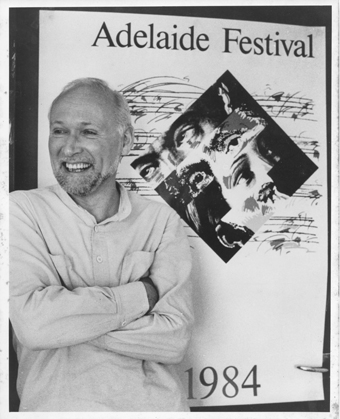
Anthony Steel with Adelaide Festival poster 1984
courtesy Wakefield Press
Anthony Steel with Adelaide Festival poster 1984
ANTHONY STEEL’S “ANECDOTAL MEMOIR,” PAINFUL IN DAILY DOSES, IS ANYTHING BUT TORTUOUS. SWERVING ENTERTAININGLY BETWEEN ESSAY, DIARY, AUTOBIOGRAPHY AND HISTORY, VIVIDLY EVOKING EVENTS, PERSONALITIES AND PRODUCTIONS, THE MEMOIR RECOUNTS THE INCIDENTAL MAKING OF AN ARTS FESTIVAL DIRECTOR, FROM CHILDHOOD TO THE 60S IN THE UK AND THE SUBSEQUENT REALISATION OF A DISTINCTIVE CAREER IN AUSTRALIA IN THE 70S, REACHING ITS PROUD APOTHEOSIS FOR STEEL IN THE ADELAIDE FESTIVAL OF 1986 AND THE BRISBANE BIENNIAL INTERNATIONAL MUSIC FESTIVAL IN 1993.
Painful in Daily Doses is a cosmopolitan, picaresque romp of a book replete with the requisite ingredients: food, drink, sex, a life on the road and in the air, heroes and villains, epic travel, dead-ends, sackings and successes—fate largely dealing the man a very good hand. And it’s often funny. Above all it celebrates the art that Steel has resolutely and passionately championed, broadening and deepening Australian engagement through bold programming, commissioning and sheer force of personality. But what kind of personality is revealed in this memoir?
Steel was the first director of the Adelaide Festival Centre (a product of the Dunstan Enlightenment), subsequently artistic director of five Adelaide Festivals in their golden age, director of the first Brisbane Biennial International Music Festival and other events as well as playing an advisory or instigatory role for other important festivals (and not a few that never manifested), setting up his own business, Anthony Steel & Associates, and sitting on Boards of the Australia Council for the Arts.
The book’s title comes from Bruce Macklin, Chair of the Adelaide Festival Board at the time of Steel’s departure in 1978: “When asked what it had been like working with me he replied, ‘Like a shot in the arm; stimulating, but painful in daily doses.’” The book’s voice is animated, opinionated and frank, mildly confessional and, at times, dismissive (a barely introduced figure can be declared ‘a crashing bore’ and is gone in a sentence; productions are dealt fatal judgements in a few words). But the overall tone is benignly authoritative rather than authoritarian—before he came to Australia Steel had to suffer autocratic bosses who not only treated him like a glorified office boy but, he admits, could scare him. He would be different. In a stint in his family’s erstwhile steel manufacturing business he had learned to delegate to much better informed employees.
Other kinds of authority figures would later beleaguer Steel: politicians, board members, sponsors, critics and the vocal wowsers Adelaide has long given undue attention, but Steel himself comes across as a team-player, developing camaraderie in the new Adelaide Festival Centre and reliant, across the decades, on the skills and enduring loyalty of employees and associates like Marguerite Pepper, Rob Brookman and others. There are moments, for example in the late 70s when he’s going through a rough patch (work, drink, a belated sexual revolution) when he is surprised to hear that he might not have had the loyalty of his Festival Centre lieutenants, but these are exceptions.
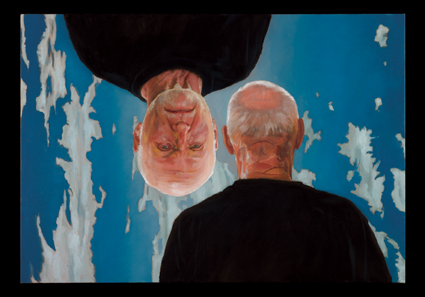
Ian North, Anthony Steel, 2007
Doubtless Steel’s opinions and strength of purpose could and did irk on a daily basis: his one-line putdowns when defending his festivals, contemporary art, artists and colleagues against recurrent charges of elitism, or waste or obscenity (what’s new?) could keep parochial journalists and other complainants busy for weeks. In an ABC TV interview he declared, “Of course the festival is not for the people in the same way a cricket match is not for me.” At one point a short-lived ‘festival action group’ demanded a festival comprising a ball, a mardi gras and a full racing week. Much to his relief, Steel was once banned by Adelaide journalists from being interviewed for a month. He aptly calls himself “a proseletysing modernist”—his festivals were evidence of that and we revelled across two decades in first Australian appearances by John Cage, Phillip Glass, Molissa Fenley, Merce Cunnigham Dance Company, The Wooster Group, Billie Whitelaw doing Beckett, Spalding Gray, the Rustaveli Theatre Company, Cricot 2, the Shostakovich Quartet, Tenkei Gekijo, the Bread and Puppet Theatre, Jan Fabre, music of 20th century American and Australian composers including commissions, a string of modern operas and music theatre works and much more.
Relative to the terseness of Steel’s opinions, Painful in Daily Doses is positively garrulous, not a trait I’d associate with the man, who has always struck me as somewhat shy. He writes, “Every considerable drinker has his or her sound reason (at least in their own eyes) for the habit. Mine was my painful shyness in the company of all but those whom I know very well.” Elsewhere he turns to a few drinks for the “dutch courage” with which to face the Sydney Festival Board, is non compos on several important occasions in the 70s and is obliged in Georgia by the wonderful Rustaveli Theatre Company to consume large amounts of alcohol, a form of negotiation sometimes endemic to his job. What’s interesting is not the alcohol, so much as evidence of an intrinsically shy personality who might blurt out an opinion, deeply felt but, on occasion, quite untimely and inadvertantly suggesting a dominating personality. Curiously, on first meeting Don Dunstan he is non-plussed by the man’s inability to make small talk. Like many an artist, Steel appears to be of the introvert-extrovert mix, but in Painful in Daily Doses he’s very much at ease and we feel like he knows us all very well.
Part of the book’s charm is manifest in Steel’s openness to life and chance. He mentions several times that his career moves were unpremeditated. In his account of his evolution into famed festival director, he often seems to have been in the right place at the right time and destined to mix with seriously talented artists. His family loved music. His sisters and their spouses were professional musicians. As a child he played clarinet with Dame Myra Hess at the piano, as school choir leader he chatted with composer Ralph Vaughan Williams, at Oxford he sang in a choir conducted by Sir Thomas Beecham and in concert versions of Mozart operas conducted by young Colin Davis. He never stops singing, in university and rural choral groups, in the London Philharmonia under Klemperer and Guilini, at the opening of the Adelaide Festival Centre—Steel sees Prime Minister Whitlam to his seat and “duck[s] back to join the tenors in the chorus” for Beethoven’s Choral Symphony. If unhappy with his bosses at the London Mozart Players and the London Symphony Orchestra (doubtless learning that autocrats can be their own worst enemies) he met great artists and learned much, especially as “right-hand man” to Daniel Barenboim who was curating the adventurous Southbank Summer Music program in the late 60s, just before Steel was lured to Adelaide.
If these experiences and his love for music served him well, so did another love—of language. Steel learnt to speak Russian during a stint in national service in the Cold War 50s. It proved an invaluable asset for the future festival director, alongside his French and an ear for dialects and inventive obscenities. There’s a rich vein of linguistic observation in the book. Steel recounts that when he moved to Adelaide in 1971, ASIO attempted to enlist him to monitor entrepreneur Michael Edgley’s dealings with Russian artists: “I showed them the door.”
What is fascinating is how Steel, on a quite unpredictable journey, rapidly expands his practice from assistant manager in London music organisations to artistic director of a new arts centre and then a major festival in Adelaide, fuelled by his love of music and the remarkable flourishing of the arts he’d witnessed in 60s London, and making the most of connections he’d made in the UK and beyond. Steel’s accounts of the opening of the centre, of its internal politics, his remarkable 70s festivals (a blessing for us young Adelaideans), his stepping in to take over Elijah Moshinsky’s “unnaffordable” 1984 festival, and the triumph that was the 1986 festival are all vividly conveyed, warts and all.
What follows is a search for work around the world, the wrong job with the Los Angeles Philharmonic Orchestra (alleviated by a Ford Mustang, soul food and Zubin Mehta’s concerts in black churches), back to Australia, The International Theatre Season, the National Australian Theatre Festival in Canberra, the World Expo 88 On Stage, the 5th Festival of Pacific Arts (the diary account of a dash around the South Pacific is worth reading in itself), the Brisbane Biennial International Music Festival, where his love of music could fully flower, and the Sydney Festival. Sadly too many of these innovative festivals were cut off before their potential could be realised—some of the cultural gaps remain. As Steel writes of the National Theatre Festival, “it fell by the wayside with the typically Australian malady of political cowardice and underfunding.”
For those of us who lived through the period of the book, it’s a wonderful reminder of the riches and intricacies of the development of the arts and particularly of festivals in this country. For emerging festival directors it’s a superb manual on how to handle, or (instructively) not, boards of management, the occasional outrageous demands of artists (see the wickedly funny account of Tadeusz Kantor’s visit), censorious sponsors, uninformed critics and the growing “fundamentalism of the bottom line” (Steel quoting the prophetic Donald Horne). It’s also an enjoyable piece of travel writing: Steel makes it clear that works have to be seen before they’re programmed or disaster ensures (and it did), and this took him, and often Brookman and Pepper, around the world. There’s also a strong chapter on arts politics which among other things unhappily reminds us that “Australian political parties do not properly value the arts as a vital part of a country’s liberal democracy.”
Painful in Daily Doses is, in the end, nothing less than an autobiography, if a loosely constructed one, hence ‘memoir,’ conversational, hence ‘anecdotal,’ and unapologetically without an index (a pity) and at times only broadly chronological as Steel loops back and forth at will like a dinner table raconteur riding on a wave of associations. Many will relish the book as the welcome rarity it is, a substantial slice of cultural history in a country loath to document its artistic life, especially in the performing arts. Above all it celebrates the creative life of an idiosyncratic personality, brave, sometimes necessarily foolhardy: “In the mad, risky game of running festivals, there is always that constant tension between two virtually irreconcilable goals”—excellent work that “provides an experience out of the ordinary” and a balanced budget. Despite modest losses on his two best festivals, Steel resolutely believes that “the director’s foremost duty is to the program.” And this belief, acted on, has been well and truly to our benefit.
Anthony Steel, Painful in Daily Doses: An Anecdotal Memoir, Wakefield Press, 2010, ISBN 978 1 86245 875 6
RealTime issue #99 Oct-Nov 2010 pg. 34
© Keith Gallasch; for permission to reproduce apply to realtime@realtimearts.net

Victoria Hunt, Dancing the Dead, LiveWorks
photo Manuel Vason
Victoria Hunt, Dancing the Dead, LiveWorks
PERFORMANCE SPACE, SYDNEY’S HOME TO INNOVATIVE PERFORMANCE AND VISUAL AND MEDIA ARTS, IS PRESENTING ITS SECOND LIVEWORKS FESTIVAL IN NOVEMBER. THE FIRST WAS HELD IN 2008 [RT88] REVEALING A POTENTIAL THAT MIGHT NOW BE MORE FULLY REALISED AS THE EVENT TAKES OVER THE WHOLE OF CARRIAGEWORKS.
The festival will, says Performance Space publicity, “animate” the venue’s massive foyer and “confound the performance spaces.” The success of the 2008 LiveWorks suggests that the 2010 version is bound to be a great live-in, four-day, value-for-money experience, a chance to engage with a series of challenging works.
Artistic director Daniel Brine tells me that hiring the whole building was prompted in part by Nightshifters, an exhibition of works from eight leading video and media artists and part of Performance Space’s Live Live season as well as LiveWorks. Using all the CarriageWorks foyers, Nightshifters will address our sense of time and space by engaging magically with the twilight hour, as curator Bec Dean explains to Ella Mudie on page 51.
LiveWorks is promoted as “a fast and furious festival of new ideas” with over 20 artists and groups presenting experimental theatre, performance, live art, dance and installation alongside talks, debates, screenings and hands-on activities. Brine says that Performance Space put out a call for works from which they’ve programmed a mix of established and emerging innovators, including “artists we might not have otherwise encountered. It’s exciting but risky and could be hit or miss,” he says, “but that’s part of the festival experience.”
Brine also says that he and his team were keen “to encourage artists to think of other formats, to have a showing of ideas.” Consequently there are a number of performative lectures of various kinds running alongside performances, experiential one-on-one works, talks and installations. Brine wants each audience member to “make their own experience,” selecting from shows that run on the hour from 2pm each day. But he hopes too that they’ll take breaks, meet artists and each other. He emphasises too that LiveWorks is a level playing field festival, no big star international acts—“it’s about discovering the works for yourself.”
The big line-up of artists includes performance art provocateurs Brown Council who’ll restage A Comedy [RT98], an exercise in testing the limits of comedy, as well as appearing in Portrait of Brown Council by Brown Council, a session investigating the relationship between performance and work—“developing ideas for future work, debating the success of previous work and fielding questions from the audience.” The discursive Malcolm Whittaker [p40] performs A Lover’s Discourse—“a participatory art/love project in which strangers in Bristol and Sydney have conversed in handwritten love letters…It’s about our ever-evolving world and how the earth can alternately feel too big, too small and sometimes… just right.”
Nicola Gunn’s “psychological detective story,” At the Sans Hotel [RT96], entranced our Melbourne reviewer, John Bailey, with its enigmatic unfolding and its “brilliantly likeable performer.” With minimal but effective theatrical means, Tayla Rubins will perform Of The Causes of Wonderful Things (also shown in the Brisbane Festival’s Under the Radar program), investigating “what happens when something too dark to accept arrives on your doorstep. When five children disappear in a small town, the world of the dead begins to impact on the world of the living”. In The Vorticist, Jason Maling, continues his mysterious consultations which will be revealed only if you arrange a date: www.thevorticist.com.
Victoria Hunt (often seen with De Quincey Co) and former Performance Space artistic director Fiona Winning present Dancing the Dead: A Performed Conversation, probing Hunt’s Maori Heritage. Roarawar Feartata (Benjamin Cittadini, Brigid Jackson, Craig Peade and Georgie Read) will tackle notions of public space and performative identity in an engagement with outer Sydney suburb, the often-maligned Mt Druitt, in I Luv Amanda Crowe 4Eva. Georgie Read also appears in Paper People—“frivolous play with the particularity and peculiarity of some of the habits that make up human activity.”
The Berlin-based but frequently nomadic and likewise very lateral Paul Gazzola offers If I Go Like You, “simultaneously an installation, performance and social gathering…an opportunity [for audiences] to transform their persona through the exchange of clothing.” In another intriguing LiveWorks event, Sydney dancer, choreographer and dance curator at Campbelltown Arts Centre, Julie-Anne Long, presents The Invisibility Project, Now You See Her, which “follows a series of performance parties presented in private homes where the guests are both the audiences and participants…[T]his public intervention addresses the invisibility of middle-aged women in our society.” Long’s notable collaborators include choreographer Narelle Benjamin, Clare Britton (My Darling Patricia), artist activist Deborah Kelly and video artist Kate Murphy.
Curiously, Fondue Set member Jane Mckernan’s latest work, Opening and Closing Ceremony, is a solo performance “inspired by mass group physical displays of communist Czechoslovakia, the history of gymnastics as a nationalist form, the Brisbane Commonwealth Games opening, and a family celebrating the Bicentenary in 1988”. McKernan wonders “where the individual body intersects with notions of family, community and nation.” Another idiosyncratic performance-maker, Karen Therese, presents The Comfort Zone: A Performance Lecture, combining “humour and humiliation to examine the meaning and impact of our need to feel comfortable”. In another performative lecture, The Last Remaining Relative, Jiva Parthipan tackles the privilege of travel. Now that he’s been granted Australian residency after leaving the UK, Parthipan, says Brine, “completes his story with this performance”.
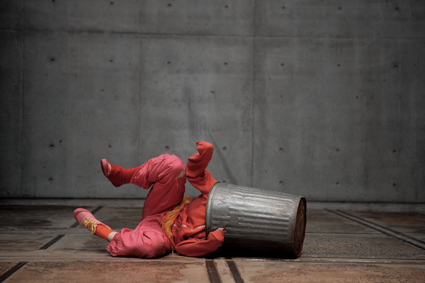
inda Luke, 3 Day Habitation, LiveWorks
photo Mayu Kanamori
inda Luke, 3 Day Habitation, LiveWorks
Dancer Linda Luke (who also performs with De Quincey Co) and composer Vic McEwan present Thirteen: A 3-Day Habitation, “a series of performance installations reflecting upon teenage homelessness and exploring our relationship to home, borders and displacement”.
If version1.0 have adapted forms like the parliamentary enquiry, press conference and TV interview in order to cast light on actual events, in This Is It, Team MESS (Dara Gill, Sime Knezevic, Frank Mainoo, Natalie Randall and Malcolm Whittaker) will “use the format of the film press conference to construct a completely speculative event.” Spin doctor heaven? In Thrashing Without Looking, from Melbourne, Martyn Coutts, Tristan Meecham, Lara Thoms and Aphids artistic director Willoh S Weiland will fit you with video goggles for “a ride through the dirty gems of dance mania and metaworld.”
Choreographer-filmmaker Sue Healey’s [see Archive Highlight] Performance Lecture, Variant, looks at “diversity and variation within the human form,” as part of her Curiosities series: “Each artist brings a different frame of reference to the body—physical ‘disability’, physical dexterity and extreme variations in practice”.
For an intense one-on-one experience, extensively exhibited UK installation artist David Cross invites you to enter “an inflatable fun house…an artwork designed to test our fears of dark, tight spaces and our limits of trust.” Also in CarriageWorks’ largest theatre, LiveWorks will complete its reign of disorientation with NightTime Spotlight: Ladies and Gentlemen we are Floating in Space, with a multitude of inventive artists and a single spotlight “exploring suspended states, be they political, metaphorical or beyond our understanding.”
A new initiative from Performance Space and Perth Institute of Contemporary Arts (PICA), P4 (Pilot), “addresses the experience and influence of live art in Australia and beyond.” This could generate interesting discussion given that the term live art has gained limited traction in Australia and there have been few attempts to locate it theoretically or even descriptively in the Australian performance landscape. But it is being taken up slowly as a label, as in Next Wave, by artists who see themselves as working outside the parameters of performance art on the one hand and contemporary performance on the other.
As a key part of P4, UK artists FrenchMottershead will bring a work to Sydney and Perth that “invites people to question their relationship to the public realm.” They ask people in the street to re-enact stories appearing in newspapers. They then rewrite the stories, publish them as newspapers and issue them in the streets. The process exemplifies P4 as “a series of live art projects framed by four simple creative parameters: practice, publish, participate and perform.” The other participating artists from P4 in Sydney are David Wills (conducting a mass games night), Lily Hibberd (whose work will be realised though she won’t be on hand) and Jason Sweeney (by remote communication). Artists working in Perth on P4 are Barbara Campbell, Makeshift (Karl Khoe, Tessa Zettel) and Hiromi Tango.
There’ll be plenty to choose from in LiveWorks with season or day passes (no tickets on sale for individual sessions) and you’ll doubtless soon accrue a sense of not just the trends in but also the immediacy and experiential intensity of contemporary performance, dance, live art and video installation. Daniel Brine’s invitation to LiveWorks is to “come and build your own festival and be in it for the ride.”
LiveWorks Festival, Performance Space, CarriageWorks, Sydney, Nov 11-14, www.performancespace.com.au; bookings www.ticketmaster.com.au
RealTime issue #99 Oct-Nov 2010 pg. 36
© Keith Gallasch; for permission to reproduce apply to realtime@realtimearts.net
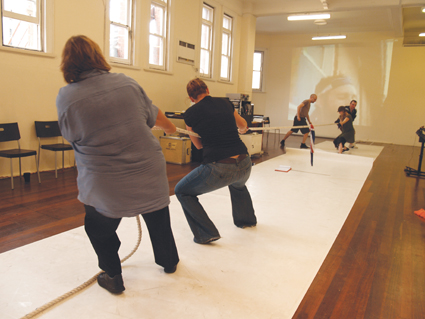
pvi workshopping resist: the right to revolution, CIA Studios
photo Sarah Rowbottam
pvi workshopping resist: the right to revolution, CIA Studios
WALKING AROUND THE RE-PURPOSED CORRIDORS OF THE OLD SCHOOL BUILDING IN NEWCASTLE STREET, YOU GET THE FEELING SOMETHING IS HAPPENING ALMOST BY STEALTH IN PERTH. FROM OUTSIDE, THE BUILDING IS BARELY MARKED; I FIND MY WAY TO A REAR DOOR AND AM LED INTO A SPACIOUS LABYRINTH OF CORRIDORS, OFFICES AND STUDIOS WHERE, HERE AND THERE, RESIDENTS ARE AT WORK. THE CHALK DUST COULD ALMOST STILL BE HANGING IN THE AIR—BUT THE ROOMS ECHO WITH THE SOUNDS OF CONSTRUCTION, EXPERIMENT AND COLLABORATION.
Kelli McCluskey and Steve Bull are co-founders of cia studios, Perth’s burgeoning Centre for Interdisciplinary Arts. They are also core members of tactical media arts group, pvi collective, creator of works including transumer (Sydney Biennale, 2010) and resist—the right to revolution (Awesome Festival, WA, 2009).
R&D is at the core of cia’s brief, with residencies, creative labs, workshops and “mixer nights” enabling interdisciplinary practitioners to develop work and collaborate with others. McCluskey emphasises cia’s focus on the process of making rather than “end product.” What cia does particularly well is provide a fertile environment in which practitioners are directly “informed, invigorated and challenged” rather than working in isolation.
Far from being a glossy government initiative, cia emerged in 2008 via a “window of opportunity.” As founders of pvi collective, Bull and McCluskey knew there was a need to house a growing community of interdisciplinary practitioners and catalyse what was happening in the sector. When WA’s Department of Culture and the Arts provided pvi with a new peppercorn-rent studio space for a year, the collective capitalised on the opportunity that the space provided—developing a two-year business case for cia studios as a co-located entity and requesting seed funding.
“To our complete amazement the department agreed,” says McCluskey, “and provided us with start-up funds as well as key strategic advice…Essentially what they were saying was, start small, find our feet with it and establish support from within the community.”
Having previously served as WAAPA’s production and lighting department, the old school building comes blessed with three-phase power, a sound recording studio and capacious rooms, including mezzanine spaces that allow discreet audience viewing. Long term resident company Hydra Poesis utilises a range of spaces for various projects: in the past year it has produced a durational performance installation, Trademark Manoeuvres #1 with collaborator Aimee Smith (also a cia resident), the performance work Personal Political Physical Challenge (PICA, 2010, see article), a short film for Next Wave and major R&D for its WATDI-funded hybrid work, Prompter Live Studio (RT97).
Hydra Poesis director Sam Fox says cia allows “multiple things on the boil” without the “logistical nightmare” of finding rehearsal, meeting and storage space. The collaborative and peer relationships that develop within cia—“our work connects through a criticality and political consciousness”—are also a reason to hang around. Fox would like to see funding for more intensive collaboration between current and incoming residents, “where we exchange practice, set each other experiments and really capitalise on the connections that are here but limited by time and resources.”
Project manager Kate Neylon outlines cia’s model for “research/practice interrogators,” something cia would like to implement for all residencies. “We would allocate resources towards securing a senior practitioner to work with resident artists, via key Skype sessions, providing input, guidance and provocations that would stimulate that process and expand professional networks internationally.”
“[pvi has] had a few pilot runs of this with ourselves as guinea pigs, first as research interrogators for an emerging artist test lab at cia with Meredith Godley and also with Matt Adams from Blast Theory (UK) working with us on developing our current project, transumer. Hydra Poesis have also used the model to bring out a member of the renowned UK performance group Pacitti company, Dicky Eaton, to work with them on Prompter Live Studio.”
Under the name ololo, “three like-minded friends” share cia’s studio 5 with local cyberpunk Jerrem Lynch, a driving force behind their work with interactive technologies. ololo has been researching hardware and software based systems for performance and installation works, including multi-touch surfaces. “It’s been the first time we have had freedom to explore ideas that were too big to fit on our kitchen tables,” says ololo’s Steve Berrick. Other residents include performer Aimee Smith, currently heading north to participate in The Arctic Circle international creative residency, and performance and image maker Jen Jamieson.
And then there’s pvi collective, now creating a companion to transumer with the working title, the coming insurrection. Like transumer, it aims to ‘fuck it up’, creating on-site interventions to suggest what an “anti-consumerist uprising” might look like. Bull, McCluskey and Neylon cite practical, strategic and catalytic ways that pvi’s interdependency with cia works for them as a group. Bull: “we are able to activate the space from within.” Neylon: “we get space for our practice” (and a small but consistent source of operational income for pvi). McCluskey: “It’s allowed the company to grow in ways that we never expected…it’s inspired, driven and motivated us to keep on truckin’”.
Current challenges for cia include, says Neylon, gaining some studio ‘down time’ and dealing with the organisation’s reliance on funding cycles while trying to sustain an ongoing program. Nevertheless, the next 12 months will include expanded activities including management of a live art season at PICA (hopefully with concurrent residencies at cia by some of those artists) and an expansion of artist talks, work-in-progress showings and collaborations. If funding is secured, says Bull, cia will bring UK performance company Reckless Sleepers to Perth for a creative lab late in 2011.
Bull is ambitious about where cia could go in the longer term: “If all goes to plan—and we are aware a lot could fuck up on the way—we hope cia will become for live and interdisciplinary arts what Perth-based SymbioticA has become for the bio-arts sector internationally. SymbioticA is the place to go for applied research into the life sciences and attracts artists from all over the world to partake of a range of practice-based opportunities. The interdisciplinary sector needs this sort of initiative to spearhead experimentation and look to define an area of practice that’s constantly slippery to pin down.”
In early October, cia studios will be calling for applications for residencies March 7, 2011-February 28, 2012.
cia studios, 480 Newcastle Street, West Perth, ciastudios.com.au
RealTime issue #99 Oct-Nov 2010 pg. 36
© Urszula Dawkins; for permission to reproduce apply to realtime@realtimearts.net
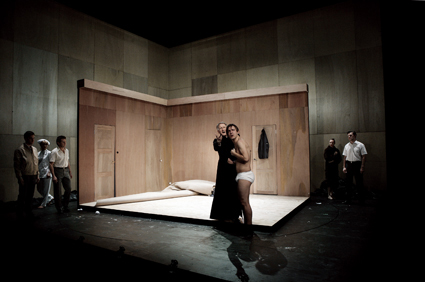
The Trial
photo Jeff Busby
The Trial
‘KAFKA’ IS ONE OF THEATRE’S OWN NEUROSES; A SCENE COMPULSIVELY RETURNED TO BUT WHOSE PLAYING OUT NEVER ACHIEVES RESOLUTION. THE AUTHOR’S WORK IS FAMOUSLY UNFINISHED IN VARIOUS SENSES, FROM THE POSTHUMOUSLY PUBLISHED NOVELS ASSEMBLED FROM MANUSCRIPTS TO THE OPEN-ENDED MEANINGS SUGGESTED BY THE WORKS THEMSELVES. BUT THERE’S ANOTHER UNFINISHEDNESS TO KAFKA—TO GET THEM RIGHT IS TO GET THEM WRONG, AND VICE VERSA. KAFKA CAN’T TRULY BE TRANSLATED TO THE STAGE, WHICH IS WHY SO MANY ENDLESSLY ATTEMPT TO DO JUST THAT.
Nabokov’s assertion that “one cannot read a book: one can only reread it” is apposite here. Were a production of The Trial to really nail it, the potency of the novel would be nullified. Perhaps the enduring appeal of Kafka’s writing stems not from its status as a glorious achievement, but as a kind of wound—the theatrical adaptations that most intrigue are those that pick at the scab rather than cauterising the wound.
Which is a roundabout way of approaching Matthew Lutton’s take on The Trial, which certainly seemed to pluck at the sutures rather than applying any salve. It wasn’t a satisfying work, but in thinking about that I increasingly wondered what such a thing would look like. Kafka’s literary worlds are anxious, paranoid ones tiptoeing the blade’s edge between self and other and frequently losing their footing. They are endless, circular, self-annihilating and uneven. They shouldn’t make for a particularly fine night at the theatre.
In some ways The Trial felt like the work of a young director approaching a canonical text: it appeared a surface rendering lacking a thorough engagement with its source while struggling to produce its own, original vision against the grain of the original. The thickly ironic comedy became farce; the sinister sexuality mere posturing; the infinite narrowing of Josef K’s agency was diminished by the set which confined him from the outset.
Most disappointing, for me, was the intrusion of more contemporary surrealist imagery onto a work that could only crudely be aligned with the modalities of surrealism. The films of David Lynch were an obvious reference, from the curtain design to a soundtrack song taken from one of Lynch’s own films. These were problematic allusions, since Lynch’s aesthetic is of a different paradigm to Kafka’s—like confusing Jung and Freud or Camus and Sartre.
But Lutton, while relatively young, isn’t a young director—his resume is both deep and reckonable and to dismiss his work here as that of a neophyte is an easy way of avoiding having to really become involved with it. If some of his directorial choices seemed superficial, it’s worth considering the dialogue between depth and surface that continues to characterise much of the work of his peers and mentors.
It’s a cliché to state that theatre is a collaborative medium. I think it’s usually true to say, however, that no one agent can bring low a superlative work of theatre, just as no star can make a mediocre work shine. In reality, it’s rare that any production doesn’t canvas a spectrum of success, and that’s not even factoring in the interpretative diversity of its audience.
Ewen Leslie’s K suffers from a common disregard for the specificity of the character. Too often Kafka’s protagonists are figured as beleaguered Everymen when each possesses a particular voice, often hysterically rendered. Josef K isn’t merely an icon of the average soul dumped in an absurd situation, but is marked by a comic indignation lacking in Leslie’s accounting.
So too do the rest of the cast veer toward caricature rather than complexity. There’s little evocation of the terrifying strangeness behind the face of a neighbour, since all are figured as sideshow clowns from the get-go. The only element of this production which really achieves a rich and unsettling density is the superb sound design and composition (by Kelly Ryall and Ash Gibson Greig, respectively). Half-heard voices and other aural pinpricks floated around partial melodies, suggesting a troubling presence that could never finally be located.
I think that any niggling complaints about this rendering should be balanced, however, by the broader view. Nabokov’s point, in his call for rereading, is that narrative is a time-based thing, and that we can never perceive it as a whole. When we are at the end, we can no longer understand the beginning as beginning. After each pass, we rewrite what came before, and the lasting works of art are those that find some niggling grounds for appeal each time we threaten to deliver a final judgement. This is why a definitive rendition of The Trial would be self-defeating, why this production still maintains a certain necessity. It’s a cruel process, as Josef K’s bleak scenario suggests, but the alternative—for the character or the text—is arguably worse.
Malthouse Theatre & Sydney Theatre Company, The Trial, adaptation Louise Fox from the novel by Franz Kafka, director Matthew Lutton, performers John Gaden, Peter Houghton, Rita Kalnejais, Ewen Leslie, Belinda McClory, Hamish Michael, Igor Sas, set design Claude Marcos, costumes by Alice Babidge, lighting Paul Jackson, composer Ash Gibson Greig, sound design Kelly Ryall; Merlyn Theatre, CUB Malthouse Aug 13 – Sept 4.
RealTime issue #99 Oct-Nov 2010 pg. 37
© John Bailey; for permission to reproduce apply to realtime@realtimearts.net
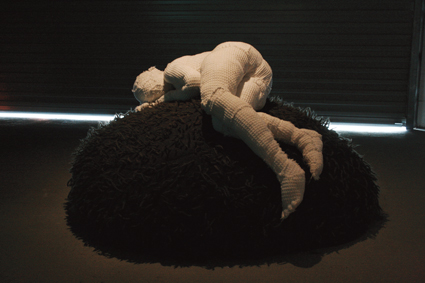
(please give: it a moment), detail of installation at Wallwork Studios
2010 courtesy of the artists
(please give: it a moment), detail of installation at Wallwork Studios
NOW IN ITS SIXTH YEAR, THE ON EDGE FESTIVAL IN CAIRNS IS INSTRUMENTAL IN INTRODUCING NEW WORKS TO NEW AUDIENCES IN FAR NOTHERN QUEENSLAND. THIS YEAR’S PROGRAM, CURATED BY NICHOLAS MILLS, INCLUDED SOUND ART (LIQUID ARCHITECTURE), VIDEO ART (CAO FEI) AND DANCE ON SCREEN (REELDANCE) AS WELL AS PERFORMANCE WORKS. THREE OF THE PERFORMANCE HIGHLIGHTS WERE ELIZABETH DUNN AND JESSIE HALL’S (PLEASE GIVE: IT A MOMENT), POST’S SHAMELESSLY GLITZY WORK AND NICHOLAS MILLS’ OWN 2WHYTE. FOR ME, EACH OF THESE WORKS HAD A REFLECTIVE QUALITY AND MINED THE INNER WORLD OF THE SUBJECT FOR MATERIAL.
(please give: it a moment)
Wallwork Studios has been transformed into an interactive obstacle course. As I enter, I am handed a conical mask with hand-drawn features, suggestive of a shy creature that spends a lot of time in the dark. Wearing this makes me feel as though maybe I too will find a bolthole in which to hide. This is (please give: it a moment), where each audience member becomes the work’s subject via their physical engagement with it. Created by Cairns artists Elizabeth Dunn and Jessie Hall, it is fresh from the Next Wave festival in Melbourne.
Other masked creatures inhabit the space. We are guided past fabric mounds and along the way encounter a larger crafted hillock where a life-sized figure made from wool curls like a cat in repose. We move on to a table where we are invited to partake of a conversation conducted entirely via pen and paper. Tea is offered, along with written advice and the messages then affixed to the studio wall—as a sort of ‘moodboard’ of the soul. It’s tea and sympathy and the writing is on the wall.
We are then gently coerced into a cubby constructed of translucent paper, with moving images projected on the back wall. These are landscapes, seemingly shot at twilight from the window of a moving vehicle. By now, I am overtaken by the persona of the mask; I become a kind of hybrid creature that scratches at the door of both human and animal worlds, and it seems that I am viewing these images through new eyes. They offer up a whole new world of opportunities, should I find the courage to step over the threshold of my hidey-hole and venture into the beyond.
(please give: it a moment) is a refreshing take on the interactive installation form, where participants experience a nuanced and subtle trip through the psyche, like animals being coaxed from a subterranean burrow.
shamelessly glitzy work
This offering from Sydney’s Post has had rapturous receptions in Sydney, Melbourne and Brisbane, so it was a sweet treat to see it in Cairns. The piece itself, however, was not without some deliciously tart satire. To open, three sparkly, spangled magicians tease us for an extended time at the microphone with inhalations, lip smacking and inane smiles. What follows is a series of faux magic routines where the performers build up our expectations for the big showstopper to reveal…well that the performer is wearing a patchwork jumper identical to the one she has just removed. The performer gestures “Ta-da!” all the while looking at us knowingly.
As the show progresses, there is a meditation on the rave scene replete with glitter in the laser lights and an account of an incident outside a nightclub where a woman, a self-described melange of Bonne Bell, Maybelline and feminine hygiene spray, considers an offer from a potential suitor. She tells us, “Guys in Barinas have yelled at me before, but this was different.” There are ruminations on contemporary security policies too, where nameless organisations reminiscent of George Orwell’s Thought Police encroach on civil liberties. The performers describe a quasi Big Brother state where the control of one’s mind and fast food choices—“I’ve got the fish burger in my hand, but I really wanted a chicken burger”—rate as equallyserious social concern.
The centrepiece of the show is a vignette where the performers bounce for over 10 minutes to techno music while one boozily bawls “C’mon ladies!” This slowly turns into a wet t-shirt competition and then something more sinister where blood pours from mouths of the ‘contestants.’ This act is chilling in its evocation of sexual objectification and abuse, reinforcing the idea of performance as a political act that can both challenge and reassert structures of power.
The writing is a revelation in a formal sense; all that is said in the first half of the show is repeated in the reverse order in the second. As well, the characters constantly allude to the audience’s presence through eye contact and gesture. This staginess, or self-conscious awareness of what Peggy Phelan calls performance’s “maniacally charged present” (Unmarked, Routledge, 1993), is echoed in the performers’ oft-repeated line: “I definitely feel something.” I felt something too, Post, and even if you were being ironic you were generous enough to let us in on the joke.
2Whyte
2Whyte was held on the last weekend of the festival and is best described as a work in progress. It has an interesting premise, with Nicholas Mills bringing together two established dancers with the same surname but from very different disciplines. Raymond D Blanco is a prominent Indigenous dancer, choreographer and director who has been at the forefront of Indigenous dance and its development, while Raphael Blanco is a 76 year old Cuban dancer and teacher and reportedly one of the first Cuban immigrants to arrive in Australia. Together they bop, boogie and cha cha cha their way through the show, finding common ground through dance.
As the houselights dim we are shown projected text, first about the history of Cuba and then Australia and the Torres Strait. The source cited is Wikipedia and I’m not sure if the team are being ironic or simply relaxed in respect to their research. Next there is a demonstration of Cuban dance moves, projected documentary-style footage and live onstage interviews with the dancers, interspersed with examples from Raymond’s repertoire. His evident joy in performing to Silver Convention’s Lady Bump (presumably a favourite from his formative years) is so infectious that we find ourselves bopping along in our chairs.
One audience member described this work as “docu-dance” and it shone when we were able to glimpse the dancers’ psyches. Each grappled in their own way with the notion of being categorised as an ‘older dancer’ and the significance of this for their careers resonated with the sympathetic audience. Perhaps the work would benefit from a little more finessing and teasing out further synergies, however, the performers held us with their charm and zeal.
Like the individual performances within it, the On Edge festival offers fascinating insights into the interior worlds of artists and audiences alike. The festival makes a valuable contribution to the far northern landscape and its arts community with its celebration of contemporary performance and media works from all over Australia and the world.
2010 On Edge Festival: (please give: it a moment), creators Elizabeth Dunn and Jessie Hall, Wallwork Studios, July 4-7; post, Shamelessly Glitzy Work, created and performed by Mish Grigor, Natalie Rose and Zoe Coombs Marr, COCA Theatre, July 8-9; 2Whyte, director and media Nicholas Mills, performers Raymond D. Blanco and Raphael Blanco, COCA Theatre July 15-17; www.onedgeart.com/
RealTime issue #99 Oct-Nov 2010 pg. 38
© Victoria Carless; for permission to reproduce apply to realtime@realtimearts.net
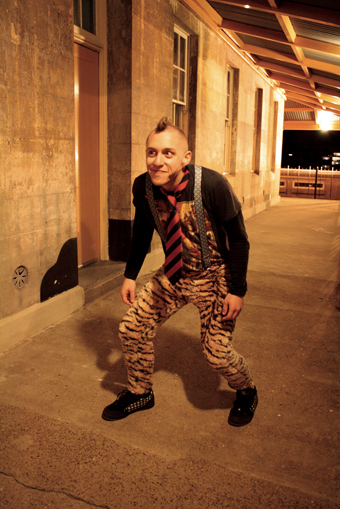
Dean Johnson, Dreams of a Forgotten City
photo Justine Potter
Dean Johnson, Dreams of a Forgotten City
IF NEWCASTLE IS A SORT OF FORGOTTEN CITY—LARGE BUT NOT THAT LARGE, NOT A STATE CAPITAL, AND A SAFE LABOR SEAT SO RARELY THE RECIPIENT OF EITHER STATE OR FEDERAL BRIBES—THEN FORT SCRATCHLEY IS A SORT OF FORGOTTEN CITY WITHIN A FORGOTTEN CITY. BUILT IN 1892 ON A HEADLAND THE AWABAKAL PEOPLE CALL TAHLBIHN, THE FORT’S MOST FAMOUS MOMENT CAME IN 1942, WHEN ITS GUNNERS REPELLED A JAPANESE SUBMARINE THAT ATTACKED NEWCASTLE. SIXTY-EIGHT YEARS LATER IT IS THE SCENE OF SCHOOL EXCURSIONS, THE OCCASIONAL WEDDING AND, TONIGHT, TANTRUM THEATRE’S LATEST PRODUCTION.
Dreams of a Forgotten City proceeds in three parts. To begin with we are split into seven groups of seven, each group and its guide starting at a different point within the walking tour. Our group starts by stumbling upon a young man slumped in a doorway. He asks if we have the time—his watch has broken and as his monologue proceeds it becomes clear that his heart has too, waiting for a sweetheart who might not be coming back. There is another lone man in the marshalling yard, shouting commands and marching. For a moment he reads as a soldier, surrounded by a company of ghosts, then it seems as if he himself is the ghost, then as he continues his increasingly demented march, it is as if we the audience are the ghosts—privy to some sort of secret ritual.
There are plenty of secrets in this space; indeed there are plenty of secret spaces. Standing around the barracks we watch through the windows as a performer enters a room, dances and then seems to disappear. I get a huge fright when he sneaks up behind me and an even bigger one when I realise that there is another group of spectators standing behind him, watching me watching. Later, we find ourselves in their position, enjoying a moment of meta-spectatorship. Further up the hill, a girl in purple taffeta tells us “it seems that we have met before, and laughed before and loved before.” She repeats her actions and movements but in silence; she too seems to be waiting for someone.
The second section starts in the marshalling yard, where we are ordered to split into slightly larger groups. Highlights of this section include a scene on a wooden bridge, under which a small girl and boy are hiding. The performers post messages on scraps of paper between the planks, which spectators read aloud. It is a series of love letters, but alas love is not to be as a woman walks out from under the bridge and away from her childhood sweetheart. (There are perhaps too many whimsical lovers in the piece, as if this were the only type of history to emerge from war.)
In part three, we reassemble in the yard, forming in different groups again (it is starting to feel strangely like school). One of the most satisfying moments of the performance comes when we watch the man who was marching alone woo the girl in purple taffeta. The song “Where or when” in the background includes the lines she was rehearsing earlier and as it ends he presents her with his fob watch. Finally we reconvene in the yard, with the audience around the edge and the performers on a small hill on the other side. One performer sings “We’ll Meet Again” before they walk across the yard to thank us as the evening ends.
There are some lovely moments in Dreams of a Forgotten City, especially as the scenes start to overlap and connect, but there is too much waiting in between. Of course, some waiting is inevitable in a site-specific performance that involves huge logistics. However, the work loses momentum and the audience patience as they stand in the cold wind, waiting—yet again—for the group in front to finish viewing a particular section. Nevertheless, there are some strong performances and the cast of nine feels like a cast of thousands, effectively portraying soldiers, lovers, fathers, mothers and ghosts.
Dreams of a Forgotten City is Tantrum’s latest site-specific work (see my review of The Hour We Knew Nothing of Each Other, RT95, pg10) and the company continues to investigate the intersection of place, space, story and performance. Dreams allows us to rediscover Fort Scratchley—to peer through its windows, nestle in its nooks and crannies and re-imagine its many histories. Most satisfyingly of all, the performance itself is now a part of this history—a dream within a dream about a city within a city.
Tantrum Theatre, Dreams of a Forgotten City, director Brendan O’Connell, dramaturg Rachel Jackett, performers Florence Barrett, Liam Bird, Dean Blackford, Mitchell Bourke, Ben Freeman, Dean Johnson, Kate Neilson, Jasmine Skye Payne, Stephanie Priest; Fort Scratchley, Newcastle, Aug 18-21
RealTime issue #99 Oct-Nov 2010 pg. 39
© Caroline Wake; for permission to reproduce apply to realtime@realtimearts.net
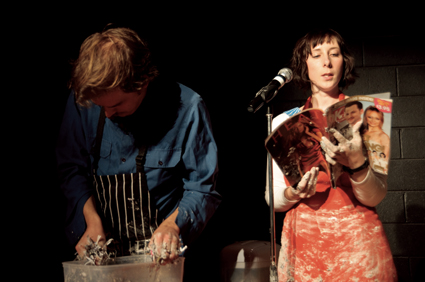
Malcolm Whittaker and Laura Caesar, Starfuckers
photo Lucy Parakhina
Malcolm Whittaker and Laura Caesar, Starfuckers
FOLLOWING IN THE TRADITION OF FAMOUS ARTIST COUPLES SUCH AS MARINA ABRAMOVIC AND ULAY, PERFORMANCE MAKER MALCOLM WHITTAKER AND HIS PARTNER LAURA CAESAR, BILLED AS A “PRIMARY SCHOOL TEACHER AND ARTS AND CRAFTS ENTHUSIAST,” DEVELOPED AND PERFORMED THE DURATIONAL PERFORMANCE STARFUCKERS. WHITTAKER AND CAESAR’S SUBURBAN NARRATIVE LANDSCAPES OFFER A SIGNIFICANTLY MORE INTIMATE IF LOWER-KEY PERFORMANCE TO ABRAMOVIC AND ULAY’S BREAK-UP EVENT, GREAT WALL WALK (1989).
One at a time, our partners in love and art step up to a microphone and read out a story. Some are diary entries written during the making of the project, and some are personal relationship memories. Each of these stories has been printed out and inserted into a magazine—Woman’s Weekly, Who, New Idea—torn out after they have been read and put immediately through a shredder. At the other end of the room, the detritus of these pedestrian love stories with their glossy celebrity underlay is transformed into papier-mache, moulded into figurines and baked in a small oven. Wearing aprons, the performers take turns to read, share and deliver the shreddings to be glue-soaked and flour-covered, shaped, baked and finally displayed in an ever-multiplying tableau across a long red-covered table. The small studio seems overly warm, filled with the crisp smell of baking paper, and over the hours a small army of tiny figures—effigies of the performers themselves?—gradually populates the long central table, filling up the space previously occupied by language alone.
Over the three hours of the performance, these accumulations form a strangely unsentimental love-crafting, the product of an idiosyncratic confessional cottage industry. Against the saccharine celebrity romance sagas of the gossip magazines, Caesar and Whittaker insert their more prosaic relationship perspectives, and do so in a gently self-deprecating way. As they note: “We hope we are interesting enough, beautiful enough, enough of enough.”
Whittaker first met Caesar when she took pity on him while he was tied to a tree at a scout camp, the victim of some gleefully cruel practical joke. It was clearly destiny, of a kind. An image of George Clooney’s face is shredded after Caesar details her perspective on a night in which the couple stayed at the apartment of a meth-smoking stranger “with crazy eyes.” In Whittaker’s version of events, everything was fine, no one was ever in danger and sleeping on the floor of a stranger whom the couple only met that evening was a perfectly normal thing to do. In Caesar’s story, she doesn’t sleep a wink, remaining alert and highly alarmed. Whittaker was tired, so he slept, and everything ended up alright, and so from his perspective there never was any problem.
Rarely do the lovers offer the same perspective on any given event, and the process of this diarising itself inflects the relationship. “I worry that my art practice is interfering with my personal life,” states Whittaker, observing ruefully that perhaps their almost non-existent sex life at the time of writing was due to the fact that Caesar doesn’t wish sexual intercourse to appear in their journal. At another moment, Caesar reads an entry in which she informs Whittaker that her current course of antibiotics makes her contraceptive pill ineffective, meaning that there won’t be any sex unless he buys “something else.” But he won’t. They both know and accept that he is just too cheap.
Our lovers tell their audience of perceived petty grievances, anxieties and affections. All of the stories provoke moments of recognition—I’ve been to these places before, though (I tell myself hopefully) not with quite Whittaker’s often-uncomfortable level of too-honest hubris. The diary entries and other writings detail uncertainties, mild confusions, potential infidelities and a great many misunderstandings. Despite these regular romantic imperfections, our lovers map out their past and gently imagine a shared future, even if its exact terms might always remain a point of contention.
Starfuckers is a product of Merrigong Theatre Company’s new Independent Producers Program, a welcome initiative recognising the growing number of significantly promising contemporary performance makers currently emerging through the University of Wollongong’s performing arts course, of which Whittaker is a graduate. I hope that this program continues to offer opportunities to facilitate such deeply engaging experiments as Starfuckers.
Starfuckers, creators, performers Laura Caesar, Malcolm Whittaker, Merrigong Theatre Company Independent Producers Program, Bob Peet Studio, Illawarra Performing Arts Centre, July 23-24
RealTime issue #99 Oct-Nov 2010 pg. 40
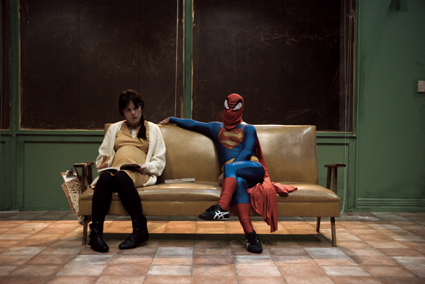
Jo Stone, Paolo Castro, Superheroes
photo by RODEO
Jo Stone, Paolo Castro, Superheroes
THE CHARACTERS OF STONE/CASTRO’S SUPERHEROES ARE RESIDENTS IN A REST HOME—A KIND OF REHABILITATION FACILITY FOR THE YOUNG AND THE RESTLESS. THE WALLS OF THE FACILITY ARE PAINTED AN INSTITUTIONAL SHADE OF GREEN. THE LIGHTING IS SUPPLIED BY BRIGHT FLUORESCENT STRIPS. THE RESIDENTS ARE SHIELDED FROM THE OUTSIDE BY A SUITE OF VENETIAN BLINDS HUNG AGAINST PLATE GLASS. BY THE SET’S IMPLICATION, THE AUDIENCE IS ALSO ON THE INSIDE. WE ARE RESTING TOO. THROUGH THE WINDOWS LIES THE WORLD BEYOND—AT WAR.
Occasional nationalisms drift through this work like warped memories from another time and place. A male nurse plays air guitar as if protesting Jimi Hendrix’s mind-bending rendition of “The Star-Spangled Banner.” But the pride of upright posturing is long dispersed. The residents hang their heads and turn their backs on us. They slouch disconsolately on plastic chairs, and fall short of distracting each other with their paranoid suspicions, their rants of boredom and mistrust. Mail from the world outside is delivered to the home, but the prospect of a missive fails to arouse. At least the parcel is not a bomb. One resident is reading Graeme Alford’s Never Give Up, but he too struggles to retrieve much motivation from the prose. The other residents want toast—to eat. They are adamant about that.
In the midst of their exhaustion, Superman (Paolo Castro) arrives from China, a dress-up super hero flying into the scene on an electric wheelchair. Temporarily energised, two other residents also dress in Superman costumes. But, despite their capers, we somehow know that none of them will save the day. Spiderman makes a cameo appearance, and Wonder Woman’s gestures of transformation are briefly referenced. These superheroes are really just distractions, serving to divert attention from the tedium but failing to relieve the trauma.
Beyond the comforts of the rest home, the war is raging on. The residents sing “God Save Our Queen” with flagging enthusiasm. They aimlessly fold sheets of paper into aeroplanes, and just as lamely send them flying—across the room and outside to a lone soldier in the desert amidst potted palms. Computer game-style animated graphics of armoured tanks and shells exploding are splattered on the back wall, accompanied by earth-rumbling sound effects. Like the residents of the rest home, we watch the violence at a distance from behind the panes of glass.
The residents are mostly men—actors Julian Crotti, Nick Bennet and Hew Parham perform with dancers Lewis Rankin and Nigel Major-Henderson. Only one resident is a woman, played by actor and director Jo Stone. She is pregnant, visibly so. But she doesn’t want to bring her son into this world—at least not while Superman is inside sleeping as the explosions of the war reverberate outside. That this lonely woman, dressed in yellow, already intuitively knows her baby’s gender is a tacit signal of the work’s religiosity.
More explicit on this aspect is the mother’s cradling of the dying soldier, an enactment of the Pietà. No tears of lamentation in this production, but the loss of religion—or rather, the loss of coherence in religious belief—is keenly felt. Stone writes in the program of her doubts and fears: “Our ideals define the landscape of the world our children will inherit, and I fear our ideals are so brutally disconnected from each other that the future landscape seems to me very bleak.”
Another key to the anxieties animated in this work is a speech in which a resident confesses to his shame that his penis is a source of laughter for other men in the showers. It is a speech of protest against the impotence of war: his struggle to assert his masculinity through stand-up tricks amidst the exhaustion of the rest home. In the end, he fails. There is a lot of smoke, but there isn’t any fire. The residents’ commitment to the regime of the rest home is secured with the conformity of an exercise routine.
Superheroes is reflective, contemplative theatre. Its violent prospects are displaced. The work is scripted by Paolo Castro, who in performance also provides an energetic anchor for the ensemble. The meanings of the words resonate on stage with images and actions, but the intensity of their expression isn’t always handled evenly by the cast. Some have worked before with Stone and Castro, and this production suggests the promise of an ensemble practice.
Stone/Castro & Adelaide Festival Centre inSPACE Program, Superheroes, director Jo Stone, writer, dramaturg Paulo Castro, performers Julian Crotti, Nick Bennett, Lewis Rankin, Jo Stone, Paulo Castro, Hew Parham, set design Wendy Todd, lighting Kerry Ireland, video Nic Mollison, sound Sascha Budimski, Space Theatre, Adelaide Festival Theatre, July 2-24
RealTime issue #99 Oct-Nov 2010 pg. 42
© Jonathan Bollen; for permission to reproduce apply to realtime@realtimearts.net
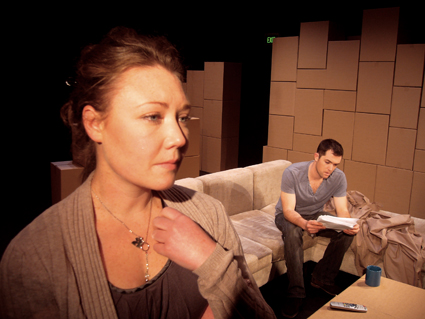
Zoe Ellerton-Ashley, Brad Williams, Dying City
photo Tim Williamson
Zoe Ellerton-Ashley, Brad Williams, Dying City
ONE OF THE AXIOMS BY WHICH WE SITUATE A WORK OF ART IN RELATION TO OUR WORLD IS ITS ATTITUDE TOWARD DEATH. THIS ISN’T RESTRICTED TO GENRE—A COMEDY THAT NEVER EXPLICITLY ADDRESSES MORTALITY CAN STILL CONVEY A MORE ‘SERIOUS’ UNDERSTANDING OF DEATH THAN A DRAMA WHICH MAKES IT AN OVERT SUBJECT. BUT, PERHAPS UNCONSCIOUSLY, THIS ATTITUDE IS A FRAME THROUGH WHICH WE DEFINE FOR OURSELVES WHAT IT IS WE ARE APPROACHING.
Two independent productions which recently played Melbourne put this notion into relief. Do Not Go Gentle… was the first full production of a remarkable play by Patricia Cornelius which had been circulating for half a decade. It was a risky work, perhaps too dangerous for the mainstage, which was eventually mounted by a solid cadre of theatre professionals working outside the usual channels (and special commendation should go to venue and producing partner fortyfivedownstairs, who provided much support for the premier production).
Part of the threat of Do Not Go Gentle… is the presence of death in its very fibre. It features a roster of characters who are almost all in their 80s, and the nearing horizon of finality cannot but be recognised in every moment. At the same time, the work itself is less interested in death per se than in grieving at life—at lives wasted or unrealised. It takes a brave writer to create thoroughly original characters in their twilight years whose sadness is not evoked by referring to their impending passing but through a distressing depiction of the regret than can take hold—that age needn’t beget wisdom or understanding or even acceptance.
Christopher Shinn’s Dying City takes a less nuanced position, as may be apparent from its title. Death is again a constant here but figures as presence rather than absence. A woman entombed in her New York apartment after the suicide of her husband in Iraq is visited by his identical twin brother; in between their exchanges we are provided flashbacks to her life with the dead man. It’s one of theatre’s most enduring dynamics— establishing a fictional death in order to magically reverse it. In Shinn’s play, however, this attempt at producing pathos through reference to death is partially undermined by the perpetual presence of the dead figure or his simulacrum. Even when his widow is alone, the other’s arrival seems imminent.
The shortcomings of Shinn’s text were more than compensated for by the two performances—Zoe Ellerton-Ashley proved once again that she is a formidable addition to Melbourne’s stages and Brad Williams simply astonishing in his ability to play the brothers (I wasn’t the only attendee to wonder if real twins had been cast). It’s one of those rare occasions when a production was worth catching purely on the strength of its actors—and, certainly, I’ll be looking for more from this pair.
Do Not Go Gentle…, writer Patricia Cornelius, director Julian Meyrick, performers Paul English, Jan Friedl, Rhys McConnochie, Terry Norris, Anne Phelan, Pamela Rabe, Malcolm Robertson, design Marg Howell, music & sound design Irine Vela, lighting Richard Vabre, fortyfivedownstairs, Melbourne, Aug 6-29
Dying City, writer Christopher Shinn, director Matt Scholten, performers Zoe Ellerton-Ashley and Brad Williams, designer Kat Chan, lighting Tom Willis, music Ben Keene, Hoy Polloy, MIPAC, Brunswick,August 6-21
RealTime issue #99 Oct-Nov 2010 pg. 42
© John Bailey; for permission to reproduce apply to realtime@realtimearts.net
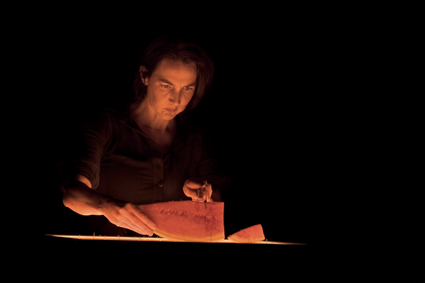
Tamara Saulwick, Pin Drop
photo Ponch Hawkes
Tamara Saulwick, Pin Drop
THE NORTH MELBOURNE TOWN HALL IS A STATELY EXAMPLE OF CLASSICAL VICTORIAN ERA ARCHITECTURE. IT MAKES SENSE THEN THAT PERFORMER TAMARA SAULWICK SHOULD COMMAND ATTENTION CENTRESTAGE WHILE INTERACTING WITH THE RECORDED VOICE OF AN ELDERLY WOMAN—ONE WHO MAY HAVE ONCE HUNG HER SHAWL ACROSS A BALUSTRADE WHILE DANCING WITH HER BEAU IN THE BUILDING’S GRAND HALL. BUT MORE LIKE THE OLD MOB-CONNECTED VICTORIA MARKET, STILL CONSORTING JUST AROUND THE CORNER, SAULWICK, INSTEAD, HAS FEAR ON HER MIND.
While listening to the elderly woman’s croaky recollections, Saulwick simultaneously relates a tale directly to the audience. Both stories are characterised by a general sense of disquiet. But it remains difficult to ascertain exactly the detail of each, as a circumlocutory speaker system situated above, behind and to the left and right of the audience, dislocates the content of both narratives. When the two tales collide, however, Saulwick’s live delivery splinters the elderly woman’s sonic representation, and the latter’s recorded voice undergoes a sonorous transformation. Tremolo, reverb and other software manipulations reduce the elderly woman’s voice to a singular chant or a sound resembling a repeated monotone emanating from a large gathering.
Meanwhile, Saulwick rises from her chair and advances upstage, situating herself behind a teak display case resting on a stand. As the recorded chant becomes incremental and fills the theatre, the artist tilts her display case up and forward, gradually revealing its contents: a pair of chrome plated scissors, a large plastic syringe, a roll of cellophane tape and a collection of automotive ties secured in a bundle among other objects. Simultaneously, the infiltration of sound that has vibrated throughout the inner ear coalesces into a recognisable phrase, “I did not scream.” The aural, visual, and verbal interplay comprising Pindrop integrates, relaying this and subsequent information precisely to the audience. We have witnessed a descent from the relative security of the actual world into the murk of the unconscious. But whether this descent has occurred within the mind of an unseen elderly woman or is, instead, a journey into the imagined experience of performer Tamara Saulwick, remains unclear.
Several distinctive female voices soon populate the theatre. One tells of the terror associated with receiving an obscene phone call. Another reflects upon its psychological implications—maintaining that fear is a natural human reaction, one that protects individuals in threatening situations. Fragmented and transient, these discharges of strategically placed sound are then subsumed by a coherent, recorded narrative. An apprehensive, upwardly mobile female voice speaks of hearing a suspicious noise in a bedroom of her Darlinghurst apartment. Investigating its source, she opens a wardrobe and out springs an assailant who thrusts her onto a bed where she endures a terrifying moment without end, in which her sense of personal safety is ruptured. The resulting violation then becomes a transitional moment for the performance. Saulwick, wearing a nondescript blue dress and knee high boots, absorbs the prolapse of light and sound, then regurgitates the same recorded tale, but now, as a real time narrative that engages while it disorients.
Interpreted as a commentary upon the mediated exchange, and the ancient tradition of oral storytelling, Pindrop skirts that interminable question: who, or what, is an author? But in spite of Saulwick’s alluring stage presence, some evocative imagery, a sophisticated lighting and sound design, and a movement vocabulary that speculates on the relationship between animate beings and inanimate objects, this fundamental question remains unanswered. Consequently, when the narrative shifts in location yet again, it does not generate empathy. Quite simply, amidst the 12 voices that proliferate throughout, I remain in doubt as to who is actually speaking.
Saulwick’s skill at self-directing in a tech-heavy performance is commendable. But I suspect she neglects some of the basic tenets of dramatic form. Who owns and undertakes the journey in Pindrop, and how does a performer locate within herself the experience of extreme fear, then express it theatrically? A very stylish and ambitious performance, these questions answered will assist in Pindrop’s potential being realised.
Pindrop, creator-performer Tamara Saulwick, sound design Peter Knight, movement Michelle Heaven, lighting design & production Ben Cobham & Frog Peck, costume design Harriet Oxley, Arts House, Future Tense, North Melbourne Town Hall, Aug 25-29.
RealTime issue #99 Oct-Nov 2010 pg. 43
© Tony Reck; for permission to reproduce apply to realtime@realtimearts.net
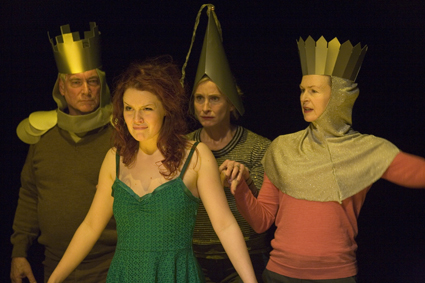
Madeleine
photo Ponch Hawkes
Madeleine
I’VE EXPERIENCED JENNY KEMP’S WORKS AS MORE AKIN TO CONTEMPORARY PERFORMANCE THAN CONVENTIONAL THEATRE IN THAT THEY DON’T CONFORM TO THE CONSTRAINTS OF PLAYWRITING (WHICH CAN AND DO GENERATE GREAT DIVERSITY OF FORM), INSTEAD THEY REALISE AND EXPLORE, WITH GREAT ACUITY AND INTENSITY, STATES OF BEING THAT DISSOLVE TIME AND PLACE WHILE MULTIPLYING AND OVERLAYING PERSONALITIES. IT’S PERHAPS NOT SURPRISING THEN THAT KEMP HAS MOVED ON TO ENGAGING WITH SPECIFIC PATHOLOGIES—BI-POLARITY IN KITTEN AND SCHIZOPHRENIA IN HER LATEST WORK, MADELEINE, FOR MELBOURNE’S ARTS HOUSE AT THE NORTH MELBOURNE TOWN HALL.
madeleine
Of all of Kemp’s creations (save Kitten which I didn’t see; I’m told the extreme state it generated was apparently overwhelming for some), Madeleine is the one that appears to come closest to conventional play making. It unfolds a linear narrative that moves resolutely to a climax, its characters are briskly delineated and their motivations transparent. The dialogue is spare and direct, and largely stripped of Kemp’s usual poetry except at certain key moments of schizophrenic revelation. But, no less than her previous works, Madeleine compels us to enter an unfamiliar state of consciousness. This is achieved with a lean, fable like narrative, stark shifts between two worlds (the real and a schizophrenic’s fantasy), the distressful overlapping of these, a breathtaking central performance and, not least, Kemp and her designers’ scenographic virtuosity.
Kemp, Ben Cobham and Bluebottle create an immersive, light-sculpted, closed circuit of a world governed by a young woman’s fragile state of mind. It’s like looking into a black hole (no-one does black better than Bluebottle). From this emerges a square of light not quite of a standard colour, eerily misty on the edges. Here the woman encounters her family as themselves and then, gliding out of the dark in golden crowns, as a tyrannical royal family. In this, her otherworld, she also hears the voice of a Minister who relentlessly, if unemotionally, tests and instructs her. Before long he speaks to her while she’s with her family, throwing real world conversation even further out of kilter.
The sense of immersion is heightened by 19 year-old Madeleine’s construction of her consuming reality, fusing childhood and adolescent images that draw on fairy tales (a pin prick, a royal family), Through the Looking Glass (“Off with her head!”), mental arithmetic tests (built around the 28 days of the menstrual cycle) and the alphabet (she is planting a real world garden based on the first letters of plant names). But it is religion that makes her world cohere—the Pope, the Bible, the drive to become a Bride of Christ and to create a second Garden of Eden. The fragility of this construction is threatened all too easily—the birthday gift of a purple cardigan cannot be accepted (only the Pope can wear purple) and panic ensues when her father removes blackberry bushes to improve the garden, thus eliminating B.
What is frightening is the insistent way in which Madeleines takes up elements of her family life and weaves it into her fantasy—why is her mother’s name, Madelaine, the same as hers; why does she have her grandmother’s hands—and not her own; how did her two year-old twin drown, is her mother a murderer; why was she born backwards; is her sister Charley the real princess and she an imposter? Unanswered, these questions leave her “just black inside.” Either there is no way they can logically be answered or the subject is off-limits. Denial, in fact, is central to the psychodrama: both parents refuse to acknowledge the seriousness of Madeleine’s condition, the mother ignoring it in favour of her business ambitions, the religious father sheltering his daughter, inadvertently reinforcing the fantasy. The sister, Charley, returned home after three years, has no way of breaking through her sister’s resistance or long-induced parent-child patterns of repression. Only Madeleine moves through and beyond these binds, with terrible consequences, completing herself, re-named with a G as Magdalene, in her Garden of Eden.
Jenny Kemp’s Madeleine is an undidactic attempt to help us understand a mental state, a version of schizophrenia (not a condition reducible to any universal). She achieves this by revealing the inexorable logic of the girl’s fantasising and its result when brutally, but innocently, applied to the real world. Visually the work correspondingly verges on the claustrophobic as we watch Madeleine quiver in the near dark, orgasming to become a Bride of Christ, or later writhing and shuddering, screaming with fear. Nikki Shiels’ Madeleine rapidly alternates between oblivious innocence, tunnel vision determination, hard logic, delirium, panic and fear, all encased in child-like vulnerability and, after all her tests and suffering, certainty. It’s a remarkable performance from an actor in her early 20s.
As the other family members, Ian Scott (father/king), Margaret Mills (mother/queen) and Natasha Herbert (sister/princess) capture the denial and helplessness that is their characters’ sorry lot. Kemp’s warning is that Madeleine’s fantasy world cannot be undone while the family’s world is just another such closed circuit. At the end of the front row, his back to us, Richard Murphet, quietly intones the insistent words of the Minister, his placement implicating the audience as fellow administrators of Madeleine’s world, which is not to forget that the Minister is ‘really’ only ever the agent for Madeleine’s unconscious ventriloquism. The totality of conception and the potent imagery of its realisation make Jenny Kemp’s account of the power of a deeply thwarted and flawed imagination chillingly memorable. It should be seen more widely.
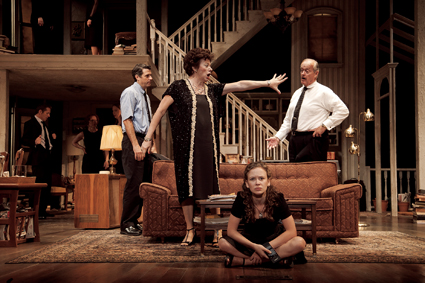
August: Osage County, The Steppenwolf Theatre Company
photo Grant Sparkes-Carroll
August: Osage County, The Steppenwolf Theatre Company
august: osage county
Back in Sydney, another family drama, inevitably familiar, such is family life, but with more hours and words and characters to express every possible aspect of the social form compared with Kemp’s focus on a single if complex state of being. The Steppenwolf Theatre Company from Chicago performed the Tony Award-winning, much travelled August: Osage County (written by company member Tracy Letts) with enormous ease, verve and conviction on a set—a rural family home—you could live in. In terms of performance alone, it was a rivetting experience to see an American ensemble at full stretch, and to admire the sheer dexterity of Letts’ writing. (The plot is too elaborate to spell out here: you can read a precis on Wikipedia.) The surprise was that the play is so funny, especially coming hard on the heels of the STC production of A Long Day’s Journey into Night with which it, and a host of American family dramas, shares a number of characteristics. Ingredients include a central, problematic mother figure, a family reunion to trigger the drama, madness, drugs, an unravelling marriage or two, an almost real time unfolding of events (preferably overnight), a ‘buried child’ or variation on same, and other secrets usually uncovered by the play’s end. The prevailing mood is dark and many home truths are spoken. This replaying of the family in crisis has almost become ritual in its predictability. What Letts does is pretty well include most tropes and add a few more—sexual abuse of a minor, incest and, in an outsider role, a Native American.
It’s the humour, from the mother’s acid wit to her daughters’ constant quipping and the conscious and unconscious comedy of other characters that makes the play different from its predecessors. When it’s undercut or suddenly emptied out it’s as if a safety net has been taken away. But the downside of the writer’s comic impulse is that the play too often, especially in the second act, mutates into something like a sporting match, the audience taking sides, applauding the best jibes and wildly cheering the trouncing of the mother.
The laughter does fade, however, towards the play’s end, when the addicted mother rejects any assistance (she is unwilling to ask for it), her elder daughter leaves and the Native American helper stays on in the now otherwise empty house—having declared she’s only doing the job for herself. It’s a grim account of contemporary America—drugged, divorced, secretive, divided; only a couple of characters seem likely to achieve happiness. But it’s a good old-fashioned play full of sharp-edged wit with contemporary touches and audiences around the world are mightily cheered by it. Competing critics have argued for and against it as either a great play or a grand entertainment, none denying the writer’s skill or the excellence of the performances. With a large cast and several hours of stage time, Letts manages to balance brisk, sometimes furious pace, akin to sitcom, with passages of sustained emotional engagement reminiscent of O’Neill and Williams. It’s an uneasy mix, satisfying but not, and maybe it’s a metaphor for modern America without going near anything directly political, despite the academics and literati among its characters and the largely symbolic role of the Native American.
our town
I was mindful of the dark ending of August: Osage County when I saw Iain Sinclair’s production of Thornton Wilder’s Our Town for the Sydney Theatre Company, faithfully presented on an empty stage, our imaginations worked with words and a mountain of sometimes taxing mime. The lightness and folksiness of the first two acts are unnervingly inverted by the writer into something almost Strindbergian—hopes undone, a failed marriage, lives mourned, a sense of the vastness of the universe making the everyday almost nothing as the dead wait “for the eternal part to come out clear.”
Emily Webb’s painful discovery that she cannot turn back time is the high point of Maeve Dermody’s fine account of the character. Darren Gilshenan as the Stage Manager narrates engagingly, though when the audience laughed at the early line, “Nice town, y’know what I mean?”, which he delivered without irony, my partner recalled Spalding Gray’s account in Monster in a Box (1991) his savagely criticised performance of the same role. He was astonished to be charged with being “snide, flip and condescending.” One critic wrote, “This just goes to prove avant garde actors can’t act.” The rest of his account of what proved to be an enjoyable season is well worth reading. The tragically depressive Gray (subject of a forthcoming feature documentary by Stephen Soderbergh) found the play uplifting. I’m still assimilating its strange vision, but am very pleased to have finally encountered it on stage.
Madeleine, writer, director Jenny Kemp, performers Margaret Mills, Natasha Herbert, Nikki Sheils, Ian Scott, Richard Murphet, dramaturg Richard Murphet, set, lighting design, Bluebottle, Ben Cobham, ArtsHouse & Black Sequin Productions; ArtsHouse, North Melbourne Town Hall, Aug 3-8; Sydney Theatre Company: Steppenwolf Theatre Company, August: Osage County, writer Tracy Letts, director Ann D Shapiro, Sydney Theatre, opened Aug 17; Sydney Theatre Company, Our Town, writer Thornton Wilder, director Iain Sinclair, Drama Theatre, Sydney Opera House, opened Sept 18
RealTime issue #99 Oct-Nov 2010 pg. 46
© Keith Gallasch; for permission to reproduce apply to realtime@realtimearts.net
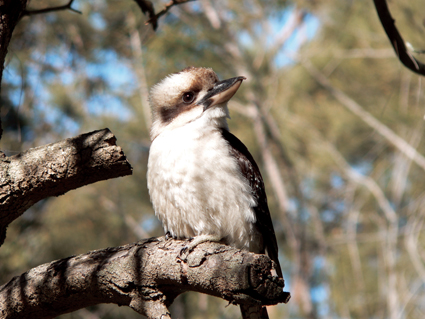
Kookaburra
photo Yurrick (bonehead)
Kookaburra
WHEN JAY ‘JP’ PARRINO COVERED MEN AT WORK’S “DOWN UNDER” ON AUSTRALIA’S GOT TALENT IN LATE 2009, ONE COULD WITNESS CULTURE IMPLODING IN MANY WONDERFUL WAYS. EMPLOYING LIVE SAMPLING TECHNIQUES, HE BUILT UP LAYERS OF ACOUSTIC GUITAR TO CREATE A POVERA DIGITAL IS TYPICAL OF THE CONTEMPORARY BUSKER. WHILE JP’S DEVICES WERE PERCEIVED AS A NOVELTY BY THE SHOW’S AUDIENCE AND JUDGES, HE EMPLOYED THEM AS MEAGRE USER-FRIENDLY TOOLS, NOT AS FLASHY INSTRUMENTS. HIS MODUS OPERANDI WAS TO LITERALLY BUILD A BACKING FOR HIS VOICE AND ACOUSTIC GUITAR ACCOMPANIMENT.
Performing against and with live looping was instigated by Alvin Lucier in the 60s, developed by Robert Fripp in the 70s, spectacularised by the Young Gods in the 80s, matrixed by Jeff Mills in the 90s and deployed with virtuosity by Battles in the 00s. It’s safe to say that live looping is now a given vernacular in the technological production of music. Occurring within a mainstream context like Talent, JP’s use of the process demonstrates well how musical culture is now shaped. He simultaneously deconstructed ‘the song’ (voiced by Men At Work) and aurally constructed ‘a song’ (voiced by JP). The song this man made through his work clearly connected to both live and televisual audiences by virtue of how deftly he collapsed what was his and what was not. In an era wherein media has moved from saturation to atomisation (from the congealment of large forms to the unleashing of fine particles), performances like JP’s populist yet radicalised rendering of “Down Under” demonstrate how musical texts now implode without losing their identity.
In shows like Talent, the surrendering of the performer to his/her performance marks the event as a social communion for those within earshot. As a desultory figure unconverted to the show’s jingoistic narrative, I try to maintain distance from its Red Rooster-like moniker, its flag-waving set design, its pathetically professional panel, its bug-eyed audience, its predictable swells of applause. Yet I cannot deny the power of song, of singing and of an audience enthralled by a singer’s self-surrendering performance. True to the diacritics of folk culture, JP’s version sets up a dialogue with the original Men At Work version, and the two are empowered by a textual link where the songs speak to each other as much as they speak to me as an auditor of their voices and voicings.
Now, those with refined Rock sensibilities have long made sardonic quips about the numerous competitive TV shows based on Pop musical performance (the global franchises of Idol, Talent etc). But might not the predominance of these spectacles of amateur gumption, innocent drive and hysterical dreaming reveal the role song plays in popular culture? Songs are a particularly dialectal form of expression and intercommunication. The simple musicalisation of argot—of whittling a melody out of a popular epigram—is a form of linguistic sonography born of a living, breathing culture. Words are always at a fork in the linguistic road: they can turn one way to be weighted by their written inscription (the rationalist law of the text) or turn the other way and be airborne by their melodic transformation (the transcendent charm of the song). Say something enough times and it will eventually be sung.
mean larrikins
If there is one demographic watching and listening to Australia’s Got Talent on Channel 7, there must be another one watching Spicks And Specks on ABC. And if the former is defined by the supposedly insidious machinations of the Pop industry’s controlling of audiences incapable of articulating their relation to song other than mere consumption, then the other must be inversely defined. Despite being largely ignorant of the fact that the ABC stole the format for their 2005 show from UK Channel 4’s 1996 show Never Mind the Buzzcocks, the Spicks audience is congratulated on their upwardly mobile shift toward knowing when they are being manipulated and when they are not. The format of the show smacks of puerile academicism—uncomfortably echoing the panels first televised in Channel 7’s It’s Academic in the late 60s. Comedians, of course, are used to distract audiences from such irksome fare, but watching wannabe-cool comedians and grinning presenters fall over each other trying to prove their wit constitutes a far more embarrassing performance than the most inept of Talent’s hopefuls.
There are scant fragments in the televisual stream of Spicks that do not stray from the high-versus-low culture ossification which unwisely emboldens the intelligentsia. The trivia format suits the trivialisation of Pop music in general, while the show’s incorporation of local and select overseas touring musicians fluffs up its notion of ‘real/true/roots/indie/non-mainstream/Rock’ musical culture. It’s a show suited to parents who remember their tertiary education via playlists garnered from JJJ. Like everything on ABC TV, the ideological compaction and congestion of its slanted views, adopted poses and supported truisms make it an insult to bother applying any semiotic reading of its monophonic voice.
But a late 2007 “Children’s Music Edition” episode on the show became unintentionally infamous when one question innocently proposed a melodic connection between the 1934 Girl Guides campfire sing-along “Kookaburra” composed by Marion Sinclair, and fragments of the flute interlude in Men At Work’s international number one song from 1981, “Down Under.” Less than two years later in mid-2009, the purported owner of the copyright of Kookaburra—Larrikin Music Publishing—claimed copyright infringement of said property and moved to sue the owners of “Down Under”’s copyright—EMI Music Publishing Australia and co-composers Colin Hay and Ronald Strykert.
A lot of press has since danced a predictable waltz around this case: freedom of speech; money-grabbing lawyers; pop music always ripping-off; denial of technical harmonic quotation; ethical averment of fair usage etc. The intersection of the arts and legality exacts such a tiresome charade of grandiose ethics. This case is not about money, music and ethics. It’s about the forced divide between pop culture and folk culture (in shows like Spicks). It’s about how the two are implosions of the other, how they live off the other, and how their mechanisms are now more than ever shared (as in shows like Talent). And it’s about how the intelligentsia slathers ethical-mongering, political-correctness and proscriptive-nationalism on such a public incursion of national identity crisis (as in the Larrikin vs EMI case), rather than provide contextual, critical insight into the deeper issues which shape these cultural ground swells.
thieving magpies
Like the atomisation which now defines ‘war’ as an asynchronous concatenation of disparate events and locations with no holistic sense of convergence or interconnection, ‘cultural wars’ no longer require metaphors based on Great Wars, where notions of frontlines and avant gardes romantically heroicise how individuals contribute to the shaping of culture. This is ultimately a good thing, for culture—from its conservative models of anthropology to its radicalising models of neurology—is best interpreted as noise of the crowd rather than scripture of an author.
“Down Under”’s para-conscious quipping and cribbing of “Kookaburra” can be viewed semiologically (though not ‘legally’) as a therapeutic retort to having suffered the indoctrination of “Kookaburra” in primary schools, where kids were forced to listen to such songs broadcast on ABC radio through PA systems fixed atop the blackboard in a scenario straight out of George Orwell’s paranoid mind. Am I alone in detesting “Kookaburra” and every single faux-folksy, pseudo-pioneer, colonial-jumbuck, banjo-jangling ditty which the ABC ideologically served up as part ‘children’s music’ and part soft enforcement of a default-leftist, neo-Maoist, pro-Folk, anti-Pop statement of Australiana? Both “Kookaburra” and the Larrikin copyright claim recall an epoch of reclaiming iconography for a dangerously jingoist, post-convict liberation, with Blinky Bill, the Easter Bilby, Cuddlepie and the Southern Cross rebutting overseas imperialism. (Ironically, it was the populist “Down Under”—through its appropriation by Australia II upon winning the America’s Cup in 1983—and not any folksy tune that sung the praise of Australia internationally.)
When Larrikin sued Men At Work, they impressionistically painted their case like the Eureka Stockade, with true blue Australian Folk music battling the corporate ogre EMI. Larrikin—personified by the APRA-lauded aegis of self-appointed Australian folk historian Warren Fahey—has long wheelbarrowed a divisive and separatist notion of Australian Folk music, often intoned as if a local hero is struggling to gain respect for the unsung songsters of white rural colonial history. Yet if Larrikin adopted a modern, diffusive notion of Folk dissemination, they would realise that their battle was long won once Qantas Airlines forced its boarded patrons to suffer a broadcast playlist of semi-acoustic, pub-rockish, sunburnt country Aussie spirit fodder (remarkably similar to the ‘live’ sounds on Spicks). The risible iconography that attempts to monopolise the Australian voice as one big rural campfire round is as ideologically loaded as chants on Cronulla Beach. When Qantas and their corporate brethren of image marketeers broadly assume the cultural validity of such ‘music of the land,’ it suggests that what Larrikin would claim to be Folk is now the most pervasive form of nationalistic Pop.
The word “kookaburra” comes from the Wiradjuri “guuguuburra.” The voice of the kookaburra underwent indigenous and colonial linguistic translations before the Girl Guides claimed kinship with its song via the colonising practice of western diatonic harmony. While Larrikin attempts to grandstand a mean-spirited sense of folk culture by suing Men At Work as the Girl Guides Association celebrate their centenary, lyrebirds mimic car alarms, bell birds interface with mobile phones, bowerbirds collect plastic bottle tops. And magpies continue their chattering in the magpie culture of music wherein all is borrowed, all is robbed, and all is sung.
RealTime issue #99 Oct-Nov 2010 pg. 45
© Philip Brophy; for permission to reproduce apply to realtime@realtimearts.net
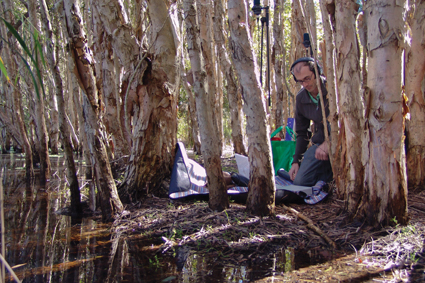
New Music Network members, top; Erik Griswold
NEW MUSIC HAS BECOME AN ELEMENTAL PART OF THE CULTURAL YEAR IN SYDNEY FOR ME. THERE WERE SOULLESS TIMES WHEN THIS WAS NOT THE CASE BUT NOW THERE’S A STEADY STREAM OF QUALITY CONCERTS FROM ESTABLISHED AND EMERGING INNOVATORS GUIDED, PROMOTED AND SUPPORTED BY THE SYDNEY-BASED NEW MUSIC NETWORK. WHAT’S MORE, THE NETWORK REACHES ACROSS THE COUNTRY AND I CAN BE CHALLENGED AND THRILLED BY THE LIKES OF CLOCKED OUT FROM BRISBANE AND APHIDS AND SPEAK PERCUSSION FROM MELBOURNE.
The seemingly tireless Network Manager, Philippa Horn, is at the front desk of many of the network’s concerts, welcoming audiences, selling tickets, serving wine. The organisation’s amiable president, James Nightingale, who performs with Continuum Sax and produces the Concert Series with member input, is often present as well. I spoke with Horn and Nightingale recently about New Music Network, its history and its strategies for promoting new music—a truly challenging but, it seems from their joint enthusiasm, rewarding task.
New Music Network started in 1995 as a Sydney based organisation, says Nightingale, at the prompting of new music stalwarts Daryl Buckley and John Davis, who convened the initial meeting at the Australian Music Centre with founding members austraLYSIS, Contemporary Singers, Coruscations, Elektra String Quartet, ELISION, Machine for Making Sense, The Song Company, Spring Ensemble, Sydney Alpha Ensemble, Sydney Metropolitan Opera, The Seymour Group, Synergy Percussion, SIMA and Voiceworks. Initially, says Horn, “the meetings were about sharing mailing lists and cross-promoting each other’s activities.” Nightingale adds that the focus was “to lobby the cause of contemporary music, to find economies through collaborative ventures and to build audiences.”
The subsequent years weren’t easy ones in terms of continuity and funding, but in 1999, the NSW government provided support for administration, plus an event, the Peggy Glanville-Hicks Address with a performance. This would later form the beginnings of the concert series envisaged by Marshall McGuire and Roland Peelman. More substantial funding was granted by the NSW Government in 2003 and the main concert series commenced, quickly joined by the mini series. In 2008 the Music Board of the Australia Council also became a significant supporter. Now the Network has some 30 members and an annual national program of activities including the New Music Concert Series, the New Music Mini Series and the Glanville-Hicks Address.
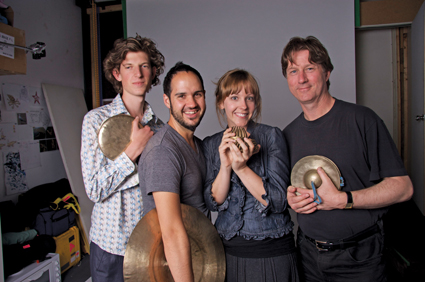
members of Speak Percussion
courtesy New Music Network
members of Speak Percussion
The organisation’s initial focus was in and around Sydney, says Nightingale, “but it gradually expanded, not only in number but in the range of organisations joining.” These include diverse contemporary classical groups like Ensemble Offspring, austraLYSIS with its electronic creations and the experimental sounds of Machine for Making Sense. SIMA, the Sydney Improvised Music Association, is also a member—“they have a similar brief to ours, so we support each other as best we can. They’re important for promoting our mini-series. The network is very inclusive.” Horn mentions that Adelaide’s Soundstream [see article] and Perth’s TURA, producer of the annual Totally Huge festival, have recently joined, giving the network even greater national scope.
“When we decided to go across the border,” says Nightingale, “it was with a combination of desires.” These included expanding the network but also hoping that they could help groups perform in their own cities as well as in other states. Horn is proud that “this is the first year we’ve presented concerts from our main members in both Melbourne and Brisbane, and we have a Mini Series Concert in each city.”
Horn and Nightingale feel that the signs are good, that the organisation is seriously realising its goals. Partly this is because of the aforementioned inclusivity—they cite the membership of Melbourne sound installation artists Madeleine Flynn and Tim Humphrey [RT98] who jointly act as Secretary to the network’s Executive Committee. Horn sees cross-media membership as important for the organisation, along with new platforms and venues, like Campbelltown Arts Centre, west of Sydney “with their extremely strong focus on new music.” The centre is now a member of New Music Network—a significant development, says Horn, excited by the potential impact of new regional arts centres for new music.
Wondering how member groups are supported by the network, I’m told concerts are promoted through an e-newsletter to 1,700 recipients nationally, groups are profiled on the network’s website, advice is given about timetabling of concerts to avoid competing dates, there’s a fine brochure and some financial support. However, Nightingale is emphatic that “the intangible benefits of being in the network are often the ones which are the most difficult to promote and yet are the most rewarding. For example, we try in our concert series to promote artistic collaboration between our members. We don’t have money to make that happen, but it does.” The soprano duo Halcyon has recently been collaborating with australYSIS and Song Company with Ensemble Offspring, who will appear with Machine for Making Sense in a performance in Sydney Harbour National Park on November 7.
“The other intangible is the mentoring that goes on for the up and coming groups from those who have been in the scene much longer. Roland Peelman, artistic director of Song Company is the most obvious example with his openness to all the groups he collaborates with—including Ensemble Offspring and Continuum Sax. Being in a concert series that includes Synergy and Song Company, Continuum Sax gains a lot from just seeing how they operate and just how difficult it can be even if they have a couple of staff members. How much work that goes on in the sector is underestimated. Continuum Sax has no administrator, but we are helped by New Music Network.”
Melbourne composer, former Aphids director, current director of Chamber Made Opera and Vice-President of New Music Network is David Young, another valued role model, says Nightingale: “He’s always full of good advice and has shown what can be achieved through multi-artform collaboration. Aphids’ work is not just about music, but it’s really intelligent when it is and that’s something all of us admire and aspire to.”
I wonder about the role of the network in supporting emerging artists. Horn says that “those who participate in the mini-series are so grateful to get an opportunity to perform. We get about 50-60 applications for the series each year from which we can only choose five.”
What do groups generally need? Nightingale explains that it varies from group to group: “Song Company needs very little from us; we benefit from them, and from Synergy too. Other groups we can support in the Concert Series with a substantial fee to pay for their performers. The Mini Series artists receive a token fee.” Horn adds, “And we look after the venues for them as well as promotion and some paid advertising.” Nightingale explains that “with our artistic oversight, the relationship with the ABC’s Australian Music Unit at Classic FM is very strong. They’re extremely supportive of what we do. Being involved in the mini-series opens doors for people. It’s hard to quantify those sort of connections, but that’s what a network is, a set of constantly dynamic, constantly changing relations. The Halcyon and austraLYSIS concert was broadcast and the artists interviewed as part of it.”
It’s surprising that such an effective organisation is administered by Horn a mere two days a week (I bet that doesn’t include front of house duties); she works the rest of the week for the Australian Music Centre. Her role entails scheduling, booking venues, getting marketing and promotion up for the concert series, delivering the e-news and updating the website, calling for applications, preparing budgets and getting grant applications in on schedule.
I ask Horn and Nightingale if their roles are more than labours of love. Nightingale asserts that “the network is something that will have long lasting consequences. I feel that the new music scene in Sydney has really thrived since the concert series started. For a lot of groups it provides a focus around which they can arrange other things and take advantage of the schedule. When you see the younger groups like Chronology Arts [RT97] and Kammer Ensemble with their wealth of activity and the young composers coming out of the Conservatorium; it wasn’t like that a while ago.”
As for audience development, Horn says that every angle is explored, including sharing mailing lists and doubling audiences with collaborative shows. She’s been inspired by partaking of ISCM festivals in Europe (she played a pivotal role in the wonderful Sydney ISCM World New Music Days earlier this year; RT96). “It broadened my horizons to see lots of small presenting organisations similar to us and so many networks, but very well funded, as in Belgium. But here it’s only us.”
Asked if the network is involved in commissioning new works, Nightingale explains that it would not want to compete with its member groups: “Our contribution is making sure that the performances happen. Back in the 1980s and 90s works commissioned were often not performed or if they were they never came around again. It was unsatisfactory on every level and not a good use of the money and dreadful for the artists. The relationships between composers and performers are now evolving in a very positive way—more new work means a lot more performer input and works are developed more collaboratively.”
With its growing membership across Australia, its concert series and the support it offers groups, its encouragement to collaborate and its openness to new platforms, New Music Network has proven itself an invaluable and sustaining part of new music culture. Nightingale says, “Sometimes people think we’re classical and composer based but we bring other models onto the page and when the edges get messy, that’s when it’s most interesting.” I can vouch for that.
New Music Network: 2010 Concerts: Clocked Out, After the Kingfisher’s Wing, composer Erik Griswold, Ian Hangar Recital Hall, Qld Conservatorium, Oct 6, 6.30pm; Machine for Making Sense & Ensemble Offspring, West Head Project V at Middle Head, Sydney Harbour National Park, Nov 7, 4pm; Double Duos, Recital Hall East, Sydney Conservatorium, Nov 21,5pm; Halcyon with austraLYSIS, Music Workshop, Sydney Conservatorium, Dec 15, 7.30pm; www.newmusicnetwork.com.au
RealTime issue #99 Oct-Nov 2010 pg. 46
© Keith Gallasch; for permission to reproduce apply to realtime@realtimearts.net
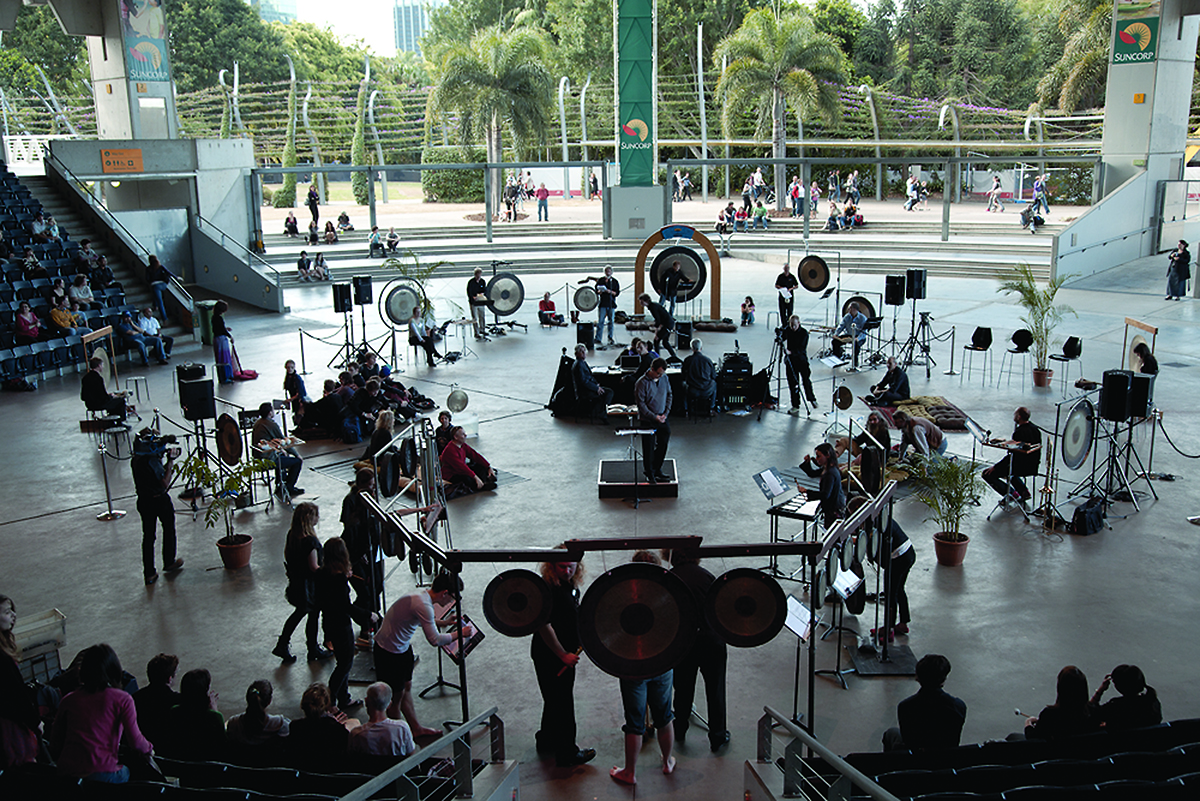
Australian Percussion Gathering, Brisbane, 2010
STEVEN SCHICK, ONE OF THE DISTINGUISHED GUESTS AT THE AUSTRALIAN PERCUSSION GATHERING HELD RECENTLY IN BRISBANE, GAVE AN INTIMATE RENDITION OF KURT SCHWITTERS’ 1924 URSONATE WITHIN A MASTER CLASS TITLED “NO STICKS: USE OF THE VOICE, THEATRE AND BODY IN PERCUSSION.” HIS RENDITION OF THE DADAIST, ECHOLALIA-INFUSED PIECE—WRITTEN AS “A WEAPON AGAINST LOGIC”—WAS PERSONAL, INTIMATE AND EXTREMELY MOVING, IN A WAY I HAVE NEVER EXPERIENCED.
Previously, I’ve heard its nonsense lines (“Fümms bö wö tää zää Uu”) delivered with a sense of comic attack or even aggressive ejaculation, but Schick soft-shuffled the floor in a thoughtful perambulation, the piece’s sound clusters driving a necessity to speak. Why does he speak? Why should we listen? These are questions Schick asks of every performance he gives. Here is a master musician plumbing a lifetime of emotions, experiences and ethical considerations, giving immense respect to his audience.
Schick’s Ursonate affirmed the voice (and lips, tongue and glottis) as an instrument equal to any of a percussionist’s tools, only perhaps more bared. Many of the Gathering’s master classes talked less of technique (“technique is merely the means,” insisted Sylvio Gualda) than of playing from your bones. Discussions centred on refining choices to do with aesthetics, timbrel groupings and the building of textures. Not every teacher said so baldly that you have to ‘play from yourself’ as did Phil Treloar, but with many it was implied—the Gathering’s strong emphasis on collaborative improvisation provided a context where, across the spectrum of ages and experience, people could plumb themselves.
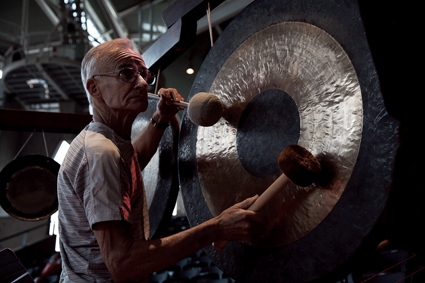
Barry Quinn, The Gathering
photo courtesy of Qld Conservatorium, Griffith University
Barry Quinn, The Gathering
Schick emphasised percussion’s humble, tribal origins: the contact of skin-to-skin, hand to drum membrane. He even quietly threw the challenge to younger students to consider the shamanic origins of performance, a player perhaps passing through membranes to other or hidden worlds. This provocation matched the tone of the conference as a whole, which was remarkably uncompetitive and non-aggressive. The discipline’s earliest mentor in Australia, Barry Quinn, was honoured on the final night. A player of international repute, Quinn would apparently teach anyone who could throw a stick at a wall and catch it on the rebound. He has influenced three generations of practitioners who continue his method of encouragement and positive mentoring to this day.
But as Artaud wrote, “Being has teeth,” and ‘Being’ can be both encouraging and fierce. There was nothing quite like witnessing Sylvio Gualda (for whom Yannis Xenakis wrote his exacting percussion solos) demonstrate “not ffff [quadruple forte] but energy“ with barely a flick of his wrists. It was like the Concorde’s sonic boom at 10 paces within two seconds. Whilst Japan’s Kuniko Kato plays Xenakis taiko-like, a knife forcing silence out of sonic space, a contained Gualda holds this split-second ignition in his ribs.
Solo percussion in music of the classical tradition is a recent phenomenon, developing from the late 1920s works of Edgar Varese through John Cage to the contemporary environmentalist John Luther Adams. It was an honour to be in the room with master artists for whom many of the pieces performed were actually written. Especially moving was Schick’s bow to Sylvio Gualda as his tribal elder in the wings. This honouring of lineage was characteristic throughout the event.
It’s also an honour, always, to hear works made as we listen. Darryl Pratt and Phil Treloar exemplified this in their improvised duo, marimbas playing both sweet and dry, wiry and full of dew—a gracious marriage, despite the 20 year gap since their last playing together. Perhaps experience teaches skills of giving in.
But for Schick, repeating a work holds the same challenge—to make every time like the first. Here he performed Xenakis’ Psappha for the 250th time. ‘Fresh’ is not the word so much as volatile as gunpowder-in-waiting. Schick kicks the side drum like a tempestuous goat, obsessive, fixated and seething within the Sapphic cells of rhythmic measure that generate the piece. His master class gave techniques—layerings, placing, personal challenges—to keep one fresh and able to surprise oneself in performance.
In an evening concert, Varese’s monster masterpiece, Ionisation (1929-31) was performed twice, under two different conductors, providing another example of how to reignite an old flame. It highlighted the impact of interpretation, with huge differences of timbre and tone. But there were also quieter intimacies. Speak Percussion’s Eugene Ughetti performed a solo by choreographer Deborah Hay in a delicate, wiry, hiccupping and side-stepping dialogue between feet and floor, skin and space. He awaits the companions who never quite fall onstage from the wings. This was so poignant a performance that, although comic, no one laughed. Ughetti’s body dances like an amoeba yet we never lose sight of the fine musical choices with which he recites and drums the hand gong.
In Driftwood, Ughetti gently dismantled and recomposed a marimba like a father playing ‘toss’ with his child. He and Matthias Schack-Arnott kissed bows with their lips. This threshold of the lips was also, more explosively, explored by Schick in Touché by Globokar. Based on Brecht’s play Life of Galileo, the piece is a bravura, agon-like dialogue between voices of faith and fear, the yoked vocal consonants and paired glocks always threatening to break partnership with each other.
Among the students, Defying Gravity partnered in as sinuous and athletic a dance with marimba as if it had a skirt and legs (oh that keyboard girl!) and Ba Da Boom rumbled suitcases and tossed coins in the space. High school kids performed with aplomb. Rebecca Lloyd-Jones, Matthew Horsley, Cameron Kennedy and Robert Oetomo made outstanding contributions and were awarded special prizes.
Brisbane group Clocked Out continued their exploration of unusual sound and visual objects, and miniature toys. It was a pleasure to hear how Erik Griswold’s aesthetic has matured over the past decade. To end the conference, the full coterie of students, teachers and guests performed in the concrete circle of the SunCorp Plaza playing Michael Askill’s 1000 Gongs (how many moods can a gong make?—one thousand), a sequence of 14 improvisations which incorporated a massive two-metre diameter tam-tam, song, movement, spoken word, trumpets and water gongs in a two-hour ritual traversing words and tonalities from Marc Bolan to Yogi Bhajan, Messiaen to Stockhausen. Many of the general public who wandered in to the performance stayed the distance.
The final day saw a trip to the Sunshine Coast hinterland, to the Cooroora Institute run by Tamsin Kerr, Ross Annels and their daughter Anika, for a day of listening and playing in the rainforest. The primary tool here was communication between ear, heart and land. Convenor Vanessa Tomlinson wondered how everyone would respond.
A young woman suddenly starts walking on all fours, boots on her hands (becoming animal); a senior percussionist rustles a tree (becoming mantis); two young men rumble a dying branch to its sonic death. Drums become insects and call to invisible partners across the mountainside. A song is improvised beside a Bunyip’s waterhole. Jan Baker-Finch rustles her body like leaves, moving, being moved by the winds of other improvisers. We finish the day with mulled wine by the fire.
The Gathering, convenor Vanessa Tomlinson with Michael Askill and Tom O’Grady, Queensland Conservatorium, Griffith University, Aug 26-30
RealTime issue #99 Oct-Nov 2010 pg. 47
© Zsuzsanna Soboslay; for permission to reproduce apply to realtime@realtimearts.net
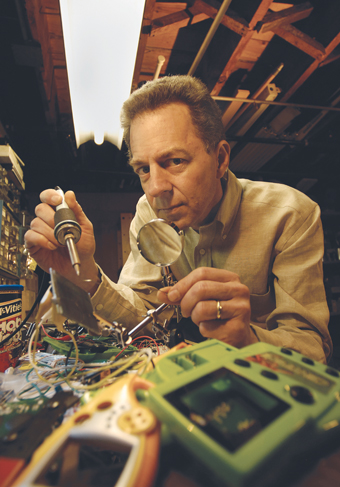
Nicolas Collins in his basement workshop, Chicago, Il (USA) 2006
photo Marty Perez
Nicolas Collins in his basement workshop, Chicago, Il (USA) 2006
THE HISTORY OF ELECTRONIC MUSIC IS AS MUCH A HISTORY OF INVENTIVE ELECTRONIC DEVICES AND EXPERIMENTAL INSTRUMENTATION AS IT IS OF MUSICAL FORM AND STRUCTURE. FREQUENTLY, THE TWO ARE INSEPARABLE—THE METHOD IS THE MUSIC. AMERICAN ARTIST NICOLAS COLLINS DESCRIBES HIMSELF AS A HARDWARE HACKER, AND HE HAS LONG BEEN AN INNOVATOR BOTH MUSICALLY AND TECHNOLOGICALLY, MAKING A POINT OF REJIGGING ELECTRONIC GADGETRY TO CREATE HIS MAGICAL MUSIC AND REDEFINING MUSIC ITSELF.
Collins began experimenting with electronic equipment in the early 1970s, and, when the desk-top computer appeared, began writing computer programs that would emulate or extend the sound-generating strategies he had developed. He studied with Alvin Lucier and has evidently absorbed John Cage’s interest in experimentation as well as his curiosity and playfulness. Collins’ seminal device consisted of a found circuit-board attached to a battery and a loudspeaker, and activated with electrodes or a damp fingertip to produce buzzes and squeals with which to make music.
Collins likes the idea, literally, of a hands-on approach, where the player can touch the circuit board to generate sound, experimenting with degrees of deliberative action in the process of music-making. He is also concerned to explore the disruption of pre-programmed output to create alternative sonic output and thus a new instrument. Instruments that require performer intervention to defy inbuilt automation reveal the profound difference between analogue variability and digital predictability and reveal analogue as so much more seductive. Another early work featured a toy train running along a straight track and touching a tautly stretched wire connected to a contact mike so as to generate a sound as it moved. Such ‘folk’ instruments are easily accessible to the layperson.
I attended Collins’ talk and then his concert, since an understanding of how his gadgets work and how much human intervention is involved is essential to full appreciation. The concert comprised four works that epitomise his philosophy: Salvage (Guiyu Blues) (2008), performed with a team of players armed with found circuit boards; Pea Soup II (1973/2002); The Talking Cure (2002); and In Memoriam Michel Waisvisz (2008). Some of his devices automate randomness and the output can also be affected by extraneous influences uncontrolled by the composer/performer—the gently mesmerising Pea Soup involves running a signal from an auditorium mike through laptop-mounted phase shifters and filters that modify or delete particular tones in response to accumulating feedback. The sound thus stabilises itself around an automatically self-edited set of tones that sonically characterise the room’s acoustics and respond to ambient sound such as audience noises. At moments, a cellist and a saxophonist add further monotonal material to the mix. Talking Cure is a piece for spoken word, the rise, fall and texture of Collins’ voice triggering piano tones to produce a sound pattern that parallels his speech. These works are an oblique extension of Lucier’s I am Sitting in a Room (1969), in which speech is recorded, played back and re-recorded with the ongoing speech to disrupt verbal intelligibility and respond to the space. In Talking Cure, Collins is translating speech into music and simultaneously generating both verbal and musical meaning. We’re reminded that voice tones are as important as content in conveying the meaning of the spoken word.
In Memoriam Michel Waisvisz involves a small metal box inside which is a tiny circuit board, a 9v battery and a birthday cake candle burning brightly. The flickering of the candle stimulates a light sensor connected to an oscillator, emitting a howling scream whose pitch and intensity are determined by the flicker. For extra effect, a realtime image of the apparatus is projected onto a screen in the auditorium in vivid close-up. There is a post-industrial sculptural beauty about some of Collins’ devices, and there are other works in which he has coupled his sonic gadget with visual effects, for example, using LEDs salvaged from computer games to create new imagery that defeats the narrative of the games and denies player participation.
Collins’ aesthetic lies in balancing human intervention with the automation of sound so as to create an attractive and stimulating musical work. It also arises from the beauty of Chaos theory—the sonic result will be different every time. A composition will not be intended to produce a fixed set of notes, timbres or effects, but will be broadly indeterminate within the range of possibilities inherent in the design of the device and its usage. Indeterminacy is extended through the improvised nature of performance. The aggregated, automated interventions of these musical robots, such as multiple tone editing and phase shifting in response to ambient stimuli, take the form of electromechanical daydreaming—this is a kind of primitive, undirected thought, telling in its implications.
Collins also transcribes his sound works for acoustic ensembles, capturing the timbres, textures and structures of the original in the ensemble’s score while introducing new forms of intervention to create engaging and unpredictable chamber works that have an intense and unique musicality.
This body of work is about accessibility, vernacular materials and participation, questioning the idea of the genius artist/composer. Virtuosity here involves combining the radical and telling disruption of everyday hardware, programmed self-editing and adroit randomisation. Collins’ work is ironic in its postmodern subversion of technology, reminding us of the extent to which new technologies, whose capacities we do not fully understand but which we take for granted, permeate and control our lives. He has recolonised the circuit-board, demystifying and challenging automation and disposability. And he investigates how sound functions and what speech is, addressing the processes of reception, recognition and comprehension of sound and word. The issue of originality and authenticity is another important theme, as he plunders machinery and programs, samples radio transmissions and borrows performative concepts to create new syntheses. The result is conceptually demanding and perversely entertaining, with a powerful current of humour running throughout.
Collins is an articulate and engaging writer and speaker, and his texts, full of joyful anecdotes, form an absorbing personal history of electronic musical experimentation and groundbreaking innovation. Importantly, though, he is a musician, not a techno-geek, and this is seriously interesting music. On his website, you can find recordings, videos and detailed explanations of how the instruments and works were developed. You can download a piece of his software to make your own version of one of his works and there are scores for other works. His book Handmade Electronic Music is on his page and includes instructions on how to solder components and how to make contact mikes and oscillators. You are strongly encouraged to try this at home.
Nicolas Collins, “Collaborations in Sound/Intersections of Science and Art,” University of South Australia, June 11; Works of a Slightly Misused Technology, with cello Jack Ward , saxophone Derek Pascoe, and salvage Seb Tomczak, Christian Haines and the Adelaide Hacking Philharmonic, RiAUS, The Science Exchange, Adelaide, June 12; presented by Elder Conservatorium of Music, University of Adelaide with the Royal Institution of Australia (RiAUS) and the Australian Experimental Art Foundation (AEAF); www.nicolascollins.com.
RealTime issue #99 Oct-Nov 2010 pg. 48
© Chris Reid; for permission to reproduce apply to realtime@realtimearts.net
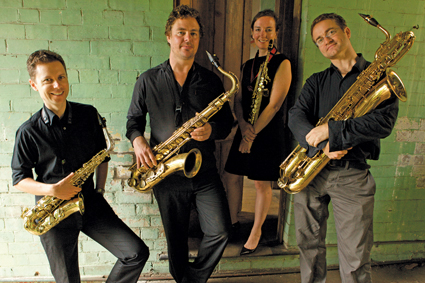
ames Nightingale, Martin Kay, Christina Leonard, Jarrod Whitbourne
photo courtesy New Music Network
ames Nightingale, Martin Kay, Christina Leonard, Jarrod Whitbourne
TWO RECENT CONCERTS IN SYDNEY WERE ILLUSTRATIVE OF THE GROWING RICHES TO BE ENJOYED IN THE CITY’S NEW MUSIC SCENE, FEATURING UNUSUAL INSTRUMENTAL EXPLORATIONS AND A MULTITUDE OF WORKS BY AUSTRALIAN COMPOSERS FROM THE EARLY 80S TO THE PRESENT AND EMBRACING POETRY, MYTH, PHILOSOPHY AND THE AUSTRALIAN LANDSCAPE.
continuum sax & match percussion
Gyorgy Ligeti’s Six Bagatelles (1923-2006) for saxophone quartet is a miracle of invention, revealing the rich, fluent capacities of the instrument in chorus and the virtuosity of the Continuum Sax ensemble. From sublime gallops and Eastern European folk dance riffs to serene high flights over deep burbling waters that recall Ravel to a final cartoony brass band chase, Six Bagatelles (originally from a piano work, then adapted for wind quartet) is driven with rapid, supple gear changes in volume, timbre and mood that make for exhilarating listening.
Margery Smith says in her program note that her Lost Blues for saxophone quartet and percussion duo (2010) was inspired by “the very dirty, cranky blues music of Tom Waits.” You can hear it, particularly in the unusual instrumental and rhythmic juxtapositions—sax, drums, marimba—more experimental than Waits and erupting in one passage into a gliding and warbling eccentric big band sound, followed by a moment of loud high passion and then a brisk resolve.
Mary Finsterer, composer of IONIA for saxophone quartet and percussion (2010), writes that the work is inspired by the sixth century Ionian school of philosophy—“Everything flows, nothing stands still” and a passion for bringing opposites into balance. Of the composition’s structure, Finsterer mentions in particular “small permutating cycles of clearly identifiable material repeating within larger cycles.” These are contrastingly realised across emphatic changes of mood and pace: a lyrical solo saxophone opening passage, a sudden tom-tom-triggered dance, deep staccato saxophones against pulsing marimbas and a sustained episode that builds cumulatively into something curiously like Lully gone wild. On first listening, IONIA suggests a work worth return visits.
Chun Ting Pang’s In Different Spaces for percussion duo (2010) juxtaposes marimba, tom-toms, suspended cymbal and woodblocks in a beautifully textured, evocative exploration of the five elements in Chinese philosophy including “condensation of water on a metal plate” and “wind which helps spread the fire in wood.” The work is highly articulated, sometimes demandingly fast but frequently ethereal. Matthew Hindson’s Song of Life (2007) for solo violin is a short tribute to Father Arthur Bridge, a significant contributor to the commissioning of new works. Natsuko Yoshimoto’s playing was at once precise and passionate for a work that variously evoked 19th century melodiousness, folk music evident in glissandi and brusque stroking, and 20th century angularity, but which resolved into satisfying unsentimental unity.
Brian Howard’s Last Blues for solo violin, saxophone quartet and percussion duo (2008) is a formidable, bracing and beautiful work, and one difficult to do justice to from a first hearing. Conductor Roland Peelman writes in his program note, “From the faintest violin harmonic to the grittiest saxophone texture, Last Blues unfolds not as a sultry dance or as a sad and sentimental song, but as a force of nature where all elements inextricably lead to one single purpose.” The combination of saxophone, violin and percussion is an unusual one (Howard quipped in a pre-performance interview, “sometimes it’s easier to get a weird piece performed”) but very effective, yielding a delicious otherness most felt in the work’s three time-stilling ‘cadenzas.’ If the blues are to be felt anywhere amidst the growl of saxophones, the bowing of vibraphones, the nervous, rapid rattle of percussion and the sudden emotional surges by the ensemble en masse, it is in the violin part, again, exquisitely realised by Natsuko Yoshimoto. Indeed Lost Blues stays with you like the recollection of a concerto, the instrument’s range is widely exploited, and when it sings and the tenor saxophone then soars with it and beyond, the work’s sense of interiority, of aloneness, but also of fragile togetherness is most felt.
halcyon: where the heart is
While not a program of the scale and potency of Extreme Nature (RT93) which featured big, challenging works by Australians Elliott Gyger and Nicolas Vines, Halcyon’s Where The Heart Is, is a program featuring six more Australian works, all fascinating and revealing a rich variety of practice.
Ross Edwards’ Maninya (1981), inspired by the natural environment, comprises hypnotic if rhythmically complex series of apparently meaningless syllables sung by Jenny Duck Chong to Geoffrey Gartner’s talkative cello in passages that evoke lullaby and reverie and closing with a cello jig.
Elliott Gyger’s Petit Testament, like From the Hungry Waiting Country (2006 and soon to be released on CD) in the Extreme Nature program, responds to Australian poetry, here in the form of the last of the Ern Malley hoax poems. Once again Gyger provides Duck Chong and Alison Morgan the opportunity to “highlight one of our particular skills—the illusion of singing ‘as one’ and masquerading as one another” (program note). As Gyger writes, “My setting re-enacts James McAuley’s and Harold Stewart’s dazzling feat of ventriloquism (two real poets masquerading as one fictional poet) in employing two voices to project a single musical lie, slipping unpredictably between unison, heterophony and interior dialogue.” The sopranos dexterously managed the overlaps, sharply articulated modulations and shared sentences while the Stuart & Sons piano (played admirably by Sally Whitwell) provided a resonant other voice, alternately dramatic and ironic, lyrical or ‘going to pieces.’ Gyger aptly evokes both fraudulent excess and the odd beauty of the poem.
One of two highlights of the concert was Andrew Schultz’s To the Evening Star (2009; Best Song Cycle, Paul Lowin Awards), a reflection, writes the composer, on the inner creative life, responding to poems by Yeats, Hopkins, Longfellow, WH Davis and Blake. Yeats dreams lyrically of rural escape while the busy piano suggests both the “bee-loud glade” and “the roadway…the pavements gray.” For Hopkins’ Pied Beauty, Schultz and singer, Alison Morgan, hit the syllables hard and rapidly, evoking excitement at the density of natural riches. Longfellow’s anxiety about a creative life only half fulfilled is rendered emotionally, a soaring complaint, the piano thundering in empathy, while Davies’ Money, O! contrastively celebrates being poor but happy in a vigorous folksy, music theatre idiom. Finally, Blake’s To the Evening Star is a gloriously sung prayer for divine protection framed by piano scoring that seems to embrace the whole of the world, the playing constantly pushing out to the bottom and top-most notes simultaneously until at rest.
Ann Boyd’s Cycle of Love (1981) is in the form of three sung ancient Korean poems and two instrumental interludes (Gartner’s cello and Sally Walker’s flute in exquisite dialogue). For all the meditative Korean and Japanese influences, the compositions are lively, even dramatic and certainly heartfelt in their longing.
The final work, folk singer and musicologist Ruth Lee Martin’s Wimmera Song Cycle (2010), a setting of Kevin Hart’s Wimmera Songs, surprised me with its transparent structure, its deceptively musical theatre character and ease (apt for the uncomplicated syntax of the poet’s finely crafted image-making). Sopranos, cellist, pianist and flautist combined in various permutations to evoke the spread and detail of the land, through moments of delicate observation, pain (“the other silence that fits your head inside a vice”) and the potential for transcendence—“Think like a cloud / Go where the clouds go.”
New Music Network: Continuum Sax and Match Percussion, violin Natsuko Yoshimoto, conductor Roland Peelman, percussion Alison Pratt, Daryl Pratt, soprano saxophone Christina Leonard, alto saxophone James Nightingale, tenor saxophone Martin Kay, baritone saxophone Jarrod Whitbourne; Eugene Goossens Hall, ABC Centre, Sydney, Aug 24; Halcyon, Where the Heart Is…celebrating homegrown music, CarriageWorks, Sydney, Sept 13
RealTime issue #99 Oct-Nov 2010 pg. 49
© Keith Gallasch; for permission to reproduce apply to realtime@realtimearts.net
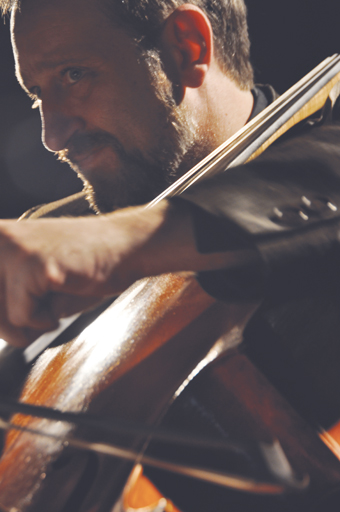
John Addison, Soundstream 2010
photo Cindy Taylor
John Addison, Soundstream 2010
THERE HAVE BEEN INNUMERABLE DEVELOPMENTS AND DEFINING MOMENTS IN THE EVOLUTION OF COMPOSITION AND PERFORMANCE THROUGH THE 20TH AND INTO THE 21ST CENTURIES. SOUNDSTREAM NEW MUSIC FESTIVALS SHOWCASE RARE AND SIGNIFICANT CONTEMPORARY CHAMBER WORKS FROM THIS ERA, AND THE FOUR CONCERTS OF THE MUCH ANTICIPATED 2010 FESTIVAL PRESENTED SOME RADICAL AND DEMANDING WORK, OFTEN ENLIGHTENING, SOMETIMES INTENSE AND SOMETIMES LIGHT-HEARTED. IN MANY, THE EMPHASIS WAS ON TIMBRE AND HARMONICS, TEACHING US TO FORGET TIME AND FOCUS ON THE SOUND IN THE MOMENT—TO REALLY EXPERIENCE MUSIC.
the visionaries
The first concert, The Visionaries, opened with distinguished Russian composer Rodion Shchedrin’s Hommage à Chopin (1983) for four pianos, played superbly by Anna Goldsworthy, Jonathon Heng, Deborah Ng and Gabriella Smart. The inclusion of this work celebrated the 200th anniversary of Chopin’s birth and acted as a gateway to the festival. Proceeding from fragments of Chopin’s introspective Prelude in C minor No. 28 Op.20, this is a thickly layered and extroverted work of multi-voiced variations on Chopin themes that blends the romantic with the modernist sublime and group pianism with solo virtuosity.
This diverse concert included Adelaide composer Andrew Wiering’s Vortex (2006) for six percussionists, a powerful orchestration of percussive forces ably led by Wiering on timpani; Sydney-based Katia Tiutiunnik’s To the Enemy (2005), a striking setting of a contemporary poem by Eva Salzman for soprano (Sidonie Henbest) and two percussionists (Wiering and Nick Parnell); and Smart’s seductive performance of the third movement of Canadian composer Howard Bashaw’s structurally complex Minimalisms II (2005).
Pianists joined percussionists for The Visionaries concert centrepiece, the 1953 revision of George Antheil’s Ballet Mécanique. The logistically challenging 1924 original was intended to accompany a Dadaist film and was scored for 16 player pianos, sirens, aeroplane propellers, electric bells and extensive percussion as well as conventional pianos. This version, for just four pianists (Smart, Goldsworthy, Ng and Heng) and six percussionists (the Vortex Ensemble), with the siren and propeller sounds rendered through a sampler (John Addison), shifts the focus from visual or electromechanical spectacle to the musicality of the composition. With its multiple competing lines of sound, forceful rhythms and dynamics and urgent pace, Antheil’s high-energy work dramatically evokes modern industrial society. Under the direction of Roland Peelman, this performance electrified the eager audience.
ensemble offspring: the spectralists
On Friday, Ensemble Offspring gave us The Spectralists, a concert on the theme of Spectralist composition in which the analysis of the timbral or harmonic spectrum of a sound is used as the basis for composition or musical language. Spectral composition gained prominence in the 1970s especially through Gérard Grisey and Tristan Murail, and the concert opened with Murail’s Thirteen Colours of the Setting Sun (1978), a classic of the genre. Scored here for flute, clarinet, piano, violin and cello, it explores the harmonics surrounding a single high-pitched note and takes the emerging tones in new directions. With reduced rhythmic emphasis, the result is cosmically dreamy, nakedly revealing the timbral character of the instruments. By contrast, Gérard Grisey’s absorbing Talea (1986) alternates loud attack with quiet passages in swirling patterns that evolve as they are repeated.
This concert also premiered Australian violinist James Cuddeford’s enchanting KOAN I (2010), in two movements for flute, clarinet, violin and cello, a musical representation of an insoluble riddle, seeking philosophical resolution musically and ending questioningly. Also revealing the influence of Eastern philosophy were works by Giacinto Scelsi and Claude Vivier. Scelsi’s exquisite Ko-Lho (1966) for flute and clarinet is a meditative exploration of the sonic blend that emerges from the two instruments as they dwell on one pitch. Sounding at times like a single instrument, they produce densely woven microtones and overtones, requiring virtuosic playing to generate the required colouring. Similarly, Vivier’s Pièce pour Violon et Clarinette (1975) involves a simple melodic line played by both instruments and repeated with digressions to create a distinctive timbral compound. Finnish composer Kaija Saariaho extends these ideas in her Cendres (“ashes”; 1998), which blends the contrasting characteristics of the flute, cello and piano into a complex sonic tableau. The appeal of such work lies in the blend of melodic linearity and harmonic density, and you listen to each sound as an evolving entity. Ensemble Offspring was outstanding, combining sustained control of tone colour with excellent ensemble playing, and this knockout concert was an education in the genre.
brian ritchie trio: the rebels
In the Brian Ritchie Trio’s early Saturday night concert, The Rebels—former Violent Femmes bassist and shakuhachi master Ritchie, pianist Tom Vincent and bassist Leigh Barker—gave us their hybrid musical form that draws on the ethereal, meditative grace of the shakuhachi and the syncopated rhythms of jazz. The highlights were a new rendition of John Cage’s Ryoanji and scintillating re-workings of pieces by John Coltrane and Free Jazz saxophonist Albert Ayler. The result was hypnotic, balanced towards one or other musical tradition to suit the work.
john addison, the larrikins
Late Saturday night, John Addison presented The Larrikins, a technically demanding concert for solo cello, opening with Sydney composer Alex Pozniak’s Mercurial (2009), a gestural work of huge dynamics and writhing, neck-length glissandi that requires both tactility and theatrical athleticism of the performer. Addison, a star of last year’s Soundstream Festival, collaborates with composers, and a workshop he gave generated Pozniak’s work as well as Luke Altmann’s Somniloquy (2010), which brilliantly evokes the troubled sleepwalker, and Kat McGuffie’s wryly engaging The Tune is Out There (2010). The latter begins with a parody of the opening of Strauss’s Thus Spake Zarathustra, segues into fragments of Fly Me to the Moon, the Jaws theme, Dvorak’s 9th Symphony and Stairway to Heaven, and ends with a Deep Purple riff with the cello held horizontally and strummed. In an ABC radio interview, Addison suggested that so-called extended playing techniques “are just techniques.” Composers now draw on a broader range of these, so it’s actually composition that’s being extended. An eloquent and captivating performer, his approach is refreshing the cello aesthetic.
Addison continued with New York composer Toby Twining’s slow, mournful 9/11 Blues (2001), whose shrill harmonics suggest electric guitar feedback, and Brisbane-based Stephen Stanfield’s emotional and introverted A Lenient Me (2010). He concluded with a gem, Tatata (1998), for tape and cello by Dutch composer Jacob ter Veldhuis (aka Jacob TV), which includes the morphed recording of an old soldier singing “ta ta ta” rhythmically repeated over the cello line, and ending with the voice of Apollinaire sampled from an old phono disc.
Soundstream Festivals greatly support local composition and Gabriella Smart’s informed artistic direction is expanding our musical awareness. The ABC’s comprehensive coverage of these vital festivals is a welcome development.
Soundstream Adelaide New Music Festival 2010: Anna Goldsworthy, Jonathon Heng, Deborah Ng, Gabriella Smart; Vortex Ensemble; Sidonie Henbest; Ensemble Offspring, conductor Roland Peelman; Brian Ritchie Trio; John Addison; artistic director Gabriella Smart; ABC Studio 520, Adelaide, Aug 26–28
RealTime issue #99 Oct-Nov 2010 pg. 50
© Chris Reid; for permission to reproduce apply to realtime@realtimearts.net
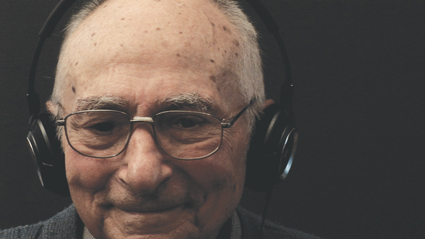
From Yia Yia’s song, Kate Murphy (with Basil Hogios), 2010, Digital video still, Multi-channel HD video and sound installation
Courtesy Kate Murphy and BREENSPACE, Sydney
From Yia Yia’s song, Kate Murphy (with Basil Hogios), 2010, Digital video still, Multi-channel HD video and sound installation
“ONE OF THE ASPECTS OF COMING INTO THE SPACE FOR THE FIRST TIME THAT’S REALLY EXCITING FOR ARTISTS IS ITS SCALE AND ITS DEPTH OF HISTORY AND THE WAY THINGS RESONATE IN THIS ENVIRONMENT.” PERFORMANCE SPACE ASSOCIATE DIRECTOR AND CURATOR BEC DEAN IS TALKING ABOUT CARRIAGEWORKS, THE VAST AND LABYRINTHINE POST-INDUSTRIAL BUILDING THAT HAS BEEN THE LONG RUNNING ORGANISATION’S RECENT HOME SINCE 2007.
By now this admittedly atypical exhibition space is a familiar one among the Sydney arts community. But as I sit down with Dean to hear more about their upcoming visual arts program, Nightshifters, it’s clear the company’s commitment to finding new ways to engage audiences with the space remains strong.
An exhibition of moving image works from eight of Australia’s leading video and media artists to take place over 10 days in November during the Live Live season including the four days of the LiveWorks Festival (p35), Nightshifters may just prove Performance Space’s most ambitious installation on the site to date. For the first time, the exhibition will be geared around evening viewing, capturing “the idea of the night shift, the changeover of stewardship and the replacement of one set of realities with another,” as Dean describes it. “Sometimes I feel privileged to wander around this building in the dark when everything is closed down and I guess I wanted to share that with audiences.”
For Dean, this means not only extending viewing hours but also getting visitors out beyond the usual spatial confines as well as offering artists an opportunity to create new site-specific works. “I was interested not so much in that wallpaper technique of video on architecture but actually having the artists engage with all facets of the site,” she says. As such, artists are responding to “the environment of the former Eveleigh Railyards, its histories and its manifestation in the present,” according to the program’s media release. However, Dean is quick to point out the site-specificity of the program isn’t intended to produce literal responses.
insect life
“I haven’t been didactic or prescriptive about that at all, it’s not a heritage project. So some artists have consciously made an engagement with the site’s history while other artists have worked with the transformation of the site as it is today. Angelica Mesiti, for example, has developed a project that has really engaged with how nature has taken over quite a large part of the Eveleigh Railyards, and so she is looking at making a work that is kind of like an epidiascope. She’s researching a way of attracting insects and bringing them into a real time, light and shadow-based work rather than a pre-edited video. So she is consciously working in a different way to the practice that she is becoming well-known for and taking a chance on an experiment, which is very exciting for me.”
Mesiti, who also works as a member of collaborative art group The Kingpins, is set to join a cast of artists who variously blur the boundaries between performance and the visual arts. Cinematographer Cordelia Beresford, video artist Sam James (p54) and the now Australian-based Belgian artist Alexis Destoop, for example, each bring with them strong histories of engaging with dance and experimental performance in their work. Kate Murphy will be collaborating with composer, music producer and sound designer Basil Hogios on Yia Yia’s song, which will contain multiple audio channels and is intended to be unsynchronised so that it can be experienced as a different score each time. A floor-based multi-screen projection by Eugenia Raskopoulos will poetically intertwine culture, history and language while John Tonkin and Dominic Redfern are set to imaginatively respond to architectural features spanning narrow passageways and mechanical drive shafts.
in the cracks
And where some, like Mesiti, are casting a glance well beyond the CarriageWorks interior others will transform close-range observations of the site into performative translations. “Sam James has done a lot of work with us over the years as a videographer, so it is really great to be working with him as an artist in his own right,” says Dean. “He has really focused in on these tiny spaces, the imperfections in the material of the space, the intersection of cracks in the concrete with train tracks and other parts of the environment that have that layered age to them. He is working on a multi-channel work and none of the images will be more than 45cm wide, so audiences will have to seek them out in this huge space. Collaborating with Georgie Read, who is a performer and has worked with Sam on many occasions, he will be bringing a figurative dimension into these tiny spaces and apertures.”
nightworkers
With a growing number of arts venues across Sydney now being housed in post-industrial conversions, it is easy to become cynical about the apparent fetishisation of these spaces. Yet this neglects the significant mediating role architecture has to play in our culture, especially when built structures are among the few tangible remnants of a past that still demands to be grappled with. One of the first artists Dean approached for this program was Cordelia Beresford, who will be exhibiting a work filmed at Cockatoo Island, a site that shares some affinity with the CarriageWorks space. Titled Night Shift, the film follows a security guard on the island portrayed by Indigenous performer Djakapurra Munyarryun. The synopsis sets out the action: “in the dead of the night he does his rituals. He listens and observes the space; aware of its history, seeking a conversation with what remains.”
reawakenings
This impulse to connect with the past arguably becomes easily submerged in everyday life and requires reawakening. And while daylight brings with it a rush forward to greet the future, evening offers pause to reflect. The spaces around us can become vehicles for such reflection, provoking an awareness of evolutions and accretions over time, something Dean has experienced first hand from her own observations of the Eveleigh site. “Since I was successful in finding the funding for this project, a lot has changed onsite. More spaces have been bulldozed or fenced-off.” Dean feels that Nightshifters is an opportunity “to try to engage with the place before it is changed irrevocably.”
Nightshifters, curator Bec Dean, artists Cordelia Beresford, Alexis Destoop, Sam James, Kate Murphy, Angelica Mesiti, Eugenia Raskopoulos, Dominic Redfern, John Tonkin; Performance Space, CarriageWorks, Sydney, Nov 4-14
RealTime issue #99 Oct-Nov 2010 pg. 51
© Ella Mudie; for permission to reproduce apply to realtime@realtimearts.net
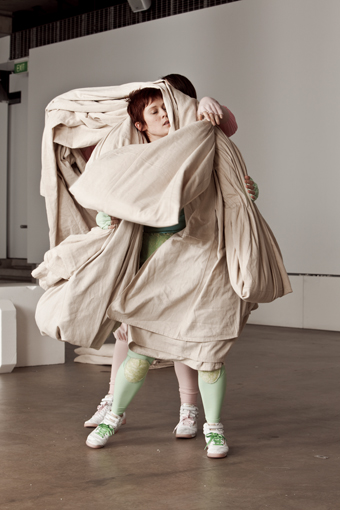
Alison and Bridget Currie, Three Ways to Hold
photo courtesy the artists
Alison and Bridget Currie, Three Ways to Hold
THERE’S A FLUCTUATION BETWEEN CARE AND NOT QUITE CARE THAT FLOWS THROUGH THE PERFORMANCES OF THREE WAYS TO HOLD THAT IS INITIALLY DISCONCERTING. AN ATTENTION TO DETAIL—COLOUR COORDINATED SNEAKER LACES, AN OVER CAREFUL FUSSINESS IN THE LAYING OUT OF CANVAS DROP SHEETS THAT COVER THE GALLERY FLOOR—COUPLES WITH A DELIBERATE CARELESSNESS AS SHEETS ARE BUNDLED AND DROPPED, LEFT WHERE THEY LIE.
The impatient shuffling of the audience out of the way in Fold and the performer’s pernickety attention to the arrangement of objects as they’re bundled into a giant sack in Collect—as if it really matters how things are done—is seriocomic, an absurd rearranging deckchairs on the Titanic activity. Yet it’s the vacillation between these moments and states of attention that draws the audience’s notice to the things that really do matter in the work.
Three ways to hold creates and demands a certain type of attentiveness over the arc of its four performances. As each performance slides between attentive states and moments, so it asks for a dual kind of attention and noticing, a specific type of refined observation as it brings intangible processes under our consideration. Each performance is named after an action—Fold, Lift, Prop and Collect—and as each becomes a performative enquiry these concerns are played out in the interaction of volume, mass, weight and space and their transformation through the performers’ actions.
In creating a closed system where the base materials are introduced in the first performance and remain in the space til the last, the possibility of novelty is removed and our attention concentrated on these formal processes of activation, recombination and change in an evolving space of forces and relations.
This concern with the activation of space and transformation of forms is one pursued by both artists in their discrete practices as visual artist and dancer. Here, these individual preoccupations are brought together and refined in a piece that deftly conducts a subtle and intelligent dissection of intangible states and an exercise in extending our awareness.
Appearing sometimes coolly cerebral, at others, Three ways to hold reveals a gentle sense of the absurd. In pastel costumes complete with knee and elbow pads, the performers Alison and Bridget Currie become super heroes or terrestrial trapeze artists underscoring a sly humour and the sense of effort brought to bear in the constant reshaping of their small enclosed world.
Fold is an exercise in expansion and contraction of volume serendipitously aided by the size of the first night crowd. Barely able to be seen at first, the performers dart outside and back in carrying slabs, blocks and wedges of polystyrene. Taking canvas sheets from laundry trugs the performers almost impatiently shake these out and lay them on the floor, adjusting them with that fussy carefulness. Edges are butted together and folds smoothed out as the space is covered with the canvas’s enlarging surface. In a neat reciprocity of action as the canvas expands, the crowd contracts—forces in motion. Almost as soon as the floor is covered, the performers turn to transforming the flat canvas into compact stacks of folded cloth. Gathered and pleated, fabric rolled between fingers to bring corners into alignment, the sheets are folded. Switching between this over-carefulness and almost carelessness we are made aware of the intent and effect of each action as each dense slab of stuff hits the floor.
The four performances create a durational arc over as many weeks. Objects are left where they fall at the end of each performance, suspended in a state of flux so that time is stretched out, so that attention is slowed to a state where notice can be taken of the invisible forces at play.
In Lift, the heaps of folded cloth form a vestigial history of Fold. It begins with the performers urgently making constructions out of polystyrene blocks, running and lifting each block above their heads in a comic show of strength and ending with a frantic game of tag across the space, palms slapping the walls. As Alison dances and feints boxer-like around the space, Bridget shakes out each cloth, giving it a weightlifter’s clean and jerk before placing it around Alison’s neck like the proverbial boxer’s towel. There’s comical huffing as this continues, yet as the heap accumulates the weight is palpable and it becomes a question of resistance and endurance rather than force. Finally, Alison, with real effort, throws off the sheets so they lie disordered again on the gallery floor.
This play of force is directed inwards and slowed almost to inaction over the seven hours of Prop with the artists developing intense attention to the effect of every action as one performer takes responsibility for the other in the literal and constantly modified act of propping. Prop becomes an intense meditation on cause, effect and responsibility.
It’s into the remnants of Prop, the blocks and wedges of foam and heaped sheets that the audience for Collect gathers. There’s no seeming diminution of the audience and it appears that attention can be sustained over this arching space of time. Bridget and Alison collect up all the wedges, blocks and slabs, bundle away the sheets and stack them into their ever expanding bag. One holds the bag open while the other arranges and rearranges things, compacting them, fitting them together. As it grows weightier, they drag their sack around the space, lifting, folding, fitting.
Tying off the neck of this amorphous robbers’ swag neatly shuts down the performance and this careful system that has been created and investigated over time. Our attention has been sustained and now lingers on a system of things folded, lifted, transformed and put away.
Alison Currie’s show 42a, “an interactive space where the audience itself affects the display and presentation, purely by where they stand, where they move to and what they do,” has toured to Sydney and Brisbane and will be at Melbourne’s Fortyfive Downstairs October 12-23
Three ways to hold (fold, lift, prop and collect), created and performed by Alison Currie and Bridget Currie, costume design Gemma Stocks, SASA Gallery, Adelaide, Aug 11-Sept 3.
RealTime issue #99 Oct-Nov 2010 pg. 52
© Jemima Kemp; for permission to reproduce apply to realtime@realtimearts.net
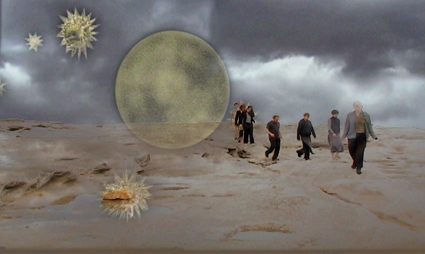
Modes of Misunderstanding, 2010, video still, Samuel James
image courtesy the artists
Modes of Misunderstanding, 2010, video still, Samuel James
IT IS AXIOMATIC THAT ARTWORKS VIEWED BY CRITICS UNDERGO CERTAIN TRANSMUTATIONS IN THEIR RECALL. IN THAT SENSE WE ARE NEVER REVIEWING ART, ONLY OUR MEMORIES OF ART. THEIR TRANSMUTATIONS WILL BE SHOT THROUGH WITH OUR OWN IDIOSYNCRATIC EXPERIENCES, KNOWLEDGE, OBSESSIONS AND DESIRES. BUT BEYOND NEURO-CHEMISTRY, BEYOND SUBJECTIVITY, THERE IS A KIND OF INTEGRITY WHICH MUST GO BACK TO THE WORK ITSELF. MOST SIMPLY, WE CAN SAY, I TRUST THIS. OR NOT.
In Samuel James’ Modes of Misunderstanding I & II, two large projections on the wall alternate between a farmer striding across a dry paddock towards the camera and a group of performers staggering through the bush in a state of amused disorientation. The farmer, initially a distant dot on a vast expanse of cracked earth, approaching with the inevitability of weather, recalls tropes as various as Bill Viola’s shimmering quasi-Biblical figures and Australian news reports of drought. It’s such a familiar image, in fact, that I disregard it at first. The bush, a section of coastal dune forest at Bundeena, is lush and intimate, the trees perhaps small paperbarks. While one performer touches a tree inquisitively, another falls about laughing. They are lost, but they’re having fun. Beside these, doubled as well— reflection upon reflection—are small videos filmed on rock shelves across which the comedy of the lost souls trails also. With the faintest reproductive interference, the place resembles a lunar landscape.
Belgian choreographer Hans van den Broeck, who directed these group performances, wanted to do a piece that showed these people relating to the landscape. James’ take is that as middle-class whites who live in the city, the notion of them having a connection to the bush is risible: indeed, van den Broeck’s wish can seem like a typical naïve foreigner’s bucolic fantasy about Australia. In this sense the farmer and his arid paddock are endgame. But James’ wit and ingenuity offer a more open view, in spite of himself: there is a connection of sorts taking place here: fumbling, uncertain, insistent. In whatever fashion, these people are a part of this place.
In the next room is Amygdala: Fear Conditioning, the centrepiece in a way, conceptually if nothing else, because the amygdala is the structure in our brain that processes emotion and anxiety, and it is the expression of this process that underpins all James’ work here. Fear also is noted as the driving force behind the performances. Some of us will remember the originals from which archival footage was reanimated and projected onto screens of different sizes suspended throughout the room. Often the performers are completely disembodied: Brian Fuata’s face stares out from a tree trunk; Julie Vulcan’s from somewhere else. A face in a cow, opening, closing, who is it? Martin del Amo’s body judders in freeze frame, then continues its spiralling leap, and I remember Under Attack (not the live performance: a video of). Sometimes the soundtrack synchs perfectly with the images, as in a vignette of Rosie Dennis, which imparts a strong sense of claustrophobia. Here, as elsewhere, as deconstructed as the footage is, it retains the spirit of the performance. Indeed, the strength of these video works as a whole is the maintenance of their connection to their primary human resource: all technical wizardry is in service to this.
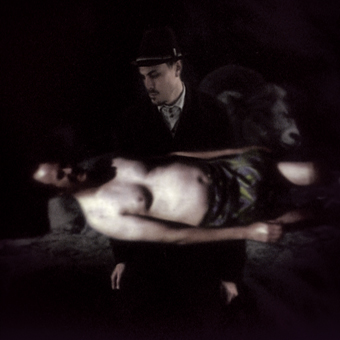
808.838/grandfather paradox, Ms&Mr
image courtesy the artists
808.838/grandfather paradox, Ms&Mr
The same can be said of Ms & Mr’s 808.838 / grandfather paradox, where the dialogue between this collaborative couple binds the work with warmth and humour. The title relates to time travel, wherein the conundrum of going back in time to delete a life or an event, thereby changing your own present so that you cannot do this, remains unsolvable.
Mr’s late grandfather shimmers on a screen facing the entrance. Bearded and naked from the waist up, in advanced middle age, he seems to be standing in water. The image is static, but alive. In diptych is a baby’s face—Mr—in close up, looking towards the grandfather. This old super 8 footage is played with: eyedrops are administered to the baby, whose expression hovers between fear and wonder. And Mr, the artist as he is now, leans down over his grandfather, and pumping his chest, attempts to resuscitate him.
Other elements balance the installation: a rocket shaped screen and one in the shape of a baby in a nappy, on which are projected a litany of images endless and chaotic. From the ceiling hangs a long copper cable—or is it a placenta?—that droops down into a thick coil on the ground. The world, a blank white globe, also receives projections. The space as a whole, as in James’ Amygdala, is used to its full potential in showing how these elements play off one another. Grandfather paradox is an eerie, mesmerising work, deeply personal, with the amniotically ambivalent feel of being trapped, or held, in time/technology/space, or simply in relation to another.
My only qualm was that James’ Amygdala was installed in such a way that did not invite the audience right in. Hovering at the doorway gave one a good, but limited view. On opening night, however, we stepped right inside the work, encouraged no doubt by the size of the crowd pressing into the room. (“Notice how much more fun opening night is”, someone remarked to me, “when it’s full of performance artists?”) The installation from the inside was enriched, apposite: silhouettes of punters’ heads animated some screens. The projections, changing as you walked through them, refracted yet again (perhaps due to the layout of the room, and unavoidable).
Unfortunately I am reviewing this show after it has closed, so if you didn’t go you won’t get to see it. All you will have to go by is the divergent memories of those who did see it. Trust me, Amygdala—Fear Conditioning, Modes of Misunderstanding I & II, and 808.838 / grandfather paradox added up to one of the richest, most stimulating experiences I have had at Artspace in years.
Samuel James, Amygdala—Fear Conditioning, Modes of Misunderstanding I & II; Ms & Mr, 808.838 / grandfather paradox; Artspace, Sydney, Aug 13-Sept 10
RealTime issue #99 Oct-Nov 2010 pg. 54
© Fiona McGregor; for permission to reproduce apply to realtime@realtimearts.net
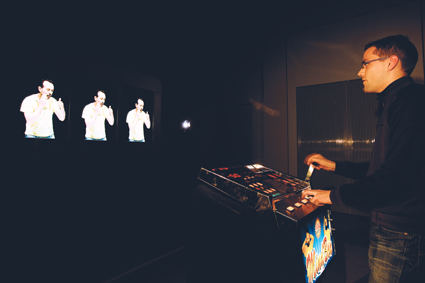
Mindbox, Humatic, SEAM 2010
photo Jürgen Lösel
Mindbox, Humatic, SEAM 2010
seamlessly: action & image
SEAM explores the very latest in technological engagement with performance and the ways that the relationships between art, science and audience are being reconfigured, yielding innovation and “breaking down established distinctions between performer and audience, and between rehearsal and performance” (Press release). Comprising workshops, exhibits and a symposium, SEAM is a collaboration between Margie Medlin, director of Sydney’s Critical Path, Garth Paine of the University of Western Sydney’s VIPRE Lab (Virtual Interactive Performance Research Environment) and UTS.
SEAM 2010—Agency and Action, a public symposium at the Seymour Centre, will include a keynote address from Stelarc, the exhibition of his Articulated Head and other interactive installations. The impressive roster of presenters includes Ruth Gibson (UK), Frederic Bevilacqua (IRCAM, France), Volker Kulchmeister (Germany), Christian Ziegler (Germany), Simon Biggs (UK) and Sue Hawksley (UK), collectively representing some of the more important developments in the contemporary integration of technology and performance in their work with leading artists.
The organisers write that they wish to provide “a resource-rich, stimulating environment for local dancers, choreographers and media artists to interact with local and international leaders in the field of interactive technologies and allied arts disciplines. We want dancers and choreographers to take away with them a raft of new tools, new knowledge, philosophical and performance frameworks, contacts and possible future partnerships in the creation of new or more profound directions within their contemporary choreographic practice.” SEAM 2010—Action & Agency; Public Symposium, Seymour Centre, Oct 15, 16; for workshops and exhibitions see http://seam2010.blogspot.com/p/about-seam2010.html
glow fires again
Chunky Move’s Glow (RT78) has had a long, successful life touring the world, illuminating the possibilities of bringing together dance and interactive media: it now makes a welcome return to Sydney as part of SEAM 2010. This deeply engaging, visceral short work was the first of two Chunky Move collaborations with German interactive video artist Frieder Weiss [RT84]; the second was the full-length work Mortal Engine.
In Glow the audience peer deep down into the dark at a still form that suddenly convulses into life, scattering about it brimming light, staccato geometries and threatening shadows. What makes Glow, a disturbing evocation of evolution and emergence, doubly exciting is that the light is triggered and controlled by the dancer’s movements making light and movement eerily seamless. Chunky Move, Glow, Seymour Centre, Oct 13-16, http://sydney.edu.au/seymour/season/glow.shtml
dream realised: maricor & maricar
Among the the British Council’s five Realise Your Dream scholarship winners this year are Sydney-based designers Maricor and Maricar Malano, twin sisters who have worked for the agency Mathematics, “producing video clips for bands including Architecture in Helsinki for whom they hand-sewed scores of embroidered characters which were later animated” (press release). In the UK they hope to engage with Partizan Lab and Studio AKA and do short technical courses at Central St Martin’s College. As well as introductions, the scholarship provides air travel and $8,000 spending money. Other winners include Melbourne-based theatre maker Samara Hersch, Adelaide theatre director Geordie Brookman and Alice Gage, founding editor of Ampersand Magazine. www.britishcouncil.org
unbelievable yet true
Not In A Million Years is the title of the much anticipated new work from Sydney’s Force Majeure about “almost unbelievable—yet true—stories of people who have survived, endured and created extraordinary experiences during their life time.” Created by the company’s artistic leaders Kate Champion, Roz Hervey and Geoff Cobham, the work will be performed by Vincent Crowley, Sarah Jayne Howard, Elizabeth Ryan and Joshua Tyler. The stories have been plucked from around the world: a man wakes from a coma in Buffalo, USA; a NSW paraglider rides above a storm higher than Everest; in Mexico, “an unlikely athlete sets the greatest track and field record of all time”; and in Scotland a woman’s life is ruined by a lottery win. As ever with Force Majeure it will be through movement and innovative design that these stories will be powerfully realised. Force Majeure, Not In A Million Years, CarriageWorks, Sydney, Nov 17-27, carriageworks.com.au
bold, black, brilliant
That’s the title of the Ilbijerri Theatre Company’s retrospective exhibition, which is currently on display at the Bunjilika Aboriginal Cultural Centre at Melbourne Museum. The exhibition marks the 20th anniversary of Ilbijerri, which was created by Aboriginal and Torres Strait Islander artists in Melbourne in response to seeing non-indigenous theatre companies telling Indigenous stories. From the breakthrough production of Jane Harrison’s Stolen, commissioned in 1992, to the upcoming world premiere of Jack Charles v The Crown (a collaboration between the actor and the playwright John Romeril) at the Melbourne International Arts Festival, the company has toured nationally and internationally, finding resonance and critical acclaim with Indigenous and non-indigenous audiences alike.
The retrospective gives visitors a behind-the-scenes look at life in the theatre company through objects including sets, props and photography from Ilbijerri productions. It’s being displayed alongside From Little Things Big Things Grow, an exhibition about Aboriginal activism in Australia between 1920 and 1970.
20 Years: Bold. Black. Brilliant., curator Ben McKeown,?Bunjilaka Aboriginal Cultural Centre, Melbourne Museum, July 9-Oct 31; http://museumvictoria.com.au/melbournemuseum/
RealTime issue #99 Oct-Nov 2010 pg. 55
© RealTime ; for permission to reproduce apply to realtime@realtimearts.net
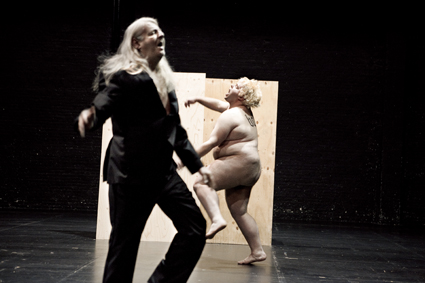
bakchai
photo Danny Willems
bakchai
IT’S USEFUL TO THINK ABOUT THE BODY AS A SITE OF CULTURAL INSCRIPTION. ARTISTS EXPLOIT RECOGNIZABLE SYMBOLS TO EFFICIENTLY COMMUNICATE AN IDEA TO AN AUDIENCE. A THIN, BROWN-HAIRED PERFORMER WEARING NOTHING BUT A CLOTH AROUND HIS GROIN AND A CROWN OF THORNS BECOMES SHORTHAND FOR ‘JESUS’. BUT IF, AS IN THE FAMOUS EXAMPLE OF P.#06 BY SOCIETAS RAFFAELLO SANZIO, THREE CARS FALL OUT OF THE SKY BEHIND JESUS, AND JESUS GETS INTO ONE, AND IF THE BACK END (AND ONLY THE BACK END) OF A HORSE PROTRUDES FROM A DOOR IN THE STAGE-LEFT WALL, THE STAGE SYMBOLS BECOME VERY HARD TO READ. PUT TOGETHER LIKE THIS, WHAT CAN THEY MEAN?
Contrary to script-centric theories of performance that treat stage elements as texts to be deciphered by spectator-readers, many theatre artists insist on the unreadable material presence of the performer—they foreground the body in such a way that the spectator is invited to confront a performer-body as a thing-in-itself, a body you encounter with your own body. At this year’s Het Theaterfestival, a showcase of cutting-edge Flemish and Dutch theatre that takes place in Belgium, more than a few of the shows exploited the body versus word dichotomy.
bakchai
In Bakchai, a free adaptation of Euripides’ The Bacchae, performer-creator Jan Decorte (De Roovers, Belgium) stretches the tension between the readable and unreadable to the breaking point. His stroke of genius is casting Benny Claessens as the god Dionysus. We’re first introduced to Claessens as a marble-white leg that sticks out from behind two rough pieces of plywood tacked up at centrestage. The leg is huge and clearly belongs to an obese individual. Downstage three other performers, including Decorte, play the other central characters from Euripides’ tragedy. The large, unmoving leg might be the limb of a giant. With fearful anticipation I await the appearance of a massive god-body that will devastate the playing field.
Eventually Claessens emerges—naked and with hair dyed gold. He looks like an oversized cherub. At first he has his back to us. Across his shoulder blades is written, in gothic characters, the word ‘body’. This textual signifier is pointing out the thing it signifies, but by nature of being attached to the thing it signifies can’t be separated from it. The body represents itself; so it doesn’t really represent at all, it just is itself. Signifier and sign collapse into one. Of course, Decorte didn’t have to spell it out for us. There’s no denying the body-ness of Claessens’ body.
From the ancient Greek perspective Dionysus comes from exotic, decadent Asia. The sheer mass of Claessens makes the point: there’s too much of him, how did he get to be so big? Surely this is a product of the excess of the East. But the actor isn’t Asian. He’s about as white as they come. So the racial categories are destabilized. Transforming the eastern ‘darkie’ into a western ‘whitie’ highlights the hypocrisy of the western view (ancient or modern) of the Asian as ‘other’ and uncivilized. But even these cultural symbols lose their relevance in the continuing encounter between the spectators and the overpowering presence of the performer. It’s not just his size and nakedness; Claessens is the ultimate tease. He makes a show of being embarrassed by his nudity while playfully manipulating our voyeuristic impulses; he adopts a subordinate role but works it so expertly there’s no doubt about who’s in control of the encounter. With his coy, cherubic teasing, Claessens might be the ultimate child-god in a universe that defies adult rationality. It seems Decorte uses Euripides play to create a childlike game in which the life and death passions of the non-Dionysian characters are made to look ridiculously adult. What’s the queen got up her bum? Why can’t everyone just relax and get some perspective? At least Benny Claessens is having fun. We’re having fun watching him do his thing.
unfold
A number of years ago you might have seen something like Oleanna by David Mamet or a Shakespeare at this festival but they’ve been rare during the four-year directorship of Don Verboven who’s overseen a deliberate shift towards performance that doesn’t privilege the written word. This has provoked accusations of elitism. Turning away from more conventional forms has been seen as a bar to accessibility. The question for an adventurous programmer like Verboven (and the three-member juries that make the selections each year) becomes, “How far can you stretch an audience, and when do you know if you’ve gone too far?” There’s no obvious answer.
Unfold by kabinet K (Belgium) was so far removed from traditional models of theatre and dance that it was unclassifiable. Yet it was one of the most loved shows at the festival. It begins with a young girl standing with her back to us before a gauze curtain that stretches across the stage. She contemplates a column of postcards, letters, and old photographs hanging on the fabric. Behind the gauze another child appears at a microphone reciting a poem in Flemish. Then the first child exits and reappears at a sewing machine behind the gauze. It looks like she’s stitching the postcards into a strip of the same fabric. Not being a speaker of Flemish, I don’t know what the child at the microphone is saying, but about a minute into the poem laughter just sort of falls out of the audience. There’s something very genuine and relaxed about this collective response. Together, the voice of the child, the scenographic elements and the audience’s waterfall of laughter conspire to open me up to the performance event. I don’t know why I’m so full of delight and easy anticipation, but I immediately feel that with kabinet K I’m in good hands.
Images continue to appear and disappear behind the gauze: an adult male carries one of the children across the space, another man performs a brief duet with a third child; eventually the gauze is pulled away and the two men and three children create a tableau. Are they a family of sorts? One of the men picks up an electric guitar and sings a ballad, while the girl returns to the sewing machine. We enjoy a guitar and sewing machine duet. The individuals break off into tasks such as drawing a picture of a house with windows that float away from it or making a tent from a large piece of white cloth on the floor.
One of the highlights is watching the children perform a contemporary dance trio. The technique and choreography are such that the children’s bodies aren’t distorted in the way they are in ballet and some other dance techniques. The movement seems very natural to them, unforced and yet performed by the children with aesthetic focus. It’s the most enjoyable contemporary dance I’ve seen in a while.
There’s a tender balance between the two men and three children: the impression is of a functioning group that has the creative tools and understanding to deal with what comes, including crisis—although there is no crisis presented. Unfold engages us without the necessity of dramatic conflict or even of the angst or cynicism common to so many contemporary dance performances. Children and adults move, invent and sing. To me it feels pre- rather than post-dramatic. It’s as if the children haven’t yet internalized the forms of traditional dramatic structure. Is Unfold about something? The program notes say, “It’s about not being able to understand, and still being happy.”
iraqi ghosts
Maybe not understanding requires a certain kind of spectator—not an elite patron, but one who doesn’t need textual or verbal logic to have a significant performance experience. Brilliantly crafted dialogue, or even brilliantly excerpted text, can prompt a transcendent experience for a spectator. But of course words can get in the way. “Too many words,” was a frequently uttered criticism of Iraqi ghosts (Irakese geesten) by Mokhallad Rasem (Belgium). Part fable, part autobiography, Iraqi ghosts is a wild anti-war rant by five artists, three of whom are survivors of the recent invasion of Iraq. The scenes are presented in Arabic, Flemish and English. Too often they are followed by unnecessary verbal commentary. Occasionally this works in the artists’ favour: a dinner scene, in which non-stop verbiage in Arabic is punctuated by the mutilation of several melons and other parts of the meal, takes an everyday ritual to the heights of hysteria.
For me, Iraqi ghosts was most engaging when the talking stopped completely: in what felt like the eerie silence after a bombing, disoriented figures—actors with large masks over their heads—wandered the stage, dazedly trying to help one another up. The masks had grotesque and mournful expressions
They were bald and elderly, as if the trauma of war had fast-forwarded the aging process. For the first time I shifted from watching someone’s loss to feeling it. Maybe this is the genius of the piece: to bombard us with words so that in their aftermath we sit in horrified silence.
springville
If this edition of the festival needed an answer to the accusation of elitism, Springville by Miet Warlop (Belgium) was it. Instead of a text-driven story, Warlop presents a wordless landscape—by which I mean a large cardboard house on a bare stage. For the duration of the show, Buster Keaton-like antics are performed by a dining room table with human legs, a box that acts like a pet, a man with a double-length torso and the house itself, which gets up, cracks in half to reveal a smaller styrofoam house within. It’s a delightful hour of controlled chaos. As fellow writer Alexander Schackenburg put it, “It’s about nothing, and you miss nothing.” Springville is the best of early cartoon animation brought into the 3D world of the stage.
Het Theaterfestival, Antwerp, Belgium, Aug 26-Sept 4; www.theaterfestival.be
Vancouver-based writer, actor and director Alex Lazaridis Ferguson is part of an international theatre journalism exchange. He and two European journalists are investigating the PuSh International Performing Arts Festival (Canada), PAZZ (Germany) and Het Theaterfestival (Belgium). Articles by the writers are appearing in Urban Mag (Belgium), RealTime (Australia), Plank Magazine (Vancouver) and a forthcoming website dedicated to the project called Performulations (Germany).
RealTime issue #99 Oct-Nov 2010 pg.
© Alex Ferguson; for permission to reproduce apply to realtime@realtimearts.net
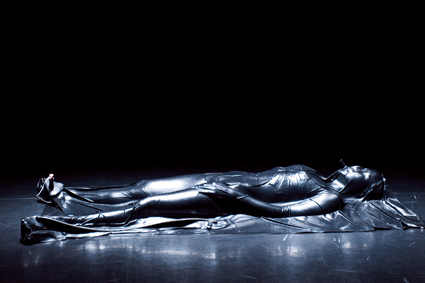
Sylphides
photo Alain Monot, courtesy Montpellier Danse
Sylphides
ANNIVERSARIES ARE A TIME TO LOOK BACK. SOME SIFTING THROUGH THE PAST, ALBEIT IN AN EFFORT TO CLEAR A PATH FOR THE FUTURE IS INEVITABLE. THE 30TH EDITION OF MONTPELLIER DANSE FOUND THE FESTIVAL IN PENSIVE MOOD; CELEBRATING A BRIGHT FUTURE IN THE PROGRAMMING OF FRESH NEW WORK, BUT ALSO RUMINATING, IN WORKS WITH DARKER SUBJECT MATTER, ON DEATH AND THE LEGACY OF DANCE ITSELF, IN AN INDUSTRY THAT HAS LOST MANY BRIGHT STARS SUCH AS PINA BAUSCH AND MERCE CUNNINGHAM IN RECENT TIMES.
bengolea & chaignaud
In the vein of young and fresh came several works by Cecilia Bengolea and François Chaignaud, a French duo currently enjoying a meteoric rise in France. Their first work, Sylphides, inhabited the darker end of things; body bags in fact. Opening on a stage strewn with three large inflatable pillows, it wasn’t long before these seemingly inanimate objects were deflated to reveal the contours of human bodies claustrophobically encased, as if smeared in tar. It was just possible to make out tiny mouthpieces protruding from each body, which allowed a small but vital flow of oxygen. Save for this, the dancers were blinded, pinned down by swathes of fabric, and doubtless restricted in hearing too. Despite these impediments, the prone bodies began seeking out one another, navigating by touch. Sinuous squirms gave way to a slow progression to standing, and finally, to extravagant pogo stick bounces throughout the space.
The success of this work arose from the improbable situation in which the dancers found themselves, and the sinister connotations of bodies helplessly trapped within a physical form. Smothered in bags resembling the receptacles into which many of us will be zipped at the end of our lives, Sylphides shrank things, both literally and metaphorically, to a matter of life and death. Watching the Pompeii-esque tableau unfurl, it was difficult not to fixate on the potential for catastrophe, if a dancer were to faint and drop their mouthpiece. It was hard not to scan for zips (there were none), and exit strategies, and in all this, notions surrounding the entrapment and limitations of the human (and dancing) body hovered. Death, it seemed, was never far away but rebirth too, especially at the work’s end when slowly, gingerly, bags were prised open to reveal a man and two women, quite alive and staring impishly out into the auditorium.
Similarly conceptually captivating, but somewhat limited in realisation was Castor et Pollux, also by Bengolea and Chaignaud. Inspired by twin godheads in Greek and Roman mythology, Castor et Pollux occupied not the stage of Montpellier’s plush Opéra Comédie, but the vast tract of space in the flies above it. Naked from the waist up and smeared in garish body paint, Bengolea and Chaignaud hung 50 feet in the air, knotted together in a sensual clinch. Movements were languid, with bodies fusing to create indefinable shapes. Initially exciting, with dizzying perspective afforded through the staging, Castor et Pollux veered unceremoniously towards the camp and mawkish. The initially ominous score became saturated with squawks and shrieks, relegating the climactic low swooping of the dancers to the category of cheap thrill. Visually arresting, this work seemed to exhaust itself and appeared overly burdened by the mythological depth which its title conjured.
william forsythe: installations
In an entirely different aesthetic vein was a series of videos by renowned choreographer William Forsythe which populated the white gallery space of the Pavillon Populaire. Through visual trickery, and intimate video depictions of Forsythe dancing and interacting with objects, the installations questioned the placement and legacies of choreography. Where in conceptual space does choreography exist for instance—at the moment of execution through movement, or previously? And what remains of choreography once enacted? In pondering the transience of the art of choreography, Forsythe’s installations became tinged with a mildly morbid air, with similarities between the nature of choreography and of human mortality itself all too evident.
One video saw Forsythe enacting a virtuosic solo in black and white. Camera angles varied, closing in on the moving body, severing limbs out of shot, then panning back to reveal the precision of the feet, or the attack and arrest of the torso. This was dancer-as-vessel of the choreography: there was wholeness to the image, a sense of the moving body as the endpoint of a choreographic train of thought. Travelling to the next screen however, one was greeted with a small monitor bearing a recognisable image of Forsythe’s face. To the saccharine lyrics of “Dancing” from the musical Hello Dolly, the mug-shot of Forsythe was severed; fading into sections which disappeared into a haze, only to slowly reform. There was a mesmeric quality to this, with comment gently provided by the incessant lyrics questioning “Now that we’re dancing who cares if we ever stop…”
In a later video, Forsythe abandoned the traditional dance canon to bind himself meticulously in heavy black rope. Two camera angles allowed differing viewpoints of the scene as he entrapped first his torso and then, more disturbingly, his neck, head and face, with imagery becoming increasingly violent. Yells, either for help or of defiance suddenly punctured the space, before the process was laboriously undone; ropes unwinding to release their captive. Albeit in a more confrontational manner, this sequence pursued the line of questioning which the preceding videos began. It attempted to open up the spaces before and after choreography, to question whether it is possible to dislocate the body from the act of choreography, and whether the idea of choreography can in fact exist in and of itself. By pushing his body to physical extremes it seemed Forsythe was testing not only physical capability but the life expectancy of the choreographic act.
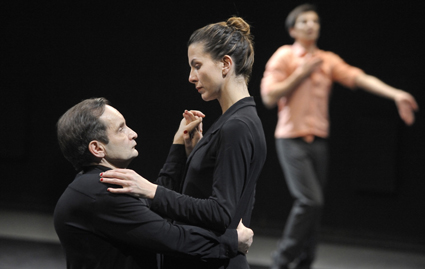
Raimund Hoghe, Astrid Bas, Emmanuel Eggermont, Si je meurs, laisser le balcon ouvert
photo Rosa-Frank.com
Raimund Hoghe, Astrid Bas, Emmanuel Eggermont, Si je meurs, laisser le balcon ouvert
raimund hoghe
From musing on life and death in Sylphides, to the intangible traces of choreography and existence in Forsythe’s installations, came Si je meurs, laissez les balcons ouvert (If I die leave the balcony open), by Raimund Hoghe. Conceived originally as an homage to the late Montpellier choreographer Dominique Bagouet, Si je meurs was an exercise in learning to say farewell, in a world in which, according to Hoghe, “we have the lost the way to say goodbye”.
Often in Hoghe’s work, emotion hovers in the ether, abstracted through an oblique layering of music and deadpan gesture. Here however, it exploded outwards in contorted facial expressions and frenetic choreography. Movement was carved by gestures of defiance rather than wistful doodling, with dancers whirling about the stage in angry or mock-comic froth. A moment halfway through the piece found Hoghe coaching dancer Ornella Balestra in the art of expressing grief. Demonstrating with hands placed on his ribcage, aggressively pushing for more, more, more, Hoghe was eliciting not demure sniffles but vast, wracking sobs and gulps of air from the unfortunate Balestra.
Tracing a progression of loss and grief, the work operated at times on the cusp of frenzy: that wired, angry edge of bodies grappling with insurmountable emotion, seeking oblivion and balm. It seemed an homage not to Bagouet but to grief itself; and to the many ghosts in the dance world. Journeying from funereal tristesse and pious ceremony to the kitsch and wistfully romantic, Si je meurs finally found a bittersweet resting place. During the last moments of the work, the backdrop doors were thrown open to the night, flooding the space with twilight sounds of crickets and the pall of a lone street lamp. One dancer, Emmanuel Eggermont, remained in the fading light. Ever moving, ever dancing, he offered an indelible trace of humanity, and of choreography.
Montpellier Danse.10, Cecilia Bengolea & François Chaignaud, Sylphides, Studio Bagouet, June 30-July 1; Bengolea & Chaignaud, Castor et Pollux, Opéra Comédie, June 27-28; William Forsythe, Installations, Pavillon Populaire, June 22-July 2; Raimund Hoghe and company, Si je meurs, laissez les balcons ouvert, Théâtre de Grammont, June 3-July 1; Montpellier Danse.10, June 18-July 7
RealTime issue #99 Oct-Nov 2010 pg. 29
© Mary Kate Connolly; for permission to reproduce apply to realtime@realtimearts.net
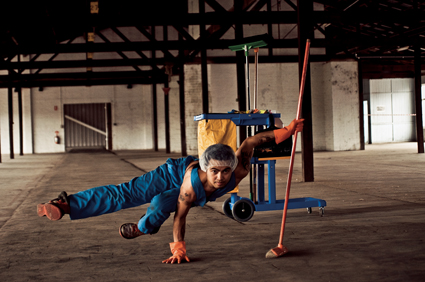
Sweat, Branch Nebula
photo James Brown
Sweat, Branch Nebula
FOLLOWING THE SUCCESS OF PARADISE CITY (see review), WHICH TOURED AROUND AUSTRALIA AND TRAVELLED TO SOUTH AMERICA, SYDNEY-BASED BRANCH NEBULA’S LATEST WORK IS SWEAT, A SHOW ABOUT WORK FEATURING PARKOUR, B-BOYING, FOOTBALL, NOISE ART AND DANCE. I SPOKE WITH THE COMPANY’S DIRECTORS LEE WILSON AND MIRABELLE WOUTERS ABOUT THE SHOW FOCUSING ON JUST HOW IT WAS ENGAGING WITH ITS COMPLEX SUBJECT.
One of the challenges in creating a show about work is how to represent it. Although keen not to give too much away Wilson and Wouters seem to be aiming for a balance between representing work practices performatively and at the same time showing Sweat itself to be a form of work. Potential audiences are advised that there will be no seating and Wilson mentions that sound equipment and lights will also be on the move in the space, “but we wouldn’t want it to be read as a show about setting up a theatre show.”
What’s significant for the directors is that they’re looking at a contemporary notion of work and not in the usually anticipated factory or industrial setting: “We’re concerned particularly with low paid and services industry work that we often see around us, and at the way we engage with these services on a day-to-day basis.” Wilson explains that he’s interested “in the intimacy we can share with someone who’s providing a service for us but at the same time we have no knowledge of them—who they are or where they come from. Through the course of the show we’re interested to bridge that gap.” As for the work itself, “We try to evoke images and associations for the audience without trying to be too specific about particular forms. You might see images of cleaning, for example, but we’re more interested in issues of power and status for the low-paid worker.”
When researching and developing Sweat, Wilson says that the company “played with the idea of integrating the artists’ skills into the physical language of work but found that resulted in a ‘Cinderella’ effect. For example, mopping a floor and then transcending that into a complex choreography may be very beautiful but it just doesn’t seem very realistic. What we’ve tried to do is to have the skills entering into Sweat almost in opposition to the work—as a way of conveying something personal about the performers. It’s a way of connecting with the performers on a human level.” At the same time, says Wilson, “We’re looking at the way self-esteem is eroded by being constantly in service for very low pay and how that can affect workers psychologically.”
Wilson says “in this show our interest is not about relationships between the performers, but between performers and audience. That’s a real challenge for us. We’re very good at creating relationships between different forms, how football and B-boying might have a conversation and so on. But for Sweat, we’re supporting the artists to pursue their own practice and develop their material but also prodding and provoking them to extend that material choreographically.”
As the show’s designer, Wouters is focused on the impact for an audience entering a space without a set as such and with the staging shaped by the movement of performers and equipment. Not only is the work therefore inevitably site-specific but costumes are also important: “There’s the work wear—overalls for grunt-work—and then there’s the service work clothing—pastel colours and whites. The costumes are working really powerfully. The moment the performers put them on, they become something else.
It has to do with the invisibility of the people doing these tasks, like the cleaning that happens around you. It’s like it needs to be invisible, as if we don’t want to notice the people doing it.”
The sound for Sweat is by Hirofumi Uchino. As with the other artists in the show, Wilson says, “We’ve tried not to work with him as a sound designer, but as an artist and a noise musician. But the show is different from a noise gig where you go for an extreme experience—some of what Hiro can do feels like it’s changing your DNA. But he has enjoyed the challenge of working outside that framework. What he does with noise will reflect on the psychological aspects of continuous, monotonous or uncomfortable or dangerous or dirty work. I find that the noise in combination with the material we’re doing really does give a psychological weight to the work and has the power to shift you viscerally.”
Wilson spoke of the company’s ambitions for Sweat: “We’re certainly hoping to reach different audiences and experiment with how audiences react to it. I think it will be a unique experience because there are quite a lot of ingredients coming together, whether it’s intimate choreography performed around you or larger scale technical aspects. There are text-based elements and noise. Then there’s the combination of forms—parkour, B-boying football and dance. It’s a pretty amazing mix of stuff. At the same time I think it’s a challenging work. We haven’t set out to make a necessarily ‘pleasing’ show.” But, adds Wouters, “Although the whole set-up for the piece might be out of the ordinary and not something audiences will necessarily be used to, the actual material is quite accessible—it’s something that’s quite close to everybody’s day-to-day life.”
With an appropriately young, ethnically diverse and talented cast—a Sri Lankan soccer player (Ahilan Ratnamohan), a Colombian performance maker (Claudia Escobar), a Filipino/Spanish contemporary dancer (Marnie Palomares), a Vietnamese parkour/martial artist (David Vo), a Bboy (Erwin Fennis) and a Japanese noisician (Hirofumi Uchino)—and Branch Nebula’s trademark inventiveness, Sweat promises to be a significant comment on and a new immersive look at work.
Branch Nebula, Sweat, co-creators Mirabelle Wouters, Lee Wilson, producer Performing Lines; Performance Space, CarriageWorks, Oct 19-30, www.branchnebula.com; tickets www.ticketmaster.com.au
See the RT Studio entry of Sweat in development
RealTime issue #99 Oct-Nov 2010 pg.
© Keith Gallasch; for permission to reproduce apply to realtime@realtimearts.net
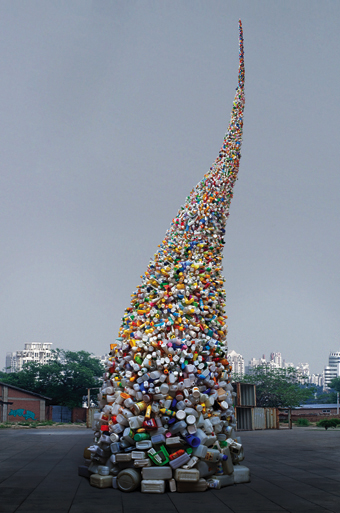
Wang Zhiyuan
b. 1958, Tianjin
Thrown to the Wind, 2010
steel, plastic
photo courtesy of the artist and White Rabbit Gallery
Wang Zhiyuan
b. 1958, Tianjin
Thrown to the Wind, 2010
steel, plastic
IN LEWIS CARROLL’S TALE IT’S THE WHITE RABBIT WHOSE ENIGMATIC CHARM LURES ALICE DOWN THE RABBIT HOLE INTO WONDERLAND. ART COLLECTOR AND PHILANTHROPIST JUDITH NEILSON RIFFS ON THIS SPRITELY CHARACTER’S ASSOCIATION WITH A SENSE OF SERENDIPITY AND SURPRISE IN THE NAMING OF HER WHITE RABBIT GALLERY, A CONVERTED KNITTING FACTORY IN SYDNEY’S CHIPPENDALE DEDICATED TO SHOWCASING A PERSONAL COLLECTION OF POST- 2000 CHINESE ART. STEPPING THROUGH ITS DOORS HAS THE AIR OF ENTERING ANOTHER REALITY, ALTHOUGH GIVEN THE TITLE OF ITS LATEST AND THIRD EXHIBITION, THE BIG BANG, PERHAPS ‘ANOTHER UNIVERSE’ WOULD BE MORE APPROPRIATE.
Here, The Big Bang refers to “the explosion of creativity that has rocked China since its ‘Opening Up’ to the global economy began in 2000.” This hyperbolic premise had me slightly apprehensive I might encounter an exhibition leveraging some of the now commonly hyped assertions characterising discussions of contemporary Chinese art, and in some respects this is what I found. But when the work is this good, concerns over how a show is marketed are best put to one side in favour of focusing on the art itself. Spread across four gallery floors, this eclectic presentation of works from over 35 artists had me enthralled for hours while also considering a broad array of questions around national versus personal identity, alienation in modern life, cultural amnesia and the role of history in present day China and beyond.
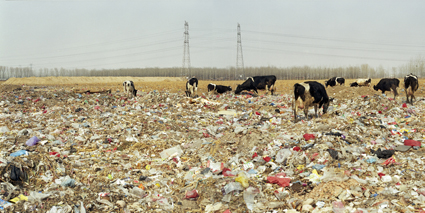
Wang Jiuliang
b.1977, Anqiu City, Shandong
Beijing Besieged by Waste—Guanniufang Village, Xiaotangshan Township, Changping District
40°09’06” N, 116°22’14” E
2009
digital photograph
On the ground floor, two works exploring the flip side of a large population’s increased consumption, its by-product of material waste, stand out for their distinct aesthetic properties. At the rear of the space, Wang Zhiyuan’s spectacular Thrown To The Wind (2010) artfully weaves thousands of discarded plastic bottles around a conical wire frame extending eleven metres to the ceiling, resulting in a whirlwind of waste with a sense of dynamism lent all the greater impact by its overwhelming scale. Nearby, a set of digital prints by Wang Jiuliang, Beijing Besieged By Waste (2009) survey the plethora of garbage dumps that rim the nation’s capital, bringing to mind art writer Carol Diehl’s notion of a “toxic sublime” although the tagging of each photo with GPS co-ordinates emphasises their status as documents. Somewhat at odds with the artist’s environmental campaign is the unwitting beauty in their composition. One image capturing a herd of cows as they scavenge among brightly coloured plastic bags appears almost hyperreal and is eerily tranquil, reminiscent of a traditional pastoral landscape painting albeit with an apocalyptic edge.
Wang Jiuliang’s photojournalism, however, is not characteristic of the majority of The Big Bang artists who prefer to view life through a less literal and more expressionistic lens. Among the most intriguing examples are two mixed media works from multinational Shanghai based art collective, Liu Dao/island6, who work at the interface of art, computers and electronics while seeking to explore “the connections between dreams and waking consciousness.” In Shirt (2009) an LCD screen doubles as a mirror set within a black antique style frame, its surface scratched with finely cross-hatched black lines hinting at an act of vandalism. An infra-red sensor detects the presence of the viewer triggering the projection of an image of a woman onto the mirror/screen where she tries out various poses while dressed in an over-sized men’s business shirt. A witty work, it is also unsettling in its subtle allusion to the voyeuristic impulse that can underscore art viewing and is compelling in its harnessing of technology to delve into the mysterious terrain of desire and the psyche.
The work of Liu Dao/island6 also bears further mention for the way its collective arrangement tests how permeable the boundaries of Chinese art might be. Founded by French artist and curator Thomas Charvériat, now based in Shanghai and drawing artistic collaborators from China, Europe, the US and further afield, this cross-cultural collaboration is certainly a healthy sign of the maturation of the art scene. Yet it also suggests the presentation of contemporary Chinese art may benefit from being geared around more conceptual or thematic lines allowing the work to enter into dialogue with other cultures rather than emphasising its intrinsic “Chinese-ness,” which has become a commodity. This is not to imply The Big Bang is focused on a fixed or historical idea of Chinese art. On the contrary, as its curators point out, much of this work comes from “wired and web-smart products of the one-child policy” who “if their works share a common theme, it is change. And if they have a common perspective, it is ziwo, ‘I myself’.”
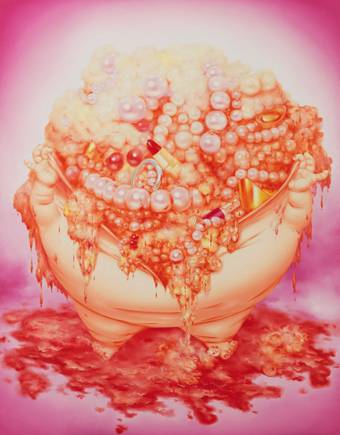
Chen Fei
b.1972, Miaoming, Guangdong
Beyond Satisfaction 2006 No. 2, 2006
oil on canvas
photo courtesy of the artist and White Rabbit Gallery
Chen Fei
b.1972, Miaoming, Guangdong
Beyond Satisfaction 2006 No. 2, 2006
oil on canvas
So then is the individualistic stance of the post-Cultural Revolution generation to be celebrated or deplored? It is a strength of the works on display that a variety of contradictory attitudes emerge. In Chen Fei’s flesh-hued oil painting, Beyond Satisfaction no.2 (2006), the seductive surface belies the grotesque nature of a rotund belly violently split open and spilling forth the shiny goods of feminine desire—pearls, baubles, lipsticks and bands of silver and gold. Clearly here is an artist ill at ease with his society’s relentless desire to consume and accumulate wealth. The attitude of acclaimed photographer and filmmaker Yang Fudong is less easy to pin down. After searching for something sinister in his highly stylised sequence of six black and white film-noir style photographs documenting a well-dressed trio enjoying a night on the town, Ms Huang at M Last Night (2006), it appears the artist is more concerned with challenging viewers to suspend their judgement. As he reflects in his statement “whether you’re filming the life of a rich person or a poor person, there is beauty in both.”
Concluding the exhibition on the gallery’s top floor is a sprawling sculptural installation from Beijing artist Li Hongbo, Paper (2010). Here the artist painstakingly cuts, folds and glues dense layers of brown paper into honeycomb configurations mutating a human figure into a boa constrictor-like form that threatens to engulf the entire space. Dubbed the “slinky man” it is arguably among such supremely confident large-scale sculptural works that The Big Bang really comes into its own. These works might be referred to as “statement pieces” and while some might scoff at the term it is important to remember this is a privately funded collection and as such it reflects an individual’s taste and preferences. Given White Rabbit represents such an extraordinary gesture of philanthropic generosity, this does put up barriers to critique one wouldn’t necessarily encounter in a public museum. Still, where the absence of red tape perhaps weakens the curatorial rigour it also loosens constraints, opening up other opportunities. For viewers, here is a chance to encounter a big, bold and exuberant collection clearly driven by a genuine passion for Chinese art and culture. Certainly the gallery’s label of an “artistic supernova” appears a fitting one.
The Big Bang, White Rabbit Gallery, Sydney, Sept 3 2010–Jan 30 2011; www.whiterabbitcollection.org/
RealTime issue #98 Aug-Sept 2010 pg. web
© Ella Mudie; for permission to reproduce apply to realtime@realtimearts.net
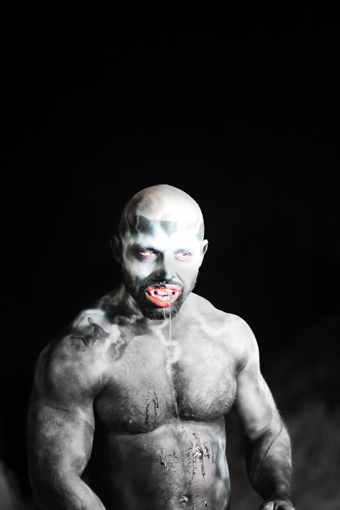
François Sagat, LA Zombie
photo Arno Roca
François Sagat, LA Zombie
AS MARKETING SPIELS GO, MELBOURNE INTERNATIONAL FILM FESTIVAL’S DESCRIPTION OF BRUCE LABRUCE’S LA ZOMBIE CERTAINLY PIQUED INTEREST WITH ITS CLAIM THAT THE FILM FEATURED “PLENTY OF WOUND-SHAGGING AND MORE PENISES THAN YOU CAN SHAKE A STICK AT” (MIFF). EVIDENTLY IT GARNERED ATTENTION FROM THE FILM CLASSIFICATION BOARD, WHICH REQUESTED THAT THE FILM BE SUBMITTED FOR REVIEW AND SUBSEQUENTLY REFUSED TO GRANT CLASSIFICATION EXEMPTION, EFFECTIVELY STYMIEING MIFF’S SCREENING.
Film festivals are normally exempt from the need for certification for the movies they program, as most are unlikely to be released in the domestic market and many will only screen at special events. In recent years it has been rare for a film to be deemed unsuitable even for a festival screening (the last instance was Larry Clark’s Ken Park in 2003, see RT56).
MIFF decided not to contest the decision as the cost of an appeal was prohibitively expensive for the festival (a not-for-profit organisation) and they were advised that any appeal was unlikely to be successful. Further, events happened so close to the festival’s commencement that time factors precluded any appeals process. Technically the film was not banned; rather it was not granted a festival exemption, meaning that it could still be screened if formally classified. Of course the classification process depends on a distributor acquiring the rights, submitting the film for classification and then releasing the film accordingly (with a certificate and perhaps in a cut version)—an expensive, commercial process beyond the financial reach or cultural remit of most film festivals.
The media who readily supported MIFF in 2009, when controversy reigned over the repeated hacking of the festival’s website following its programming of The 10 Conditions of Love, appeared remarkably quiet about the censorship of LA Zombie, dutifully reporting the story and then, apparently letting it die. In the contemporary digital economy it appears to be a given that those interested would probably download the film to watch it. Noticeably, however, the Sex Party’s Fiona Patten drew attention to the censorship of the film as part of a longer ongoing commentary on the issue of censorship in Australia (see press release here).
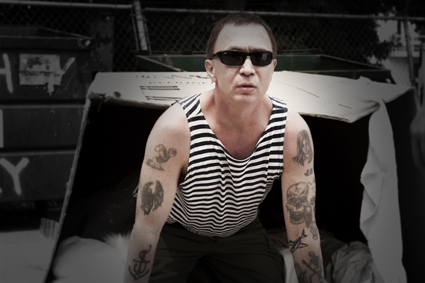
Bruce LaBruce
photo Arno Roca
Bruce LaBruce
FFor those unfamiliar with the director, Bruce LaBruce is an independent filmmaker who emerged from the queer punk scene. His films would no doubt be considered confrontational by those unfamiliar with the radical cinema culture that flourishes beyond the confines of the multiplex screen. His work often depicts sex and has been described as ‘porn,’ although such a description belies its aesthetic velocity and its numerous references to film history and wider radical culture. LA Zombie ups the ante by playing with the horror genre, a form already considered by many as ‘low’ culture. But perhaps the real issue is that the film is ‘gay’. The notion of a same sex zombie ‘porn’ movie is apparently too much for many.
Enter Richard Wolstencroft, the perennial troublemaker of Australian cinema who founded the Melbourne Underground Film Festival when his own work was rejected by MIFF. Since 2000, MUFF has screened cult, genre and underground works, while Wolstencroft himself has frequently railed against the local industry’s more conservative aesthetic and cultural trends. He has authored numerous screeds against what he portrays as the dull and clichéd national cinema in favour of an industry that produces low budget genre movies and radical art house works. Somewhat notorious for his confrontational attitude and his occasionally infuriating pronouncements, Wolstencroft is one of a dedicated handful of curator/commentators anxious to shake up the complacency of many, including their apparent tolerance of censorship. Amongst numerous other ‘infamous’ works, MUFF has programmed Pier Paolo Pasolini’s Salo (1975) and Tony Comstock’s indie lesbian movie Ashley And Kisha: Finding the Right Fit (2007), both of which had been banned.
LaBruce was a festival guest at MUFF in 2004 with his film Raspberry Reich. In the same week that LA Zombie was pulled from MIFF’s program, Wolstencroft announced he would organise a civil disobedience screening in Melbourne with LaBruce’s blessing. While nobody was sure what the police would do, the day before the screening the MUFF director hinted in a Facebook post that he believed the event would go ahead unimpeded, and in the end it did. Ostensibly an addition to this year’s MUFF closing night, the screening took place on Sunday August 29 to a packed house. While MIFF had been unable to fight in this manner, MUFF had publicly declared their decision to stare down the censor.
While rudimentary classification may help uninformed audiences make decisions, censorship is always an ugly beast and should be rigorously fought for reasons of both aesthetic choice and free speech. MUFF rightly challenged the ban. But it did more than this—in beating the ban MUFF has raised some fundamental questions about the way in which films are seen in Australia. Like the low budget genre films that Wolstencroft so often champions, it is the smaller players within Australian film culture that are answering to the challenges of contemporary cinema, the underground and genre festivals, the independent curators and programmers. It is these smaller organisations and individuals that posses the mutability that enables them to respond to events in a manner and at a speed difficult for larger festivals.
Festivals such as MUFF have long fought for freedom of screen culture and should be applauded for their ongoing defiance. More importantly, in screening LA Zombie to an appreciative audience, MUFF has challenged the hegemony of current screen culture. Simply put, if the little guys can fight censorship, then all those who seek an active, lively cinema in Australia should now pick up the challenge and fight to truly free the cinema.
LA Zombie, writer, director Bruce LaBruce, producer Owen Hawk
This article was first published online Sept 20, 2010
RealTime issue #99 Oct-Nov 2010 pg. 26
© Jack Sargeant; for permission to reproduce apply to realtime@realtimearts.net
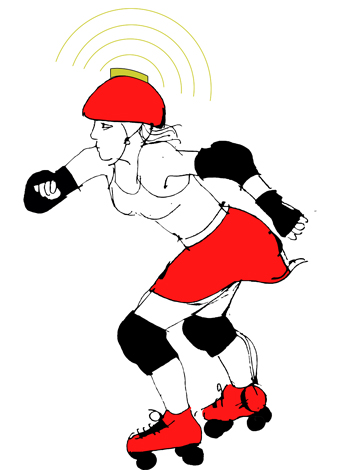
Bloodbath, Bump Projects
image courtesy of the artists
Bloodbath, Bump Projects
blood, sweat and art
In the language of public relations, roller derby is currently having a “moment,” thanks to articles in the Sydney Morning Herald and the Australian as well as Drew Barrymore’s movie Whip It. Bloodbath, however, promises to take roller derby in a slightly different direction.
Conceived by new media artist Linda Dement and billed as a “collaborative distributed artwork,” Bloodbath involves an all girl flat track roller derby game, where sensors are attached to the players. These sensors convey information to a server, which then sends the data on to the five participating artists, who generate their “digital elaborations of the moves and collisions on track” on site and in real time. These elaborations are then projected as the game plays itself out.
Besides Dement, the artists involved include Kate Richards (interviewed in RT80, Sarah Waterson, Francesca da Rimini and Nancy Mauro-Flude, all of whom have track records in new media, data visualisation, mediated performance and work with embodiment or violence. Bloodbath is funded by the inaugural Digital Culture Fund of the Australia Council. Bloodbath, Bump Projects and the Sydney Roller Derby League, Horden Pavilion, October 9, www.bumpp.net
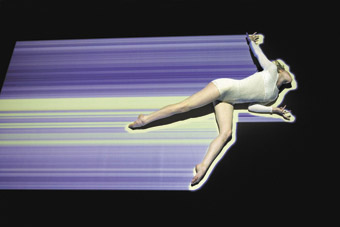
Kristy Ayre, glow, Chunky Move
photo Rom Anthonis
Kristy Ayre, glow, Chunky Move
glow fires again
Chunky Move’s Glow (RT78) has had a long, successful life touring the world, illuminating the possibilities of bringing together dance and interactive media: it now makes a welcome return to Sydney. This deeply engaging, visceral short work was the first of two Chunky Move collaborations with German interactive video artist Frieder Weiss (RT84), the second was the full-length work Mortal Engine.
In Glow the audience peer deep down into the dark at a still form that suddenly convulses into life, scattering about it brimming light, staccato geometries and threatening shadows. What makes Glow, a disturbing evocation of evolution and emergence, doubly exciting is that the light is triggered and controlled by the dancer’s movements making light and movement eerily seamless. Chunky Move, Glow, Seymour Centre, Oct 13-16
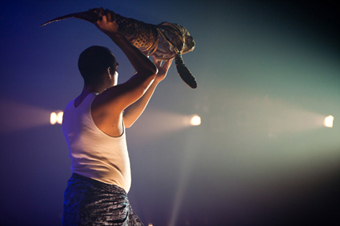
Ilbijerri Theatre Company
photo courtesy of Ilbijerri Theatre Company
Ilbijerri Theatre Company
bold, black, brilliant
That’s the title of the Ilbijerri Theatre Company’s retrospective exhibition, which is currently on display at the Bunjilika Aboriginal Cultural Centre at Melbourne Museum. The exhibition marks the 20th anniversary of Ilbijerri, which was created by Aboriginal and Torres Strait Islander artists in Melbourne in response to seeing non-Indigenous theatre companies telling Indigenous stories.
From the breakthrough production of Stolen, commissioned in 1992, to the upcoming world premiere of Jack Charles v The Crown (a collaboration between the actor and the playwright John Romeril) at the Melbourne International Arts Festival, the company has toured nationally and internationally, finding resonance and critical acclaim with Indigenous and non-Indigenous audiences alike. Along the way we’ve reviewed the company’s Blak Inside season (RT48) and Rainbow’s End (RT66), among others.
The retrospective gives visitors a behind-the-scenes look at life in the theatre company through objects including sets, props and photography from Ilbijerri productions. It’s being displayed alongside From Little Things Big Things Grow, an exhibition about Aboriginal activism in Australia between 1920 and 1970. 20 Years: Bold. Black. Brilliant, curator Ben McKeown, Bunjilaka Aboriginal Cultural Centre, Melbourne Museum, July 9-Oct 31; http://museumvictoria.com.au/melbournemuseum/
made in melbourne
We’ve only just recovered from the Next Wave festival (RT98) but the Melbourne Fringe Festival is fast approaching and the numbers are enough to induce panic: 19 days; 150 venues; and almost 5,000 artists. One of the highlights will be Visible City, which isn’t so much programmed as expected to crop up all over the city at different times and places. It’s described as a “massive cross-artform venture that sees 12 contemporary artists creating new work every day of the festival” (press release).
The artists include some RealTime regulars such as Sarah Rodigari (RT66), Willoh S Weiland (RT88), Lara Thoms (RT76), Jason Maling (RT96) Ingrid Voorendt (RT57), Jennifer Jamieson (RT57) and Michael Yuen (RT66), as well as a few less familiar faces like Rachel Main (Vic), Melody Woodnutt (Qld), Kerry Ann Lee (NZ), Sally Ann McIntyre (NZ) and Joned Suryatmoko (Indonesia).
It’s also worth keeping an eye out for artists who have participated in the Outside Eye development program, run by the Fringe in collaboration with FULL TILT at the Arts Centre and the City of Geelong. This program gives artists 16 hours of one-to-one mentoring with an industry practitioner, the opportunity to attend professional workshops and free space for rehearsal, research and development. This year, the lucky few were Kate Boston Smith, Zoe Robbins, Anne Edmonds, Lisa-Skye Ioannidis, Michael Connell, Linda Beatty, Katrina Rank, Isabel Andrews-Burillo, Sasha Stella, Brodie Maguire, Hoa Pham, Jono Burns, Fregmonto Stokes, Sabrina D’Angelo, Tim Mager, Flynn Hart, Jemma Woolmore, and Justine Makdessi. Melbourne Fringe Festival, Sept 22-Oct 10; www.melbournefringe.com.au/
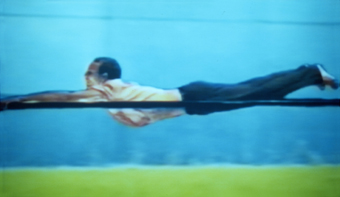
John Meade, Propulsion 2001 (still)
photo courtesy of the artist and Sutton Gallery, Melbourne
John Meade, Propulsion 2001 (still)
objects, diagrams and immersion
Three new exhibitions have just opened at the Perth Institute for Contemporary Arts. First, there is Objects To Live By: The Art of John Meade, featuring works by one of Australia’s leading sculptors (see RT44). Meade’s first major retrospective comprises 17 works ranging in scale from intimate objects on table tops to architecturally scaled wall pieces.
The second exhibition is Love of Diagrams, showing eight contemporary artists investigating “all things diagrammatic.” The artists come from a variety of places—Armando Andrade Tudela (Peru), Bradford Bailey (US/UK), Jose Damasceno (Brazil), Natasha Dusenjko (VIC), Marita Fraser (Australia/Austria), Joyce Hinterding (NSW), Bojan Sarcevic (Bosnia/France) and David Thomson (WA)—and work in a variety of forms including drawing, collage, painting, photography, sculpture, sound art and installation.
Last but not least is Sekilala, the first Australian showing of work by SHIMURABROS, the Japanese brother and sister team Yuka and Kentaro Shimura. Sekilala is a three-screen immersive video installation, shot on super 16mm, filmed in Prague with a storyline inspired by the controversial image of a mouse with a human ear growing on its back. The press release states that “a family drama in which the father is obsessed with bio-furniture erratically unfolds in multiple, fractured stories. Projected onto three screens and randomly configured in 26-shot sequences, the same story is never experienced twice, and the viewer becomes the editor of an infinite and complex film.” SHIMURABROS received the Excellence prize for this work at the 13th Japan Media Arts Festival in 2009. The work has also been shown in Tokyo, Prague and Cannes. Objects To Live By: The Art of John Meade, curator Zara Stanhope; Love of Diagrams, curator Leigh Robb; Sekilala, SHIMURABROS, Perth Institute of Contemporary Art, Sept 11-Oct 24; www.pica.org.au
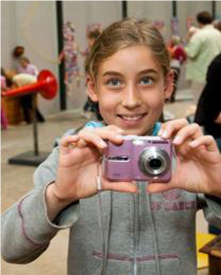
Sydney Children’s Festival, CarriageWorks
photo courtesy of CarriageWorks
Sydney Children’s Festival, CarriageWorks
kids picture the world
The 2010 Sydney Children’s Festival is enticing young photographers and filmmakers to skill up. Benedict Brink’s Digital Photography Workshop focuses on the use of use perspective, colour and natural light to “take a stunning portrait of a friend, capture a landscape masterpiece, or create abstract art out of everyday objects.” In Kyra Bartley’s Make a Film in a Day Workshop participants form a team to “brainstorm and storyboard ideas, cast the actors, hunt for interesting looking locations to film and edit the work to produce the perfect final cut!” In Bartley’s workshop you might end up behind the camera or acting in front of it. In Darryl Cordell’s Picture Us, kids and their families perform to camera to make magical and wacky photographic collages. Sydney Children’s Festival, CarriageWorks, Sept 27-Oct 9, www.sydneychildrensfestival.com
RealTime issue #98 Aug-Sept 2010 pg. web
© RealTime ; for permission to reproduce apply to realtime@realtimearts.net
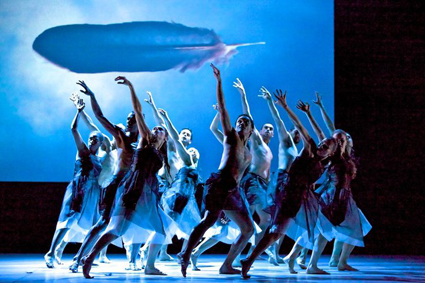
‘Feather’ from Riley
photo Andy Solo
‘Feather’ from Riley
SOFT WHITE CLOUDS DRIFT ACROSS BLUE SKY. OUT OF THE DARK BELOW, ON THEIR BACKS, CRAWLING BUT TORSO AND FACE UP, CREATURES SLIDE INTO DIM LIGHT. THEY WALK, BUT BEND THEIR KNEES TO THE GROUND, ARMS RIGHT-ANGLING OUT. LIKE STRANGE, EMERGENT ANIMALS THEY FORM BENEATH THE IMAGE OF A BOOMERANG AND TWIST, TURN AND ARCH, PERHAPS AT ONE WITH ITS SHAPE AND IMAGINED FLIGHT. THEY STAND, THE BOOMERANG FADES. ANOTHER CREATURE SCUTTLES THROUGH THE DARK AND A LOCUST FORMS BEFORE US, AGAIN ICONICALLY SUSPENDED IN CLEAR SKY.
In Bangarra Dance Theatre’s new season, Of Earth & Sky, the company is introducing a promising new Indigenous choreographer, Daniel Riley McKinley (24 years old, four years with the company) who has chosen as the subject and inspiration for his first major work the cloud series by the late Wiradjuri/Kamilaroi photographer and filmmaker Michael Riley (RT76, p20; RT77, p15). McKinley has selected six of the 10 images—feather, locust, bible, boomerang, broken wing, angel—objects suspended mysteriously in blue skies, and which for him relate most directly to Aboriginal culture. Omitted, for example, is Riley’s jersey cow, an almost comically displaced figure but equally indicative of ruinous environmental and cultural invasion.
Each image is projected onto a large screen behind the dancers and one by one is graphically realized and interpreted. Beneath the locust, dancers’ arms become wings as they cluster in groups and then en masse, to a buzzing electronic score and a riffing, insistent piano. Curiously, the choreography manages to express not only a locust swarm, but also the gestures of those protecting themselves from it in a series of alternations. The plague escalates into highly organized frenzy of sound and movement—straight lines and rapid circles, a fear-inducing army. Just as suddenly it stops. Something else scuttles across the stage.
The Bible, worn leather cover, hovers and a curiously abstract ritual of oppression ensues, hauntingly embodied by Elma Kris and soon multiplied in a row of other women on a diagonal across the stage, gold crosses emblazoned on—or ‘branded on’—their backs. They kneel, hands pushed up behind their backs, as if bound, and their heads drop to the earth. They rise, they stand, walk, go down on their knees as an eerie, distant female choir is heard buried deep in the music. They stand, elbows above their heads, hands behind their heads, palm to palm, like a distorted image of prayer or tortured angel wings, passing before us across the front of the stage and into the dark. The psychological pain induced by an alien religion that converts by bondage is palpable in the sheer otherness of the strange patterns that McKinley makes.
The Bible is replace by a fragmented view of a graveyard sculpture, the Angel. In another powerful episode two men with whitened bodies appear, one borne elegantly on the other’s shoulder, his body in a gentle arc, two bodies as one: is this the Angel? As the carried body extends further out, it’s as if gravity is being defeated. The bodies twist and roles are reversed, carried becomes carrier in the most sinuous of moves, as if on air, in this the most ambiguous of McKinley’s episodes. It’s as if he’s asking, are there angels, divine helpers, and can they be as beautiful and strange as this—and Waangenga Blanco and Leonard Mickelo can answer this for him.
In a mysterious return to the Bible, men in short skirts, the same gold crosses extending the length of their backs, dancing wide-stanced, like Pacific Islanders perhaps, execute obscure tasks, move angularly and fluently dance in a circle of blue light, almost warrior-like in contrast to the equivalent female episode—an image here of some kind of accommodation? McKinley writes in his program note: “The men represent the other side of the religious experience as an exaggerated religious presence.”
The screen turns white. A woman (Jasmin Sheppard) swathed in feathers crawls across the floor to a low cello growl, her body racked, struggling to rise in a painfully exquisite pattern of elaborate moves that seem to engage every part of the body in the effort as Michael Rlley’s Broken Wing image appears on the screen.
Riley’s Feather replaces Broken Wing and the whole ensemble dance: the patterning is formal, the movement light and elegant, no longer saturated with symbolism, animism or literal image-making. As they leave, the dancers gently drop feathers to the floor. McKinley writes that “in Wiradjuri culture, a feather can represent the marking of a journey had…I feel that Riley is my feather, it has connected me to Michael…”
McKinley’s work is sometimes more abstract than the company’s has been, but also at times quite literal, if always about the embodiment of land, animal and spirit and what puts these at risk. There is inventiveness and welcome unpredictability in the choreography, if not always convincingly sustained, and a theatrical assuredness if not always on top of its symbolism. But Riley represents a strong beginning for McKinley’s work with Bangarra and a welcome new vision.
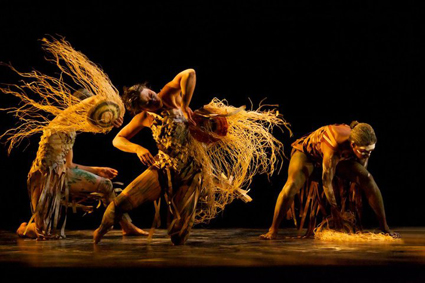
‘Weaving’ from Artefact
photo Andy Solo
‘Weaving’ from Artefact
If McKinley’s Rlley is the sky of the program’s title, Of Sky & Earth, Frances Rings’ Artefact is its earth from the very first image, titled Museum. It’s as if something very alive and alien has sprung from the soil in the form of a large possum cloak that writhes, revealing multiple arms and human legs (Daniel Riley McKinley and Travis de Vries). It’s an astonishing image that gives more than literal life to the idea that this encased museum object once sheltered many people, even across generations; it suggests a spiritual relationship between artefact and wearer and, as Rings writes in her program note, the maker. Artefact is a work of restoration in more than the museum sense of the term.
The next image also astonishes: a pale, out-sized, huge curved bark, such as might be used to carry food, a coolamun, gradually appearing upstage. It will rock, be climbed, turned over, inhabited and appear to float. From it people dance out to forage, the women harvesting with their string bags, the men to grind stones in dances that hover engagingly between representations of making and extended explorations of movement.
In Bodies, the work’s most literal episode, heritage is denigrated by 19th and early 20th century Western attempts to ‘scientifically’ prove that Aboriginal people are an inferior species—the missing link to the Stone Age. If Bodies labours its point with projected images and mechanical movements of measurement to show how Aboriginal people were themselves made museum artefacts, we are soon returned to the magic of objects and their making.
A wary, wide-eyed woman dances sensually in a flowing head-dress and grass skirt and, in Weaving, a huge golden skein of woven pandanus leaves—of women’s making presumably—envelops the men while the women’s dance has been itself a kind of weaving. Then, as often with Bangarra, Artefact concludes communally, if ambiguously. I was left with a rewarding sense of Rings’ restoration of life and spirit to artefacts, their making and makers, realised with Jacob Nash’s design, especially the giant coolamun for its poise and balance, and Gabriela Tylesova’s costumes that so aptly expressed their making.
With its focus on contemporary images and the ancient heritage of artefacts and their embodiment in and through dance, Bangarra’s Of Earth & Sky is an engrossing and thoughtful artistic exploration of a living culture.
Of Earth & Sky is showing at the Arts Centre, Melbourne, September 23 to October 2.
Bangarra Dance Theatre, Of Earth & Sky: Riley, choreographer Daniel Riley McKinley; Artefacts, choreographer Frances Rings; design Jacob Nash, costumes Gabriela Tylesova, composer David Page, lighting Damien Cooper, artistic director Stephen Page; Drama Theatre, Sydney Opera House, July 23-Aug 28
RealTime issue #98 Aug-Sept 2010 pg. web
© Keith Gallasch; for permission to reproduce apply to realtime@realtimearts.net
CD
www.clockedout.org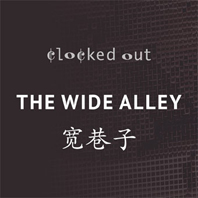
In March 2009 I was entranced by an Utzon Series concert at Sydney Opera House’s The Studio in which Brisbane duo Clocked Out (Erik Griswold and Vanessa Tomlinson) realised a collaboration developed over 10 years with Chinese composer Zou Xiangping and performed with leading Australian and Chinese musicians.
The concert was an entertaining and nuanced exemplar of cross-cultural collaboration. I immediately longed to hear it again, so it was a pleasant surprise to recently receive a fine studio version recorded in Sydney only days after the concert.
The performances lose none of the spontaneity on CD that is requisite for conveying works drawing on and inspired by the traditional street music, opera percussion and folksong of the oldest neighbourhood of Chengdu in China's Sichuan province, melded here with Clocked Out and their ensemble’s Western jazz and avant-garde roots.
As I wrote in my online review of the concert, “Tuning the inner ear,” April-May 2009, “Clocked Out's approach displays a meeting of forms across cultures and musical languages but also allows the musics of Sichuan enough time-space to stand on their own: in the presentation of traditional works, in re-framings of native classics and in wilder experimental fusions where traditional instrumentalists reveal how they can transplant their virtuosity to new terrains.”
My first-hearing responses to the compositions can be read in the concert review. What the CD confirms is just how engaging every composition is and that the performances are uniformly excellent. Soprano Tian Linping not only excels in the soaring vocal style of Chinese opera, but in “Picking Begonias” displays a local style Griswold describes as “a mix of high art with flutter tongue.” As I wrote then, “The effect is of a lilting, gargling trilling complete with astonishing glissandi in a composition replete with passages where flute and erhu (Zhou Yu) intricately entwine.”
Shi Lei’s bamboo flute playing in “Happy Meeting” is magical, the range of notes and effects (astonishingly bird-like in “At Huang Si’s House”) suggest a more sophisticated, much less humble instrument. Zhou Yu’s erhu playing evokes an eloquent, plangent singer in “Two Springs reflect the Moon.” Peter Knight (trumpet), Adrian Sherriff (trombone) and Robert Davidson (bass) provide not only choral propulsion throughout but also moments of reflective lyricism in these democratic compositions.
Griswold’s characterfully spare, incisive piano and Tomlinson’s rich percussion partnering with Zou Xiangping and Zhong Kaizhi collectively provide supple textures and new spaces—the sheer musicality and detail of the percussion is finely captured in the recording of “Sichuan Opera Overture.” As I wrote of the concert version, “Built around gong and cymbals the work engenders rich textures from seemingly limited means, adding timber percussion, then skins, erhu and flute, long bass notes, a call and reply passage and an epic march to the end. The beat is catchy but elusive; as Griswold declares, “the rhythms are unbelievably complex.” Wide Alley was a wonderful concert; now it’s an excellent CD, a tribute to a successful cross cultural collaboration and adventurous composers.
Keith Gallasch
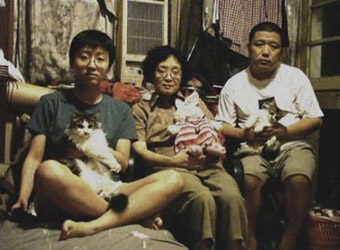
Liu Jiayin, Oxhide 2
[This introduction was written in September 2010. New links will continue to be added to the list below. Eds.]
All nations are more complex than newspaper headlines can ever hope to convey, but few are as bewilderingly diverse, complicated or riven with contradictions as contemporary China. RealTime's coverage of cinematic developments in the People's Republic over the past decade has not only offered a rare glimpse of the evolution of an important popular art form on China's mainland—it has also brought readers' attention to films that offer a Chinese perspective on the history, daily life and social dynamics of this vast and increasingly important country.
China's disparate nature is reflected in its cinema, which encompasses everything from state-sponsored ode-to-the-Party blockbusters—see Mike Walsh's “Mao in the Mall,” RT94—to openly critical DV documentaries. As Walsh wrote in his coverage of the 2010 Hong Film Festival (“Starting Over,” RT97), “Cinema, like most things in China, is expanding rapidly and this expansion is not an easy thing. Film is an arena in which government regulation, market economics and creative expression frequently come into volatile contact.”
RealTime has helped readers explore this complex world by identifying the key filmmakers to watch. Sandy Cameron, for example, wrote a very early appreciation of Liu Jiayin's minimalist portrait of Beijing family life in Oxhide (“A Small Triumph,” RT67), long before the film garnered the recognition that has made it one of the most talked about Chinese features of the decade. More recently, RealTime published the first article in Australia about Zhao Dayong's epic documentary Ghost Town (“Merely Floating in the World,” RT94). Coverage of this important new voice in Chinese cinema continued with Mike Walsh's review of Zhao Dayong's first drama, The High Life, at the 2010 Hong Kong Film Festival.
Zhao Dayong has emerged from the ‘unofficial’ documentary sector that operates outside the tightly regulated production and distribution system overseen by China's Communist Party. The roots of this movement stretch back to the dark days of the immediate post-Tiananmen Massacre years, but it was the arrival of cheap DV technology on the mainland at the turn of this decade that really allowed the unofficial sector to flourish. Since then, filmmakers like Zhao Dayong, Hu Jie, Ou Ning and Zhao Liang have created some of the most incisive, critical and heartrending images to come out of modern China. Their work has been explored in recent articles like “From the Dark Side of Economic Success” (RT97) and “China: Alternative Realities” (RT96).
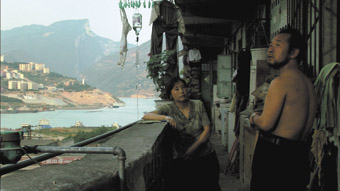
Jia Zhangke, Still Life
If there is one filmmaker, however, whose work best captures the strange, unpredictable conditions under which Chinese people live today, as well as the fraught, ever-shifting relationship between filmmakers and the authorities, it is surely Jia Zhangke. In the past decade Jia has moved from being an unofficial director whose work was banned in China to a recognised artist and recipient of state funding. He has worked across feature-length dramas, short films and documentaries. Through it all he has remained the most consistently creative, discerning and intriguing filmmaker working in China today.
It's a sad indictment of the US and Euro-centric myopia of Australia's mainstream press that this world renowned filmmaker, feted from Beijing to Berlin, Cannes to New York, has barely been acknowledged in Australian broadsheets, despite the appearance of many of his films at festivals around the country. In contrast, RealTime has been able to trace Jia’s development from early notices in coverage of the Hong Kong Film Festival back in 2005 (“A New China Syndrome?,” RT67), to an overview of his career in 2007 (“World Without Bearings,” RT79). More recently, RealTime has published reviews of his latest docu-drama hybrids 24 City (“Where the Truth Lies,” RT94) and I Wish I Knew (forthcoming in RT99).
Unfortunately Jia's absence from mainstream press coverage is symptomatic of a broader, longstanding marginalisation of Asian cinema in Australia. Nearly a decade ago Juanita Kwok wrote in RealTime (“Enter the Dragon,” RT41), “Only three Asian films were released by major motion picture distributors in Australia in 1999, a sad decline from a high of 13 films 10 years earlier.” Although there has been a marked increase in Asian films on Australian screens since that time, there has been scant concurrent rise in mainstream critical interest. As Mike Walsh noted recently (“UnAustralian Cinemas,” RT96), “There is still the assumption that popular sub-titled Asian films… exist within a diasporic ghetto whose walls cannot and probably should not be breached.”
The invisibility of Chinese cinema in Australia’s mainstream press further highlights the importance of RealTime, a publication that doesn’t simply reaffirm what readers think they already know, but rather seeks out the new and unknown. Whether you look at Chinese cinema from an artistic or sociological perspective, the films of recent decades have cast a revealing light on a society convulsed by changes playing out on a scale few of us can really comprehend. Put simply, Chinese films help us understand China. RealTime has helped us understand Chinese films.
Dan Edwards
street level visions: china, the unofficial view
chinese independent docos, melbourne international film festival
RealTime issue #109 June-July 2012 web
monetisation & the new rom-commie
mike walsh: 2012 hong kong international film festival
RealTime issue #109 June-July 2012 p13
riding with dragons
mike walsh: mario andreacchio’s the dragon pearl, ozasia
RealTime issue #106 Dec-Jan 2011 p18
you can’t build on an emptiness
dan edwards: ifchina original studio
RealTime issue #103 June-July 2011 p16
china’s divided screen culture
dan edwards: 2011 hong kong international film festival
RealTime issue #103 June-July 2011 p15
a fistful of renminbi
mike walsh: hong kong international film festival
RealTime issue #103 June-July 2011 p14
shanghai: fractured memories, contested histories
dan edwards: jia zhangke’s i wish i knew
RealTime issue #99 Oct-Nov 2010 p17
from the dark side of economic success
dan edwards: films by zhao liang and guo xiaolu, hong kong film festival
RealTime issue #97 June-July 2010 p16
starting over: new chinese cinema
mike walsh: hong kong film festival
RealTime issue #97 June-July 2010 p15
unaustralian cinema
mike walsh: asian film in australia
RealTime issue #96 April-May 2010 p17
china: alternative realities
dan edwards: the digital documentary filmmaker generation
RealTime issue #96 April-May 2010 p15
merely floating in the world
dan edwards: zhao dayong’s ghost town
RealTime issue #94 Dec-Jan 2009 p22
where the truth lies
dan edwards: jia zhangke’s 24 city and cry me a river
RealTime issue #94 Dec-Jan 2009 p23
mao in the mall
mike walsh: the founding of a republic
art, commerce, action!
dan edwards on the ambitious yunnan new film project
RealTime issue #84 April-May 2008 p17
from chinatown to china
dan edwards on an australia-china animation co-production
RealTime issue #82 Dec-Jan 2007 p20
world without bearings
dan edwards on the vision of chinese filmmaker jia zhang-ke
RealTime issue #79 June-July 2007 p17
cinemas of possibility
dan edwards on new asian films in the adelaide film festival
RealTime issue #78 April-May 2007 p17
emerging chinese cinema
mike walsh at the 2006 hong kong film festival
RealTime issue #73 June-July 2006 p26
high roads to china
mike walsh on chinese cinema
RealTime issue #69 Oct-Nov 2005 p17
a new china syndrome?
mike walsh
RealTime issue #67 June-July 2005 p20
a small triumph
sandy cameron
RealTime issue #67 June-July 2005 p22
an asian-centred australian cinema
mike walsh
RealTime issue #61 June-July 2004 p16
soon: film: the asian-australian connection
RealTime
RealTime issue #50 Aug-Sept 2002 p24
enter the dragon
juanita kwok: asian film in australian cinemas
RealTime issue #41 Feb-March 2001 p13
CD
www.clockedout.org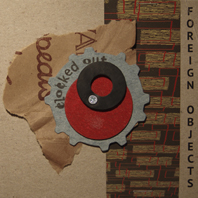
cover and photo Sharka Bosakova
Clocked Out is Vanessa Tomlinson and Erik Griswold, who mesh together beautifully in sound and rhythmic nuance. Tomlinson is a wonderful percussionist, drawing upon an enormous array of things to hit and ways to hit them, and Griswold is a master at preparing the piano and then playing what he has prepared. Foreign Objects is their latest CD. Twelve tracks and 46 minutes. Hand packaged in a cardboard sleeve with a little collage by Sharka Bosakova on the front, each is numbered as something-or-other out of 500.
There are a couple of tracks using the melodica, a theme instrument of Erik Griswold's that sounds like a cross between an asthmatic wheeze and the plastic saxophone that gets broken by the end of Xmas day. I'm not a big fan of the melodica but the tracks grow on me—the chordal pulse of Paniculata bringing back nostalgic childhood memories of warm days, layered curtains, a fly buzzing at the window sill.
But most of the tracks are percussive with melodic fragments. Hold Me Closer sounds like a melancholy twiddle on the piano by the last drunk at an office party, clock loudly ticking in the corner. The jerky a-sync rhythm of Stick This is a vague memory of progressive rock filtered through gamelan repetition, Chinese orchestra and Cageian piano. Toy Feldman brings out squidgy sounds and a music box scratching like a cockroach stuck behind the skirting. Like many of the tracks on the CD there is nostalgia and a certain sadness—an empty room, long held disappointment.
The longest track, at 10 minutes, is Lavendar Mist. It begins with tangled wooden rattling underneath a rapid rhythmic melody that sounds like heavily damped steel drum. Fragments come in and out—hang around for a while, check out the possibilities then go. It reminds me of watching uni-cellular organisms under the microscope as they are buffeted about into Brownian motion.
Throughout the CD, Clocked Out keeps both a sense of regular beat and its fracture, the rhythmic pulse following a wave of acceleration and collapse. There are strange overlays—Griswold might play something dark and rhythmic on piano whilst Tomlinson sounds like she is walking around in a Foley room tapping whatever feels right. This is a real strength of an excellent CD—the coherent layering of consistent and inconsistent attributes into a coherent soundfield that is both abstract and concrete. Walking in the world, leaves crunching underfoot. A stick breaks, loud and cutting through the sound of the music over the ear buds. Things you can guess, things you can't.
Greg Hooper

Refugee Island, Mickie Quick
[This introduction was written in September 2010. New links will continue to be added to the list below. Eds.]
This archive gathers together articles about art that has responded to and represented asylum seekers over the past decade. To a lesser extent it also includes art by refugees themselves. While some art movements are described in terms of war (the avant-garde etc), this one might be better seen as a wave—starting as a minor movement (in 1999), building into something more (from 2000), cresting to reach a critical mass (post-2001), before dropping gently (2005) and receding into the distance (2010), save for an angry swell in the wave of the Liberal party’s “turn back the boats” mantra, with Labor’s “border control” complicity, in the federal election campaign.
Rather satisfyingly, the wave metaphor also redeploys the rhetoric that politicians use when trying to warn us that we are in danger of being “swamped” by a “rising tide”—or better yet a “flood tide,” a “flotilla,” an “armada”—of “illegal immigrants.”
The tactic of redeployment was key to much of the visual art of the period, as evidenced by the culture jamming of Mickie Quick and We Are All Boat People (now boat-people.org). One of boat-people’s members, Deborah Kelly, also co-curated (with Zina Kaye) a more formal exhibition, Borderpanic, which was co-produced by Performance Space and the Museum of Contemporary Art in 2002. In 2003, the computer game Escape from Woomera made headlines when Philip Ruddock and Rod Kemp criticised the Australia Council for funding such a project. Later in 2003, Mireille Astore spent hours on the beach in her installation and performance piece Tampa. Her efforts were then echoed by the SIEV X Memorial, which briefly installed itself at the side of the lake in Canberra in 2005.
Sitting at the intersection of visual art and performance, the durational installations of Mike Parr were also a feature of the period. His painful (re)enactments were unusual in an era dominated by documentary and narrative approaches. The urge to tell one’s story is understandably strong, especially when one has been prevented from doing so by the strict protocols of the refugee determination process or indeed if one has a story about that process itself. Of the many productions that employed this approach, two of the earliest were staged by Urban Theatre Projects: Manufacturing Dissent in 2000 and Asylum in 2001. By 2004, these efforts had started to reach the mainstream, with the Sydney Festival staging Ros Horin’s Through the Wire as a work-in-progress.
Even performances that were not strictly speaking documentary often deployed a documentary aesthetic, such as Bagryana Popov’s Subclass 26A which included snippets of information from application forms and letters. Similarly, Théâtre du Soleil’s Le Dernier Caravanserail—which played at the Melbourne Festival in 2005—also included stories from actual asylum seekers. For their part, Version 1.0 took a slightly different approach, devising a satirical documentary performance CMI (A Certain Maritime Incident) based on the transcripts of the parliamentary inquiry of the same name. Filmmakers also played with the documentary form in films such as Molly and Mobarak (2003), Letters to Ali (2004) and Fahimeh’s Story (2004). Slightly less likely, though no less enjoyable for that, was the comedic fictional film Lucky Miles (2007).
Having just endured another election campaign where ‘floods’ of ‘boat people’ were once again conjured to frighten voters, it is something of a comfort to look back at this archive. This body of work ensures that this period of history will be remembered not only for our punitive policies but also for our artists’ angry and articulate responses to them. Like the policies themselves, these too were performed in our name.
Caroline Wake
visual art
campaign art
caroline wake: art & activism on tv and online
siev x memorial: a pictorial report of the memorial held in Canberra
realtime
tampa microcosm
mireille juchau: mireille astore’s tampa, sculpture by the sea 2003
the meme game: escape from woomera
melanie swalwell
borderpanic remedies
grisha dolgopolov
the artist and the refugee: tooling up for action
bec dean
performance
the refugee’s only currency
caroline wake: powerhouse youth theatre’s mother fish
a shared madness
tony reck at la mama for kit lazaroo’s asylum
chance, dance, animals & the unconscious
philippa rothfield: théâtre du soleil’s le dernier caravanserail
the medium is the audience
john bailey: théâtre du soleil’s le dernier caravanserail
refugees: between reality and performance
kirsten krauth: ros horin’s through the wire
a life between yes and no
mary ann hunter: towfiq al-qady’s nothing but nothing
selves imprisoned and released
philippa rothfield: bagryana popov’s subclass26a
one house, many homes
tony reck: department of human services, mpact, north yarra community health, outside in
version 1.0 shares the shame
bryoni trezise: cmi (a certain maritime incident)
history’s great escape
dan edwards: mike parr and adam geczy’s the mass psychology of fascism, zip-a-dee-doo-dah, zip-a-dee-ay
children overboard: outrage and performance
keith gallasch: version 1.0’s cmi (a certain maritime incident)
the darkness that yields light
keith gallasch: ros horin’s through the wire
cutting through the fog
keith gallasch talks to ben ellis and louise fox about these people
mike parr: internet performance
adam geczy: malevich
bodies at work
keith gallasch: platform 27’s the waiting room
identifying with the refugee
kerrie schaefer: nazar jabour’s no answer yet
sydney & wollongong: atoms and fuel
keith gallasch: claudia chidiac and urban theatre projects’ asylum
degrees of pathos: sydney performance
keith gallasch: urban theatre projects’ manufacturing dissent
film
lo-budget good health
sandy cameron: michael james rowland’s lucky miles
entering the familial web
dan edwards: faramarz k-rahbe’s fahimeh’s story
no time to wait
anna delany talks to clara law
a question of form
jake wilson: clara law’s letters to ali
the documentary: art and survival
tom zubrycki: molly and mobarak
australian filmmakers offer asylum
mike walsh: tales from a suitcase, escape to freedom, anthem
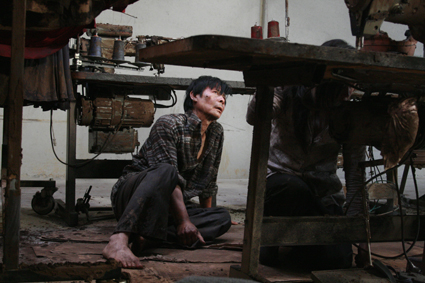
Hieu Phan, Mother Fish
photo courtesy of Titan View
Hieu Phan, Mother Fish
KHOA DO’S NEW FEATURE FILM MOTHER FISH BEGINS WITH A BLACK SCREEN, THE SOUND OF RUNNING WATER AND THE OFFICIOUS TONES OF KEVIN RUDD. THE THEN PRIME MINISTER IS ANSWERING MALCOLM FARR, POLITICAL REPORTER FOR THE DAILY TELEGRAPH AND OCCASIONAL COMMENTATOR ON THE ABC TV’S INSIDERS, WHO IS ASKING ABOUT THE “12 BOATS AND 700 PEOPLE” THAT HAVE RECENTLY ARRIVED AT CHRISTMAS ISLAND AND THE POSSIBILITY OF REINTRODUCING MAINLAND DETENTION CENTRES.
The reply is vintage Rudd (“there’s a purpose-built facility there for that purpose”) but it fades into the background as sound of water grows louder and the camera focuses on a pair of hands washing and chopping vegetables. We hear a voiceover in Vietnamese, spoken in the second-person: “What are you cooking today? You only ever eat greens…You always put too much sugar…I’ll wait for you in the car. Don’t forget to turn the TV off.” The volume on Rudd’s voice increases again and we hear him saying “boats [have] been coming to this country, Malcolm, as you know, since the 1970s.”
From here, we follow the woman (Hien Nguyen) as she drives to work—a small factory with several sewing machines and multiple racks of identical clothing (trendy red checked shirts and long purple skirts). The female voice accompanies her throughout the day and when everyone finally departs in the evening, the woman stays to retrieve a toy monkey that she, or rather the voice, has taken a liking to. The monkey clearly triggers something in her as the present falls away, the past intrudes, and the voice pleads with her to stop.
In an instant the factory transforms into a small boat, with a sewing machine standing in for a motor, a bobbin for a pull cord, and a skirt for a sail of sorts. This rather Brechtian approach, reminiscent of Lars von Trier’s Dogville, is not without its risks but for the most part it works. In this way, Mother Fish effects an unusual reversal: having previously made a rather filmic piece of theatre (RT86), director Khoa Do has now produced a rather theatrical film.
In the absence of actual ocean, the film evokes its presence through camera movement (constantly pitching up and down, as if on a heaving sea) and sound effects (water slopping against the side of the boat, the low drone of the motor). Similarly, the set transforms over the course of the film from a steel-toned workshop—all grey, gold and silver with the occasional shot of red thanks to the bobbins of thread—into a rusted, blasted and scorched shell of itself, barely recognisable under a layer of brown mud.
On board the “mother fish” are the two sisters Kim (Kathy Nguyen) and Hanh (Sheena Pham), their uncle (Hieu Phan) and a young man Chau (Vico Thai). Sailing out of the harbour, the sisters argue about what they have been allowed to bring and what their mother might have packed for them. However the argument comes to an abrupt end when they hear the sound of a patrol boat and shots bring fired. Once out onto the ocean, the journey alternates between boredom and terror. During the dull patches they remember the past (dad’s exploits, mum’s food) and rehearse the future (“you’ll never have to cook again because everything comes in a can: chicken in a can; cow in a can; fish in a can”). However these moments are few and far between as the mother fish and her crew endure horror upon horror: first the boat is attacked by pirates, who rape one sister while another watches; then they are forced to forfeit a precious necklace to bribe an official to tow them into a refugee camp where they are then pushed back out to sea; later Chau jumps ship never to be seen again while Hanh teeters on the brink of death.
These scenes have the potential to be voyeuristic on the one hand or sentimental on the other, but remarkably they are neither. Instead, this film sails straight and true thanks to the immense restraint of both its actors and director. For their part, the actors play the scenes with absolute control: emotion is evoked through little more than a turn of the head, a glimmer of a tear, or a gentle look of affection. What little dialogue there is, is spoken with sensitivity and nuance and Thai’s reading of the line “I’m sorry, I’m sorry” hints at his character’s pain and regret as well as compassion. This emotional and verbal reticence is complemented by Do’s visual restraint. For example, when filming the rape scene, gauze drops down over the lens as if to screen it out. Similarly, when characters are at their most vulnerable and distressed often all we see is a cheekbone, a veil of hair or a hunched shoulder.
In the final scenes, we see the younger Kim washing onto the shore and touching the feet of her older self. Once again the camera hovers over the older Kim’s shoulder as we follow her home. She attempts to cook a meal but unnable to eat she instead goes for what we think is a walk in the park. However, when the camera finally tilts down it becomes apparent that she has walked into a pond and is plunging into the water. Several silent seconds later (the soundtrack is effectively minimalist), her younger sister and her younger self burst from the water, gasping and reaching for one another. In one of the final images of the film, a small hand reaches for a larger, older one and we hear (once again in Vietnamese), “Sister, is that you?”, to which Hanh replies, “I’m here.”
The film finishes with the astounding statistic that between 1975 and 1996, over 1,500,000 people fled Vietnam. Of those, only 900,000 made land meaning that 600,000 were lost at sea, a catastrophe on a par with 1,700 SIEV Xs. Of the survivors, approximately 137,000 came to Australia. It is now 35 years since this migration started, yet it is only in the past 10 or so years that these stories have started to emerge into the mainstream. Think for instance of exhibitions such as the Casula Powerhouse’s Viet Nam Voices (1997), Viet Nam Voices: Australians and the Viet Nam War (2001-03) and Nam Bang! (2009) (RT90) as well as Nam Le’s book The Boat (2008). Perhaps the first generation was so busy surviving that it is only now, as the second generation makes its mark on the world and starts to have children of their own, that these stories can be told.
Intriguingly, Do is also planning to tell stories with and about other refugee communities. Mother Fish is the first in a planned “refugee trilogy” with the second film, Falling for Sahara, already in post-production and the third in the early stages of development. Mother Fish suggests the trilogy has the potential to become an Australian film classic.
Mother Fish, writer, producer, director Khoa Do, executive producer Matthew Riley, performers Kathy Nguyen, Sheena Pham, Hieu Phan, Vico Thai, Hien Nguyen; Australia, Titan View
RealTime issue #98 Aug-Sept 2010 pg. web
© Caroline Wake; for permission to reproduce apply to realtime@realtimearts.net
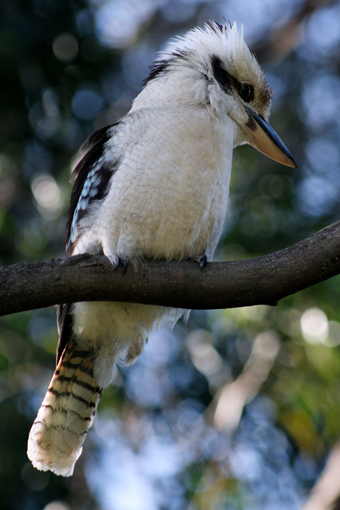
Kookaburra
photo Yorrick (bonehead)
Kookaburra
musical workers
WHEN JAY ‘JP’ PARRINO COVERED MEN AT WORK’S “DOWN UNDER” ON AUSTRALIA’S GOT TALENT IN LATE 2009, ONE COULD WITNESS CULTURE IMPLODING IN MANY WONDERFUL WAYS. EMPLOYING LIVE SAMPLING TECHNIQUES, HE BUILT UP LAYERS OF ACOUSTIC GUITAR TO CREATE A POVERA DIGITALIS TYPICAL OF THE CONTEMPORARY BUSKER. WHILE JP’S DEVICES WERE PERCEIVED AS A NOVELTY BY THE SHOW’S AUDIENCE AND JUDGES, HE EMPLOYED THEM AS MEAGRE USER-FRIENDLY TOOLS, NOT AS FLASHY INSTRUMENTS. HIS MODUS OPERANDI WAS TO LITERALLY BUILD A BACKING FOR HIS VOICE AND ACOUSTIC GUITAR ACCOMPANIMENT.
Performing against and with live looping was instigated by Alvin Lucier in the 60s, developed by Robert Fripp in the 70s, spectacularised by the Young Gods in the 80s, matrixed by Jeff Mills in the 90s and deployed with virtuosity by Battles in the 00s. It’s safe to say that live looping is now a given vernacular in the technological production of music. Occurring within a mainstream context like Talent, JP’s use of the process demonstrates well how musical culture is now shaped. He simultaneously deconstructed ‘the song’ (voiced by Men At Work) and aurally constructed ‘a song’ (voiced by JP). The song this man made through his work clearly connected to both live and televisual audiences by virtue of how deftly he collapsed what was his and what was not. In an era wherein media has moved from saturation to atomisation (from the congealment of large forms to the unleashing of fine particles), performances like JP’s populist yet radicalised rendering of “Down Under” demonstrate how musical texts now implode without losing their identity.
In shows like Talent, the surrendering of the performer to his/her performance marks the event as a social communion for those within earshot. As a desultory figure unconverted to the show’s jingoistic narrative, I try to maintain distance from its Red Rooster-like moniker, its flag-waving set design, its pathetically professional panel, its bug-eyed audience, its predictable swells of applause. Yet I cannot deny the power of song, of singing and of an audience enthralled by a singer’s self-surrendering performance. True to the diacritics of folk culture, JP’s version sets up a dialogue with the original Men At Work version, and the two are empowered by a textual link where the songs speak to each other as much as they speak to me as an auditor of their voices and voicings.
Now, those with refined Rock sensibilities have long made sardonic quips about the numerous competitive TV shows based on Pop musical performance (the global franchises of Idol, Talent etc). But might not the predominance of these spectacles of amateur gumption, innocent drive and hysterical dreaming reveal the role song plays in popular culture? Songs are a particularly dialectal form of expression and intercommunication. The simple musicalisation of argot—of whittling a melody out of a popular epigram—is a form of linguistic sonography born of a living, breathing culture. Words are always at a fork in the linguistic road: they can turn one way to be weighted by their written inscription (the rationalist law of the text) or turn the other way and be airborne by their melodic transformation (the transcendent charm of the song). Say something enough times and it will eventually be sung.
mean larrikins
If there is one demographic watching and listening to Australia’s Got Talent on Channel 7, there must be another one watching Spicks And Specks on ABC. And if the former is defined by the supposedly insidious machinations of the Pop industry’s controlling of audiences incapable of articulating their relation to song other than mere consumption, then the other must be inversely defined. Despite being largely ignorant of the fact that the ABC stole the format for their 2005 show from UK Channel 4’s 1996 show Never Mind the Buzzcocks, the Spicks audience is congratulated on their upwardly mobile shift toward knowing when they are being manipulated and when they are not. The format of the show smacks of puerile academicism—uncomfortably echoing the panels first televised in Channel 7’s It’s Academic in the late 60s. Comedians, of course, are used to distract audiences from such irksome fare, but watching wannabe-cool comedians and grinning presenters fall over each other trying to prove their wit constitutes a far more embarrassing performance than the most inept of Talent’s hopefuls.
There are scant fragments in the televisual stream of Spicks that do not stray from the high-versus-low culture ossification which unwisely emboldens the intelligentsia. The trivia format suits the trivialisation of Pop music in general, while the show’s incorporation of local and select overseas touring musicians fluffs up its notion of ‘real/true/roots/indie/non-mainstream/Rock’ musical culture. It’s a show suited to parents who remember their tertiary education via playlists garnered from JJJ. Like everything on ABC TV, the ideological compaction and congestion of its slanted views, adopted poses and supported truisms make it an insult to bother applying any semiotic reading of its monophonic voice.
But a late 2007 “Children’s Music Edition” episode on the show became unintentionally infamous when one question innocently proposed a melodic connection between the 1934 Girl Guides campfire sing-along “Kookaburra” composed by Marion Sinclair, and fragments of the flute interlude in Men At Work’s international number one song from 1981, “Down Under.’ Less than two years later in mid-2009, the purported owner of the copyright of Kookaburra—Larrikin Music Publishing—claimed copyright infringement of said property and moved to sue the owners of “Down Under”’s copyright—EMI Music Publishing Australia and co-composers Colin Hay and Ronald Strykert.
A lot of press has since danced a predictable waltz around this case: freedom of speech; money-grabbing lawyers; pop music always ripping-off; denial of technical harmonic quotation; ethical averment of fair usage etc. The intersection of the arts and legality exacts such a tiresome charade of grandiose ethics. This case is not about money, music and ethics. It’s about the forced divide between pop culture and folk culture (in shows like Spicks). It’s about how the two are implosions of the other, how they live off the other, and how their mechanisms are now more than ever shared (as in shows like Talent). And it’s about how the intelligentsia slathers ethical-mongering, political-correctness and proscriptive-nationalism on such a public incursion of national identity crisis (as in the Larrikin vs EMI case), rather than provide contextual, critical insight into the deeper issues which shape these cultural ground swells.
thieving magpies
Like the atomisation which now defines ‘war’ as an asynchronous concatenation of disparate events and locations with no holistic sense of convergence or interconnection, ‘cultural wars’ no longer require metaphors based on Great Wars, where notions of frontlines and avant gardes romantically heroicise how individuals contribute to the shaping of culture. This is ultimately a good thing, for culture—from its conservative models of anthropology to its radicalising models of neurology—is best interpreted as noise of the crowd rather than scripture of an author.
“Down Under”’s para-conscious quipping and cribbing of “Kookaburra” can be viewed semiologically (though not ‘legally’) as a therapeutic retort to having suffered the indoctrination of “Kookaburra” in primary schools, where kids were forced to listen to such songs broadcast on ABC radio through PA systems fixed atop the blackboard in a scenario straight out of George Orwell’s paranoid mind. Am I alone in detesting Kookaburra and every single faux-folksy, pseudo-pioneer, colonial-jumbuck, banjo-jangling ditty which the ABC ideologically served up as part ‘children’s music’ and part soft enforcement of a default-leftist, neo-Maoist, pro-Folk, anti-Pop statement of Australiana? Both Kookaburra and the Larrikin copyright claim recall an epoch of reclaiming iconography for a dangerously jingoist, post-convict liberation, with Blinky Bill, the Easter Bilby, Cuddlepie and the Southern Cross rebutting overseas imperialism. (Ironically, it was the populist “Down Under”—through its appropriation by Australia II upon winning the America’s Cup in 1983—and not any folksy tune that sung the praise of Australia internationally.)
When Larrikin sued Men At Work, they impressionistically painted their case like the Eureka Stockade, with true blue Australian Folk music battling the corporate ogre EMI. Larrikin—personified by the APRA-lauded aegis of self-appointed Australian folk historian Warren Fahey—has long wheelbarrowed a divisive and separatist notion of Australian Folk music, often intoned as if a local hero is struggling to gain respect for the unsung songsters of white rural colonial history. Yet if Larrikin adopted a modern, diffusive notion of Folk dissemination, they would realise that their battle was long won once Qantas Airlines forced its boarded patrons to suffer a broadcast playlist of semi-acoustic, pub-rockish, sunburnt country Aussie spirit fodder (remarkably similar to the ‘live’ sounds on Spicks). The risible iconography that attempts to monopolise the Australian voice as one big rural campfire round is as ideologically loaded as chants on Cronulla Beach. When Qantas and their corporate brethren of image marketeers broadly assume the cultural validity of such ‘music of the land,’ it suggests that what Larrikin would claim to be Folk is now the most pervasive form of nationalistic Pop.
The word “kookaburra” comes from the Wiradjuri “guuguuburra.” The voice of the kookaburra underwent indigenous and colonial linguistic translations before the Girl Guides claimed kinship with its song via the colonising practice of western diatonic harmony. While Larrikin attempts to grandstand a mean-spirited sense of folk culture by suing Men At Work as the Girl Guides Association celebrate their centenary, lyrebirds mimic car alarms, bell birds interface with mobile phones, bowerbirds collect plastic bottle tops. And magpies continue their chattering in the magpie culture of music wherein all is borrowed, all is robbed, and all is sung.
RealTime issue #98 Aug-Sept 2010 pg. web
© Philip Brophy; for permission to reproduce apply to realtime@realtimearts.net
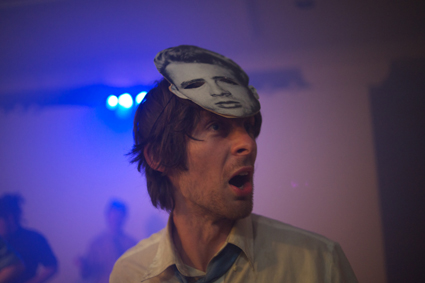
Robbie O’Brien, Room 328
photo Morgan Roberts
Robbie O’Brien, Room 328
MAKE ART. DRINK. VOMIT. THIS WAS THE PUBLICITY BY-LINE FOR THE SHOW WHICH AT FIRST SEEMED UNCOMPROMISING, EVEN UNINVITING. THE QUEENSLAND GOVERNMENT HAS DECREED LOCK-OUTS (OR LOCK-INS, DEPENDING ON WHERE YOU’RE STANDING) FOR CLUBS IN FORTITUDE VALLEY IN AN ATTEMPT TO CURB ALCOHOL-FUELLED STREET VIOLENCE IN THE WEE HOURS. ON A STRICTLY MICROSCOPIC, SOCIOLOGICAL LEVEL, ROOM 328 IMMERSED US IN A TACTILE, DIRECT TAKE FROM A MASCULINE PERSPECTIVE ON CLUBLAND (OR NEVERLAND, AS DIRECTOR DANIEL SANTANGELI EXPRESSES IT, REFERRING TO PETER PAN’S LOST BOYS).
These are Boys with No Sense of Limits, dedicated to the time-honoured prerogative of young males to live fast, die young and leave a good-looking corpse. Some of them, of course, fulfil their wish. The piece represents men’s need to interpose violence in order to protect themselves from closeness and personal connections. On a deeper, more poetic level informing the aesthetic values of the production, the audience was being asked to contemplate the pain of these vulnerable young men as socially constructed, and ultimately to break the rules, men and women alike, of sex and gender. On entering the space each audience member was fitted with a string bracelet similar to those attached to a baby’s wrists to identify them. Each tenuous thread bore a boy’s name. Similarly, later on, we were asked to wear identical, iconic James Dean masks for a re-enactment of the “chickie run” scene from the cult movie, Rebel without a Cause. I danced with a “boy” who proved to be a ‘girl’, a kind redhead who forgave my clumsiness for a while before moving on to dance with a “girl.” (But real men don’t dance, do they?)
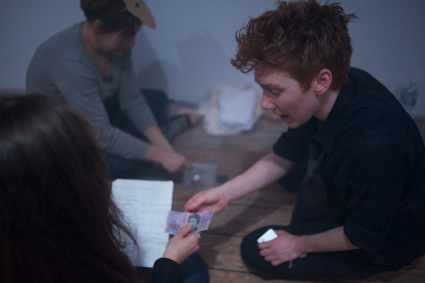
Erica Field, Room 328
photo Morgan Roberts
Erica Field, Room 328
Part dance theatre, part performance art, part installation, the ambient club atmosphere and Willmett’s live sound mix wove together these levels of meaning for the spectator who was free to wander at will. Sometimes the action coalesced round set pieces: the coronation of a king with a cardboard crown; a performer being cling-wrapped to a pillar; the multiple deaths of River Phoenix. Sometimes the audience participated in actions designed to point up our shared humanity
In a poignant ending the mood shifted from all this masculine psychic and physical turbulence to one of pervasive quietude. A sense of peace emanated from the now liquid keyboard tones of Willmett’s soundscape as the performers were winding down. This was a perfect analogue for wandering outside and greeting the dawn with the clear-eyed sense of purgation I’m sure most of us have experienced at one stage of our lives, after an orgy of too many drugs and too much alcohol. It struck the note of absolute, shared verisimilitude I had been searching for throughout the performance. The redhead with whom I’d danced removed the bracelet denoting my spurious masculine identity, freeing me to leave the building reborn, at the same time holding my hand and gaze in an intimate, naked exchange that was delicately touching. But it was still early. I wanted to be contaminated. I wanted a drink.
Room 328 is representative of a new, thoughtful generation of performance makers in Brisbane who are breaking new ground. Three years in the making, this was the first public viewing of a work presented by director Daniel Santangeli and producer Genevieve Trace who have pulled together an impressive line up of their peers including Expressions Dance Company’s choreographer-in-development Liesal Zink, bass guitarist and keyboard player Mike Willmett from local Indie band My Fiction, and local interior designer Elise Terranova. Many of the Room 328 performers trained at SITI Company in New York, founded by Anne Bogart and Tadashi Suzuki. The sheer diversity of talent involved in this ensemble production delivered something pretty amazing.
Room 328, director Daniel Santangeli, designer Elise Terranova, choreographer, Liesal Zink, sound designer Mike Willmett, presenters Allies of Metro & Genevieve Trace; The Galleries, Metro Arts, July 6-10
RealTime issue #98 Aug-Sept 2010 pg. web
© Douglas Leonard; for permission to reproduce apply to realtime@realtimearts.net
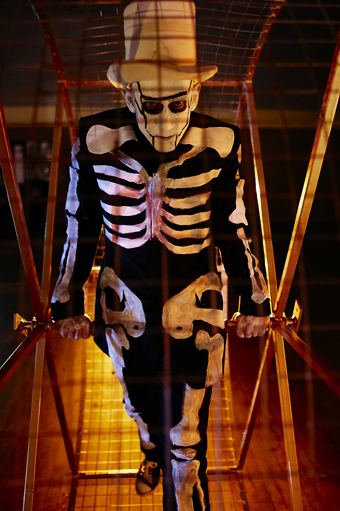
Aerialize, Clammy Glamour From the Curio-Cabinet
photo courtesy of the artist
Aerialize, Clammy Glamour From the Curio-Cabinet
sydney styles a fringe
Unlike Melbourne and Adelaide, Sydney has been without a fringe festival in recent years, putting it on the fringe of the fringe so to speak. However, this is all about to change with Kris Stewart’s inaugural Sydney Fringe Festival. Sensibly, the initial festival is based where its artists are—in the city’s inner west. Stewart states that around 60% of the program is from artists working in and around the Newtown area. Even if you’re living there, you’re unlikely to get to all 200 events so you could focus on theatre or visual arts or the intriguing category marked “other events.” Or you might like to choose a venue such as CarriageWorks, PACT or the Addison Road Gallery and stick with it. You could choose an already widely acclaimed show like Elbow Room’s Tiny Chorus, or a company like Newcastle’s Tantrum Theatre that you’ve seen praised in RealTime, or seek out Aerialize (http://realtimearts.net/article/issue82/8802) who train many young circus and physical theatre performers. Aerialize will be staging Clammy Glamour From the Curio-Cabinet, directed by underground cabaret star Annabel Lines and Legs on the Wall associate Simone O’Brien. The show is billed as “an aerial tale, sparkling ominously in the half-light of a strange and disturbing doll’s house” (press release). Sydney Fringe Festival, September 10-26, http://thesydneyfringe.com.au/; Aerialize, Clammy Glamour From the Curio-Cabinet, CarriageWorks, Sept 15, 16, 17, 23
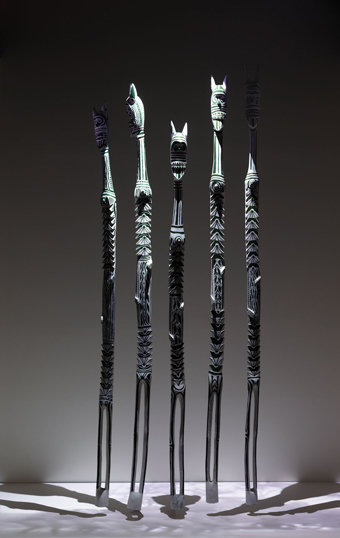
Mokuy, Nawurapu Wunungmurra
photo courtesy of the artist
Mokuy, Nawurapu Wunungmurra
making new media indigenous
The 27th Telstra National Aboriginal and Torres Strait Islander Art Awards (NATSIAA) have been announced. There is some extra excitement this year as NATSIAA has introduced a new prize category in recognition of the growing number of Indigenous artists who are embracing new media as part of their artistic practice. Previously, such works fell into the Wandjuk Marika 3D Memorial Award category (http://www.realtimearts.net/article/issue87/9154). The inaugural Telstra New Media Prize has been awarded to Nawurapu Wunungmurra for his work Mokuy.
Mokuy (spirit) is an elegant sound sculpture with video projection that evokes images and sounds of the coming together of spirits associated with sacred yams, “Morning Star feathers,” scrub fowl and doves at the sacred ground called Balambala: “The Yirritja mokuy come in on the birds djilawurr (scrub fowl) and bugutj-bugutj (banded fruit dove). The Dhuwa mokuy, they come in from rangi side (saltwater).” [http://www.nt.gov.au/nreta/museums/exhibitions/natsiaa/index.html]
The Telstra Award and General Painting Award went to Mr Donegan for his work Papa Tjukurpa, Pukara. Other winners included Glen Namundja for Kunabibbe Ceremony at Manmoyi (Telstra Bark Painting Award), Dennis Nona for Saulal (Telstra Work on Paper Award) and Wukun Wanambi for Bamurrungu (Wandjuk Marika Memorial 3D Award). If you can’t get to the Museum and Art Gallery of the Northern Territory in Darwin to see these and the rest of the 96 pre-selected works go to: www.nt.gov.au/nreta/museums/exhibitions/natsiaa/
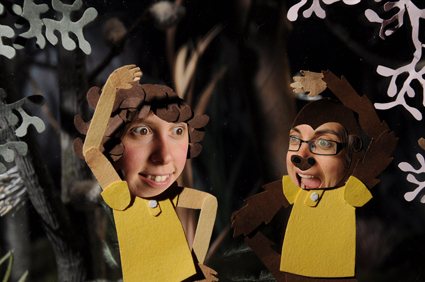
Isobel Knowles and Van Sowerwine
Australia, You Were In My Dream (still) 2010
photo courtesy of the artists
Isobel Knowles and Van Sowerwine
Australia, You Were In My Dream (still) 2010
van sowerine & knowles: winning interactivity
In other media arts news, Victorian artists Isobel Knowles and Van Sowerwine have been announced as the winners of the 2010 Premier of Queensland’s National New Media Art Award, which includes $75,000 prize money. The judges praised their entry You Were In My Dream as “a playful work that offers a rare combination of interactivity, narrative, and nostalgia.” Saige Walton wrote in her review for RealTime of Experiment’s Utopia Now exhibition: “You Were In My Dream is a glorious stop-motion animation that recalls media art history from the vantage point of the present. Functioning as equal parts perspective box, reflective display and interactive installation, the visitor is seated at a booth and provides the stand-in face for a child protagonist (fed live into the animation)” (RT96)
The judges also highly commended Wade Marynowsky’s (NSW) work The Discreet Charm of the Bourgeois Robot 2 2010 as “enchanting, poetic and unnerving” (press release). Other artists short-listed for the 2010 Premier of Queensland’s National New Media Art Award and featured in the exhibition are: Philip Brophy (VIC), Nigel Helyer (NSW), Chris Howlett (QLD), Soda_Jerk (NSW) and Lynette Wallworth (NSW). Their creations are on display at the Gallery of Modern Art in Brisbane. Danni Zuvela will review the works and the judge’s decision in RealTime 99. You can read about the inaugural New Media Art Award in our archive here. Premier of Queensland’s National New Media Art Award 2010, Gallery of Modern Art, Brisbane; http://qag.qld.gov.au/
historical, personal, material, ephemeral
While at GoMA you might also like to see the work of Simryn Gill, whose exhibition Gathering is on display until mid-October. Gill’s work explores the intersection of the historical and the personal, the material and the ephemeral. Bec Dean has previously described her work as “deeply engaging, commanding a gentle seeking of her audience, and a willingness to explore that is no less compelling than the immersive, sensory video installations of Stan Douglas and Bill Viola” (RT42). Gathering consists of a selection works from the past five years, including key photograph series such as May 2006 and Run, the book-based installation Paper boats, as well as Untitled (interiors), a series of bronze sculptures cast from drought cracks in western New South Wales. Simryn Gill: Gathering, Gallery of Modern Art, Brisbane, Aug 28-Oct 17; http://qag.qld.gov.au/
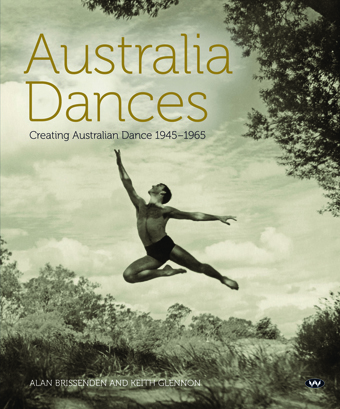
Alan Brissenden and Keith Glennon, Australia Dances: Creating Australian Dance 1945-65
australian dance: the formative years
This handsomely produced book from Adelaide’s Wakefield Press is a groundbreaking account of Australian dance as it took shape, in ballet in particular, between 1945 and 1965. It was a long, hard struggle to build ongoing companies, train Australian dancers and, often most challenging, to create original Australian works. But within a mere 20 years (and with the impetus of the huge popular taste for ballet built by the pre-WWII visits of the likes of de Basil’s Ballet Russes), the Australian Ballet was formed, performing alongside some of its state antecedents.
Written by Alan Brissenden and Keith Glennon, Australia Dances is packed with wonderful black and white photographs, colour plates of set and costume designs (fascinating for their correlation with contemporary art movements) and vivid accounts of a multitude of individual works—replete with eye-witness recollections. Regional companies, dance studios, educational strategies and eisteddfods are given their due, as is Aboriginal dance—the authors highlight the role of the 1961 Darwin Eisteddfod, which included a performance by 15 Aboriginal people, in triggering touring of traditional Indigenous dance by the Australian Elizabethan Trust in the early 1960s. In a country largely bereft of serious, accessible documentation of the performing arts, Australia Dances is exemplary of the kind of books Australian artists and their audiences warrant. Alan Brissenden and Keith Glennon, Australia Dances, Creating Australian Dance 1945-65, RRP $70, www.wakefieldpress.com.au
australian media arts: dream in beijing
Dream Worlds: Australian Moving Image 2010 is a collection of media artworks curated by Melinda Rackham, former director of the Australian Network for Art and Technology and occasional RealTime contributor. It features works by Daniel Crookes, Anita Fontaine, Warwick Thornton, Kate Richards, Jess MacNeil, Troy Innocent, Chunky Move and Peter Miller. Each work is roughly three minutes long with the entire program screening every half hour on large format, open air video display in Sanlitun Villagein Beijing. Dream Worlds: Australian Moving Image 2010, Beijing, Sept 4-Oct 16; www.dreamworlds.com.au
RealTime issue #98 Aug-Sept 2010 pg. web
© RealTime ; for permission to reproduce apply to realtime@realtimearts.net
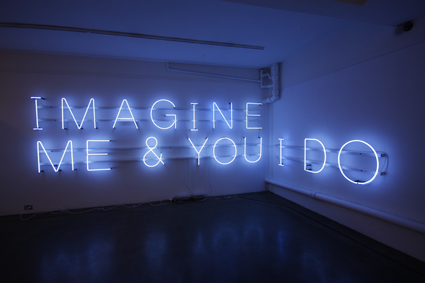
Kirsty Hulm, Imagine Me & You I Do
photo courtesy of the artist and Criterion Gallery
Kirsty Hulm, Imagine Me & You I Do
THE UN-VICTORIOUS EXHIBITION IS ONE OF THE MOST INTERESTING, IF SOMEWHAT ELUSIVE, THAT I HAVE SEEN AT CRITERION GALLERY, ARGUABLY THE BEST COMMERCIAL GALLERY IN HOBART AND THE ONLY ONE IN THE CBD. CRITERION HAS BEEN IN BUSINESS FOR ABOUT SEVEN YEARS NOW (THOUGH SOMEHOW IT STILL SEEMS NEW) AND CLEARLY HAS A POLICY OF FOSTERING TASMANIAN AND AUSTRALIAN ARTISTS WHOSE WORK IS “OUT THERE,” WHETHER THEY ARE EMERGING OR ESTABLISHED. THIS MAKES FOR A VARIED AND REWARDING RAFT OF SHOWS—GRAFFITI ART, DIGITAL PRINTS, AND VIDEO AS WELL AS SOME MORE TRADITIONAL MEDIA.
The Un-Victorious is no exception. It has a sparseness that works well in the pristine, relatively small white cube that is the Criterion. It is a three-hander show featuring Victorian artists. Kirsty Hulm’s work is a neon light installation of text and the other element of the show, bejewelled mock-ups of military medals, are the result of a collaboration by Andrew Hustwaite and Anna Varendorff. The catalogue cover shows Kirsty Hulm’s 2008 neon sign work Imagine Me & You I Do installed on the exterior of a dark, gothic-looking church, so nothing could be more different than the Criterion display, in which the neon words snake 90 degrees around two white gallery walls. In both sites Hulm’s large-scale work is strikingly beautiful, not a little eerie and certainly evidence of the artist knowing how to work with her medium. The source of the title eludes me—certainly it is from some 60s or 70s pop song and the catalogue essay talks of “the harlot’s sultry call from arms to the bed ‘Imagine me and you … I do’.”
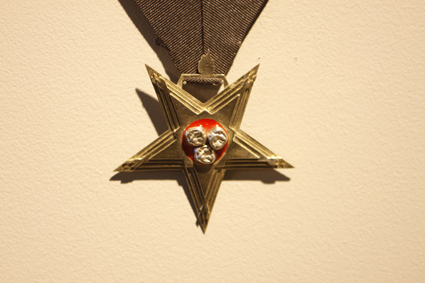
Andrew Hustwaite and Anna Varendorff, Proposition 1-5
photo courtesy of the artists and Criterion Gallery
Andrew Hustwaite and Anna Varendorff, Proposition 1-5
Hustwaite and Varendorff’s series of five very authentic-looking medals, complete with differently coloured ribbons, are hung in a V formation. They are very aesthetically pleasing objects and are made from materials such as nickel, copper and brass with silver plating and amalgam. Going by the names of Proposition I-5, they would have taken considerable skill to manufacture. Varying in size and hue, the medals are generally star-shaped and, taking up two panels in the gallery, make an exciting installation. They are eminently collectible, eminently desirable and titles such as “Above and Beyond the Fall of Duty” convey an unmistakable anti-war message.
The catalogue essay, by Jess Nossiter, is outstanding. Nossiter is a (presumably) self-styled Chevalier de la Manchette and “writer and flaneur based in Hobart,” though this city does not immediately strike me as the milieu for the flaneur. His essay is a work of art in itself—a piece of writing quite beyond definition or categorisation—Hunter S Thompson meets Lewis Carroll perhaps: wryly amusing, intellectually rigorous with a touch of soft porn! Nossiter touches on sex, popular television culture, reality TV, capitalism and, cynically, love. He concludes, “Love is a capitalist construction, an exchange of commodities. Littered with prophylactics, and the air filled with blank shots—love truly is a battlefield.” More significantly, the essay draws together two very different works and gives them a unity, without which the show would be even more elusive.
The intimate gallery space of the Criterion is an ideal venue for what is, in fact, a very small show. It would probably not have worked in a bigger venue, but then the curator Sarah Jones has clearly chosen the works with the Criterion in mind. Remarkably, Jones only received her BFA in 2007 and has since participated in several shows at Hobart venues. Last year she was the recipient of the Contemporary Art Services Emerging Curator Mentorship. For The Un-Victorious she has done a fine job discovering and promoting the three artists, not to mention the essayist. Like Jones, the artists and writer have themselves only recently completed their degrees or are still undertaking them. With the quality of works in this show being so high, it augurs well.
Kirsty Hulm, Imagine Me & You I Do; Andrew Hustwaite and Anna Varendorff, Proposition 1-5; curator Sarah Jones, The Un-Victorious, Criterion Gallery, Hobart, June 10-July 3 http://www.criteriongallery.com.au/
RealTime issue #98 Aug-Sept 2010 pg. web
© Diana Klaosen; for permission to reproduce apply to realtime@realtimearts.net
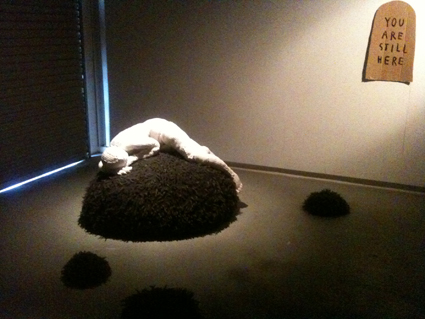
Elizabeth Dunn and Jessie Hall, (please give: it a moment)
photo Nicholas Mills
Elizabeth Dunn and Jessie Hall, (please give: it a moment)
NOW IN ITS SIXTH YEAR, THE ON EDGE FESTIVAL IN CAIRNS IS INSTRUMENTAL IN INTRODUCING NEW WORKS TO NEW AUDIENCES IN FAR NORTHERN QUEENSLAND. THIS YEAR’S PROGRAM, CURATED BY NICHOLAS MILLS, INCLUDED SOUND ART (LIQUID ARCHITECTURE), VIDEO ART (CAO FEI) AND DANCE ON SCREEN (REELDANCE) AS WELL AS PERFORMANCE WORKS. THREE OF THE PERFORMANCE HIGHLIGHTS WERE ELIZABETH DUNN AND JESSIE HALL’S (PLEASE GIVE: IT A MOMENT), POST’S SHAMELESSLY GLITZY WORK AND NICHOLAS MILLS’ OWN 2WHYTE. FOR ME, EACH OF THESE WORKS HAD A REFLECTIVE QUALITY AND MINED THE INNER WORLD OF THE SUBJECT FOR MATERIAL.
(please give: it a moment)
Wallwork Studios has been transformed into an interactive obstacle course. As I enter, I am handed a conical mask with hand-drawn features, suggestive of a shy creature that spends a lot of time in the dark. Wearing this makes me feel as though maybe I too will find a bolthole in which to hide. This is (please give: it a moment), where each audience member becomes the work’s subject via their physical engagement with it. Created by Cairns’ artists Elizabeth Dunn and Jessie Hall, it is fresh from the Next Wave festival in Melbourne.
Other masked creatures inhabit the space. We are guided past fabric mounds and along the way encounter a larger crafted hillock where a life-sized figure made from wool curls like a cat in repose. We move on to a table where we are invited to partake of a conversation conducted entirely via pen and paper. Tea is offered, along with written advice and the messages then affixed to the studio wall—as a sort of ‘moodboard’ of the soul. It’s tea and sympathy and the writing is on the wall.
We are then gently coerced into a cubby constructed of translucent paper, with moving images projected on the back wall. These are landscapes, seemingly shot at twilight from the window of a moving vehicle. By now, I am overtaken by the persona of the mask; I become a kind of hybrid creature that scratches at the door of both human and animal worlds, and it seems that I am viewing these images through new eyes. They offer up a whole new world of opportunities, should I find the courage to step over the threshold of my hidey-hole and venture into the beyond.
(please give: it a moment) is a refreshing take on the interactive installation form, where participants experience a nuanced and subtle trip through the psyche, like animals being coaxed from a subterranean burrow.
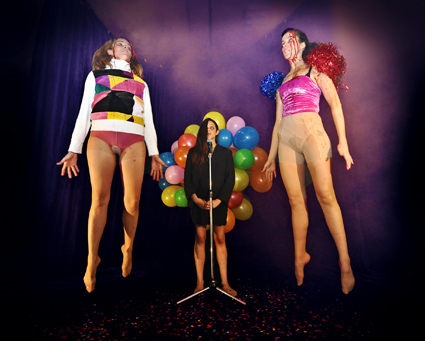
Post, Shamelessly Glitzy Work
photo James Brown
Post, Shamelessly Glitzy Work
shamelessly glitzy work
This offering from Sydney’s Post has had rapturous receptions in Sydney, Melbourne and Brisbane, so it was a sweet treat to see it in Cairns. The piece itself, however, was not without some deliciously tart satire. To open, three sparkly, spangled magicians tease us for an extended time at the microphone with inhalations, lip smacking and inane smiles. What follows is a series of faux magic routines where the performers build up our expectations for the big showstopper to reveal…well that the performer is wearing a patchwork jumper identical to the one she has just removed. The performer gestures “Ta-da!” all the while looking at us knowingly.
As the show progresses, there is a meditation on the rave scene replete with glitter in the laser lights and an account of an incident outside a nightclub where a woman, a self-described melange of Bonne Bell, Maybelline and feminine hygiene spray, considers an offer from a potential suitor. She tells us, “Guys in Barinas have yelled at me before, but this was different.” There are ruminations on contemporary security policies too, where nameless organisations reminiscent of George Orwell’s Thought Police encroach on civil liberties. The performers describe a quasi Big Brother state where the control of one’s mind and fast food choices—“I’ve got the fish burger in my hand, but I really wanted a chicken burger”—rates as serious social concern.
The centrepiece of the show is a vignette where the performers bounce for over 10 minutes to techno music while one boozily bawls “C’mon ladies!” This slowly turns into a wet t-shirt competition and then something more sinister where blood pours from mouths of the ‘contestants.’ This act is chilling in its evocation of sexual objectification and abuse, reinforcing the idea of performance as a political act that can both challenge and reassert structures of power.
The writing is a revelation in a formal sense; all that is said in the first half of the show is repeated in the reverse order in the second. As well the characters constantly allude to the audience’s presence through eye contact and gesture. This staginess, or self-conscious awareness of what Peggy Phelan calls performance’s “maniacally charged present” (Unmarked, Routledge, 1993), is echoed in the performers’ oft-repeated line: “I definitely feel something.” I felt something too, Post, and even if you were being ironic you were generous enough to let us in on the joke.
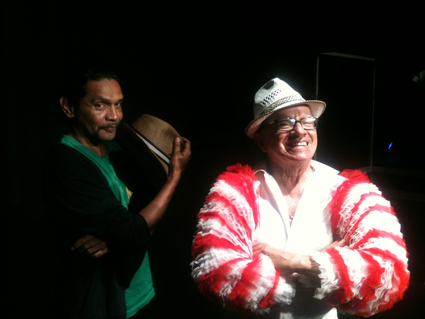
Raymond D Blanco and Raphael Blanco, 2Whyte
photo Nicholas Mills
Raymond D Blanco and Raphael Blanco, 2Whyte
2Whyte
2Whyte was held on the last weekend of the festival and is best described as a work in progress. It has an interesting premise, with Nicholas Mills bringing together two established dancers with the same surname but from different disciplines. Raymond D Blanco is a prominent Indigenous dancer, choreographer and director who has been at the forefront of Indigenous dance and its development, while Raphael Blanco is a 76 year old Cuban dancer and teacher and reportedly one of the first Cuban immigrants to arrive in Australia. Together they bop, boogie and cha cha cha their way through the show, finding common ground through dance.
As the houselights dim we are shown projected text, first about the history of Cuba and then Australia and the Torres Strait. The source cited is Wikipedia and I’m not sure if the team are being ironic or simply relaxed in respect to their research. Next there is a demonstration of Cuban dance moves, projected documentary-style footage and live onstage interviews with the dancers, interspersed with examples from Raymond’s repertoire. His evident joy in performing to Silver Convention’s Lady Bump (presumably a favourite from his formative years) is so infectious that we find ourselves bopping along in our chairs.
One audience member described this work as “docu-dance” and it shone when we were able to glimpse into the dancers’ psyches. Each grappled in their own way with the notion of being categorised as an ‘older dancer’ and the significance of this for their careers resonated with the sympathetic audience. Perhaps the work would benefit from a little more finessing and some direction in relation to teasing out further synergies, however, the performers held us with their charm and zeal.
Like the individual performances within it, the On Edge festival offers fascinating insights into the interior worlds of artists and audiences alike. The festival makes an integral contribution to the far northern landscape and its arts community with a celebration of contemporary performance and media works from all over Australia and the world.
2010 On Edge Festival: (please give: it a moment), creators Elizabeth Dunn and Jessie Hall, Wallwork Studios, July 4-7; post, Shamelessly Glitzy Work, created and performed by Mish Grigor, Natalie Rose and Zoe Coombs Marr, COCA Theatre, July 8-9; 2Whyte, director and media Nicholas Mills, performers Raymond D Blanco and Raphael Blanco, COCA Theatre July 15-17; www.onedgeart.com/
RealTime issue #98 Aug-Sept 2010 pg. web
© Victoria Carless; for permission to reproduce apply to realtime@realtimearts.net

Alexander Proshkin, The Miracle
DEFINING A FILM IN REFERENCE TO ITS NATIONALITY (A FRENCH FILM, AN AUSTRALIAN FILM, A RUSSIAN FILM) IS AN INCREASINGLY TENUOUS BUSINESS THESE DAYS. IN AN AGE OF GLOBALISATION, IT WOULD SEEM THE BOUNDARIES OF A NATION STATE ARE NO LONGER IMPERVIOUS ENOUGH TO ALLOW FOR THE INCUBATION AND GROWTH OF A DISTINCTIVELY NATIONAL CINEMA. CONTEMPORARY RUSSIAN CINEMA REFLECTS THESE CHANGING ECONOMIC AND CULTURAL CONDITIONS MORE ACUTELY THAN MOST OTHER NATIONAL CINEMAS.
For so long culturally isolated and protected by the Iron Curtain, the Russian film industry has, since the fall of the Soviet Union, been forced to undergo a quick and radical transformation. Most significantly, Russian cinema has had to contend directly with Hollywood, the international monster that other national film industries have been struggling with or against for over 90 years. The goal has been simple: to survive in a monopolised marketplace without losing a distinctively national voice. After a shaky start in the 1990s, a definably 'new' Russian cinema emerged in the new century, a cinema that, for better or worse, has asserted itself as a producer of popular, economically viable films that participate in the populist aesthetics of Hollywood while also drawing on Russia’s prized and often traumatic cultural heritage.
The career of Russian director Alexander Proshkin (b1940) in many ways reads like a biography of this transformation. Beginning his career in Soviet television in the 1960s and 1970s, Proshkin asserted his reputation as a director of quality television drama before achieving box office and critical success for his 1988 feature Cold Summer of 1953. That film—a dark, violent and dramatic thriller set in the early days following Stalin’s death—was in many ways a pioneering work that offered a model for what Russian cinema could become in the post-Soviet era. Integrating historical and politically contentious subject matter within a generic scenario lifted from a Hollywood western, Cold Summer of 1953 demonstrated the possibility of a culturally respectable, serious, yet also populist and exciting cinema.
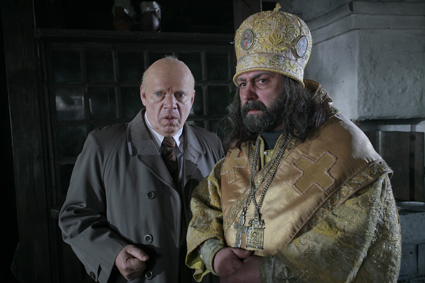
Alexander Proshkin, The Miracle
Proshkin’s latest feature Miracle, which plays at this year’s Russian Resurrection Film Festival, is also an entertaining film of serious ambition. Like Cold Summer of 1953, Miracle is set in the early Soviet 'thaw' of the mid-1950s, a period when Nikita Khrushchev initiated a relaxation of the paranoid grip of Stalinism. Proshkin was in his mid-teens at the time, and must have experienced the cultural atmosphere as a powerful liberation. “The time is significant,” he explains, “because 1956 is the year which marked a turning point in our history. Khrushchev’s address at the 20th Congress [of the Communist Party] marked the arrival of the new post-Stalinism period. With one foot, we were still in the past, while with the other we were in an uncertain future.”
Presented as a film based on historical events, Miracle’s narrative offers a fictionalisation of the characteristically Russian cultural myth, or true event, known as the “Standing of Zoia.” Said to have taken place in Kuibyshev (now Samara) in January of 1956, the story goes that while dancing with an icon of St. Nicholas, 21-year-old Zoia Karnaukhova froze solid in her living room for 128 days, only thawing at the arrival of Easter. In a culture very accommodating to superstition, news of the “miracle” was frantically suppressed by the Soviet government, and circulated only by word of mouth. Proshkin explains:
“In Russia, such information is often referred to as 'bush radio,' where one person tells one person and he tells another etc. Our scriptwriter, Yuri Arabov, was told about this incident by his grandmother, when he was nine years old. To the wider community, this information was kept confidential till about the end of the 1980s.”
With names altered and dramatic twists thrown in (Kuibyshev becomes Grechansk, Zoia becomes Tatiana and Khrushchev himself gets involved through a deus ex machina) Miracle manages to engage with the complex problems of Russia’s Soviet past without losing the narrative momentum of contemporary popular cinema, a balancing act that, in Proshkin’s view, Russian filmmakers can no longer afford to neglect. Just like everywhere else, he explains, Russian filmmakers are now answerable to the dictates of the mass audience: “The filmmaker’s role—or existence—has changed in our nation… Before there was an ideological influence, now it’s a commercial one.”
Despite being unambiguously popular in its presentation, there are considerable dimensions of depth in Miracle. As an allegory, the film would seem to present a metaphor of a society, frozen by Stalin’s terror, coming back to life. For Proshkin, however, the film’s narrative has less specific connotations:
“It is an attempt to explain the mentality of Russia, which in essence has not changed over time. Waiting for so-called 'miracles' has been embedded into the national character and we often put things down to simply being miracles.”
Proshkin’s interest in the “mentality” of Russia, and especially in the profound incompatibility between Russian social life and systematic centralisation, echoes throughout much of the director’s work. Open to the possibility of the miracle, but not certain of it, his is what might be called an agnostic attitude, significantly distanced from the more fervent religious cinema of contemporary Russian directors like Andrei Zviagintsev and Pavel Lunguin (whose epic Tsar also features at this year’s festival). Asked whether he considered his film to belong to the growing ‘religious’ genre of Russian cinema, Proshkin replies:
“For me it was always a mystery: how could a nation, which existed for 1000 years with the Christian-orthodox faith, suddenly condemn its pastors, destroy its churches and reject its religion? Religious belief, which was nurtured for 1000 years, cannot just disappear in one particular moment. It simply moved into the subconscious… Spiritual movies represent the character of our culture and its peculiarity.”
This concern with the Russian subconscious leads me to pursue another subject. If anything can be said to have persistently pricked at the conscience of Russian filmmakers for the past 50 years, it would be that most traumatic chapter of the country’s Stalinist nightmare, the Second World War. At this year’s festival, a retrospective of World War II dramas made in the post-war era—The Cranes are Flying (Kalatazov, 1957), Ivan’s Childhood (Tarkovsky, 1962), Trial on the Road (German, 1971) and The Ascent (Shepitko, 1977)—offers a captivating and sobering glimpse of the war’s centrality in the Russian memory. These are some of the finest films of their time. And yet still today, narratives set during the war continue to be made, as untold stories come to light. One such film is Vera Glagoleva’s One War, perhaps the finest new feature at this year’s festival. Other films explore an adjacent period: Stanislav Mitin’s lyrical gem Backdoor is set in 1949 and Nikolay Dostal’s award winning Peter on His Way to Heaven takes place in 1953.
For Proshkin, there’s a specific rationale in Russia cinema’s preoccupation with the trauma of Soviet history. Raking over the past is, it would seem, a way of processing the unacceptable, making sense of the incomprehensible:
“It’s not a matter of history. It is just that that period influenced the formulation of the mentality. Until we actually rid ourselves of the past which has been infused into our blood, we will never find the road to the future.”
2010 Russian Resurrection Film Festival, Sydney, Melbourne, Brisbane, Perth, Adelaide, Canberra, Aug 19-Sept 19; venues & dates www.russianresurrection.com
RealTime issue #98 Aug-Sept 2010 pg. web
© Tom Redwood; for permission to reproduce apply to realtime@realtimearts.net
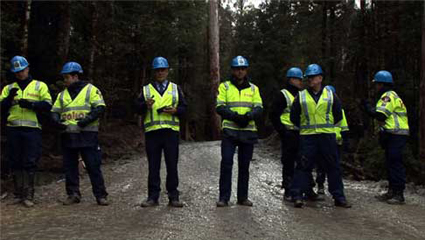
James Newitt, Passive Aggressive (2009)
video still courtesy of the artist and Criterion Gallery
James Newitt, Passive Aggressive (2009)
tasmanian spring
Having recently won the 2010 City of Hobart Art Prize (digital category) for his video work Dreams, Tasmanian artist James Newitt has now been included in the 2010 Primavera Exhibition at the Museum of Contemporary Art. This time, however, it’s his work Passive Aggressive (2009) that has attracted attention. Primavera 2010, which focuses on Australian artists under 35, also includes Akira Akira, Julie Fragar, Emma White, Jackson Slattery and Agatha Gothe-Snape. If you’re in Sydney, it’s always worth a look: last year spat+loogie smashed pie in people’s faces (2009); the year before that Soda_Jerk screened their 3-channel video installation Astro Black: A History of Hip-Hop (Episodes 0-2) (2009). It’s on from August 19 to November 21. http://www.mca.com.au/
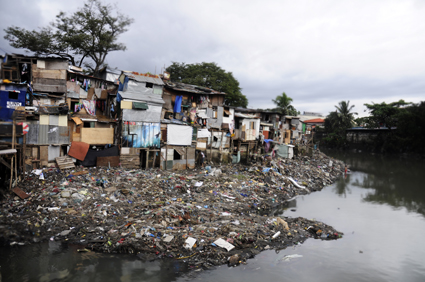
MM Yu, Waste Living 2009, duratran and lightbox, dimensions variable
photo courtesy of the artist
MM Yu, Waste Living 2009, duratran and lightbox, dimensions variable
water in the west
Still in Sydney, though a little further west, the Campbelltown Arts Centre is facilitating The River Project, a major new project comprising an exhibition, publication, performance, and education and public programs. Featuring artists from Australia, China, India, Korea, the Philippines, Vietnam and Papua New Guinea, the River Project explores how “river systems reflect our interconnectedness, our fragility and our history” (press release). Events will be held at the centre itself as well as at sites along the Upper Georges River. The River Project, Campbelltown Arts Centre; August 28-October 24; http://www.campbelltown.nsw.gov.au
blues & birthdays
Also in Sydney, the New Music Network has three concerts coming up. First, on August 24, is a concert by Continuum Sax and Match Percussion, with guests Natsuko Yoshimoto and Roland Peelman, where they will premiere Brian Howard’s Last Blues. Borrowing its title from Cesare Pavese, Howard’s compositions “invokes memory and loss through a compelling and yet fragile dialogue between the violin and ensemble” (press release). The second concert features An Infinity Room (AIR), a new ensemble comprising various synthesisers, keyboards and electronic organs. AIR, playing on September 3, “uses graphic scores, simple performance techniques and semi-improvised structures to create a haunting aura of drones and rich harmonic fields” (press release). Last but not least, Speak Percussion celebrate their 10th birthday by performing some of the oeuvre on September 20. The works are all focused around the keyboard percussion family and were premiered by the group. Continuum Sax and Match Percussion, Eugene Goossens Hall, ABC Centre Ultimo, August 24; AIR, Recital Hall East, Sydney Conservatorium, September 3; Speak Percussion, Recital Hall East, Sydney Conservatorium, September 25; http://www.newmusicnetwork.com.au
analogue love in a digital age
In the era of the iPod, the mix tape has a certain old school charm. Mix Tape is also the title of choreographer Stephanie Lake’s contribution to The Next Move, a series of performances created by the next generation of dance makers, commissioned and presented by Chunky Move. Mix Tape is, according to the press release, “about love. Driven by an eclectic and personal set of songs as well as recorded interviews, this new dance work cleverly illuminates experiences of regret, desire, ecstasy and disillusionment.” Choreographer Stephanie Lake graduated from VCA in 2002 and has spent the past ten years dancing for Chunky Move, Lucy Guerin Inc and BalletLab. She has choreographed several short works as well as two larger participatory dance works: one in 2009 for 100 people that was performed in Federation Square and another in 2010 for a City of Melbourne mob dance for 400 dancers performed in Bourke Street Mall. Chunky Move, Mix Tape, Chunky Move Studios, September 2-11; http://www.chunkymove.com.au/
a clothes line resurrected
Still in Melbourne, check out Not Yet It’s Difficult’s HOIST, which was commissioned by Federation Square’s Occupy program and created by David Pledger. HOIST consists of a general public participatory program by day and a screening program by night. In partnership with Melbourne Writers Festival, NYID is working with professional writers, commissioned artists and schools to populate the over-sized Hills Hoist with paraphernalia themed around this icon of the Australian suburbs. The company is also launching a book, Making Contemporary Theatre, in which the work of NYID is critically contextualised by company dramaturg Peter Eckersall. NYID, HOIST; Federation Square, August 27-September 9; http://www.notyet.com.au/ and http://www.hoistmelbourne.com.au/
re-enacting time
The Australia Experimental Art Foundation, in collaboration with Mildura Palimpsest, is hosting a series of installations, performances and talks for the (to) give time to time project. The project examines ephemeral and time-based practices and the impact of Mildura Sculpturescape (1969-78) on Australian contemporary art practice. It will, according to the website, “do this by making historical links” and “re-enacting key works.” Collaborators include Tim Burns, Barbara Campbell, Bonita Ely, Domenico de Clario, and Eugenio Carcheso. There is also a symposium, launched by Robyn Archer, and featuring Maudie Palmer, Judith Blackall, Rex Butler, Edward Colless, Brenda Croft, Anne Sanders, Juliana Engberg, Neil Fettling, Mark Minchinton, Marco Marcon, Glenny Barkley, and Stelarc. (to) give time to time, Curated by Matthew Perkins and Elena Galimberti, Adeladie August 20-September 18, Mildura September 17-19; http://aeaf.org.au and http://www.artsmildura.com.au/palimpsest/mildurasite.asp
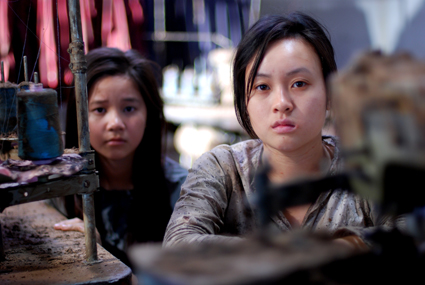
Sheena Pham and Kathy Nguyen, Mother Fish
photo courtesy of Titan View
Sheena Pham and Kathy Nguyen, Mother Fish
a refugee trilogy
Khoa Do is a regular in RealTime’s pages, appearing as both a theatre and film director (The Finished People). His latest effort Mother Fish, about two sisters who make the journey from Vietnam to Australia by boat, has been both a play and a film: the play debuted in 2008 (RT86) and the film premiered (as Missing Water) in 2009 at the Sydney Film Festival. Mother Fish the first film in a planned Refugee Trilogy (the second, Falling for Sahara, is in post-production while the third is still in the planning stages). You can see the film in a few places over the next few weeks. As part of an Amnesty International tour it will be screening in Geelong on August 29, as well as Deakin and Mercury Cinema (details coming soon). It will then tour in September as part of the Mobile AFI Awards. Screenings will be held at Nova (Vic) on September 1, Cinema Paris (NSW) on September 5, the Orpheum (NSW) on September 18, ACMI (Vic) September 19. Finally, it will also be screening at the Oz Film Festival (SA) on September 18. http://www.motherfish.com.au/
sense and censorship
It would appear that, for the moment at least, common sense has prevailed over state protectionism. Thanks to a campaign spearheaded by Get Up! and supported by activists around the country, the Labor party has deferred its internet filter until 2012 and the Coaltion has dumped the policy altogether. It remains to be seen whether “filter 2.0” will bear any resemblance to the first filter (examined by Melinda Rackham here), but with the Greens, Xenophon, and the Coalition now walking away from the policy, it looks unlikely.
RealTime issue #98 Aug-Sept 2010 pg. web
© RealTime ; for permission to reproduce apply to realtime@realtimearts.net
CD, Avant Whatever, 001
www.avantwhatever.com 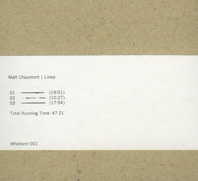
Australian artist Matt Chaumont has spent the better part of the last decade immersed in the world of low frequency sounds, producing a range of works that have probed that liminal perceptual zone where hearing and touch intersect. This has regularly involved the construction and installation of custom-built speaker systems capable of delivering sounds well below the threshold of human hearing and at a volume sufficient for Chaumont’s needs. So with the release of Linea we find out how his aesthetic and practice translates to the home listening CD/album format.
Linea comprises three pieces that are constructed using a limited set of resources—low frequency sine tones. However, this is not to say that these works are in any way austere or simply reductionist. Instead, Linea explores that territory common to the early Minimalist composers such as La Monte Young, Tony Conrad and Charlemagne Palestine, the early work of Ryoji Ikeda and the sine-tone pieces by Alvin Lucier, where reductive strategies generate complex outcomes. Each of Chaumont’s works on this CD produces an intricate sound derived from the interactions between his spare source materials. These works are in no way fast moving—all three pieces are marked by a certain stasis of form, allowing listeners plenty of opportunity to bask in the low, low sounds.
Track one begins by gently shuddering up from below the threshold of audibility before settling into a deep throb, the result of acoustical beats formed by the relationship between two or more tones close together in frequency, the effect of which is somehow both restful and disturbing. As the tones gradually fall in frequency towards the end of the piece, the ear is seemingly dragged into lower and lower pitch zones until the roles of hearing and feeling the sound are well and truly conflated. The second track is both richer and subtler, with incremental harmonic shifts between chordal structures, punctuated with occasional 'silences' produced by sub-audible tones. The last piece returns to a realm of deep pulsations, which gradually mutate and expand over its duration.
It is almost a cliché to say that works such as these that utilise low frequency sound are in some way inherently invested with notions of the physical, especially as very low frequency sounds (typically those below 20 Hertz) are largely perceived through, and interpreted as, touch. However, sounds of all frequencies are equally physical phenomena, and impinge upon our bodies in myriad ways regardless of our modes of perception. What is more interesting about Chaumont’s work is the number of ways that it engages its audience across the perceptual scheme. A sense of physicality is induced not just by the sensation of sound vibrating the ear drum, body or furniture but in the way it arranges itself in space, marking the physical relationship between the listener and the waves of sound in the room. Likewise, the movement of the loudspeaker cones is discernable to the eye (if not the ear), adding a significant visual component to these pieces, especially during periods of what otherwise is experienced as silence. More than the sensational, but rather simplistic, subsonic thump in the thorax one feels from the kick drum in a night club or rock concert, Chaumont’s work demonstrates that even without the benefit of concert sized sound systems or home theatre sub woofers, low frequency sound is more than the sonic equivalent of the fun park ride—some overpowered gimmick for quick excitement. Instead, it becomes not just a malleable tool for mingling the senses, but also a conceptual space for reappraising the everyday division of the senses into discrete realms: sight, sound, space and touch—all from the slow and steady vibration of speaker cones.
Peter Blamey
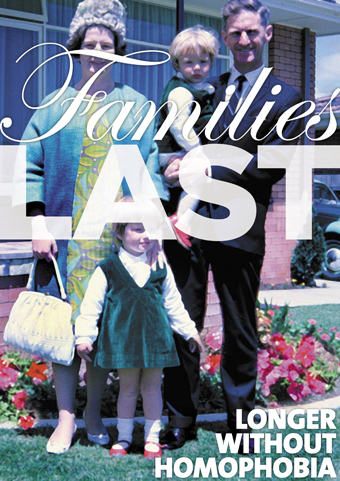
Families Last
photo Deborah Kelly (copyleft)
Families Last
WE NEED A NATIONAL CULTURAL POLICY THAT FORMALLY RECOGNISES THE IMPORTANCE OF THE ARTS TO SUSTAINING, ENRICHING AND DEVELOPING AUSTRALIAN CULTURAL LIFE.
As David Throsby has argued in “Does Australia Need a Cultural Policy?” (Platform Paper 7, Currency House, January, 2006) we need consistency, not “policy by review”—Nugent, Myer, Strong and the various ‘initiatives’ have come from pressured Arts Ministers, not from the Australia Council which then has to execute the initiatives. As Throsby points out it makes Ministers look simply “reactive,” responding to problems, often inadequately, and then, as with the major performing arts organisations, having to address them again.
The difficult thing about major policies, like a Human Rights Charter or a national cultural policy, is that they can be expressed as well-intentioned grand generalities or, evasively, as mere motherhood statements. Interestingly, once Peter Garrett put out his ‘over the summer holidays’ request of ideas for a policy (closed Feb 1, 2010), most of the responses were not policies per se but funding and other strategic wishlists, if quite policy indicative ones.
Some writers who contributed to the discussion questioned the very notion of having a cultural policy: would it define our diverse cultures too narrowly?; allow for the revival of the Howard government’s invocation of the ‘un-Australian’?; limit artists’ right to agitate? Like those who object to having an Australian Human Rights Charter, some of these writers feared greater political and bureaucratic intrusion into and regulation of the arts. Other respondents saw a cultural policy as a means to cementing into place the hitherto uncertain standing of art in Australia. Some wished to redefine art, making it one part of the creative industries. One writer argued that art is irrelevant to the cultural lives of many Australians.
The majority of responses focused on the plight of individual artists and organisations in the ‘small to medium’ sector, the lack of a pervasive arts policy in the education realm, extensive regional disadvantage, shortage of artist workspaces, constrained library and other collections and limited arts coverage on ABC TV.
Writers saw potential correctives in the shape of private sector investment in the arts (through means similar to film funding tax rebate mechanisms); greater pressure to promote philanthropy for the arts; the redistribution to the small to medium sector of funding allocated for major arts institutions; audience development campaigns; improved television reporting and wider access to the arts through digital media; the creation of artist-specific tax and unemployment benefit schemes (side-stepped when Garrett introduced Artstart); and support for more art-led urban renewal ventures like Renew Newcastle. A few respondents argued that if we are to have a national cultural policy, a discrete Ministry for Culture & the Arts would be warranted. Garrett is Minister for Environment Protection, Heritage and the Arts, but the Department of the Environment, Water, Heritage and the Arts covers a number of portfolios in which, as Christopher Madden has commented, the arts sector is a small player (“In defence of the Australia Council,” ArtsHub, August 2 http://www.artshub.com.au/au/news-article/opinions/architecture-and-design/in-defence-of-the-australia-council-181853?sc=1).
Central to the online discussion and subsequent debate is a desire for guaranteed equitable access, socially and geographically, to the means to enjoy, participate in and make art. Let’s hope that the pressure currently applied to the major political parties to develop a national cultural policy persists beyond an election that is not likely to resolve the matter. Let’s hope too that Australians can move towards acknowledging that the arts are not discrete from culture, but are integral to it, nurturing and making culture. Just because more Australians are engaged with art does not mean that this understanding is inherent.
For a brief guide to books, essays and online material go to: A short guide: national cultural policy
Deborah Kelly is a leading Australian arts activist whose works include Tank Man Tango: A Tiananmen Memorial http://www.realtimearts.net/article/issue93/9564. Families Last was made in 2010 in response to antigay pronouncements from Family First candidates
RealTime issue #98 Aug-Sept 2010 pg. web
© Keith Gallasch; for permission to reproduce apply to realtime@realtimearts.net
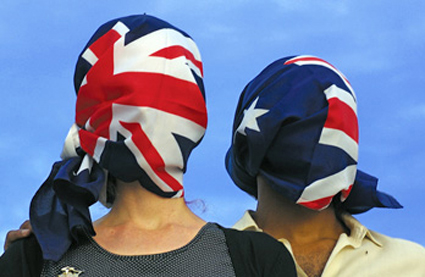
Muffled Protest
photo boat-people.org
Muffled Protest
THE 2010 FEDERAL ELECTION CAMPAIGN HAS BEEN DISGRACEFULLY NOTABLE FOR THE ZERO LEVEL OF LABOR AND COALITION ENGAGEMENT WITH ART, SCIENCE, SPORT (NOW, LIKE ART, CHARGED WITH ELITISM BY THE CRAWFORD REPORT) OR AUSTRALIA’S ABORIGINAL POPULATION. PETER GARRETT IS AN INVISIBLE ARTS MINISTER. TO DATE, ONLY THE GREENS HAVE PROMISED NEW INVESTMENT IN THE ARTS. BUT IT’S THE CULTURAL POLICY ISSUE WHICH EMERGED WELL BEFORE THE ELECTION CAMPAIGN AND WILL LONG OUTLIVE IT.
Peak Arts organisations (gathered together under the ArtsPeak banner), ABC Radio National arts programs and, especially, Marcus Westbury and Ben Eltham of the Centre for Policy Development (“Sharing the Luck: Cultural Policy in Australia” http://morethanluck.cpd.org.au/sharing-the-luck/cultural-policy-in-australia/) have prompted artists and the general public to apply pressure to the parties to embrace the arts in their election policies.
new directions, different paths
The greatest emphasis has been on the need for a national cultural policy with Westbury and Eltham pushing the notion in new directions, if divisively—demanding redistribution of funding from the major performing arts organisations (Opera Australia in particular) to the small to medium sector including areas like design, computer gaming, graphic arts, animation and others hitherto associated with an ‘underground’ not interested in funding (or engagement with government) or the creative industries that have one foot planted, if often lightly, in the commercial landscape. Westbury has written: “It is easy to argue that such people do not need funding. It is probably a reason for their relative vitality that they don’t. But that does not mean that they are without needs or that we can simply pretend that they do not exist” (“Evolution and Creation: Australia’s Funding Bodies,” Meanjin, Vol 68, No2, 2009).
It’s a pity that instead of arguing for greater funding overall for the arts and that the government ought to reconsider what comprises the arts (under the broader rubric of culture), Westbury and Eltham implicitly exhort the arts to instead turn on itself. Likewise, the writers problematically set up the Australia Council for the Arts as the target for their dissatisfaction with the status quo. As Christopher Madden argues eloquently on Arts Hub (“In defence of the Australia Council,” August 2 http://www.artshub.com.au/au/news-article/opinions/architecture-and-design/in-defence-of-the-australia-council-181853?sc=1), government itself—the Department for the Arts—is the more apt target. “If Australia’s cultural policies are a shambles, then the real source of the problem is central government, represented by the bureaucratic behemoth that is the Department. By international standards, the Department is not doing all it should be doing, and is doing many things it shouldn’t. This is hardly surprising for an agency in which arts and heritage are subsumed by such momentous portfolios as environment and water.”
Westbury and Eltham call for the dissolving or reform of the Australia Council (the two have different views on this: see the response pages at the end of their paper) and the establishment of a new cultural agency with whole of government management of culture (linking the arts with health, education, urban planning etc), resonating with the demands coming from ArtsPeak and others. To be effectively realised, Madden argues, an internal government agency would be needed to make this work—not one at arm’s length from it: “Proper engagement from within central government would let the Australia Council get on with what it does best, being an arts council.” Yes, but how are artists to have input into the making of arts policy in an increasingly top down political climate? Through ArtsPeak and consultative committees? A national cultural policy should include a guarantee of artist consultation in respect of policy realisation: but how would that be made effective?
inclusiveness & divisiveness
The strength of the Westbury and Eltham policy paper otherwise lies in its inclusiveness: recognising culture as more than the arts (or is it really a broader notion of what comprises art); abandoning “the false divide between high art and popular culture”—particularly apt in a time of unpredictable and innovative change; and “cutting the red tape that affects culture” to allow artists to access low rent work places and capital. The latter involves “putting in place policy settings that allow [artists] to perform, present and produce with limited capital [and] is more important (and effective) in ensuring their success than direct subsidies.” This last proposition could be comfortably adopted by the slash and burn Coalition.
On the other hand, the writers also propose funding “artists and productions, not institutions.” This reads like a radical proposal on behalf of underpaid artists but it fails to acknowledge rank and file orchestral players, choruses, ballet and contemporary dancers and actors and theatre support staff (set builders, stage hands, technicians etc) who comprise a large part of Australia’s arts ecosystem, many of whom are not exclusively involved in heritage arts. While we might be shocked at the per seat subsidy for an opera ticket (and at the high ticket cost for many opera lovers who are not well-off) it would be negligent to ignore the very nature and complexity of arts institutions, let alone the benefits of the outreach programs of some of the larger ones.
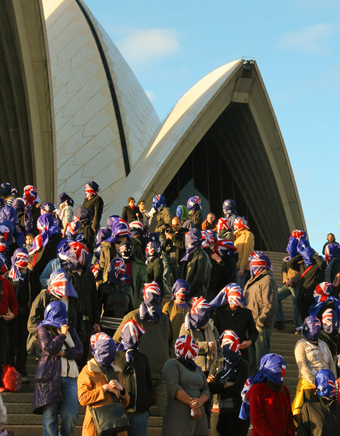
Around 70 people joined Muffled Protest on Saturday, August 2, 2010 “to show up the blind nationalism and xenophobia fueling the fear rhetoric surrounding refugees and asylum seekers.”
cultural and economic reciprocity
It is undeniable that the small to medium sector has been consistently underfunded relative to its larger peers (and their recurrent rescue packages) and that this needs to be addressed, but funding redistribution would be a crude and cruel tool. Increased funding is vital, consistent with national economic growth and reciprocating artists’ contribution to the Australian economy—”While nine out of 10 Australians participate in the arts, the federal government invests in this area less than one per cent of its expenditure overall,” ArtsPeak).
New funding should not come in the form of one-off initiatives but as part of a coherent national cultural policy, one that acknowledges the need for consistent funding and other strategies outlined by Westbury and Eltham, ArtsPeak, Throsby and others. A national cultural policy should entail, for the arts, whole of government engagement, education in the arts for all, protection of artists’ rights, a reassessment of the scope of the arts, the introduction of tax incentives and social security for artists, the collection and analysis of “adequate statistical and qualitative data that identifies both economic and social return on investment,” “forging a national research agenda for arts and culture based on policy development and private investment” and the protection of Australian culture “in the context of international trade agreements” (ArtsPeak).
the greens & the arts
The Greens’ latest election policy anouncement is responsive to key areas of development—R&D, national access and export. It includes a proposal to invest $5m in a research and development fund for new work; $10m in overseas touring; and additional funds for regional touring. As well the Greens promise to improve artist incomes through a copyright issue consultation, “Centrelink recognition of engagement in art as part of a dole recipient’s mutual obligation requirement,” revision of the Resale Royalty Scheme and the institution of a $3 million Artists’ Fund to assist publicly funded galleries to pay artists’ fees (Australian Financial Review, Aug 13). These Greens initiatives go some way to establishing in practical terms some of the principles that might be integral to a national cultural policy.
For a brief guide to books, essays and online material go to: A short guide: national cultural policy
Boat-people.org is an art gang which has been making work around race, nation, history and borders since 2001. The group’s current work, Muffled Protest, is a distributed expression of dismay in cities around Australia. You can participate! See www.boat-people.org
RealTime issue #98 Aug-Sept 2010 pg. web
© Keith Gallasch; for permission to reproduce apply to realtime@realtimearts.net
THOUGH THE ARTS AND CREATIVE INDUSTRIES MAY HAVE BEEN ABSENT FROM POLICY DEBATES, CREATIVITY ITSELF HAS NEVERTHELESS BEEN A VIGOROUS PRESENCE DURING THE 2010 FEDERAL GOVERNMENT ELECTION CAMPAIGN. WITNESS, FOR INSTANCE, THE SUCCESS OF THE ABC’S GRUEN NATION PROGRAM, WHICH NOT ONLY ANALYSED ACTUAL POLITICAL CAMPAIGNS BUT ALSO PRODUCED ALTERNATIVE ONES AS WELL.
In the first week of Gruen Nation, ad agencies were asked to humanise Tony Abbott and tell Julia Gillard’s back story. In the second week, another two agencies were brought in to mobilise fear about Labor and the Coalition. In the third episode, one agency created an ad to inspire mainstream voters to vote for the Greens while another encouraged Greens voters to endorse a mainstream party. The former was so impressive that the party approached the ABC about using the ad. While they weren’t allowed to do so, they benefited nonetheless as the video went viral.
Also on the ABC, the Chaser has returned with a program called Yes We Canberra, featuring a staring competition with Julie Bishop, a game of Guess Who? with Tanya Plibersek and a “Pollie Graph” test for Maxine McKew.
fake politicians
Beyond the box, there are the secret pleasures of the Fake Senator Steve Fielding’s twitter account. In fact, there’s a whole fake twitter parliament and press gallery (see Bella Counihan’s article), including a fake Gillard, three fake Abbotts (one of which was set up by the ALP) and a fake Andrew Bolt, but Fake Fielding remains my favourite. He tweets about the finer points of policy (“Family Fist [sic] wants more for our kids education. Less iMacs, more Bibles”) and politicking (“Susan was right, the bottle suit does scare children”), as well as the joy of Milo (“Absolutely tonguing for a hot Milo right now but Susan’s out and I’m not allowed to use the microwave unsupervised”) and the perils of preparing it (“Disaster. Milo everywhere. So much tears”). He has more followers than the real Fielding (3165 as opposed to 2141) and considerably more tactical nous, constantly consulting with Senator Nick Xenophon (variously spelled Xzenophonne, Xemaphore, Xzuezephone).
While impersonating someone on twitter certainly takes effort, it requires even more energy to do physical and vocal impressions. Sadly Anthony Ackroyd’s Kevin Rudd may have to be retired, but there are a variety of Gillard impersonators ready to step into the breach, including Amanda Bishop (seen here and here, as well as an interview here), Gabby Millgate as Julia Spillard, and Lynne Cazaly as Gulia Jillard. Get Up! has also used a Gillard impersonator in its parody of a coffee ad (“Hello, would you like to grab a coffee and talk about climate change?…Tony’s about direct action, I’m about acting directly.”)
get up! gets up
Get Up! itself has had a stellar campaign, winning a famous victory in the High Court and in doing so enabling an additional 100,000 Australians to cast their vote. Beyond campaigning on climate change and voting rights, Get Up! has also campaigned about internet censorship, mental health, women’s issues and asylum seekers. You can see all their campaigns here: http://www.youtube.com/user/getupaustralia
activist art
The mention of asylum seekers brings to mind the work of the group boat-people.org. In response to the escalating rhetoric on refugees, including the Liberal party’s infamous Dad’s Army arrows, Julia Gillard’s regional processing centre and the Department of Immigration and Citizenship’s new No to People Smuggling YouTube channel, boat-people.org have staged two Muffled Protests, one in Melbourne and another in Sydney. The protest features people slowly wrapping the Australian flag around their heads. The resultant image is dense with allusions, recalling Magritte and Abu Ghraib all in the same simple gesture.
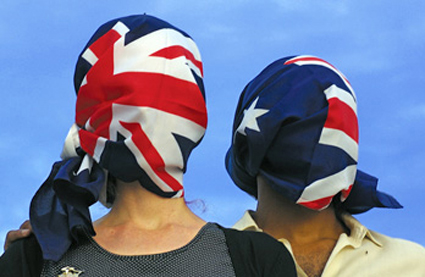
Muffled Protest
photo boat-people.org
Muffled Protest
One member of the group, Deborah Kelly, has also produced another image aimed at Family First (perhaps Fake Fielding could post a twitpic).

Families Last
photo Deborah Kelly (copyleft)
Families Last
Elsewhere, Stephen Rowley, as cinephobia, has redesigned Obama’s Hope poster as Abbott’s Nope.
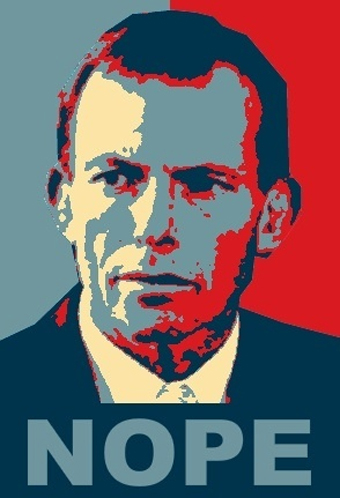
The Audacity of Nope, Created in honour of Tony Abbott’s ascension to the Liberal leadership, and his blocking of the ETS
photo Stephen Rowley, cinephobia, reproduced under Creative Commons license Attribution-Non-Commercial 2.0
The Audacity of Nope, Created in honour of Tony Abbott’s ascension to the Liberal leadership, and his blocking of the ETS
The image is now the profile picture for the Facebook group Friends Don’t Let Friends Vote Liberal. While you’re on Facebook you might like to join Tony Abbott’s Ladies Auxiliary. But if you’re a bit shy, then you can still enjoy their work here.
campaign jamming, campaign loading
While culture jamming is usually associated with subversive politics, political parties are increasingly trying to co-opt the tactic for their own purposes. See for instance the Labor party’s Tony Abbott Is Right website, where users can download a template and make their own Tony Abbott poster. One of the most popular posters features a pixellated Abbott with the slogan “Tony Abbott, Loading …”
There is a sense in which the campaign itself is still loading—the Liberal launch was only last week while the Labor launch is today (Monday, August 16). Both parties have taken vows of austerity, which has prevented them from announcing any major new policies. If it makes you nostalgic for more exciting times, you might like to revisit the It’s Time campaign or, at the other end of the Whitlam era, Norman Gunston’s take on The Dismissal in 1975. One YouTube commentor calls the moment “surreal,” adding that it’s “like Borat trying to interview Bush in 2000.”
Speaking of surreal, what to make of Mark Latham? This article was written before his 60 Minutes report went to air, but it may be that Latham’s performance as a journalist turns out to be the greatest parody of them all.
RealTime issue #98 Aug-Sept 2010 pg. web
© Caroline Wake; for permission to reproduce apply to realtime@realtimearts.net

Tony Abbott, Loading
photo Tony Abbott Is Right website, reproduced under Creative Commons license Attribution-Non-Commercial 2.0
Tony Abbott, Loading
DURING THE 2010 FEDERAL GOVERNMENT ELECTION CAMPAIGN CALLS ARE INTENSIFYING FOR ALL POLITICAL PARTIES TO DEVELOP COHERENT CULTURAL POLICIES. A NUMBER OF FACTORS, ACCUMULATING OVER MANY YEARS BUT NOW MORE MARKEDLY EVIDENT, UNDERLIE THE URGENCY FOR CREATING A NATIONAL CULTURAL POLICY.
These factors include policy making on the run (reactive funding initiatives from Arts Ministers), significant changes within the arts (new forms, new technologies) and arts education (creative degrees), inadequate arts education in primary and secondary school, increasing censoriousness (the Bill Henson ‘affair,’ internet filtering), underpaid artists and a widespread devaluing of the arts (as elitist and self-serving) despite statistical evidence of growing attendance and participation figures across Australia.
This brief guide to the national cultural policy discussion begins with Arts Minister Peter Garrett’s online public discussion (without his own participation) of his Discussion Framework towards a policy. It’s followed by the most substantial engagement with the issue this year, from Marcus Westbury and Ben Eltham, and a response to one of their recommendations (about the future of the Australia Council for the Arts) from Christopher Madden. In a spirit of greater cultural inclusiveness, Westbury and Eltham substantially broaden the arts ambit (embracing non-mainstream, underground and creative industries practices), as does Helen O’Neill in Griffith Review 23 while in the same edition Robyn Archer defends art from the incursion of the creative industries model.
With its valuable historical and economic perspectives, David Throsby’s Platform Paper No. 7, “Does Australia Need a Cultural Policy?” provides a brisk, cogent argument for a national cultural policy, although Jana Perkovic in RealTime worries about the use of ‘economy’ as a principle benchmark in the making of policy: “Artists should understand the power of words. At the moment, one of these is ‘economy.’ Being good or bad for the economy, vaguely defined, is argument enough to defend or shelve a policy. Agreeing that we have a ‘culture’ would allow a whole new string of arguments to be made and, with due respect to David Throsby, defend the arts not on the grounds of its goodness for the economy, community or health, but simply as important for our culture.”
Kevin Rudd’s 2009 Summit and Peter Garrett’s subsequent National Cultural Policy Discussion created expectations that have yet to be met. Garrett did not address proposed changes to unemployment benefits in favour of artists (the Greens have embraced this in the election campaign), instead delivering the micro-business modelled ArtStart designed exclusively for tertiary education graduates (“I think this makes ArtStart the only Australia Council grant program that requires an artist to hold formal qualifications.” Peter Anderson, “Visual Arts Education: Between research & the market,” http://www.realtimearts.net/article/98/9959).
While ArtStart and its likes look good for emerging artists, without a coherent arts policy (let alone a cultural policy) they could put artists on the path to a dead end: where is the policy that points towards the development of an arts infrastructure that will accommodate the growing numbers of arts graduates (and the non-academically trained)? As attractive and significant as the micro-business model is and, for some, the correlative argument for a de-institutionalisation of the arts, we need to recognise the arts as a complex system requiring a subtle response—no easy task in an era of reductionist binary thinking. A national cultural policy that can do justice to the arts and to artists is not going to be easy to achieve, but one thing above all we must be mindful of is that art is not merely part of culture—art builds, fuels and transforms culture.
Discussion: National Cultural Policy
Minister for the Environment, Heritage and the Arts, http://nationalculturalpolicy.com.au The site includes Arts Minister Peter Garrett’s address to the National Press Club, October 27, 2009 and the National Cultural Policy Discussion Framework. Submissions can now be found in the Library section.
Sharing the Luck: Cultural Policy in Australia
Marcus Westbury and Ben Eltham, Centre for Policy Development http://morethanluck.cpd.org.au/sharing-the-luck/cultural-policy-in-australia/
Marcus Westbury, “Suggestions for politicians in search of a cheap arts policy,” The Age, August 2 http://www.theage.com.au/entertainment/art-and-design/suggestions-for-politicians-in-search-of-a-cheap-arts-policy-20100801-111ce.html
Christopher Madden, “In defence of the Australia Council,” ArtsHub, August 2 http://www.artshub.com.au/au/news-article/opinions/architecture-and-design/in-defence-of-the-australia-council-181853?sc=1
The art in cultural policy making
Gavin Findlay: Peter Garrett’s national cultural policy discussion
http://www.realtimearts.net/article/issue96/9805
Culture: an intangible, protectable & nurturable good
Jana Perkovic: cultural policy and the arts
http://www.realtimearts.net/article/issue97/9855
David Throsby, Does Australia Need a Cultural Policy?, Platform Paper, Currency House, Sydney, January 2006
Jennifer Craik, Re-visioning arts and cultural policy: Current impasses and future directions, http://epress.anu.edu.au/revisioning_citation.html, July 2007, ANU E Press, co-published with the Australia and New Zealand School of Government
Workshop on Cultural Policy, Culture and Policy, Griffith University, Vol 8, No 1,1997
Helen O’Neill, “Ratbags at the Gates,” Griffith Review 23, Essentially Creative, ABC Books/Griffith University, Autumn 2009
Robyn Archer, “Industry that pays, and art that doesn’t,” Griffith Review 23, Essentially Creative, ABC Books/Griffith University, Autumn 2009
Forum: “A National Cultural Policy for Australia”, Australian Performing Arts Market, February 22, Adelaide 2010; includes downloadable panel discussion transcription. Facilitator Sarah Miller, Speakers: Bronwyn Edinger, Kathy Keele, Greg Mackie, Chris Puplick and?David Throsby
http://www.performingartsmarket.com.au/keynote-and-forums
The Music Show, ABC Radio National
Andrew Ford with Marshall McGuire, Clare Bowditch, Graham Wood, Sandy Evans and Michael Kieran Harvey musicians http://www.abc.net.au/rn/musicshow/stories/2010/2982941.htm
ArtWorks, ABC Radio National, August 8
Amanda Smith with Marcus Westbury and Chris Puplick
http://www.abc.net.au/rn/artworks/stories/2010/2969104.htm
Julian Meyrick, Cultural Policy in Australia
Meyrick is a writer and theatre director and, with Marcus Westbury and others, a member of the Arts Minister’s Creative Australia Advisory Group.
Streamed talk, October 19, 2009, Baldy Centre for Law & Social Policy, University of Buffalo, USA. Access via AustralianPolicyOnline:
http://www.apo.org.au/video/cultural-policy-australia
RealTime issue #98 Aug-Sept 2010 pg. web
© Keith Gallasch; for permission to reproduce apply to realtime@realtimearts.net
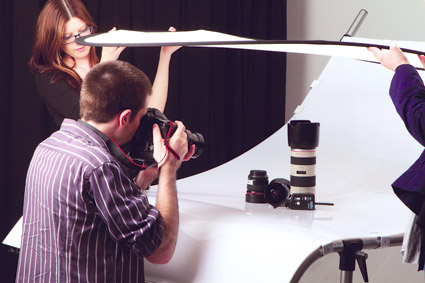
CSU photography students Amy Sinclair, Jason Schoenfeld, School of Communications & Creative Industries, Charles Sturt University, Wagga Wagga, NSW
The accompanying shot of photography students photographing a camera seemed apt for a RealTime edition where academics look at the relationship between the university as academy and the university as arts training institution. There are times when arts education tensions seem to go sharply binary. Our annual arts education coverage suggests that this is one such moment as the traditional notion of university study comes up hard against art practice. Even as practice-based research seems to be gaining traction, albeit not universally, other areas of tension open up. There is growing concern that as universities increase their investment in postgraduate programs, undergraduate students are in danger of losing out. We hear from academics who feel a strong obligation to students who will not be going on to higher degrees and whose focus is on making work and connecting with the sector of the arts economy in which they wish to work. The teaching emphasis here is on creating good learners who are flexible, deeply informed, multi-skilled and have substantial in-course ‘real world’ contact through work experience, professional practice and showing their work publicly. Some of the concern about undergraduate well-being is exacerbated by the effects of the absorption of arts training institutions into universities (most recently witnessed in the deleterious Melbourne University takeover of the Victorian College of the Arts & Music) who want to cost-cut class and studio times that creative arts courses desperately need for skills development and creative work. Some creative arts academics ask, again after years of amalgamation and rationalisation, is the university the right place for the creative arts? Others see universities now as too vocationally oriented, failing to develop critical enquiry. Some are concerned that the integrity of their discipline is weakened by artforms being shunted into multidisciplinary faculties, while others celebrate the interdisciplinary opportunities. Another tension is felt between university teaching and a socially networked world that invites decentralised learning: “What is to become of knowledge…in the confessional tweet economy when definitions of media art, discussions of the media sector and what I’m wearing at the time will be undifferentiated noise in the flow?” (see Darren Tofts). Some of these tensions will be destructive if skills development is diminished or the vocational thrust dominates; other tensions will be creative, making the university interdisciplinary…or “undisciplined” (see Peter Anderson).
RealTime issue #98 Aug-Sept 2010 pg. 1
© Keith Gallasch; for permission to reproduce apply to realtime@realtimearts.net
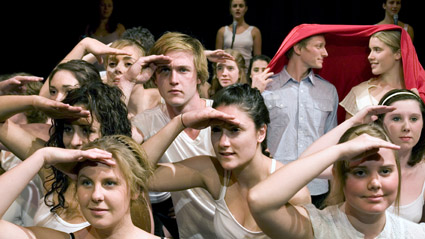
First Year Students, University of Wollongong, performing Park Young-Hee’s Finding Love
photo Derek Kreckler
First Year Students, University of Wollongong, performing Park Young-Hee’s Finding Love
PROFESSOR SARAH MILLER IS HEAD OF THE SCHOOL OF MUSIC AND DRAMA IN THE FACULTY OF CREATIVE ARTS AT THE UNIVERSITY OF WOLLONGONG ON NSW’S SOUTH COAST. REGIONAL UNIVERSITIES FACE MANY MORE CHALLENGES THAN THEIR WEALTHY CAPITAL CITY COUNTERPARTS BUT MILLER REVEALS HOW A SMALL SCHOOL IS BUILDING NEW DEGREES RESPONSIVE TO STUDENT NEEDS IN THE RAPIDLY TRANSFORMING WORLD OF THE PERFORMING ARTS AND FURTHERING CREATIVE PRACTICE AS RESEARCH.
the multidisciplinary context
With two decades of experience as director of Sydney’s Performance Space and Perth’s PICA (Perth Institute for Contemporary Arts), Sarah Miller is a vigorous supporter of multidisciplinary programming and interdisciplinary practices. The University of Wollongong’s Creative Arts Faculty offers a rich multidisciplinary context for creative scholarship in its embrace of Visual Arts, Graphic Design, Media Arts and Digital Media; Journalism, Creative and Professional Writing; and Performance and Sound-Composition & Music Production. Undergraduate students largely work within one discipline but there are opportunities for productive cross-overs: “I wouldn’t describe the faculty as interdisciplinary as such but there is the potential because a number of disciplines are co-located so that when you get to Honours, for instance, that cohort is ‘in the same room’.”
interdisciplinary opportunities
One area where interdisciplinary work can be pursued at undergraduate level is the Dean’s Scholars Program: “Students with a very high standard can do a double major. It’s a mediated program and they have to maintain distinction standard.” A small number of students are taken into the program, combining for example, says Miller, “theatre and creative writing.”
independent learners, transferable skills
The faculty’s drama school comprises Miller and four other staff members: theatre lecturers Tim Maddock, Janys Hayes, Lotte Latekefu who teaches singing and Margaret Hamilton who teaches dramaturgy plus “casuals who come in to teach skills—voice, movement and technical and production management. Visiting directors work on our end of semester productions as Theatre Fellows. They are professionals we know and love who give the students a breadth of experience which is really important.” As to her vision for her students, Miller explains, “What I saw was in line with my own experience and I wanted to more clearly articulate it: the idea of the self-producing artist, self-reliant, capable across a range of areas, with the good training that certainly was never available when I was a student [laughs]—I used to run around town trying to find classes to do!
“We’re aiming for a coherent training program which, of course involves repetition, and then there’s the university’s academic requirements. The theorist Lesley Stern said to me once, ‘The last thing the world needs is another dumb actor.’ I do take that on board—as in any creative arts area, how many graduates will become practitioners? They have to have the best training you can provide but they also need other options—to be really independent learners, capable of critical thought, with skills that are transferable, and it’s important that they’re not passive.”
skills, performance, dramaturgy
Miller described the principal ingredients of the current Bachelor of Creative Arts, Theatre degree: “There are three streams: skills development in acting, singing, voice and movement; a production every semester; and dramaturgy—a very rigorous course in the theory and history of theatre. Now I’m back in a university I have returned to history as something that is critically important. And training in research skills for different career pathways is embedded in the courses.”
Miller explains that “there is also a very small technical production cohort within the acting course. Frank Mainoo is an acting graduate working in this area as well as in his own work and with the performance group Team Mess.” (Team Mess emerged from the Creative Arts Faculty. Mainoo is appearing in the Brisbane Festival’s Under the Radar program with Sydney performance maker Jeff Stein). “The designer Robert Cousins is teaching the production students design this year and they all—to a greater or lesser degree—study lighting. Tanya Leach from Sydney Theatre Company taught stage management last semester. It’s important the students have contact with working professionals.”
As to how a spirit of independence is engendered, Miller says her staff are very good at developing a strong student cohort. Self-animation is the spirit of the school and of necessity—it’s a not a wealthy faculty. There’s an expectation from the very outset that while the students are supported that the shows will have to be self-reliant, and ‘make a buck’—but not a big profit.” As well as performing, students do front of house, bump-ins and help with publicity.
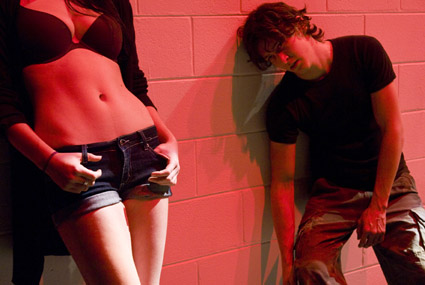
Second Year University of Wollongong students perform Fassbinder’s Pre-Paradise Sorry Now, directed by Chris Ryan
photo Derek Kreckler
Second Year University of Wollongong students perform Fassbinder’s Pre-Paradise Sorry Now, directed by Chris Ryan
making their own work
“They also have the unusual opportunity—and Tim and I feel it’s generally beneficial—to make their own work, albeit within tight parameters. It’s done on a competitive proposal basis and usually in 2nd and 3rd year. However, Jackson Davis wrote and directed Fire Moves Away (mentored by Theatre Fellow Chris Ryan) at the end of his first year, and showed it in the first weeks of 2nd year. It was so successful it went to the Hue Festival in Vietnam (facilitated by staff member Janys Hayes). Jackson is a Dean’s Scholar and one of the students combining Theatre and Creative Writing.”
the text-based/devised balance
Miller thinks the variety of approaches staff bring with them important for student flexibility. Chris Ryan (ex-Sydney Front and director of shows for PACT Youth Theatre) and Tim Maddock (Brink Theatre Company, Sydney Theatre Company, Griffin Theatre Company) “direct very differently but there has been no schism beween text-based and devised work, such as has happened elsewhere. This has been profoundly important.” She adds that through Margaret Hamilton students are incredibly well informed about the range of contemporary theatre and performance.
As well as Chris Ryan, the faculty has attracted a large number of theatre and contemporary performance professionals to work with students, including Deborah Pollard, Carlos Gomes, Geordie Brookman, Regina Heilmann, Tessa Leong, Drew Fairley and Mark Haslam. Miller is attentive to the need to balance text-based with devised works for production, noting as well that “some students just want to be actors and others almost from the outset want to make work. We need to open up the range of possibilities.”
Miller was particularly impressed with Korean performer Park Young-Hee’s Finding Love. Park came as a Theatre Fellow via Latt Children’s Theatre on the recommendation of director Roger Rynd [whose death on June 14 in Seoul is sadly noted. Ed]. “She directed and taught first years in their first 2009 semester, giving them a physical discipline and a sense of cultural difference from the very beginning.”
making connections
The faculty’s relationship with the organisations and venues outside the university is also important to Miller. Staff bring their connections and students have appeared in Performance Space’s NightTime series, have belonged to PACT’s Impact ensemble or appeared in the Tiny Stadiums Festival where the Appelspiel Collective created a model of the Erskineville village. Recent graduates have formed performance groups Team Mess and Tiger Two Times and actress Claire Bowen appeared in Geordie Brookman’s production of Spring Awakening, the musical, for the Sydney Theatre Company and in David Field’s film, The Combination.
As an integral part of their degree, undergraduates perform in their first year within the university in the faculty’s black box 86-seater, while their 2nd year productions are staged at the Illawarra Performing Arts Centre’s [IPAC] Gordon Theatre both semesters. The 3rd year graduating productions are shown at the PACT Theatre in Sydney and the Graduate Showcase is presented at Belvoir Street Downstairs. All the faculty’s shows are publicised widely within the university and beyond.
the new bachelor of performance
Miller is excited about the new degree: “From 2011 we’ll still have the Bachelor of Arts, Theatre and a new Bachelor of Performance. These will match the needs of different kinds of students. The Bachelor of Performance has two streams: one is acting and the other is performance making. There’s a common first year shared with the BCA Theatre students before decisions are taken about which pathway students might follow. In the first year there are common foundation subjects, then an introduction to stagecraft, one performance-focused and around the body and the other technical. As well there are skills training in acting, singing, voice and movement for performance focused students or subjects introducing stage management and the fundamentals of lighting and sound for students wishing to major in technical theatre production.
“After 18 months, the actors in the Bachelor of Performance continue actor training while the performance-makers pick up other areas of practice, different performative modes, installation and also directing—more specialisation, but no minors and only two electives, although performance-making students may choose to do a minor in technical theatre production.
“The Bachelor of Performance is designed to be the intensive course and the BCA Theatre degree more flexible,” Miller explains. “In a BCA you could do a major in theatre and a minor in technical production, or two minors—technical production and media arts or creative writing. It recognises the new emergent practitioner who plays in a lot of areas. BCA Theatre is about multidisciplinary flexibility.” Miller adds, “The production course will become a major in the BCA in 2012.”
Fortunately for a pressed Miller, who is also Program Co-ordinator for Music and Drama, “We have a new building with a rehearsal facility—two spaces to put people in—nothing flash but very functional.”
creative postgraduates
“Postgraduate study is a growth area,” says Miller. “We’ve had Masters and PhD students before but now we have increasing interest from mid-career and senior artists. It’s come about because of the classic need for artists within universities to get qualifications, or to reflect on one’s practice, or to seek structure and resources.” Wollongong offers a rare opportunity in NSW to do practice-based research in theatre. Miller says there’s also been a growth in the number of Honours students: “Mark Rogers is writing about the work of director Benedict Andrews and directing productions of plays by playwrights like Howard Barker and Marius von Mayenburg; Nathan Harrison is writing about Sydney performance group, version 1.0, which is arguably seminal research about Australian theatre practitioners.” The BCA Honours degree comprises 50% creative work and a minor thesis of 15,000 words—honestly, very demanding.” Honours students might then go on to a PhD. Artists undertaking Master of Arts by Research in the faculty include significant players in Sydney’s performance scene, Karen Therese and Victoria Hunt.
The Doctorate of Creative Arts is for artists with a high level of professional experience and a substantial body of practice. Current candidates include performance makers Deborah Pollard and Nikki Heywood. Miller says, “they exemplify the required ‘high level of artist achievement’ with longevity of practice and extraordinary maturity. I think it’s exciting for them. To prepare them and others, Professor Diana Wood Conroy has set up the Senior Artists’ Research Forum [SARF] which is a DCA-focused, intensive senior artists study program, supporting them in research methodologies training. There are fortnightly meetings with staff and other postgraduates for a semester and a half and then they go into the DCA proper. This is really helpful because it can be hard to come back into the university structure.”
With the imminent arrival of the Faculty of Creative Arts’ Bachelor of Performance at the University of Wollongong, we can look forward to the recognition of contemporary performance not only as a rich field of artistic endeavour and achievement in its own right, but as part of the great spectrum of performance that entails much else, including what we have traditionally understood as acting and theatre. That this extends to creative doctorates and the faculty and its students’ and graduates’ engangement with the world beyond the university, makes it all the more exciting.
Faculty of Creative Arts, University of Wollongong, NSW; http://www.uow.edu.au/crearts/index.html
RealTime issue #98 Aug-Sept 2010 pg. 2
© Keith Gallasch; for permission to reproduce apply to realtime@realtimearts.net
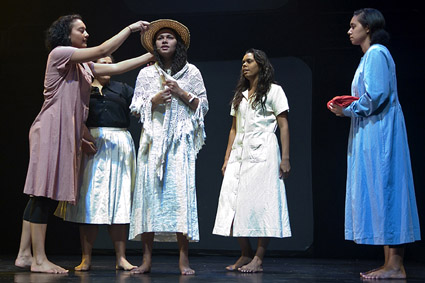
Rosie Fatnowna, Sharni McDermott, Teiya-Lee Gallienne, Elena Wangurra, Kaylah Tyson, Q150 and Long Before; Aboriginal Centre for the Performing Arts
photo Bain Stewart
Rosie Fatnowna, Sharni McDermott, Teiya-Lee Gallienne, Elena Wangurra, Kaylah Tyson, Q150 and Long Before; Aboriginal Centre for the Performing Arts
IT MAY ONLY BE AN ONLINE PROMO, BUT THE SELECTION OF COMMENTS FROM STUDENTS AT BRISBANE’S ABORIGINAL CENTRE FOR THE PERFORMING ARTS (ACPA) SAYS MUCH ABOUT HOW IT DIFFERS FROM NIDA, WAAPA OR EVEN NAISDA. “IT’S A SAFE ENVIRONMENT FOR MY PASSION”; “IT FEELS LIKE LEARNING IN OUR OWN COMMUNITY”; “THERE’S NEVER ANY SHAME HERE”; AND “I’M BECOMING MORE CULTURALLY STRONG IN MYSELF.”
For these Indigenous kids—almost half of whom are from regional Queensland rather than the cities—it’s not all about learning to sing, play music, dance or act in public; though that’s what they desperately want to do. It’s about connecting with their culture while preparing to get out there and compete in the entertainment mainstream. And though there aren’t yet any students from remote areas, and some have blond hair and blue eyes, they’re all singing from the same songsheet—which, when I was there, happened to be a number called “Black is the place I’m in.”
As such, the centre is part of the Queensland state government’s Indigenous Arts Strategy 2009—surely the first in the country; and with a $12million investment in things like the Cairns Indigenous Art Fair, the Queensland Indigenous Arts Marketing & Export Agency, the Saltwater Indigenous Film Festival and a network of 18 Indigenous Knowledge Centres, the most generous. Ironic that this was the state that worked most assiduously to ‘disperse’ its native peoples as far from their own country as possible; and I’m using the word disperse advisedly, in both its natural and euphemistic meanings—the latter disguising a massacre.
Given that such a turn-around in the State of Origin would likely be trumpeted until maroon in the face, why do we know so little about ACPA? One reason is that we’re still in thrall to the brilliant beginnings of NAISDA—spawning the Aboriginal & Islander Dance Theatre, Bangarra etc. In comparison ACPA has had a smaller and much more fraught start to life.
Michael Leslie—the recent Red Ochre winner for a lifetime of such efforts—founded ACPA in 1997. But it almost faded away a couple of times before a beefed up board of directors and two serious arts players came on the scene just two years ago. The board is now 50% Indigenous, and Chris Mangin, ex-Australia Council and the long time CEO of the Queensland Opera is there too. They brought in Milos Miladinovic as CEO, who simply said, “I wanted to feel proud of what I was doing” when I asked whether this was a step down from managing major venues such as The Edge in Auckland and the Victorian Arts Centre in Melbourne. “I’d come to the conclusion that I didn’t really like big musicals any longer!”
Miladinovic brought in Leah Purcell as Artistic Director—but only after she’d said no three times. However good the other artform teachers, the students needed an Indigenous role model—and who better than a film star, writer, director and stage actor who was also an ACPA alumnus, as was Ursula Yovich.
Can one suggest that the range of arts disciplines offered by ACPA is a factor in producing high individual levels of confidence; while NAISDA’s specialisation in dance has produced more corporate success. Penny Mullen, Head of Dance at ACPA, arrived in 2003 when class numbers were down to around five. But today she confidently compares ACPA with its rival NAISDA.
ACPA has always insisted on being centrally placed in Brisbane—as close to its South Bank arts activity as possible. The result is trainee and performing relationships with QPAC, Expressions Dance Company, the Brisbane Festival and La Boite Theatre. As a result, though, they’re in a condemned building at the moment and the hosted accommodation that’s essential for country kids is way out in the burbs at Beenleigh. Miladinovic reports, however, that a big, riverside building in West End is poised to come their way for the next five years—big enough to offer accommodation as well as teaching and administration. After that the State’s commitment will extend to a purpose-designed building, thanks to their assiduous massaging of what Chris Mangin describes as “the delicate balance of carrying the government forward with our dreams of the future.”
Ever-greedy, Miladinovic, would also like to head for Cairns—the State’s official Indigenous arts hub, where his students will be performing as part of the Indigenous Art Fair this year. There he could bring remote Aboriginal and Islander students into the fold. And if that works—why not go national?
They’re going international in September on an exchange with an Indigenous training college in Brazil. And because Leah Purcell has suffered family problems this year (which also caused her to pull out of playing Cordelia to John Bell’s Lear), the American director Stephen Helper is adding some Broadway glitz to the ACPA show at QPAC in August, which comes in two parts, Soul Music (the musical) and Souls Entwined (the dance, choreographed by Gina Rings and a team from Expressions).
The pattern of education that leads up to shows like this is the Certificate III cross-artform entry level, when it’s asked, ‘are they going to commit?’—as 75% of this year’s expanded number of 35 new students have so far. This compares to ACPA’s historic number of 85% completions—which is good compared to TAFE figures. Certificate IV is a change of pace and discipline for students—“a huge leap, but still cross-artform. If they make it through that, the Diploma is specialist, and suddenly they’re performers,” marvels the CEO. “There was Teiya [Teiya-Lee Gallienne], head down, hidden by hair for two years; then, overnight we discovered an actor and a singer in our midst!”.
Chris Mangin believes this sort of achievement more than justifies the two years he and Chair Denise Andrews put in ‘hands-on’ to save ACPA. “The history of training opportunities for young Aborigines is not marked by success. Yet it’s clear there’s a whole range of them with significant performing and writing skills. We have to marshal those skills and put them in front of a public—and it might lead to future employment.”
Long-term, Milos Miladinovic sees his main challenge as replacing himself with an Indigenous administrator. “Everything I see about mainstream courses is antithetical to keeping Aboriginal students on board; a 4,000-student environment is so far from their family and culture. Here, even if they don’t make professional performers, they’re able to go back into their communities as leaders; and maybe that’s where I’ll find my replacement arts administrator in time.”
The QPAC presentation of the Aboriginal Centre for the Performing Arts’ Soul Music/Souls Entwined has eight performances Aug 4-7; www.qpac.com.au/event/ACPAA_Entwined_10.aspx; www.acpa.net.au
RealTime issue #98 Aug-Sept 2010 pg. 4
© Jeremy Eccles; for permission to reproduce apply to realtime@realtimearts.net
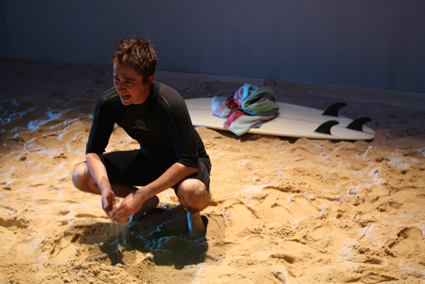
Dean Blackford, Blackrock, Tantrum Theatre
photo Tom Potter
Dean Blackford, Blackrock, Tantrum Theatre
WHEN MY FAMILY MOVED FROM CANADA TO AUSTRALIA IN 1990 WE WONDERED WHERE ON EARTH WE HAD LANDED. THE NEWCASTLE HERALD SEEMED TO REPORT ONLY TWO EVENTS: THE NEWCASTLE EARTHQUAKE (DECEMBER 1989) AND THE MURDER OF LEIGH LEIGH (NOVEMBER 1989).
Recently I had a chance to revisit the latter when I went to see Tantrum Theatre’s new production of Nick Enright’s play Blackrock. Enright first wrote the play Property of the Clan for Freewheels theatre-in-education company in 1992 before redrafting it as Blackrock for the Sydney Theatre Company in 1995. You might also have seen the 1997 movie directed by Steven Vidler. The Tantrum production is essentially the 1995 version, albeit with a few minor updates to include references to champion surfer Layne Beachley instead of Wendy Botha.
As we enter the space, a theatre with roughly 200 steeply raked seats, we see a trapezoidal stage covered in sand. Depending on the lighting (John Zeder), it looks like a beach, a bumpy relief map or a lumpy living room carpet. In the centre there’s a surfboard while up to the left a boy sits on a scaffold, dangling his legs. It’s Jared, enjoying the scenery before his cousin Cherie comes to pester him for a surfing lesson. From here, Blackrock follows a fairly classical narrative structure of exposition, complication, crisis and resolution. In the expository stages, we meet Jared, his mother Diane, his girlfriend Rachel and her family. We also meet his other ‘family,’ the surfing community at Blackrock. When their paterfamilias, Ricko, returns from some sort of safari, a party is in order. During the party, which is low on adults and high on alcohol, a girl named Tracy Warner is raped and murdered. The remainder of the play deals with the aftermath.
Sociologist Kai Erikson argues that trauma has both a centripetal and a centrifugal force within a community (A New Species of Trouble, WW Norton, 1994). On the one hand, it can cause existing divisions to widen. In Blackrock, the community splits along lines of class (the middle class perpetrator has access to a proper lawyer, the two working class accused are presumably left to Legal Aid), gender (the girls are deeply upset, the boys attempt to carry on as usual) and generation (neither the parents nor their children can comprehend each other’s actions and reactions). On the other hand, trauma can also cause communities to band together. This occurs in Blackrock to ethically ambiguous effect: in their efforts to comfort and reassure one another, the young men are soon colluding, coming up with alibis and agreeing to back each other up.
Director Brendan O’Connell draws subtle and nuanced performances from almost all of his cast. The young women effectively portray the febrile and slightly hysterical emotion of teenagers: they sob, stalk, whimper and sometimes shout. Brittany Turner is an endearing Cherie, making light work of monologues that are often tortured in drama classes. Likewise, Sarah Coffee is suitably highly-strung as Tiffany and Rachel Jackett is disarmingly low key as Rachel. The young men in the cast also manage to convey the excitement, terror and inarticulate rage their characters feel. Dean Blackford is especially sympathetic as Jared. The adults are also good: Karen Lantry deserves a special mention for her portrayal of Jared’s mother, who emerges as tough but tender, as does Cheryl Sovechles for her depiction of her vivacious sister Glenys. The characters’ moods are ably amplified by Kieran Norman’s sound design and Zackari Watt’s compositions: arguments are underscored by dissonance, points of shock by staccato notes and the music speeds up and slows down with the dialogue.
In the final scene, Jared finally cracks and admits that he saw the entire incident but did not go to Tracy’s aid. It is a melodramatic and somewhat problematic moment. For the character, it is the moment of confession, remorse and regret for his part in this moral mess. For the audience, however, it functions as a sort of reveal, as we finally find out what actually happened. In this sense, the play provides its spectators with a sense of closure that the community itself has never and probably can never experience.
“No one has ever worked through an injury without repeating it,” writes Judith Butler, “[t]here is not possibility of not repeating. The only question that remains is: How will that repetition occur, at what site…and with what pain or promise?” (Excitable Speech, Routledge, 1997). What, then, is the point and purpose of restaging Blackrock 20 years after the events that inspired it? For a young director, perhaps it is a chance to test himself against an Australian classic. Indeed, it is a chance to test the classic itself. For spectators who, like me, were there when the events transpired, the performance provides us with the time and space to do memory work, to wonder if that’s how it really happened and think about what has transpired in the interim. Finally, for the young actors themselves, performing in Blackrock might be likened to one of the play’s many initiation ceremonies (Toby turning 18, his sister Rachel dating her first boyfriend, and his mother writing on Indigenous initiations). To perform in Blackrock is to be initiated into Newcastle’s history, to learn that along with the mines and the beaches, the death of Leigh Leigh too is your ambivalent inheritance.
Tantrum Theatre, Blackrock, writer Nick Enright, director, designer Brendan O’Connell, performers Rod Ansell, Dean Blackford, Sarah Coffee, Ben Freeman, Erika Gelzinnis, Cordelia Hamilton-Russell, Steffen Hesping, Rachel Hackett, Dean Johnson, Karen Lantry, Bradley McDonald, Cheryl Sovechles, Brittany Turner, Daniel Yaxley, lighting designer John Zeder, composer Zackari Watt, sound designer Kieran Norman; The Playhouse, Civic Theatre, Newcastle, May 13-22, www.tantrumtheatre.org.au
RealTime issue #98 Aug-Sept 2010 pg. 6
© Caroline Wake; for permission to reproduce apply to realtime@realtimearts.net
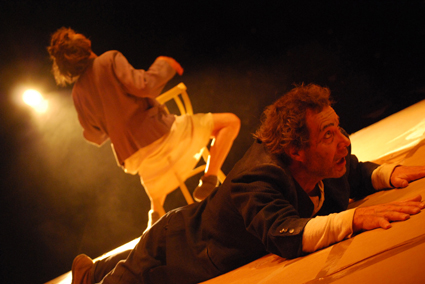
Eugene Gilfedder, Jennifer Flowers, The Chairs, La Boite
photo Al Caeiro
Eugene Gilfedder, Jennifer Flowers, The Chairs, La Boite
OF LATE THERE HAS BEEN AN ALMOST OBSESSIVE REVIVAL OF INTEREST IN THE WORKS OF ROMANIAN-BORN, FRENCH PLAYWRIGHT EUGENE IONESCO, WHO WROTE IN THE SHADOW OF THE HOLOCAUST AND WHOSE WORK REFLECTED THE IDEOLOGICAL TENSIONS OF THE COLD WAR. IT’S TEMPTING TO ATTRIBUTE THIS TO AN AWARENESS OF THE TOTAL CORRUPTION OF OUR LANGUAGE INTO A MORASS OF MANAGERIAL, MARKETING AND CORPORATE SPIN ANALOGOUS TO THE STRONG LINKS IONESCO MAKES BETWEEN LANGUAGE AND THE EMPTINESS OF POWER.
Is our world with its dying seas and asphyxiating atmosphere a fitting setting for the sort of tragic farce which was Ionesco’s chosen metier as a playwright? Is Ionesco our contemporary or is his 1952 play The Chairs just a vehicle for bravura performances, in this case, from Eugene Gilfedder as the Old Man and Jennifer Flowers as the Old Woman who confront the predicament of old age and old habits with a mounting fine edge of rage in Gilfedder’s case, and Flowers with a sly defiance of time that seizes every moment to flirt with the audience.
Ionesco comes to us cloaked in the guise of so-called Theatre of the Absurd. Now the spotlight has been turned on his case in an intelligent, scrupulously realised rendition of this small masterpiece for La Boite in Brisbane. Director Brian Lucas restores Ionesco as the legitimate heir of Feydeau combining an outrageous, surreal sensibility which Ionesco applies with a rationale that, far from being absurd, is, on the contrary, remorselessly logical in the way of clowns. Gilfedder greets an old flame with the declaration that she is as beautiful as ever, while noting the fact that she is going bald. He puncuates the arrival of a high plenipotentiary (God?) by barking like an excited dog. Flowers’ performance achieves the purest heights of comic burlesque when she mimes an act of seduction in her role as dessicated coquette.
Ionesco tells us that his plays have their origins in two basic states of consciousness, “an awareness of evanescence and of solidity, of emptiness and of too much presence.” He sets up an isomorphic resonance in The Chairs between these two qualities to which Brian Lucas seems acutely attuned from the evidence of his own solo works in dance theatre with their intricately crafted visual and kinetic elements and deep concerns with life’s ephemerality and the validity of language. Lucas’s treatment, too, has the light touch which renders his own work so accessible. It may be profound, it may be crazy, you take it or leave it. It illuminated the fact that, for me, Lucas’s own chosen metier is tragic farce, especially his 2010 show, Performance Anxiety (RT96, p30). As a dancer and choreographer, Lucas expressed surprise that he had been asked to direct Ionesco’s classic, but this was a joyful match especially considering that in later life Ionesco turned his attention to dance as a realm to express his ideas.
Through carefully plotted stagecraft, the play makes complex use of presence and absence, but this does not amount, despite Ionesco’s references to the Void, to a metaphysical statement. Integral to his purposes in theatre is the stage design where Bruce McKinven accommodates Ionesco’s stipulations, including symetrically arranged doors in the rear for exits and entrances as in a Feydeau farce. At a significant moment, double doors open onto a blazing wall of light signifying the Void backstage. However, this is a solidly spatial metaphor. Two ladders lead to high windows set on either side of what will eventually emerge as a replica, albeit shabbier, auditorium onstage. Two chairs face downstage.
The Old Man is atop one of the ladders as the play begins, apparently delighting in an ocean vista. When the Old Woman acidly remarks that it is too dark to see, he complains that it wasn’t like that in the old days when it was always light. Their fractious, co-dependent relationship is rapidly established through a series of verbal Punch and Judy cross-purpose conversational gambits while he sits on her lap indulging in a conscious abandonment to self-pity, partly triggered by her lamentations about his wasted talents.
To divert him, the Old Woman initiates a game they have obviously played before. Having rocked him on her knee while singing a soothing lullaby, she introduces the comforting topic of his important message to the world. Reaffirmed, the Old Man resumes his chair and begins to manifest a new, confident personality, a fictional self. He has moved, in his imagination at least, beyond his lowly status as a “master of the mop and bucket.” They sit in silence, momentarily taking on the image of members of an audience in expectation of a performance.
The Old Woman attempts to wind down the game by suggesting they are too tired and should cancel the evening’s performance when the doorbell rings. Startled into febrile activity, they rush to answer it and reappear, escorting and seating onstage an invisible guest with whom they exchange social banalities. From here on the action frenetically escalates into a vaudevillean tour de force. Guests continue to arrive, the Old Man frantically greeting them and the Old Woman struggling to produce chairs for them all. Comic vignettes of social intercourse grind to a halt as the reality of the old couple is overwhelmed onstage by these invisible presences, and they are separated and squeezed to the margins by this new audience-in-waiting. Eventually the Orator (Dan Crestani) who will deliver the Old Man’s message appears as a real, oleaginous, neo-Fascist figure—to the dismay of the Old Woman, she has to touch him to pronounce him “real flesh and blood”—but he studiously ignores the old couple.
Their make-believe mission apparently accomplished, the couple have no choice but to finish the game by committing suicide, somersaulting backwards from their separate perches on the windows into the sea. Faced with the expectations of the real audience in the auditorium merged with those of the invisible audience onstage (all conventional stage boundaries have now dissolved), the Orator struggles to deliver his non-existent message, finally abandoning the attempt and leaving the real audience to contemplate the possibility of their own disappearance into the indelible image created onstage.
Ionesco is gently asking to what extent we avoid interacting with the sheer crazy wonder of life by grounding existence in our own and other people’s fictions, including the theatre’s. If the messengers fail us, we must jump without a parachute into a void of unknowing. After Copenhagen, we must work out our own salvation, and the salvation of the planet. As Ionesco puts it, “Ideology is not the source of art. A work of art is the source and the raw material of ideologies to come.” Judging by the shared smiles tokening a renewed awareness of the unbearable lightness of being, the audience ‘got it.’ This seriously funny production validated Ionesco as a man for our time.
La Boite, The Chairs, writer Eugene Ionesco, translator Martin Crimp, director Brian Lucas, performers Dan Crestani, Jennifer Flowers, Eugene Gilfedder, designer Bruce McKinven, lighting designer Carolyn Emerson, sound designer Brett Collery; Round House Theatre, Brisbane, Jun 5–Jul 4
RealTime issue #98 Aug-Sept 2010 pg. 8
© Douglas Leonard; for permission to reproduce apply to realtime@realtimearts.net
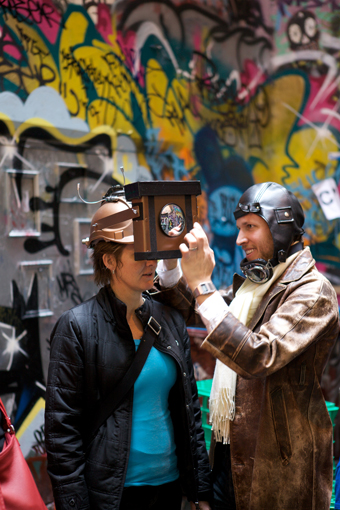
participant, Tim Webster, In Periscope
photo Bonnie Savage
participant, Tim Webster, In Periscope
THE NOTION THAT ART AFFORDS US FRESH PERSPECTIVES ON THE FAMILIAR IS SOMETHING OF AN EMPTY PLATITUDE; HOW OFTEN DO WE REALLY FIND OURSELVES CHALLENGED AS OPPOSED TO ASCRIBING ORIGINALITY AND INSIGHT TO SOMETHING WHICH MERELY CONFIRMS OUR OWN VIEW ON THE WORLD? EVEN THE FRAMES WE PLACE AROUND ‘ART’—AS OPPOSED TO ITS OTHERS—ARE DEPENDENT ON WHAT WE CHOOSE TO SEE AND WHAT WE HOPE WILL REMAIN ABSENT FROM OUR CONSCIOUSNESS.
in periscope
It was a right old surprise, then, to recently experience a tiny and very humble work of live art that literally shifted the frame. In Periscope was the ingenious creation of Tim Webster in collaboration with Sarah Rodigari and presented its handful of participants with a gentle yet effective physical and visual encounter with the city.
Upon arrival in a Melbourne laneway we were fitted with a curious piece of headgear—a steampunk-esque helmet held together with brass-painted screws and wires and with a large, rectangular face covering. When lowered it blocked all but the most peripheral of our vision but soon a panel was removed and a square of light appeared. The contraption was a periscope of sorts, presenting a magnified view of whatever lay directly above us. For the next 20 minutes we were guided around a city now only available to us in a strangely upended and abstracted way.
But as with most art that deserves the title, a description of the process doesn’t do justice to the experience. The effect of this periscope is an embodied one—it produces a sense of immediacy and alienation that goes beyond the conceptual. Moreover, it’s not the same as simply looking up while wandering the streets. The device framing our vision produces a screen rather than window on our environment and a distinct sense of dislocation results: the experience of our physical bodies moving through the urban space doesn’t correlate with the cool, distant flow of flattened architectural forms unfolding before our eyes.
As an experiment in live art making, In Periscope was subtle yet enthralling, much like last year’s En Route by Bettybooke (RT94). It produced that transfigured way of seeing so rarely found in art, yet did so in a modest and understated manner. It seems likely to me that this kind of achievement is more often realised in non-text-based work, but while the field of live art frequently shuns texts there are examples of more traditional theatre which still hold out hope for the transfigurative perspectives of the form.
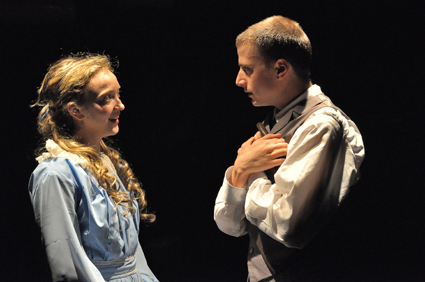
Amanda Falson, Thomas Conroy, Something Natural but Very Childish, Dirty Pretty Theatre
photo Joe Calleri
Amanda Falson, Thomas Conroy, Something Natural but Very Childish, Dirty Pretty Theatre
something natural but very childish
Director Gary Abrahams’ first outing of 2010 was a literary adaptation—Acts of Deceit (Between Strangers in a Room), after James Baldwin’s novel Giovanni’s Room. There Abrahams proved himself keenly adept at drawing out the emotional intricacies of a literary work and using them to shape a compelling stage drama. His second work for the year, Something Natural But Very Childish, extended this same process to a selection of short works by Katherine Mansfield.
What makes Abrahams’ works this year stand out so sharply is an aesthetic commitment to something deeply unfashionable in contemporary performance: the romantic. They are almost anachronisms in this regard, treating the sentimental with a degree of seriousness that is slightly unsettling in an age of irony and self-reflexivity. They’re far from kitsch, however. Rather, they overlay a vaguely hysterical kind of heightened emotion onto the rich and resonant themes of his source material; at the same time, they never revert to camp parody. Where there is excess, it seems designed to reproduce the sense of giddy intoxication one experiences when drawn into a lush, imaginative literary world. The director’s success is in reawakening the possibility of a post-ironic theatre that is anything but falsely naïve.
slut
Playwright Patricia Cornelius works within this frame, as well. Her play Do Not Go Gentle… has been a much-feted fabulation of aging and loss, but her short work Slut is an excellent introduction to the surgical skill with which she employs familiar theatrical conventions to deliver the unfamiliar.
Slut was commissioned by Platform Youth Theatre as part of a double bill two years ago; I still recall that performance as the result of a key monologue which arrives near the work’s conclusion. I was eager to see whether my memory of the text’s excellence would hold up to a second production.
Verve Studios’ new version is more confident than the original, perhaps the result of the slighter older casting. The work itself is chilling, inspired by the murder of a woman by her boyfriend on a Melbourne street several years ago. At the time, media coverage focused on the tragic death of a passer-by who attempted to stop the violence, while sneeringly referring to the female victim as a ‘partygirl’ who came to an unsurprising end. This is both the origin and destination for Cornelius’ attempt to make sense of the event.
Her script traces the history of a woman who since puberty has been defined by sexuality; crucially, this history is largely revealed through the breathless commentary of two schoolmates who narrate the decade leading to the eventual murder. It is only late in the work that it becomes apparent that the figure at the play’s centre is mostly without voice herself or, when she speaks, it is in the language of those who are shaping her identity. That brief monologue in which she does find her tongue is still wracking—her assertion that she’d never been permitted to want or dream of anything beyond her immediate circumstances is a confronting one in a space, the theatre, where dreaming of that which isn’t the case defines the very essence of an audience.
weekend
The period in which Jean-Luc Godard created his notorious film Week End (1967) was one in which he, too, was grappling with the position of the spectator in relation to his practice. Having moved beyond the formal experimentation of his earlier work, he searched for a politicised cinema that rebelled against the paradigm of audience passivity. While a worthy goal, one of the results was, in the case of Week End, a film intended to alternately outrage and bore its viewer, with endless sequences of cool banter, disjointed title cards and scenes of real animal slaughter.
A recent adaptation of Week End presented at La Mama’s Carlton Courthouse brought different problematics to the stage while equally provoking its onlookers. Most troubling of all was the apparently deliberate obsolescence of the work—performers gleefully artificial, replete with bad accents and hokey props, but just as often playing as if uninterested. This isn’t to say that these performances failed to engage; instead, they seemed calculated to prevent any identification with the increasingly bizarre events occurring on stage.
But if coprophilia, dismemberment and cannibalism are just the stuff of entertainment today, and when invoked must be treated with the same bored contempt deserving of vacuous spectacle, then it’s unclear why a theatrical production would seek to remind us of this fact. Weekend seems a self-defeating production, one that heralds the demise of classical theatre by feasting on the remains. It’s not the only way, I think. Admittedly, though, it’s a pretty damned entertaining one.
Affective Urbanism 3: In Periscope, Tim Webster in collaboration with Sarah Rodigari, helmet design and construction Rob Jan, around Melbourne, May 29-30; Dirty Pretty Theatre, Something Natural But Very Childish, writer, director Gary Abrahams, performers Luke Jacks, Thomas Conroy, Amanda Falson, Luisa Hastings Edge, Josh Price, Zoe Ellerton Ashley, Cameron Moore; La Mama Theatre, June 2-20; Verve Studios, Slut, writer Patricia Cornelius, directors Paola Unger, performers Hayley Birch, Kelly Hynes and Victoria Morgan; The Dog Theatre, June 30-July 17; Weekend, writer Matthew Lambert, director Lynne Ellis, created & designed by Paul Blackman from Jean-Luc Godard’s Week End, performers Sam Sejavka, Francis McMahon, Ben Andrews, Christian Bagin, Imogen Sagel; La Mama Courthouse, Melbourne, June 30-July 18
RealTime issue #98 Aug-Sept 2010 pg. 10
© John Bailey; for permission to reproduce apply to realtime@realtimearts.net
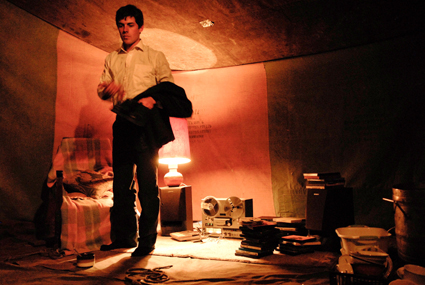
Matt Prest, The Tent
photo Heidrun Löhr
Matt Prest, The Tent
AN IMPORTANT DEVELOPMENT FOR AUSTRALIAN CONTEMPORARY PERFORMANCE IS ABOUT TO BE REALISED. THE MOBILE STATES CONSORTIUM, A STRONG SUPPORTER OF THE FIELD, HAS COMMITTED TO DEDICATING ONE OF ITS TWO ANNUAL TOURS TO A DIVERSE PROGRAM OF SMALL AND MEDIUM SIZED WORKS OVER THREE YEARS, STARTING IN 2010.
an expanding niche
The opportunities for contemporary performance works to travel regionally and cross borders have multiplied in recent years thanks to Mobile States (with sometime support from the federal government’s Playing Australia program), Melbourne’s Arts House, Sydney’s Performance Space, Brisbane Festival’s Under the Radar and a range of opportunities offered by Full Tilt (at the Arts Centre, Melbourne) and Malthouse (both of whom have presented works by Sydney’s My Darling Patricia), Next Wave Festival (see articles by Reck, Karipoff and Warren), Sydney’s Tiny Stadiums, Australia’s international arts and fringe festivals and now regional players like the enterprising Campbelltown Arts Centre, west of Sydney, and Punctum in country Victoria.
Audiences are becoming increasingly familiar with contemporary performance as a regular part of their art diet—indeed as a substantial proportion of it in Arts House’s 2010 Future Tense programs. As with the 2010 Next Wave Festival, Future Tense’s offerings include the latest manifestation in the field—live art’s extensive engagement with site, genres, games, media, science, sensory states and audience interaction.
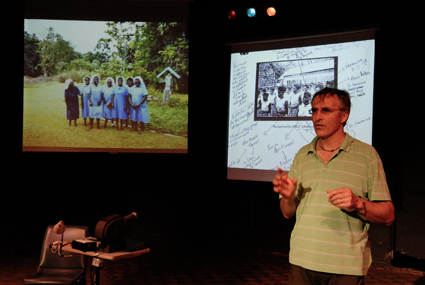
Paul Dwyer, Bouganville Photoplay
photo Heidrun Löhr
Paul Dwyer, Bouganville Photoplay
Mainstream theatre companies are also engaging with contemporary performance. In 2008 Sydney Theatre Company presented De Quincey Co’s embrace: Guilt Frame (RT 83; RT84) and in 2009 performance trio Post were in-residence with the company. Malthouse’s Tower provides a salaried venue for innovative works and Belvoir Street’s B Sharp has programmed Post (Everything I Know About the Financial Crisis in One Hour) and version 1.0 (The Market is Not Functioning Properly) in a forthcoming Downstairs double bill and version 1.0’s The Bougainville Photoplay Project Upstairs. Shutting down its B Sharp theatre program at the end of 2010, Company B seems set to commit to experimentation Downstairs: more room perhaps for contemporary performance to reach a wider audience.
mobile states: track record
Mobile State’s particular interest is “in those artists whose practice is concerned with experimentation, research and the investigation of ideas and form” (Performing Lines website) as demonstrated by its strong track record. It has successfully toured Branch Nebula’s Paradise City, Dancenorth’s Underground, Back to Back’s Small Metal Objects, Lucy Guerin Inc’s Love Me, Tanja Liedtke’s Twelfth Floor, version 1.0’s The Wages of Spin, Chamber Made’s Phobia, de Quincey Company’s Nerve 9, Jenny Kemp’s Still Angela and, most recently, Urban Theatre Project’s The Folding Wife across the country.
The consortium members are Adelaide Festival Centre, Arts House (Melbourne), Brisbane Powerhouse, Performance Space (Sydney), Perth Institute of Contemporary Art (PICA) and Salamanca Arts Centre (Hobart) along with producing member Performing Lines.
modus operandi
I spoke recently with Harley Stumm, a producer for Performing Lines, the agency that produces, develops and tours Australian works of many genres nationally and internationally. He’s a former executive producer for Western Sydney’s Urban Theatre Projects and brings considerable experience to this new initiative which is so clearly responsive to developments in the field.
Asked how Mobile States works, Stumm says, “Performing Lines manages the curatorial process but it’s a presenter-driven model. There were originally five members and now there are six with the Adelaide Festival Centre joining. We receive written proposals and vote on what goes forward. Performing Lines doesn’t have a vote because as a presenter-driven model you can’t vote to make someone put a show on. We participate in the discussions.”
motivation
Asked why Mobile States took on touring “Best New Australian Performance” (Press Release), Stumm explained, “Over the years artists have pitched a half-hour work or an installation for Mobile States and you think it’s a great piece, great to tour. But how? At various times we’ve talked about the idea of putting together a mini-festival to tour a broader spectrum of contemporary performance practice. There are new forms and genres arising but also new formats and new ways for audiences to experience work. So we developed the idea further, putting together a cluster of works to create an event that would build a bit of a vibe around this form of practice, and tendered for the Australia Council Touring Initiative from the Theatre Board. We’ll tour programs of shorter and mid-length works, performance installations, sound installations, audio walks, durational performances. We’ve selected a menu for the first tour of four works: Rosie Dennis’ Fraudulent Behaviour, Fleur Elise Noble’s 2 Dimensional Life of Her, version 1.0’s The Bougainville Photoplay Project and Matt Prest’s The Tent.”
complexities
The term ‘menu’ is apt. Stumm and the consortium had to grapple with the fact that not every venue could take on all the shows: “PICA in Perth has programmed all four works from the menu as a kind of mini-festival whereas other ‘festival-ed out’ presenters have selected certain shows as part of their seasons. Sometimes works have already appeared in a city, so they won’t be selected: The Tent had already done Melbourne.
“We’d initially planned a menu of five shows but we didn’t get Playing Australia touring money so we had to trim back. Then there were venue considerations. All of them have very different spaces—or not enough spaces—and different audiences, different budgets, any number of variables. Like all touring, there’s a group of diverse presenters coming together and working out what they can share and where they can’t compromise their own programming needs. On the other hand, there are benefits in touring to multiple venues—we’ve got four works going to five venues and no two venues have the same package, but there’s very little downtime so it’s still relatively cost effective.”
in darwin
Stumm emphasises that the program “is a group curation. The five works that we originally programmed were all high on most of the presenters’ wish lists.” But Mobile States programs don’t just go to the consortium’s venues: “We’ve toured Tess de Quincey, Branch Nebula and The Folding Wife to Darwin with the Darwin Entertainment Centre. This time the Darwin Festival artistic director Jo Duffy was very keen to look at some smaller works. Paul Dwyer’s The Bougainville Photoplay Project, which is about his father’s New Guinea experiences against the backdrop of Australia’s colonial history in the region, will go on at Brown’s Mart, which is perfect for it—a nice intimate space. Obviously the connection between this work and Darwin’s physical proximity to and historical relationship with Papua New Guinea interested Jo from the beginning.”
In the other work for the Darwin Festival, says Stumm, “Matt Prest’s The Tent will be performed on a strip of land on the waterfront, just down the hill from the CBD, between where they have the open air Deckchair Cinema and the new waterfront redevelopment. In the dry season when the accommodation in Darwin is booked up, all the ferals and grey nomads who’ve hit Darwin and either can’t find a place to stay or don’t want to pay for it, camp illegally in this park. So The Tent will be fantastic there. In The Tent there’s a kind of bush philosopher who’s opted out from the rat race. Matt says ‘The Tent is pitched at the crossroads of sustainability and prolonged adolescence’.”
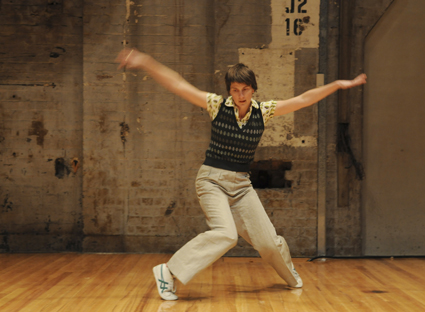
Rosie Dennis, Fraudulent Behaviour
photo Heidrun Löhr
Rosie Dennis, Fraudulent Behaviour
going regional
I ask Stumm about Mobile States’ commitment to regional touring. He replies that it’s not just an ideal, but a practical necessity if funding from Playing Australia is to be secured: “The advice we got from Playing Australia was that there wasn’t any issue with the model for the performance tour. It was simply a matter of regional reach. They have half a dozen selection criteria and so many program objectives. Regional reach is the top priority. So we have to extend our reach. And we want to do that. We have an application in for a stand-alone tour next year and another cluster—a menu of six works with each presenter choosing between two and four.”
Stumm points out that Mobile States has had good regional reach: “With The Folding Wife, we said okay, where’s the Filipino community located in Australia? And the answer is north Queensland and the Northern Territory. So we got that show to Mackay, Townsville, Cairns and Darwin. In the past, we got Branch Nebula’s Paradise City to Cairns and Alice Springs, Dance North’s Underground to NORPA in Lismore and to the Memorial Entertainment Centre in Bathurst.” Stumm says there is strong interest in future package tours from a couple of regional centres that “have a bit of a history of presenting more contemporary, more adventurous work”, but it has to mesh “with their own development programs. Stand-alone tours are definitely easier to sell to regional areas.” But it’s early days and Stumm is optimistic about the future of touring “performance clusters.”
Mobile States continues to be a significant force for promoting contemporary performance in Australia. As Harley Stumm sees it, and you’d have to agree, “the list of works that Mobile States has toured surveys some of the most important contemporary work for the last five years.” The new program of smaller scale works promises to bring far flung Australian audiences right up to date with new works and trends.
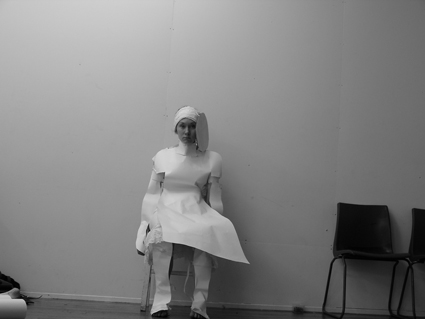
Fleur Elise Noble, The Two-Dimensional Life of Her
the works
Paul Dwyer’s the Bougainville Photoplay is engrossingly informal, musing on a doctor’s life in the 1960s in a brutalised neighbouring culture about which most of us know little. Fleur Elise Noble’s 2 Dimensional Life of Her generates a magical interplay between the artist’s own body and animated and paper sculpted personae telling us much about form, representation and self. So, in another way, does Rosie Dennis’ Fraudulent Behaviour—where a little lie can become a great fiction and you leave bemused, if compelled to reflect on your own white lies and worse. In The Tent, you’ll find yourself in an installation-cum-tent—sharing soup, entranced by puppet dreams and lateral glimpses into the meaning of life. These are works that engage in idiosyncratically different ways of telling and being. It’s wonderful that they’ve been mobilised to embrace a growing audience for new performance.
Mobile States, performance works, see individual venues for shows and times: Arts House, Melbourne, Aug 12-15; Darwin Festival, Aug 18-22; Brisbane Powerhouse, Aug 20-28; PICA, Perth, Sept 2-5; Salamanca Arts Centre, Sept 8-11
RealTime issue #98 Aug-Sept 2010 pg. 12
© Keith Gallasch; for permission to reproduce apply to realtime@realtimearts.net
{$slideshow} IN ACT IV OF EUGENE O’NEILL’S LONG DAY’S JOURNEY INTO NIGHT, EDMUND DRUNKENLY CITES ARTHUR SYMONS’ POPULAR TRANSLATION OF BAUDELAIRE’S PROSE POEM “EPILOGUE”: “WITH HEART AT REST I CLIMBED THE CITADEL’S/ STEEP HEIGHT, AND SAW THE CITY AS FROM A TOWER,/ HOSPITAL, BROTHEL, PRISON AND SUCH HELLS,/ WHERE EVIL COMES UP SOFTLY LIKE A FLOWER.” THE POET’S VIEW OF THE NOCTURNAL METROPOLIS—SEEDY IN ITS MODERN DISCIPLINARY INSTITUTIONS AND TEMPTATIONS—CONFESSES A KIND OF ILLICIT DELIGHT FOR THAT WHICH IS POISONOUSLY DESTRUCTIVE, OR AT THE VERY LEAST, OFFERS A FUTILE SENSE OF RESISTANCE TO THOSE THINGS WHICH, BY THEIR VERY NATURE, MARRY DESIRE WITH DEATH.
O’Neill’s largely autobiographical play, written in 1942 but first published three years after his death in 1956, and in 1957 awarded the Pulitzer Prize for Drama, registers—with durational monumentality—the slow rising of an evil that is both soft and beautiful: a family addicted variously to morphine, whiskey, money and women, but also to their own familial dynamics of intense rage and love. Resurrected by Sydney Theatre Company, directed by Andrew Upton and featuring William Hurt and Robyn Nevin, the work enacts a three-and-a-half hour durée that witnesses both authorial lament and exorcism. The text’s demons are profound; its unfolding excruciating.
Alongside the much younger Tennessee Williams and Arthur Miller, O’Neill has been credited with rendering American realism “true” by realising the gritty vernacular of characters struggling on the edges of institutions, families and themselves: their gestural and vocal rhythms, their cyclical obsessions, their fatalistic bodily and moral corruptions. Edmund (presumed to be the young O’Neill, played by Luke Mullins) is suffering from consumption, a secret he hides from his wretchedly deluded (and morphine-addicted) mother Mary (Nevin). His father James (Hurt) and brother James Jnr (Todd Van Voris) endlessly bait each other and Edmund in rehearsals of contempt and betrayal, in contests over money lost and bitter memories. As in any family, these are set pieces, but here the Tyrones are caught in the thickness of their self-interest over self-effacement, drowning themselves in whiskey to soothe and then re-provoke.
The production design and dramaturgy works, on all levels, to preserve the play’s historicity—its reimagining of the American dream was as much dramaturgical and stylistic as it was philosophical. In this respect, the text’s familial ghosts feel uncomfortably trapped by theatrical and literary ghosts of form instead of being offered a contemporary opening out of the play’s emotional and textural scope. The set (Michael Scott-Mitchell) reads as a truthful replica of modernist architecture, but gives no cue to its reality as a contemporary refashioning of an old idea; there is no self-reflexivity in this kind of resurrection. The house is angular and partial, often swathed in blue light, sinking (or so it feels) amidst the punctuating sound of fog horns (Max Lyandvert), which are moody, but also equally cloyingly illustrative.
The performances cadence to different registers, and each are acts of exceptional mental endurance despite occasional lapses of rhythm when in concert with one another. Hurt’s paternalism is contained and powerful in his quiet (possibly too quiet for some) burning rage, and focuses steadfastly to find a sturdy andante delivery for words that need—with their particular vernacular poetics—to be able to out-perform his own celebrity presence. Nevin’s Mary is jittery and birdlike, a vista of a too-archetypal feminine anti-heroine, irritatingly caught in the image of her own trappings (and those of the era). Mullins and Van Voris are both robust in their delivery; Edmund coughs his chest onto the stage in an arc to slow death, James smothers his boisterous cynicism with the fuzz and fog of drink.
The meta-literary references within the play, such as those by Baudelaire (and countless others), portend the great literary legacy that O’Neill was himself to leave, long after he escaped the family hellhole, and even longer after his death. He dedicates the work to his third wife Carlotta as “a play of old sorrow, written in tears and blood,” with a 25 year moratorium on its production. With the past so strongly haunting the presence of this work, STC’s production is at once compelling and awkward, an incomplete conception of what it is to give due credit to a masterful work that is being experienced in a very different time. There was a certain sense of slow torture in waiting for the play’s death throes to abate, but this was not, I imagine, unlike O’Neill’s own experience of growing up. In this respect, sitting through the long night’s journey into day felt important, possibly rewarding.
Sydney Theatre Company, Long Day’s Journey into Night, writer Eugene O’Neill, director Andrew Upton, actors William Hurt, Robyn Nevin, Todd Van Voris, Luke Mullins, Emily Russell, design Michael Scott-Mitchell, sound Max Lyandvert, costumes Tess Schofield, lighting Nick Schlieper, Sydney Theatre, July 3-Aug 1
RealTime issue #98 Aug-Sept 2010 pg. 14
© Bryoni Trezise; for permission to reproduce apply to realtime@realtimearts.net
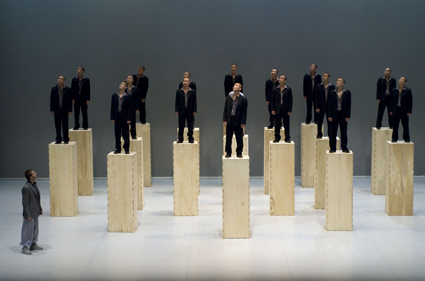
Sutra, Sidi Larbi Cherkaoui and Warrior Monks of the Shaolin Temple, Brisbane Festival
photo Andree Lanthier
Sutra, Sidi Larbi Cherkaoui and Warrior Monks of the Shaolin Temple, Brisbane Festival
NOEL STAUNTON EXPRESSES SOME NERVOUSNESS, IF WITH A CONFIDENT IRISH LILT, ABOUT HIS FIRST BRISBANE FESTIVAL. HE’S ONLY BEEN IN THE POSITION SINCE LATE 2009 AND IS STILL GETTING TO KNOW THE CITY: “I THINK THE PEOPLE OF BRISBANE WANT SOMETHING THEY CAN CALL THEIR OWN. IT’S NOT ABOUT SHOPPING DOWN AT THE ART SUPERMARKET; WE CAN ALL DO THAT. THAT’S WHY WE’RE DOING THE ROAD SHOW ARE WE THERE YET?, CIRCA HAS A SHOW FOR KIDS, WE’RE BUILDING A NEW FESTIVAL THEATRE SPACE AND WE’RE DOING STALKER’S SHANGHAI LADY KILLER WITH CO-PRESENTERS. HOPEFULLY IT’LL DO SOMETHING AND I’LL NOT BE RUN OUT OF TOWN.”
Formerly Executive Director of the Sydney Dance Company, Noel Staunton has worked in the arts for 30 years: as Technical Director of the English National Opera and Opera Australia, as Executive Director of Baz Lurhmann’s company, Baz Live, and Executive Producer of the 2004 South Australian Opera production of Wagner’s The Ring Cycle. An arts festival should come easy.
a new festival venue
When we meet in Sydney to discuss his 2010 program, Staunton commences by describing an initiative of which he’s clearly proud. “When I first visited the Brisbane Powerhouse and saw on approach the huge flat facade, I asked had anyone thought of building an amphitheatre here.” Which is exactly what he’s doing—creating an open air 600-seater called QUT Festival Theatre, ideal for Brisbane Spring when the festival plays. He sees the new venue as providing a base for exciting local work (CIRCA, Raw Dance, Topology, Queensland Theatre Company) and “extending the box office, which in the past was not major. If you pay for it, you’ll respect it, while of course there have to be events that are free. I’m experimenting in terms of the genres I’m putting in this space—circus, theatre, dance, music and opening with a production of Shakespeare’s Macbeth. It’s the first time Marcus Graham has played the role and Michael Gow is directing. It’s trimmed down and it’s all about the language and there’s no set—the wall is the set, it’s the scenery.” Opposite the amphitheatre is “the Milk Crate Lounge, where audience and artists can relax after the show.”
Staunton’s impressed by some of the young Australian talent he’s programmed—better known overseas than here—like percussion-based Raw Dance. Also in the QUT Festival Theatre program are Edinburgh Fringe, hit Melbourne’s Dark Party—“they’re like the Marx Brothers and staple things to their bodies.” In Bounce, Topology and their audience will actually bounce balls off the wall and floor of the theatre to provide patterns to which they’ll play. The ensemble are reworking the UK’s Aphex Twin’s “epic 1997 study in the rhythms of collision, Bucephalus Bouncing Ball, made from the sounds of bouncing ping pong balls” (Press Release).
circa & circa zoo
Also in the QUT Festival Theatre are Brisbane’s Circa Zoo, directed by Ben Knapton, presenting Strange Familiar Angel for children in the afternoon while globe-trotting Circa and artistic director Yaron Lifschitz are staging Wunderkammer, “a cabaret of the senses,” at night for adults. “Wunderkammer is created especially for the space,” says Staunton. The program also includes the music of Brisbane’s Robert Forster. Staunton adds, “What works and doesn’t work will help me plan 2011.”
are we there yet?
Of the 10 free events programmed for the festival, Staunton is particularly exicted by Are We There Yet?, a music theatre road show about people moving to Brisbane from interstate. It will play from a caravan in nine Brisbane suburban parks. Scripted by Scott Witt, it’s another opportunity, Staunton declares, to invest in local artists. It’s a three-year project, while another public series, Backyards (performed in actual backyards), inherited from previous Brisbane Festival artistic director Lyndon Terracini, will have its final outing this year.
stalker, shanghai lady killer
Shanghai Lady Killer from Sydney’s Stalker is eagerly anticipated. Staunton describes it as “a cross between a melodrama and Crouching Tiger, Hidden Dragon and a lot of fun.” Director Rachael Swain and the show’s writer, filmmaker Tony Ayres, have fashioned a contemporary onstage film noir “in the Chinatown of a futuristic Australian city [with] multi-media landscapes, acrobatics, parkour, trampoline, dance, circus and martial arts.” The production promises to explore “the Australian fascination with and fear of China” (Press Release). A leading Chinese martial arts film star, Wang Fei plays the lead role. The original musical score is by lain Grandage, design by Stephen Curtis and choreography by Gavin Webber (ex-Dancenorth) and Wu Shu Master, Alice Dong Pei, with stunts directed by Keir Beck.
angus cerini, wretch
Another Australian work in the program is Melbourne writer-performer Angus Cerini’s Wretch, performed with Susie Dee. John Bailey wrote in RealTime, “Wretch feels like the culmination of all of Cerini’s work so far, as well as connoting a stellar leap in his ability as a writer. The piece follows a young man in prison visited by his mother, detailing the hopelessness and failures each have experienced and which have led to his senseless crimes…Cerini serves up these lives with words that move from ocker realism to Byronic splendour to impenetrable gutterisms in a single breath” (RT 90.p40).
beckett, first love
“I have to have my bit of Beckett,” admits Staunton. “When you hear Conor Lovett speak, the Irish language is just absolutely beautiful—you could listen all day.” The Irish-French company Gare St Lazare Players are presenting First Love: “A young man, expelled from the family home…meets a woman who takes him home, with comically disastrous consequences.” It’s an account of an early Samuel Beckett short story indicative of what was to come. (Lovett is performing adaptations of Beckett’s three novels for the Melbourne International Arts Festival, p16.)
sidi larbi cherkaoui, sutra
I was impressed by Sidi Larbi Cherkaoui’s distinctive dancing and engaging presence in Zero Degrees, a collaboration with Akram Khan seen at the 2007 Sydney Festival. Staunton had hoped to attract the artist to work with the Sydney Dance Company but managed instead to secure him for the festival with Sutra, a work based on the rituals and traditions of Buddhist Shaolin monks. Staunton advises the wary, “You don’t have to worry if you’re frightened of contemporary dance. Sutra’s a perfect mix of acrobatics, martial arts and the spiritual…it’s a crowd pleaser.” The work comprises “a stark, evolving stage design of wooden boxes, which is manipulated…by 17 Warrior Monks of the Shaolin Temple and Sidi Larbi Cherkaoui” (Press Release). The set design is by UK sculptor Anthony Gormley.
new dance from indonesia
Having just returned from the 10th Indonesian International Dance Festival (see RT feature) I was excited to hear that Staunton has collaborated with Andrew Ross, director of Brisbane Powerhouse, to bring contemporary Indonesian dance to the festival. The featured choreographers in the New Dance from Indonesia program are Hartati (Di Dalam/Di Luar) and Ery Mefri (a double bill, SangHawa and Rantau Berbisik or the Nan Jombang Dance Company). Both are from the culturally rich and choreographically influential Minangkabau region in the coastal highlands of West Sumatra.
shaun parker, happy as larry
As well as Shanghai Lady Killer, with its dance and martial arts, there are two other Australian dance works in the program, by Shaun Parker and Meryl Tankard. Parker’s Happy as Larry premiered in the 2009 Sydney Festival. I wrote at the time. “Happy as Larry has a satisfying consistency built around a chalk board artist whose impressionistic documentation of his own state of mind and others’ movements [from balletic to hip hop] begins to build into a major artistic creation…Parker’s subtly memorable work is full of invention, vivid detail, characterful solos and duets and, in the end a smiling ensemble, their happiness well earned” (RT95, p14).
meryl tankard, oracle
Meryl Tankard’s Oracle is a co-creation with dancer Paul White and projection artist Regis Lansic. If suffering from visual and symbolic overload and structural weaknesses, Oracle, performed to Stravinsky’s The Rite of Spring, still manages to impress with White’s performance: “He dances to utter exhaustion. And we applaud him for it, and for the skill and passion with which this torment, this journey to being merely human… is so cruelly dramatised and endured” (RT94, 38). Oracle won Best Performance by a Male Dancer for White and Outstanding Achievement in Choreography for Tankard and White at the 2010 Australian Dance Awards.
cuban contemporary dance & ballet
At the top of Staunton’s dance program is Danza Contemporánea de Cuba (introduced to him by Sydney Dance Company’s Rafael Bonachela whose work and others’ the Cubans will perform): “I have to say these people are hot. Seeing we were bring the Ballet Nacional de Cuba out with QPAC I thought bring them as well. It’s the first time they’ve appeared together outside Havana. They have enormous technique,” usually described as a fusion of Afro-Caribbean, classical ballet and American modernism. Ballet Nacional de Cuba will perform Alicia Alonso’s account of Don Quixote.
under the radar
Staunton also has his eye on the future in the Under the Radar program, the festival’s in-built fringe, “with a smaller number of shows this year and a bit more mainstream.” There are many new names and new works among the some 25 shows listed, so previewing is not easy. Jeff Stein and Frank Mainoo from Sydney will chat with the audience about Hitchcock, birds and planes in The Raven Project; The Forces of Darkness present a de-motivational lecture in Leon Ewing’s the Problem with Evil; Side Pony from Perth play at being lions in The Pride; primal dreams proliferate in Skye Gelmann (Scattered Tacks) and Naomi Francis’ new circus show, Mothlight; Matt O’Neill, Kieran Law and Ron Seeto roll together dance, sound art and physical performance in Nostalgia; identity dissolves in Saskia Falls from Adelaide’s Vitalstatistix; the audience call the shots with new technologies in The Last Man to Die; and in The Bathers a transparent sauna becomes a theatre as Estonian traditional sauna customs are practised by Art Container. Look out for a bogan street ballet from Sydney’s youMove or risk Weeping Scab Players’ schlock horror in Cousin Love.
works in progress
With another eye on the future, Staunton is developing two works. These are not only for the benefit of artists but also for audiences: “You buy your ticket this year and see half or three quarters or whatever of the work and the completed work in the next year. You’ll see Natalie Weir’s First Ritual, the first half with her company, Expressions. Then she goes to China and works with a Chinese contemporary dance company on it and next year we bring them here and do the complete work. I also approached Perth director Matt Lutton who wants to do a version of Schubert’s Die Wintereisse. This year he’ll work on the theatre (writer Tom Holloway) and dance (choreographer Chrissie Parrott) elements and next year we add in the music. Audiences love to be involved—it gives them a way to dialogue with the artists. I’ll invite two more artists next year—no application forms, just me and them.”
–
Brisbane Festival, Sept 4-25, www.brisbanefestival.com.au
RealTime issue #98 Aug-Sept 2010 pg. 18
© Keith Gallasch; for permission to reproduce apply to realtime@realtimearts.net
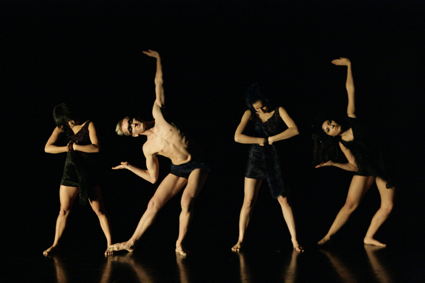
Hannah Glennie, Tyler Hawkins, Sophia Kennedy, Irina Nita, Kwacko, Victorian College of the Arts & Music (VCAM)
photo Jeff Busby
Hannah Glennie, Tyler Hawkins, Sophia Kennedy, Irina Nita, Kwacko, Victorian College of the Arts & Music (VCAM)
“DANCE PRACTICE” IS A TERM USED LOOSELY AND LIBERALLY TO DESCRIBE A VARIETY OF ACTIVITIES UNDERTAKEN BY A DANCE ARTIST. IT ENCOMPASSES MANY DEFINITIONS INCLUDING THE ACTIVITIES THAT DANCE ARTISTS ENGAGE IN, THE VARYING PROCESSES THROUGH WHICH DANCE ARTISTS CONNECT WITH THEIR WORK AND THE METHODOLOGY OF CONDUCTING POSTGRADUATE RESEARCH IE PRACTICE-LED RESEARCH. BUT WHICHEVER WAY YOU LOOK AT IT, THE ARTIST’S PRACTICE—THEIR ACTUAL ENGAGEMENT WITH THEIR CHOSEN FORM IN THE WAYS THAT THEY DETERMINE IT TO FULFIL THEIR CREATIVE OBJECTIVES—CAN BE REGARDED AS THEIR OWN ONGOING RESEARCH AND DEVELOPMENT PROJECT, WITH A “TECHNIQUE” OF ITS OWN MAKING.
Ultimately it is up to the artist to sort out which of their many experiences are integral to their artistic work and which are ancillary. Dancers often begin this process by undertaking a tertiary dance course. But as an artist’s dance practice is based on accumulated experiences and knowledge, a challenge for undergraduate tertiary dance courses is how to approach setting students upon their individual paths. So what role do these courses play in guiding young dance artists to begin thinking in these terms? And how do they help to set them upon their journey towards developing a practice which is relevant to their artistic pursuits?
Granted, the establishment of an individual dance practice is quite a sophisticated concept for a student beginning a tertiary dance course to grasp, let alone to appreciate that this is what he or she is ultimately headed towards. Sally Gardner, Lecturer in Dance at Deakin University, questions whether the majority of undergraduate students can initially engage with the notion of a dance practice: “99% of our beginning students understand dance in terms of ‘styles’: hence they say ‘I love doing contemporary’ or ‘Modern is so free’ and so on. They do not really understand dance as an ‘art’ as in the development of an individual creative vision. So they need to be led towards a new idea of dance. My hope is that on leaving Deakin they have come to realise that the journey is just beginning.”
It is widely acknowledged by the makers of Australian tertiary dance courses that the development of their students’ dance practice is an important and distinct element of their artistic training. Amongst the tertiary dance courses that had input into this article (Melbourne University’s Victorian College of the Arts and Music [VCAM], Western Australian Academy of Performing Arts at Edith Cowan University [WAAPA], Queensland University of Technology’s Creative Industries Department, Macquarie University’s Dance course and Deakin University’s School of Communication and Creative Arts), a variety of approaches was described. These included investigating a range of physical techniques and body based information, incorporating professional secondments and experiences such as touring and performing in the works of professional choreographers, and contextualising dance training through academic research and in terms of other creative fields. By and large these strategies and programs have been devised to provide students with opportunities to experience how artists work and for students to experience the reality of the artform’s requirements in the professional realm.
embodying
Jenny Kinder, Associate Professor at VCAM, describes their approach as an initial focus on the body, with further investigation of how that information can be incorporated to establish an autonomous dance practice with a distinctive artistic voice: “Students are exposed to the latest in dance science, kinesiology and somatic practices in addition to daily technique training and regular choreographic practice. Embodiment is developed through focus on neuro-muscular coordination and anatomical awareness. Students are encouraged to engage in an ongoing investigation of movement: anatomically, consciously and creatively in order to experience the dancing self and to find their own artistic voice.”
embedding
Secondment programs and employing sessional dance staff who have currency within the profession for dance technique, associated dance and movement subjects, and choreographic and performance projects are cited as excellent strategies that expose students to the variety of ideas, applications and methods that can inform their own dance practices. Cheryl Stock, Associate Professor at QUT, believes that “probably the most invaluable experience in terms of ‘real world’ practice is the secondment program in which final year students are embedded within a dance company or project.”
WAAPA in Perth has developed the secondment strategy further in establishing the LINK program that literally links new graduates from tertiary dance courses to the professional world. The one year program provides a postgraduate year of study while functioning as a pre-professional dance company. LINK members engage in extended dance training and performance programs worldwide, exposing them to a global perspective and providing the opportunity to make valuable professional connections. WAAPA’s third-year undergraduate students also participate in national and international intensive dance programs.
rationalised dance education
The current climate of change within many Australian universities is raised as a cause of concern where artistic practice is based around intensive physical training. Under current university restructuring programs, such as Melbourne University’s Melbourne Model, dance courses which have low student to teacher ratios and consume time and space less cost-effectively than others are facing a kind of economic rationalisation. In future years this may not be the best scenario for the continuation of studio-based dance practice, particularly where quantifiable employment outputs are emphasised. Cheryl Stock believes that “Although dance is quite nimble at getting around these bureaucratic and centralised ‘solutions’ it is my view that we are at a crisis point in being able to continue the highest level of training for dance practice in the industry (and by practice I mean the contextual, theoretical and practical aspects of being a dance artist in the 21st century, in all their complexity).”
another path
An altogether different approach towards dance practice can be found at the dance course at Macquarie University in NSW where students are accepted into the BA program academically rather than through audition. The vision and structure of this course seeks to redress the contention that those who study dance at tertiary institutes are primarily focused on becoming virtuosic company dancers. The course at Macquarie caters for students who wish to gain in-depth knowledge of dance as an art form and as a practice, in order to apply it to a range of other creative and research fields. Pauline Manley, Lecturer in Dance Studies at Macquarie, believes that the course enables a wider range of creative artists to intersect with the notion of a dance practice by “leading them away from the idea that dance is a display of technique”, and “developing the appropriate disciplines for an effective life in the creative arts.”
A lessened focus on physical technique means that students do not gain as readily the sophisticated and refined body management skills that are provided by courses which prioritise physical techniques to a higher degree. This reiterates the issue of whether tertiary institutions will be the ideal place for engendering a dance practice which is body based. In the case of the Macquarie course, Pauline Manley believes that their particular goals and approaches to students developing a dance practice are appropriate to a university study program and that “uni is the place to do it.”
finding the right space-time
Dance practice as observation and comprehension can be differentiated from the act of engaging in a dance practice through physical participation and rigorous assessment. Thus, determining whether a university setting is the best place to develop a person’s dance practice relates to the kinds of conditions and contexts that are relevant to what the student wants to do. Sally Gardner says that she would like to think that all aspects of dance at Deakin are approached as a form of inquiry. In terms of physical training, Gardner believes that body practices which have been so important in the development of dance artists like Trisha Brown and Russell Dumas require a specific kind of space-time. The university format of short timetabled classes is not conducive for this heightened degree of attention to the body and its movement. Importantly, she underscores an essential tenet for any young artist beginning to build their own dance practice:
“Students need to be able to spend time with practicing artists and they need to be able to see the best works that have ever been made in dance. Only then can they measure the gap between what they can do with their experience so far and what is possible. They will then go looking for the means to get where they want to be in dance, and they may in the process learn that they also need to develop the conditions that the dance they want to make needs.”
Awareness of how a dance artist interacts with the context of their work, as well as identifying the physical skills required for their chosen dance work, forms the very beginnings of an individual’s self-defined practice. A dance artist’s practice—like all other areas of the ephemeral live art that dance is—will always be subject to constant change, shifting opinions, re-evaluation and contradictions over time…as it should.
RealTime issue #98 Aug-Sept 2010 pg. 20
© Linda Sastradipradja; for permission to reproduce apply to realtime@realtimearts.net
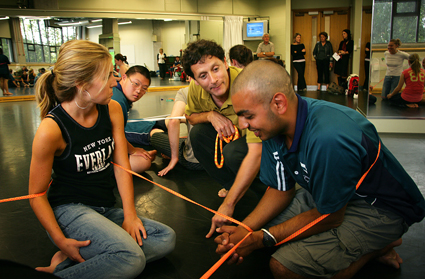
Associate Professor Ralph Buck (centre) and dance students working with members of the Pegasus Unit, the special needs class at Pakuranga College in South Auckland, NZ
DESPITE THE CROSSOVERS AND HYBRIDISING OF DISCIPLINES AND FORMS IN THE ARTS THESE DAYS, YOU’D BE HARD PRESSED TO FIND A UNIVERSITY IN PART OR WHOLE THAT DECLARES ITSELF INTERDISCIPLINARY. AN EXCEPTION IS THE NATIONAL INSTITUTE OF CREATIVE ARTS & INDUSTRIES (NICAI), A FACULTY IN THE UNIVERSITY OF AUCKLAND, NEW ZEALAND: “IN ALL AREAS, THE EMPHASIS IS ON CREATIVE EXPLORATION AND DISCOVERY AND ON INTERDISCIPLINARY COLLABORATION ACROSS THE FACULTY” [WEBSITE].
In NICAI dance sits alongside fine arts, visual arts, architecture and planning, and music. The focus on interdisciplinarity is principally postgraduate but there are major project based opportunities for undergraduates. Pan-disciplinary faculties are increasingly common in Australia. Sometimes this is the result of rationalisation, but none-the-less they can offer students the kind of interdisciplinary encounters they should expect after university in the arts or related careers.
Associate Professor Ralph Buck, Head of Dance Studies in the institute (alternatively referred to as the faculty) describes a three year Bachelor of Dance Studies degree where students increasingly engage with the world, develop dance flexibility, self-management and a sense of responsibility. There’s a marked emphasis on dance education and dance in the community with their career potential for teaching and leadership roles. The NICAI website mentions the following career options: choreography, dance journalism, dance education, dance therapy, community dance and academic research.
Buck explains that first year is focused within the university on class and studio work. In year two there are field trips, for example, to a secondary school that deals with students with disabilities, the psychiatric unit at Auckland Children’s Hospital and a retirement village. There’s also a camp in the far north of the northern island of New Zealand with activity focused on engaging with the environment—“a political project” designed to engender independence. In year three, students work in primary and secondary schools “not with their teaching hats on, but their artist hats, working in groups of three, making a company that works for five weeks in a school,” realising a project.
Buck’s aim is for students to “look at their own and others’ journeys,” to be responsive to the world. The dance classroom develops physical confidence, he says, but other aspects of the course widen student horizons so they can see “where to take their knowledge and experience.” He clearly expects his students to be realistic: “There’s a danger of a ridiculous chasm between expectations of a career onstage and reality. There are other ways to be a dancer.” One reality is that most money is to be had in teaching. He also looks to where dance is, in the community: “in different cultural groups and on the streets, not high art but hot and sweaty and just around the corner. In South Auckland it’s an access issue—there’s no stage, but dance is no less desirous.”
Across the course, says Buck, “there’s a strong multicultural element with a traditional core to first year study [including learning kaupapa hou and kapa haka and a range of Pacific music and dance] and a third to a quarter of students being Maori or Pacific Islanders studying alongside tap dancers and North Shore ballerinas. Everyone brings something and they help my teachers.”
There’s a strong emphasis too on independence, says Buck: “not to wait in line, to be bold and work at it. When the students finish they know what they want to do…and for the majority it’s not as dancers but as teachers or in youth work for churches and detention centres.”
As for interdisciplinary work at undergraduate level, Buck says it’s based around events and projects, not within courses per se. Recently fine arts, architecture and dance engaged with the NICAI’s new building with a choreographic response to spaces coming out of conversations about how we use them: “How do we respond to a stairway? How good is it? Look at it again…at the relationship between humans and design.”
Coming up is a major project titled The City Walk, involving fine arts, architecture, music and dance working with the Auckland Regional Council and town planners. The aim is to encourage the public to walk from the city centre to the Auckland-hosted 2011 Rugby World Cup “to reduce transport overload.” Nuala Gregory, NICAI’s Deputy Dean, writes, “[we are] designing a pan-faculty inter-disciplinary teaching project, The City Walk.The project has major benefits for students in terms of professional work experience and opportunities for international media exposure of their creative work…We are currently workshopping this project with the Auckland Regional Council, and have support from staff across faculty disciplines.” On their walk, rugby fans will encounter “displays of visual arts and live performances in music and dance.” The project will be trialled later this year.
The NICAI website provides video samples of dance and other works and plenty of evidence of interplay with Maori and Pacific cultures, some of it seen in dance and music taken to China recently as part of New Zealand’s delegation to the Beijing Modern Music Festival. Dance lecturer Dr Nicholas Rowe says on the NICAI website that an important aspect of the dance course is that it is not Eurocentric, that Auckland, “like a filter for the Pacific Rim” draws students from the region and encourages “the idea that the cutting edge can be local” whether New Zealand, Samoan, Malay or Australian.
With its pan-disciplinary range of departments, interdisciplinary projects and ambitions and its intercultural practices, the National Institute of Creative Arts & Industries has much to offer. NICAI clearly requires openness, the kind Ralph Buck seeks, where students “learn dance they’ve never done before,” “watch and learn in different contexts,” work with different communities and “learn how to operate in the world.”
National Institute of Creative Arts and Industries (NICAI), University of Auckland, New Zealand, www.creative.auckland.ac.nz/uoa/
RealTime issue #98 Aug-Sept 2010 pg. 22
© Keith Gallasch; for permission to reproduce apply to realtime@realtimearts.net
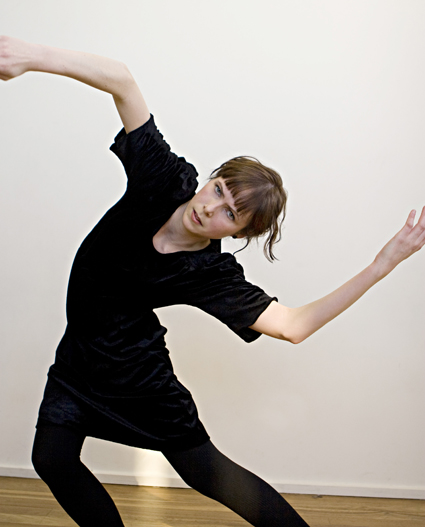
Fiona Bryant, In the Dark
photo Belinda Strodder
Fiona Bryant, In the Dark
WHAT DOES A BODY LOOK LIKE WHEN IT’S DANCING TO THE TUNE OF DEBORAH HAY? NOTHING IN PARTICULAR OR, AS HAY WOULD PUT IT, “THERE IS NO WAY IT SHOULD LOOK.” THIS MEANS THAT THERE ARE NO PREDETERMINED MOVES OR GESTURES WITHIN HAY’S WORK; THE USUAL CHOREOGRAPHIC LURE FOR COMPOSING THE BODY TO ACCOMPLISH PARTICULAR MOVEMENTS IS ABSENT.
This lack of predictability concerns performer and audience alike, which is not to say that the dancing is arbitrary. To watch a person engage with Hay’s choreography is to access a precise mode of experience. When we see the work ‘working’, we see a dancer on the edge of an abyss, oriented towards an obscure future. This isn’t merely the opacity of not having experienced what is yet to happen, for that is something every dancer faces. Rather, Hay’s work offers the dancer a heightened sense of not knowing.
Hay’s choreography intensifies the abyss of the future through turning the present into a void. Like Wile E Coyote in the Roadrunner cartoon suddenly poised over that dang canyon, there are no supports. Now what? To my mind, this is a key element of Hay’s work: to intensify the performative present by taking away what is usually there.
The title of this piece, In the Dark, indicates the sense in which the performer retains an open attitude towards an imminent future. The choreography could be seen as the means by which this is achieved. Over the years, Hay has developed numerous choreographies, complex combinations of left-field instructions, inscrutable, paradoxical, yet oddly concrete. They are, after all, the dancer’s only companion.
In the Dark arose from an intensive workshop held in March at the Bundanon Artists Residence, NSW, led by Hay with the assistance of dancer-choreographer Ros Warby. The workshop consisted of 10 dancers working solo. Each dancer was to practice their solo daily over the three months, so as to keep the choreography and its strategies alive. Come June, four Melbourne dancers presented a season of solos at Dancehouse. Three soloists performed each night. On night one, I saw Fiona Bryant, Atlanta Eke and Carlee Mellow. Unfortunately, I missed Luke George’s performance.
Each dancer brought one or two objects with them, a kind of security blanket or shamanistic fetish. Bryant was first, clip-clopping her way around the stage in boots according to an imperceptible rhythm. It was a good choice to begin with Bryant, who has some prior experience of Hay’s work. Her face was open, empty, drained of her usual persona. One had the strong feeling that she had no idea what was coming, that the horizon of oncoming movement was completely obscure. This is an incredible thing to sustain on stage with a pile of people staring at you. There was no ostentation in Bryant’s performance, no flourish, no demonstration of resident technique nor impressive gesture. She had the courage to simply stick to whatever was required from moment to moment. As a result, we saw a modest range of activities, lacking in pattern, eschewing recognition, jumping across the void again and again.
Since I have no real idea of the underlying choreography, what follows is pure speculation born of inference, for I am also in the dark. It looked like the dancers were engaging the near impossible, that attempting unachievable quests swallowed up their everyday dancing selves. There is a tinge of the postmodern in this work, not because it is pedestrian but because it challenges the knowing subjectivity of the dancer, because there is no space to display what one knows.
Atlanta Eke found her own way of engaging with the choreography. At one point, she stripped herself of her clothes, as if to shed her everyday self. She also broke with her dancing to incorporate a performed Q and A session, reminiscent of Xavier Le Roi’s recently performed autobiography. Why not fold audience participation into the moment, why not allow reflection in? At some point, Eke asked the audience whether the discussion was going on too long, whether she should finish. Some brave soul said ‘Yes’ and the solo was brought to an end.
Finally Carlee Mellow, probably the most challenged by the work precisely because she is the most experienced performer. Mellow had to find another way to dance, without resorting to past familiarities, to confront the choreography without the benefit of hindsight. She seemed to manage this, singing, stepping arhythmically, finding herself dancing in the work, without time to pause.
By the third solo, patterns began to emerge, the audience could anticipate the form if not the content. It’s no easy thing working in the dark and letting others see you doing so, but that’s what we saw: peeling away the layers to allow for another kind of dancing. The question then concerns what it is that emerges and where that comes from.
The Deborah Hay Solo Performance Project was a collaboration between Dancehouse, Critical Path, STRUT Dance and Bundanon Trust. For more on Hay’s methodology for this project, see www.deborahhay.com/spcp.html. For the dancers’ reflections on In the Dark, see www.dancehouse.com.au/research.
In the Dark, choreography Deborah Hay, 4 solo Adaptations by Fiona Bryant, Atlanta Eke, Luke George and Carlee Mellow; Dancehouse, Melbourne, June 17-20
RealTime issue #98 Aug-Sept 2010 pg. 22
© Philipa Rothfield; for permission to reproduce apply to realtime@realtimearts.net
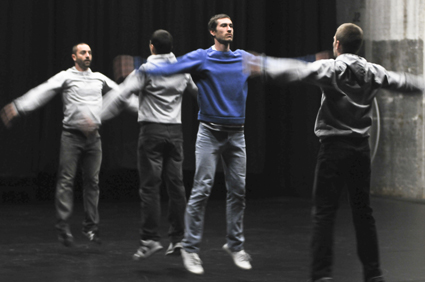
Jay Robinson, Adam Synnott, Lee Serle, Alisdair Macindoe, Bromance
photo Heidrun Löhr
Jay Robinson, Adam Synnott, Lee Serle, Alisdair Macindoe, Bromance
BROMANCE—A NON-SEXUAL, INTIMATE RELATIONSHIP BETWEEN TWO MEN; A FRIENDSHIP, BOND OR PLATONIC MALE CRUSH; BROTHERS IN ARMS EMBRACING THE OTHER.
Identified as a late 20th century cultural phenomenon, bromance has an extensive history (just think Ancient Greece or the Odd Couple). Dancers Alisdair Macindoe and Adam Synnott—a not so odd couple—have drawn on their experiences of growing up with brothers to create a concatenation of impressions in a stark space: hoodies, sneakers, flashes of bald fluorescence; an ejaculating electronic score; and the coupling of four ‘brother’ men.
Dancers Lee Serle and Adam Synnott stand in the emptiness of a warehouse. Nine fluorescent lights illuminate a greyish, industrial colour palette. Together they walk purposefully in lines. Together they jog, extend an arm and slap a thigh, perforating the silence. Rubber squeals on tarkett—a slow game of squash on a court without walls. I think of Lucy Guerin’s Untrained; perhaps it’s the casual wear and young lads pairing off (Lucy Guerin Inc: the hub of bromances?), but something more ‘dancerly’ registers with their gestures: poise, precision and timing.
Serle and Synnott spatially map a distinct grid, marked by an easy rhythm; eyes never meet in their columns of breath and silence. Little deviates. Once recorded sound (by Macindoe) is introduced, we hear the first few words of vocalised text. The environment thickens with scenarios morphing between line runs, leaps of joy and contracted shrugs of disappointment like spectators at a sporting match. A second couple enter—Macindoe and Robinson—out of phase with the original pair, but in time together. The symbiosis is viral.
A highlight is the star jump warm-up. Extended arms like blades are propelled from shoulder joints. The exaggerated exercise whips up a steady rhythm, tilted torsos on slightly altered planes. A windmill in a strong gale, sails disengaged, the cubist machine functions perfectly in this logic of experience. The abstraction moves me.
Tension exists between constructed moments of bromancing and material that appears to have emerged from time spent devising/rehearsing together. The former is expressed by clumsy representations of predictable scenarios in episodic tableaus that go on too long. The boys freeze frame in portholes of light. Their blokey grabbing, reaching and exaggerated Goya-like expressions prick through the darkness. A single figure peels off from the group, fists swing like pendulums, a low centre of gravity. Extended arms fold through his soup of self-made isolation. Feet direct leg lines, tugging and drawing out wider arcs. I enjoy the deliberate movement, but the transitions are too tight between lighting states and spatial formations for more meaningful image making. The weakness of the tableau section points towards the need for deeper exploration of the theme, or an irrevocable investment in the sparse simplicity of choices effectively performed to this point— dramaturgically a choice of less is more, or more needs to be done. The final tableau strengthens this section. Bodies upstage centre, baroquely entwined, scratch over points on individuated pathways. The forward, backward retrograde provides a more visually textured image than the stylised approach. Subtlety exceeds exaggeration.
Mention must be made of a simultaneously spoken word duet—a true testament to rehearsal style bromancing. On a train speaking about fears and sexual relations, eating sushi: no “slushy tuna from a can,” then “there goes the psycho guy” who’s “really freaking out the passengers.” The boys are “super-prepared” in their flawless recital. The audience giggles. Red Yamahas. Red Yamahas. Must “check out their number plates!” but not before we decode their handshake; it’s a fine moment of touch, camaraderie and invention.
In some sections, the choreography takes on a slumped krumping style: chest popping like a cockerel through stooped shoulders, ballasted by a fluid torso. Arms gesticulate wildly to trace a ‘me-out to the world’ intentional structure, juxtaposed with the flutter of smaller geometries detailed in fingers and wrists—ready to poke tidily away into one’s pocket.
Frisbee-ish green sponges glide in steady trajectories like bouncing balls from an old Atari game. The blank space and diverse lighting choices (Synnott) generously move us through a man-scale video game, deviance in a darkened alley (sudden surveillance with a roving spot), to a final steady portrait of two figures encased in the hoop of a looping, beating light, pixellated into mere spectres while the flanged vocals of a singer repeat the lyric “brother man” with all the right wrongness of synthetic-pop music.
As a Next Wave co-commission, Bromance celebrates contemporary dance finding pace with innovative lighting practices in its stagecraft rather than as a progression of the form. With partnered ease, the four brother men offer a generous peek into their studio collaborations. I look forward to their next co-creation.
Dancer Lee Serle has received a 12-month Rolex Arts Initiative award for mentoring by choreographer Trisha Brown in New York. For details see in the loop – july 26.
Bromance, choreography, direction, sound Alisdair Macindoe, choreography, video effect designer Adam Synnott, performers Alisdair Macindoe, Jay Robinson, Lee Serle, Adam Synnott, costumes Paula Levis, producer Lucy Guerin Inc, commissioned by Next Wave, Lucy Guerin Inc and Performance Space; Performance Space, CarriageWorks, Sydney, June 2-5
RealTime issue #98 Aug-Sept 2010 pg. 24
© Jodie McNeilly; for permission to reproduce apply to realtime@realtimearts.net
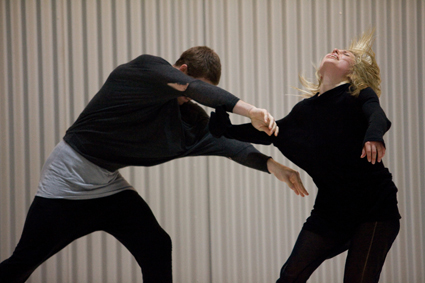
D’Arcy Andrews, Nicola Leahey, The Cry
photo Ferry Photography
D’Arcy Andrews, Nicola Leahey, The Cry
THE CRY, RAEWYN HILL’S FIRST FULL-LENGTH PRODUCTION AS THE NEW ARTISTIC DIRECTOR OF DANCENORTH, SEGUES FROM HER EARLIER WORK, ANGELS WITH DIRTY FEET (NEW ZEALAND, 2004). ANGELS WAS ABOUT ADDICTION, WHILE THE CRY DISSECTS THE RELENTLESS PROCESS OF RECOVERY. LIKE GAVIN WEBBER BEFORE HER, AND ROSS MCCORMACK AS GUEST CHOREOGRAPHER FOR LAST SEASON’S NOWHERE FAST, HILL FULLY EXPLOITS DANCENORTH’S HALLMARK PHYSICALITY, WHICH REMAINS CONSISTENT DESPITE AN ALMOST COMPLETE TURNOVER OF PERSONNEL IN THE PAST 18 MONTHS.
Preparation for this production included meetings with recovering addicts and the research has paid off with some remarkably insightful characterisations. The contrast between Nicola Leahey’s twittering Barbie doll-like role in Nowhere Fast and her dark intensity in The Cry is a testament to her versatility. Thomas Gundry Greenfield embodies the precarious point where frustration tips over into violence, while his victim, D’Arcy Andrews, tries to mediate, and responsively aligns his pain with that of the others. Jessica Jefferies’ manic character provides the only light relief with some sudden bouts of laughter and scratching during early group sequences, while still dancing in perfect time with the others.
With these four portraying recovering addicts, Luke Hanna’s character is less defined. He appears to organise the others and the set at some points, but also to manipulate, empathise and suffer. A gruelling 10-minute solo at the very end of The Cry reveals him as the personification of addiction itself, and the spirit of survival.
The set is inspired minimalism by Hill and production manager Van Locker. The white floor, two facing rows of skeletal chairs and cold lighting immediately establish this as a clinical space. Looming behind is an enormous, apparently floating, galvanised iron wall, its unforgiving scale an apt metaphor for the impersonal universe. The shiny, vertical corrugations reflect light from the vertically hung fluorescent tubes above, creating a slightly disconcerting fluid stripe effect on the eye. The first time a dancer smashes into the wall, the resounding percussive effect fills the large space and the audience jumps as one.
As The Cry opens it is quickly established that the characters have a pre-existing complex of relationships. The dancers use their actual names, adding authenticity to the limited dialogue. Repetitive movements of extraordinary strength and grace are interspersed with seemingly uncontrollable scratching, chest slapping and vein tapping. “Hit me, c’mon hit me,” says Jess, but we are unsure if she’s trying to provoke a reaction, or demanding methadone. Luke forcibly sits her down, keeps rearranging chairs and people.
To poignant violins, Nicola and D’Arcy perform a contorted floor piece, like limping spiders, until Tom intervenes and fights D’Arcy, smashing him into the wall, lifting him off the floor by the throat, then dropping him. The music is gone, D’Arcy is gasping for breath, everyone is shouting, chairs are thrown.
As order is restored, D’Arcy’s strangulated breathing becomes his music, pulsing through him, each considered movement connected to the pace of the breath. Another crescendo builds as Nicola dances to faintly oriental strains, a martial artist fighting with herself. Tom screams at her, “what have you got to prove, Nic? How good are you?”, throwing her to the floor repeatedly until she collapses. D’Arcy lifts her limp body onto his and Jess’s laps and, cradling her like a dead Christ, they tenderly undress and re-dress her in black.
In the most moving and complicit sequence of The Cry, tall Tom then carries Nicola on his front and then his back, threads his head through her clothing, and moves with her as though they are one, in a slow dance of grief. Nicola is completely pliant, as if dead. Tom lays her out on the floor, covers her face and performs a solo rife with tension and crucifixion-like gestures as the lights begin to fail and flicker. Anger builds again and he smashes chairs against the wall. They pile up around him like a funeral pyre as he flails, his face contorted in pain. Jess and D’Arcy crawl across the floor to the still prone Nicola and Luke wraps their faces in black cloth. Tom, a latter-day Atlas carrying the weight of the world, pushes the mass of tangled chairs into a corner.
Luke leads Tom as if leading an animal, mops his sweat and wraps Tom’s head in his own shirt, raises and lowers him in a slow tandem dance to drums like an amplified heartbeat, eventually laying him beside the others, casualties of a disaster. The shirtless Luke dances alone to plaintive strings, creating shapes out of his grace and strength, pleading and prayerful, moving from floor to air as if other forces are at work upon him. Face haggard, powerful, anguished and visceral, he dances and dances to exhaustion.
Less than an hour in length and unremittingly demanding, The Cry taxes its dancers to their physical and emotional limits. The audience is left almost as shattered.
Dancenorth, The Cry, concept, direction Raewyn Hill, choreography by artistic team, dancers Luke Hanna, D’Arcy Andrews, Thomas Gundry Greenfield, Jessica Jefferies, Nicola Leahey, set and light design HilLocker, Dancenorth, Townsvillle, June 2-6
RealTime issue #98 Aug-Sept 2010 pg. 24
© Bernadette Ashley; for permission to reproduce apply to realtime@realtimearts.net
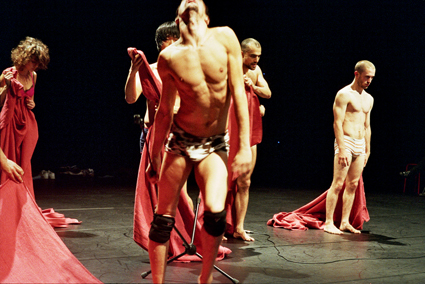
Out of Context—For Pina, Les Ballets C de la B
photo Chris Van der Burght
Out of Context—For Pina, Les Ballets C de la B
IT IS PERHAPS IRONIC, AND PERHAPS TRAGIC, 20 YEARS INTO A POST-IDEOLOGICAL ERA, IN WHICH CHOICE-LED CONSUMERISM HAS REMAINED THE SOLE SURVIVING ETHOS, THAT ART IS INCREASINGLY PREOCCUPIED WITH THE QUESTION OF THE STANDARDISATION OF HUMAN EXPERIENCE. WHAT SHOULD HAVE DISAPPEARED WITH THE SOVIET UNION SEEMS, ON THE CONTRARY, ALL-PERVASIVE.
From architect Rem Koolhaas’ notion of the “generic city” to theorist Fredric Jameson’s understanding of how postmodernity empties time of causal progression, analysis across disciplines returns to the idea that all this variation of screen sizes and skirt lengths is just a buzzing distraction from the standardisation of life on all levels, from feelings to social interaction, psychology to geography, to which There Is No Alternative.
Nothing exemplifies this buzzing vacuum better than the flying circus of internationally touring theatre, in which winning formulae and fashionable styles are often tediously replicated across languages and bodies, and all apparent cultural diversity collapses into trendy homogeneity. One such flying circus, Needcompany, is currently touring Europe with a production that interrogates precisely what happens to the human soul in this generic society.
The Ballad of Ricky and Ronny, a collaboration with Anna Sophia Bonnema and Hans Petter Dahl, is the first in a planned trilogy of pop-operas about a disaffected middle-class couple. It is sung entirely in international English, the thin, bland second language of most of the contemporary world, combining the tinniness of Nico and the verbal rhythms of Patti Smith with the drowsy beats of Flaming Lips. Ricky and Ronny once experienced love, idealism, the 1960s. Now, they cannot put a finger on the cause of their despair, as they lack any serious grievance. Instead, they milk their bloodless English, collected from Hollywood movies and pop music, for tired invectives and sentimental clichés. They try to muster stage provocation with bondage-wear and sexual experimentation. And yet they linger on stage in impeccable Euro-clothes, studiously avoiding physical contact, while their unnameable despair coalesces into a phantasm child, an hallucination made out of pink snow and yellow sperm, and they eventually commit a meaningless suicide. To underline just how little pathos The Ballad intends to create, an immaculate French maid sits upstage right throughout the performance, leisurely fiddling with the tech.
The opera is a structural, Zizekian tragedy: Ricky and Ronny are defeated by monster consumerism which satisfies desires before they can even fully form, leaving them in a state of voiceless agitation, or what cultural commentator Mark Fisher would call “depressive hedonia.” Thematically, the work sits in the conventional territory of dramatising cocooning middle-class despair without a cause. Its memory of love that used to redeem draws unlikely associations with Sarah Kane, whose despair is also moored in the deepest belief in love. However, Ricky and Ronny’s anxiety has no shelter throughout the performance, as the work refuses to believe in the metaphorical monsters its protagonists build to outsource their existential angst, much less defeat them in order to bring about any happy ending.
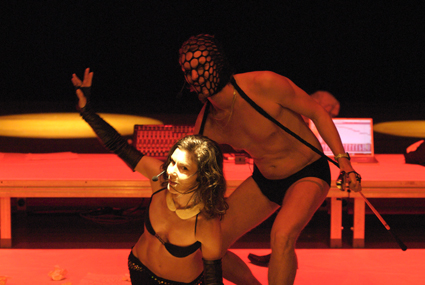
The Ballad of Ricky and Ronny, Needcompany
photo Maarten Vanden Abeele
The Ballad of Ricky and Ronny, Needcompany
The problems are threefold: eliminating the poetic aspects in the figuration of the bourgeois ennui does not, by itself, reveal its socio-political structure; The Ballad is no more penetrating a social critique than a conventional zombie flick. Secondly, made entirely out of generic elements, it is one of the most tedious performances I have ever seen, so commonplace through and through that it tends towards invisibility. Finally, there is an annoying solipsism at the heart of a performance that so deeply represents and replicates the very condition it denounces: it appears to have frustrated every Eastern European audience it has encountered, including the one that saw it with me at Eurokaz festival in Croatia. While it must be said that the immaculate staging and the direction of movement build the formal perfection of the piece, I have rarely been so pleased to see an audience rebel against understanding an artwork. For it means that tragic standardisation is not a universal condition, despite all the global English employed to construct the argument.
A new work by another Belgian company, Les Ballets C de la B’s Out of Context—For Pina, approaches the matter from a radically different angle. Alain Platel’s company is among Europe’s most respected, and the new work was showing at Sadler’s Wells for only two nights before rushing back to the festival circuit (it was scheduled at Avignon later in the season). The UK critics were rather sceptical towards a company that meshes vernacular movement with high aspirations (‘fun’ and ‘skill,’ two terms dear to British dance, are quietly sidelined in Platel’s vocabulary), but Out of Context has, in other places, been hailed as their best work yet.
The movement, woven out of the unconscious tics, spasms, hysterical and involuntary gestures that Platel has encountered in his prior work as an orthopedagogue includes pouting, scratching, over-the-top disco dancing, parodic mime and is consciously poor in style, making almost no references to any ‘serious’ dance tradition. Platel has refused to call himself a choreographer; Out of Context is an exquisite choreography nonetheless. Unlike his previous works, it is played on an empty stage, to no programmatic score. Bookmarked by nine dancers entering from the stalls, undressing to their underwear, then dressing and leaving again at the end of the show, it has three clear phases: initial rituals of mating and acquainting with animal sounds in the background evolves into the second phase, in which lines of pop music are thrown around together with exuberant dancing until, in the elegiac third part, the dancers retreat into singularity again. The piece defies description by virtue of sheer over-accumulation: 90 minutes of startlingly original movement with virtually no repetition, on nine different physiques that, even when amassed into synchronicity, preserve individual differences. (The piece is dedicated to Pina Bausch, in recognition of the foundational importance of her psychologically driven strategies for European dance.) Not having any narrative frame allows the audience to experience this decontextualised mass of movement on the level of affect, not cognition, free-associating stage images to deep memories. The result is emotionally penetrating and deliriously enjoyable.
Whereas The Ballad of Ricky and Ronny is a work so deeply illustrative of the nihilistic element within consumer capitalism that it irons itself into a completely inexpressive pancake, Out of Context locks itself within the last bastion of human expression that has escaped the Fordism of soul: the pre-cognitive, the involuntary, the spastic. We could see an eternal, unwinnable race at work, in which ever-shrinking chunks of life are accessed, broken down, conquered and reproduced—perhaps Platel is simply mapping previously inaccessible sides of the human experience. But it is also good, in some fundamental way, to experience a performance that leaves the audience elated rather than crushed.
Needcompany/MaisonDahlBonnema, The Ballad of Ricky and Ronny, authors, performers Anna Sophia Bonnema, Hans Petter Dahl, libretto Bonnema, music Dahl, costume, lighting MaisonDahlBonnema; Eurokaz Festival, Zagreb, June 23-24; Out of Context—For Pina, Les Ballets C de la B, concept, direction Alain Platel, dramaturgy Hildegard De Vuyst, danced & created by Elie Tass, Emile Josse, Hyo Seung Ye, Kaori Ito, Mathieu Desseigne Pavel, Melanie Lomoff, Romeu Runa, Rosalba Torres Guerrero, Ross McCormack; Sadler’s Wells, London, June 17,18
RealTime issue #98 Aug-Sept 2010 pg. 25
© Jana Perkovic; for permission to reproduce apply to realtime@realtimearts.net
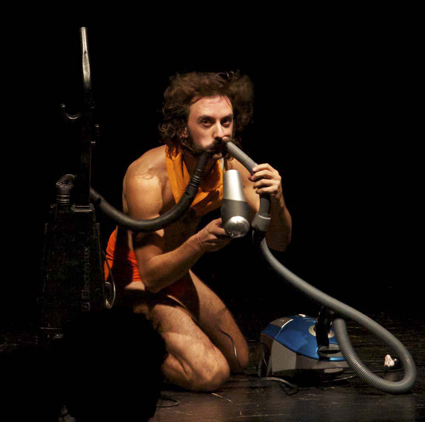
Luke George performs his own piece in 24 Hours, Dancehouse
photo Tim Jomartz
Luke George performs his own piece in 24 Hours, Dancehouse
IF YOU HAVE BEEN TO A THEATRE OR DANCE SHOW IN MELBOURNE IN THE LAST SIX MONTHS, YOU MAY HAVE COME ACROSS LUKE GEORGE. THIS TASMANIAN-BORN CHOREOGRAPHER HAS BEEN INVOLVED IN A RUN OF PRODUCTIONS THAT HAVE SURPRISED EVEN THE AMBITIOUS ARTIST HIMSELF WITH THEIR SUCCESS AND PROFILE.
Working freelance myself, I empathise with George, when he explains the embarrassment of opportunities that he is currently enjoying. “Last year I did not have a lot to do,” he says, “So I applied for everything.” Now he is working on five projects back to back and is cheerfully flat chat. “It’s very manageable because it’s all creative…and I am in all the work.”
Luke George drives his choreographic work from within, with the same commitment that he applies to his career. His early experience of leadership, as joint Artistic Director of Launceston’s youth dance company, Stompin’, 2002-8, delivered accolades aplenty. The energy that enabled him to create large scale work with young people is evident in his pursuit of a broad range of engagements in his new home town of Melbourne.
Contributions as a dancer to the work of Chunky Move, Shelley Lasica, Jo Lloyd, Frances d’Ath and others have been matched by choreographic projects. “Performing and choreography have always been intertwined for me,” George says, and cites his role in the work of Phillip Adams for Balletlab as an example of where he is challenged most. “I get something from Phillip because he asks me to be in a state of questioning. He is always pushing what he wants to do. It’s exciting and scary too.”
24 hours
As well as recently contributing to the development of Aviary, the Balletlab production due to premiere in 2011, George was a participant in Adams’ contribution to the 24 Hours project at Dancehouse (RT97). For this fleeting but hugely popular initiative, Jo Lloyd commissioned four choreographers to conceive, devise and present a production within 24 hours. Adams worked with new media artist Matthew Gingold to create a movie for his commission, extracting something wild and unfettered from the spontaneity of his intimacy with performers George and Balletlab regulars Brooke Stamp and Jo White. In George’s own commissioned piece for the 24 Hours program, he worked with sound artist Nick Roux, along with Stamp and visual artist Mila Faranov. In tune with the zeitgeist, George is very inspired by the removal of theatrical artifice. He relished the tight temporal frame of Lloyd’s commission to dig deep into the present moment.
deborah hay project
Dancehouse furnished Luke George with another excursion into rich territory with the Deborah Hay project, In the Dark (p22). A collaboration between Perth’s Strut, Sydney’s Critical Path and the Melbourne venue brought 10 dance artists into residency with the American experimental choreographer Hay and her Australian muse, dancer and choreographer Ros Warby. Hay gave the artists the template of a solo and required them to enter into rigorous and disciplined exploration of the material over three months prior to its performance in a triple bill.
George’s light and ludic performance for In the Dark was the highlight of my experience of this production. He invested Hay’s material with authority and charm, rendering the dense and potentially introverted material open and intriguing. He held his focus with considerable aplomb given the proximity of the audience and the inevitable sniggers that greeted his entrance with trademark mutton chops absurdly set off by a hot pink body suit and clumpy shoes. George spoke with enthusiasm of the discipline required to fulfill Hay’s contract. “The repetition of rehearsing the work daily for three months forces you to recognise patterns within your behaviour and to find ways to transcend these; to find fresh possibilities within the material and yourself,” he said. “I’m really into the idea of practice. Not just to be good, but to continuously witness your own practice and learn from it. It services a lot of things that are all connected.”
nownownow
There are strong connections between Hay’s tantalising exposure of the performer on an empty stage and the full evening production that George is about to complete. NowNowNow has been commissioned by Lucy Guerin Inc and will receive its premiere at Dancehouse in late July. “I have pulled back on all the production elements in this piece,” George says. “It’s all about the relationship between the performers and then theirs with the audience.” Kristy Ayres and Timothy Harvey will dance with George, with basic costumes and no video or props. Martyn Coutts will dramaturg. “We have got to the point where we are in such clear communication with each other,” George says of the two developments that have preceded the final production phase to come. “I used to think we could not be in the moment, but I am starting to think this is possible.”
My experience of the sharing in which the second development of NowNowNow culminated, was of an intense, willed focus from the performers upon a series of seemingly interchangeable exercises from which something almost violent seemed fit to explode. The push and pull of their alternating desire to communicate and to withdraw was uncomfortable and intriguing. As befits a development, the discipline of their play with this dynamic was a little unsteady and the trajectory of the piece involved some awkward fits and starts. George encouraged his invited audience of peers to stay behind after the showing for a discussion that he relished for its negative as much as its supportive commentary.
first run
“I am very interested in talking about dance,” George says. He links his concern for talking honestly about his own work to a sense of responsibility for the artform and a growing maturity in Australia in relation to criticism, academic discourse and research as practice. With Brooke Stamp, Luke George co-curates First Run, a platform for emerging choreographers supported by Lucy Guerin Inc. First Run encourages protracted discussion of works in progress shown and has been embraced by the independent dance makers of Melbourne, with high attendance and a good quality of debate. “With First Run we are developing a place where we can talk without nervousness and tiptoeing around.”
miguel gutierrez
George has long ceased to tiptoe around. His next project, a Culturelab research residency, involves louder than life New York choreographer, Miguel Gutierrez. The two met during Balletlab’s 2007 production, Brindabella, for which Gutierrez contributed a striking section of choreography. When Balletlab were resident in the US, George contrived to stay on and hang with Gutierrez and his dynamic New York collaborators. Gutierrez describes George as his “spirit brother in art” and shares his interest in the relationship between performer and audience. He too is not afraid to confront and George is looking forward to exposing a peer audience to the result of their development.
resilience
Inspired by his visits to cities like New York and Berlin where artists forge a living from precarious means, George has developed some strategies for resilience through the lean periods. He choreographs regularly for the Melbourne gay club JOHN and works in theatre for productions large and small (he was movement director for Optimism at the Malthouse and Urchin by emerging company Encyclopedia of Animals in Full Tilt this year). George also supports emerging artists such as James Welsby and Amy Macpherson and their dance collective Phantom Limb for whom he made a piece this year. Despite the now, now, now whirlwind of creative life he’s enjoying, Luke George has few illusions about the hard work ahead. He says he hasn’t got around to writing any grant applications so the flow of opportunities will necessarily slow. We agree not to think about that and enjoy the present moment.
Luke George’s NowNowNow will be reviewed in RealTime 99, October-November. To read about Lucy Guerin Inc’s First Run go to http://www.lucyguerin.com/research/First_Run
RealTime issue #98 Aug-Sept 2010 pg. 26
© Sophie Travers; for permission to reproduce apply to realtime@realtimearts.net
JUST HOW DO YOU ASSESS THE RESEARCH QUALITY OF A CREATIVE WORK? THIS QUESTION CAME UP AGAIN AND AGAIN AT JULY’S AUSTRALIAN SCREEN PRODUCTION EDUCATION AND RESEARCH ASSOCIATION (ASPERA) CONFERENCE, HIGHLIGHTING WHAT IS A COMPLEX PROBLEM EXERCISING THE MINDS OF MOST WORKING IN THE SCREEN PRODUCTION EDUCATION SECTOR AS THE EXCELLENCE FOR RESEARCH IN AUSTRALIA (ERA) INITIATIVE MOVES INEXORABLY FORWARD. OR WILL IT? WOULD A CHANGE OF GOVERNMENT DERAIL THE WHOLE PROCESS, BRINGING ABOUT YET ANOTHER CHANGE OF DIRECTION?
The ASPERA conference, held at UTS in Sydney this year, is the annual forum for academics within the Australian screen production field to discuss shared issues, exchange ideas and, currently, to address the challenges posed by the ERA. While the three days of the conference provided an interesting mixture of the problematic, the pragmatic and the abstract, with a bit of the practical and the mathematical thrown in, issues to do with both technological change and with ERA kept recurring.
complex contexts
Theo van Leeuwen, UTS Dean of Arts and Social Sciences, said in opening the conference that teaching media studies within a university environment may often not “fit in with the timetables and ways of assessment of the university,” especially while also coming to terms with the challenges of technological change, but that “universities are places where you have the chance to experiment and test out ideas and develop arguments that can be carried out into the public sphere.”
Deb Verhoeven from RMIT highlighted the recent AFTRS screen producer survey and some of its findings—she advised those interested to go to the very user-friendly website to find out more. Verhoeven drew attention particularly to the very low ratio of younger people identifying as content producers (with most producers being over 40), and the fact that only five percent thought that a creative arts education was important.
a new kind of academic
Verhoeven also asked how academics might learn from emerging media practice, and how new media practices might challenge and change the role of academics. Saying that she usually avoided films that featured teachers (especially those with Robin Williams), she reported on a film that she believes really shows how education works, especially in an unstructured and innovative way—How to Train Your Dragon. “It advocates networking and mentoring, that information must have a perceived relevance, and argues that old knowledge can become irrelevant in the course of acquiring new knowledge,” she explained.
Arguing for the emergence of a new type of academic, the mediator and motivator, Verhoeven said that “we perhaps underestimate the importance that media and communication departments are going to have in universities in the future.” She also argued that digital media affects a whole range of producers, and that it’s not just about digital literacy; “a key competency,” she said, “is the ability to move flexibly between different digital environments.”
When Gill Leahy of UTS, convenor of the conference, asked about aesthetic criteria for these new environments, she said that “audiences are much more likely to tolerate what we’d see as not good quality. Getting stuff out there just in time for audiences that are ready for it is much more important. We’ve got a lot to learn from the very practices we’re teaching our students.”
defining era, defining research
The problematic for the sector is how to deal with the major changes that are happening in universities to do with the assessment of creative work. The ERA initiative assesses research quality within Australia’s higher education institutions using a combination of indicators and expert review by committees, and research is defined as the creation of new knowledge and/or the use of existing knowledge in a new and creative way so as to generate new concepts, methodologies and understandings. Andrew Curran, from the Australian Research Council, gave a briefing updating the process and giving details of how it works; he commented that “being a creative lot will be good for you in the ERA.”
Going through all the general principles, objectives and timelines of the ERA, Curran pointed out that peer review is a “really important component” of the assessment process, and that while everything must be submitted, the process is designed to be flexible. Interestingly, he confirmed that while the rather controversial list of ranked journals has been finalised, as well as the list of conferences, the ARC would continue to receive feedback regarding journals and conferences which would be recorded on the database, and that the list would be updated and revised prior to any future ERA round. He added that the ranked journals are only one of a number of unweighted indicators, and that articles in C-ranked journals could be put forward in peer review. He argued that the challenge for the assessment of creative work is in defining the research element, and that a portfolio needs to demonstrate coherent research content. “Work out how to present your discipline and highlight its importance and outcomes,” he said.
rating exhibition outlets
Another area of creative arts publication equivalence that will be able to be assessed within the ERA process was introduced by Mick Broderick of Murdoch University, who explained that film exhibition outlets, which include local and international film festivals, broadcasters, museums and galleries, as well as online sites, could be ranked to act as proxies. His initial list of film festivals, which caused a fair amount of immediate discussion and revision, will be edited, rated and ASPERA-endorsed, but must follow the ERA A* to C format and will be adjusted annually. “This initial list is imprecise and generalised,” explained Broderick, emphasising that the ratings must be done by academics and peak bodies, not bureaucrats. “I’m confident that the sector knows enough for the listings to be accurate,” he said. “Fortunately, most of the festivals we’re looking at have their own internal peer review process, while works submitted to festivals should have all gone through a peer review at their own institution as well.” He indicated that ASPERA should also supervise the ranking of broadcasters, academic festivals and other levels of specialist exhibition in the future.
Leo Berkeley of RMIT is concerned that the whole discussion is still premised on creative works being films, but, as he says, there are now websites and games and other digital work, which are much more difficult to assess. And Deb Verhoeven was concerned that the list of festivals for ranking didn’t include any online festivals.
assessing output & assessors
But the most compelling session was the work-in-progress report on the large-scale project headed by Dr Josko Petkovic from Murdoch; he’s now three quarters of the way through the research project, Assessing Graduate Output at 19 Australian Film Schools, and he provided page after Powerpoint page of the most intricate charts, using sophisticated maths, which recorded the elegant differences in ratio and some of what he called “interesting convolutions,” in his quest to quantify the information. As he said, “the crux of the problem is that many of us believe that the scholarship/research aspect of our work is hard to quantify,” and this research project is aimed at establishing “that the assessment of students’ creative work can be as consistent as assessment in other disciplines.” In this initial stage, it’s the assessors (30 screen production academics), not the projects, that are being assessed, and “the project is based on the proposition that assessment of screen production is as complex and multi-faceted as the screen production process itself.”
With its multiplicity of criteria and ranks of assessors, the interim report was quite confronting, and we probably need the final, written report to definitively come to the same conclusion as Josko Petkovic; that the assessment process will be valid, highly reliable and internally consistent.
holding up in the real world
Another strand in the conference centred on the sector’s relationship with the industry; George Karpathakis of Edith Cowan University talked about community engagement and professional placement, and in particular the experience of a number of his students as they entered what one called “the real world—up until now you’ve been in the classroom, and you get to work with people in the industry and find out how you hold up.” As Karpathakis explained, while the policy is for the student to find the placement, in practice it’s usually the academic who uses their contacts. Once in the placement, students are on their own; in the cases he highlighted, the initial work led to other jobs and more responsibility.
Trish FitzSimons talked about the Work Integrated Learning process happening at Griffith University, where all third year students have to do 65 hours placement. “The rationale is that we’re running vocational programs, but there are not enough jobs out there.” She believes that there is so much for them to learn from their work placement, “and it also makes their films better.” Griffith, she says, is lucky in that it has connections with industry and screen cultural organisations in their area; “we get calls from big productions on the Gold Coast for students to work in the art department or whatever, and we have a mentorship scheme that often leads to placements. Work is unpaid initially, but as students prove their worth they can move into paid work.”
Leo Berkeley explained that RMIT encouraged their international students to do their industry attachments back home, between semesters, where it helps to integrate them with local industries but, of course, he added, monitoring their progress is more difficult.
new risk environments
Pragmatic matters? Well, Occupational Health and Safety probably comes under this heading, although Nicholas Oughton from Griffith University argued that creative industries, including screen-based ones, operate in a different environment and context from traditional workplaces, which makes the traditional OH&S systems inappropriate. “Creative industries thrive on risk-taking,” he argued, “and are constrained by risk avoidance.” He believes that as the very nature of work changes in the 21st century, and as cultural and creative elements are becoming more important, a new perspective on OH&S is required; he recommended that a new OH&S model should be designed for the creative industries.
signs of work
This is only a taste of the conference, and in amongst the papers and discussions there were some glimpses of actual creative work. Sarah Gibson of UTS gave a peek into her fascinating and soon to be completed multiplatform project Re-enchantment, an interactive journey into the world of the fairytale, which will be hosted on the ABC’s website and supported by three-minute animated minidocs on ABCTV. David Carlin tempted us with some scenes from Motel, three interlocking short films set in the same motel room with the same actors, made by three filmmakers and two designers as a practice-based research project at RMIT. And Rachel Wilson from RMIT reported on the work she is doing towards the setting up of a digital archive of student films—sounds dry, but it was absolutely fascinating and should result in a great resource.
ASPERA Conference 2010, University of Technology, Sydney, June 7-9; http://www.aspera.org.au
RealTime issue #98 Aug-Sept 2010 pg. 27
© Tina Kaufman; for permission to reproduce apply to realtime@realtimearts.net
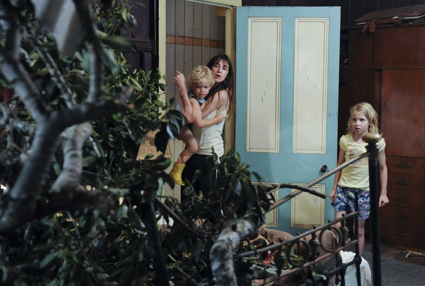
Charlotte Gainsbourg, Morgana Davies, Gabriel Gotting, The Tree
photo Baruch Rafic
Charlotte Gainsbourg, Morgana Davies, Gabriel Gotting, The Tree
UNDER CLARE STEWART’S CREATIVE LEADERSHIP THE SYDNEY FILM FESTIVAL APPEARS TO HAVE FOUND THE PERFECT BLEND: A COMPETITION VIBE WITH BIG AUDIENCES AND FESTIVAL STARS (EWAN MCGREGOR OUT FOR ROMAN POLANSKI’S THE GHOST WRITER—POLANSKI EDITED THE FILM IN JAIL); INDIE FAVOURITES (LIKE TODD SOLONDZ’S FOLLOW UP TO HAPPINESS, LIFE DURING WARTIME AND MICHAEL WINTERBOTTOM’S CONTROVERSIAL THE KILLER INSIDE ME); CULTURAL ODDITIES (BANKSY’S BRILLIANT DOCO, EXIT THROUGH THE GIFT SHOP); MERCILESS BLACK HUMOUR (CHRIS MORRIS’ OUTSTANDING FOUR LIONS); AND A GOOD MIX OF INDUSTRY TALKS (INCLUDING A HIGHLY ENTERTAINING TAKE ON AUSTRALIAN GENRE MOVIES).
This year, two films with Australian connections featured in competition (The Tree and Wasted on the Young), and a sold-out session of The Dendy Awards for short films revealed lots of Oz talent on the rise.
the tree
French director Julie Bertucelli’s The Tree was selected for Cannes Film Festival’s closing night. The film is a French/Australian co-production (hence the inclusion of uber-cool actress Charlotte Gainsbourg—so memorable in Lars von Trier’s Antichrist [2009]) and is that rarest of film beasts—it beautifully melds the Australian landscape with a French film aesthetic. Simone (Morgana Davies) is a spunky, headstrong girl who witnesses the death of her father Peter (Aden Young) while riding on the back of his ute. As he suffers a heart attack, his truck smashes into the beautiful old fig that dominates the family home. As grief overpowers her mother, Dawn (Gainsbourg), the girl turns to the tree for comfort and protection, eventually sleeping there; she is convinced she can hear her father whispering in the leaves.
Like Scott Hicks’ The Boys are Back, The Tree focuses on the inner world of a child in the immediate aftermath of unexpected death. Hicks’ film was also set in an old house with a verandah, a sublime rural landscape. Both films were based on successful books and, while occasionally maudlin, with lashings of syrup, they manage to connect deeply with childhood experience—in the dialogue of kids trying to understand a world gone awry—and the struggles of the parent (in Hicks’ case, a father) left behind. How to grieve when your children are swamping you: there’s no space or time to reflect. At the funeral, Simone observes, “No-one’s crying. That’s how it is when people are really sad.” As Dawn finds it increasingly hard to get out of bed, the neighbours quickly forget her pain. In her home no-one answers the phone. Dad’s still on the answering machine. Simone brushes Dawn’s hair, organises clothes off the hangers, in a bid to reclaim her mum, help her rediscover life.
The beautiful tree took a long time to cast. Eventually, when Bertucelli found the perfect specimen (with no CGI help), the house set was built around it. With its patches of lichen, ants scaling the trunk, it becomes like a many-limbed maternal body. The wonderful sound design brings the relationship between Simone and the creaking tree to life; it sings in the wind. The girl gradually becomes a bowerbird, taking her father’s watch and other precious items, and hanging them in the tree’s branches to create a kind of shrine. The film never veers into magical realism (hinting, hinting) but still there is that sense of child-like wonder at the majestic (I remember my passionate childhood love for Enid Blyton’s The Magic Faraway Tree).
The Tree’s drama comes in the form of George (Marton Csokas), Dawn’s new lover who, being a pragmatist wants to cut the tree down (after a large branch crushes part of the house), underestimating the determination of a young girl grieving for her father.
wasted on the young
Wasted on the Young, while differing markedly in style, is also about parental absence. A slick and techno take on upwardly mobile teens in a posh school, the nihilism of writer/director Ben C. Lucas’ film reminds me of novelist Bret Easton Ellis’s early work, the generation-defining Less Than Zero. Adults of any kind (parents, teachers) never feature within the film’s frames: this is a dog-eat-dog world where boys aim for perfection (the swim team) while girls compete to fuck them. Zach (Alex Russell as head honcho) holds parties every weekend in his super-styled mansion where it seems only his brother Darren (Oliver Ackland) is not on the guest list: he’s hunkered down by the computer, working on his school projects.
While clichés abound (jocks vs nerds), and there’s nothing really new to the date-rape-revenge narrative (extending the themes of Steven Vidler’s Blackrock [1997]), most of the acting is terrific (especially Adelaide Clemens as the rape victim, Xandrie) and what sets the film apart is its brilliant production design and highly stylised effects. Beautifully integrated is the teens’ world of text and chat, the conversations dripping off the walls, part of the film’s fabric, rather than just posed as the usual screen shots. The ending, too, takes on reality TV’s voyeuristic need to vote contestants off, of how far you’re going to push the idea that you have a right to watch and control, whatever the outcome.
the dendy awards
The Dendy Awards each year brings together a great showcase of filmmakers working on short film projects, and always highlights names to watch. This year, as always, was a mixed bag but there were a number of stunners. Winner of the Yoram Gross Animation Award, The Lost Thing (directed by Shaun Tan and Andrew Ruhemann) uses a unique otherworldly aesthetic (familiar to readers of Shaun Tan’s picture books) to craft a melancholy tale of a boy who discovers a hybrid creature that doesn’t quite belong in the muted industrial landscape of his world, and helps it find a place in the sun. The film won the Cristal Award at the Annecy Film Festival, the most prestigious international animation festival.
In terms of drama, The Kiss (winner Best Live Action Short; director Ashlee Page) and Deeper Than Yesterday (Rouben Mamoulian Award for Best Director; Ariel Kleiman) were both outstanding and (bizarrely) featured dead females floating. The former is a languorous nightmare where two teenage girls, hot and drunk, take a bike ride in the bush and jump into a well before realising they can no longer reach the rope ladder to climb out; the latter, a remarkably assured surreal tale of Russians aboard a submarine who surface to discover the body of a woman floating nearby. Once aboard she becomes a kind of waltzing matilda, a site for the men’s frustrated fantasies.
It’s always hard to pick and choose at festivals but part of the joy is the hit and miss, that feeling of jetlag when you realise you’ve spent a whole day in a seat without moving your arms or legs. The festival offers its own pathways (with titles like Fire Me Up, Freak Me Out, Take Me to the Edge…) to negotiate the ticketing process but I usually make my own way. This year I opted for black comedy; the youth factor; films starring actresses named Charlotte; and new Aussie. It was a great success.
The Tree and Wasted on the Young screened in competition at the Sydney Film Festival with Wasted on the Young receiving an honourable mention from the judging panel.
The Tree, writer, director Julie Bertucelli, based on a novel by Judy Pascoe, producers Sue Taylor, Yael Fogiel, Laetitia Gonzalez, original music Grégoire Hetzel, cinematographer Nigel Bluck, editor François Gédigier; Wasted on the Young, writer, director Ben C Lucas, producers Janelle Landers, Aidan O’Bryan, cinematographer Dan Freene, editor Leanne Cole
RealTime issue #98 Aug-Sept 2010 pg. 30
© Kirsten Krauth; for permission to reproduce apply to realtime@realtimearts.net
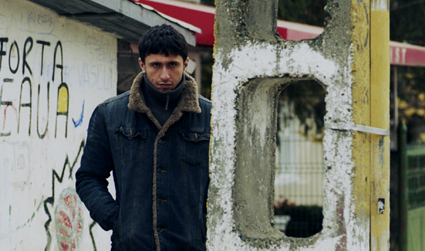
Dragos Bucur, Police Adjective
FOUR FILMS IN THE 2010 SYDNEY FILM FESTIVAL INDUCED STRANGE STATES OF BEING, EACH CINEMATIC EXPERIENCE A REMINDER OF THE CAPACITY OF FILM TO SUSPEND TIME, CHALLENGE VISUAL PERCEPTION AND QUESTION OUR READINGS OF THE BEHAVIOUR OF OUR FELLOW HUMAN BEINGS. FOR A STEADY STREAM OF EXITING FESTIVAL-GOERS UNWILLING TO SURRENDER TO THESE FILMS’ DEMANDS FOR PATIENCE, THE PREVALENT STATE OF BEING WAS DOUBTLESS BOREDOM, BUT FOR THOSE WHO WENT THE DISTANCE THE REWARDS WERE, WELL, ALMOST INEXPRESSIBLE.
women without men
Iranian artist Shirin Neshat’s video installations are some of the most powerful I’ve experienced. Women without Men deepens conventional filmmaking with the language of Neshat’s video art—the long gaze at a still face or at an eerie garden or across a desert; images that recur and disorient—a woman on a rooftop, looking out before falling; time made indefinite. On the other hand there’s urgency and suspense in this unhurried telling of the destruction of democracy in Iran in 1953 and the parallel plight of four oppressed women of different social castes who seek refuge on a country estate and achieve temporary unanimity.
police, adjective
In the ultimate stakeout movie, Romanian Corneliu Porumboiu’s Police Adjective, we enter into the real time world of physical surveillance as a young undercover detective (Dragos Bucur) interminably monitors a suspected young hashish dealer. Just as viewer patience is stretched to the maximum, the stakeouts are interpolated with brief, relatively brisk episodes (with the detective’s wife, other investigators, his boss) that reveal his growing doubt about prosecuting a harsh sentence against a minor offender. The episodes yield a growing sense of absurdity in a tired, stressed system where the confusing gap between law and justice signals not only a young post-communist country struggling with the notion of democracy but also a rigidity that belongs to the past. The deadpan dialogue captures the semantic contradictions with Kafka-esque brilliance as the characters struggle to come to terms with new meanings.
uncle boonmee who can recall his past lives
Apichatpong Weerasethakul’s uncle boonmee…is the strangest of these films, certainly the most disorienting as the Thai director’s typically inconclusive narrative—embodying folk tales, ghosts, sexual politics and the demands of family—unfolds with utter unpredictability. A dying man reunites with his son and dead first wife and visits the cave site of his first life. Subsequently we linger with the remnants of the family in a motel room which splits into a parallel universe. As with Weerasethakul’s Tropical Malady, there is a raw beauty to the filming—nightime has never been so dark in film as here—unaccented performances and a totally convincing merger of worlds actual and other that together question what’s real.
white material
Isabelle Huppert’s character in Claire Denis’ White Material is like one those strangely engaging, obtuse women in Eric Rohmer films oblivious to what is going on around them, except that here the woman is a French colonial coffee plantation owner in Africa in the midst of a bloody rebellion destined to banish or murder colonists and many of the native population with them. Seemingly blind to the disintegration of her family, the fears of her workers, the compromised friendship with a local African leader and the danger to herself, she pushes ahead, harvesting with frightening determination.
The suspense in White Material is painful, the pacing almost real time, the tropical heat palpable—we feel like we’re travelling every exhausting kilometre with the woman when she goes to fetch replacement workers, living out the senselessness of her quest, a condition doubtless created by the personal investment she has made in the plantation against all the odds of politics and family. Denis creates a world that hovers between the actual and something bordering on the surreal, realised here by having to identify with the woman’s misreading of her circumstances, all the way to a chilling release that is less than cathartic and all the more meaningful for it.
2010 Sydney Film Festival, June 2-14
RealTime issue #98 Aug-Sept 2010 pg. 31
© Keith Gallasch; for permission to reproduce apply to realtime@realtimearts.net

































































































































































